Honeywell 60SL0 DOLPHIN 60S User Manual
Honeywell International Inc DOLPHIN 60S
User Manual

Dolphin 60s
with Windows
®
Embedded Handheld
6.5
User’s Guide
Preliminary Draft 6/19/13, Not for Release

Disclaimer
Honeywell International Inc. (“HII”) reserves the right to make changes in specifications and other
information contained in this document without prior notice, and the reader should in all cases consult HII
to determine whether any such changes have been made. The information in this publication does not
represent a commitment on the part of HII.
HII shall not be liable for technical or editorial errors or omissions contained herein; nor for incidental or
consequential damages resulting from the furnishing, performance, or use of this material.
This document contains proprietary information that is protected by copyright. All rights are reserved. No
part of this document may be photocopied, reproduced, or translated into another language without the
prior written consent of HII.
Web Address: www.honeywellaidc.com
Trademarks
Dolphin is a trademark or registered trademark of Hand Held Products, Inc. in the United States and/or
other countries.
Microsoft, Windows, Windows Mobile, Windows Phone, Windows Embedded Handheld, Windows CE,
Windows 98 Second Edition, Windows NT, Windows 2000, Windows ME, Windows XP, Windows 7,
Windows Vista, ActiveSync, Outlook, and the Windows logo are trademarks or registered trademarks of
Microsoft Corporation.
The Bluetooth trademarks are owned by Bluetooth SIG, Inc., U.S.A. and licensed to Honeywell.
Other product names mentioned in this manual may be trademarks or registered trademarks of their
respective companies and are the property of their respective owners.
Patents
For patent information, please refer to www.honeywellaidc.com/patents.
©2013 Honeywell International Inc. All rights reserved.
Preliminary Draft 6/19/13, Not for Release

Table of Contents
iii
Chapter 1 - Dolphin 60s Terminal Agency Information
Label Locations....................................................................................................................1-1
Model Number, Serial Number and IMEI Labels............................................................1-1
LED Safety...........................................................................................................................1-1
LED Safety Statement....................................................................................................1-1
UL and C-UL Statement.......................................................................................................1-2
Approvals by Country...........................................................................................................1-2
R&TTE Compliance Statement—802.11b/g/n, Bluetooth, and/or GSM...............................1-2
FCC Requirements ..............................................................................................................1-3
Dolphin RF Terminal—802.11b/g/n, Bluetooth, and/or GSM.........................................1-3
Canadian Compliance..........................................................................................................1-3
Conformité à la règlementation canadienne ..................................................................1-4
RF Exposure Information (SAR) ..........................................................................................1-4
IC Radiation Exposure Statement........................................................................................1-4
CE SAR Compliance............................................................................................................1-5
CE Country Codes ...............................................................................................................1-5
For European Community Users .........................................................................................1-5
Waste Electrical and Electronic Equipment Information ......................................................1-5
China RoHS .........................................................................................................................1-6
Pacemakers, Hearing Aids and Other Electrically Powered Devices ..................................1-6
Hearing Aid Compatibility (HAC)..........................................................................................1-6
Microwaves ..........................................................................................................................1-7
Chapter 2 - Getting Started
Out of the Box ......................................................................................................................2-1
Initial Setup for Dolphin 60s Terminals ................................................................................2-1
Using the USB Charge/Communication Cable (Model 60s-USB ADAPTERKIT) ..........2-2
The Home Screen................................................................................................................2-4
Title Bar..........................................................................................................................2-4
Icons in the Title Bar ......................................................................................................2-4
Horizontal Scroll.............................................................................................................2-7
Tile Bar...........................................................................................................................2-7
Virtual Keyboard.............................................................................................................2-7
The Start Menu ....................................................................................................................2-9
Navigating the Start Menu..............................................................................................2-9
Pop-Up Menus .....................................................................................................................2-9
File Explorer.......................................................................................................................2-10
File Provisioning on the Dolphin 60s..................................................................................2-11
Search................................................................................................................................2-11
Suspend Mode.............................................................................................................2-12
Replacing the Main Battery................................................................................................2-12
Resetting the Terminal.......................................................................................................2-13
Soft Reset (Warm Boot)...............................................................................................2-13
Hard Reset (Cold Boot)................................................................................................2-13
Preliminary Draft 6/19/13, Not for Release

iv
Chapter 3 - Hardware Overview
Standard Configurations for the Dolphin 60s.......................................................................3-1
Peripherals for the Dolphin 60s ...........................................................................................3-2
Accessories for the Dolphin 60s.......................................................................................... 3-3
Features of the Dolphin 60s ................................................................................................ 3-4
Front Panel .................................................................................................................... 3-4
Feature Descriptions: Front Panel................................................................................. 3-5
Back Panel.....................................................................................................................3-7
Feature Descriptions: Back Panel ................................................................................. 3-8
The I/O Connector............................................................................................................. 3-10
Battery ...............................................................................................................................3-10
Charging Options.........................................................................................................3-10
Charging Time ............................................................................................................. 3-11
Important Charging Guidelines.................................................................................... 3-11
Battery Error Notification.............................................................................................. 3-12
Storing Batteries ..........................................................................................................3-12
Guidelines for Battery Pack Use and Disposal............................................................ 3-14
Managing Battery Power ............................................................................................. 3-14
Checking Battery Power .............................................................................................. 3-15
System Resets .................................................................................................................. 3-15
Hardware Maintenance .....................................................................................................3-16
Installing a SIM Card and/or Memory Card .......................................................................3-16
Chapter 4 - Using the Scan Image Engine
Overview..............................................................................................................................4-1
LED Safety .......................................................................................................................... 4-1
Image Engine Specifications ...............................................................................................4-1
Field of View .................................................................................................................. 4-1
Depth of Field ................................................................................................................ 4-1
Supported Bar Code Symbologies .....................................................................................4-2
Decoding .............................................................................................................................4-3
Using the Scan Demo to Decode a Bar Code ............................................................... 4-3
The Aiming Beam .......................................................................................................... 4-3
Capturing Images Using the Imaging Demo........................................................................4-4
Taking an Image............................................................................................................ 4-4
Uploading Images..........................................................................................................4-5
Chapter 5 - Using the Color Camera
Overview..............................................................................................................................5-1
Taking a picture using the Camera Demo tool ....................................................................5-1
Taking a picture using the Windows Embedded Handheld 6.5 Camera tool ......................5-4
Recording Video using the Windows Embedded Handheld 6.5 Camera Tool ....................5-6
Uploading Pictures and Videos ...........................................................................................5-6
Preliminary Draft 6/19/13, Not for Release

v
Chapter 6 - Using the Keyboards
Available Keyboards............................................................................................................ 6-1
Keyboard Combinations ................................................................................................ 6-1
Common Buttons........................................................................................................... 6-1
Using the Function Keys...................................................................................................... 6-1
Using the Modifier Keys ......................................................................................................6-3
Using the Navigation Keys .................................................................................................. 6-3
30-Key Numeric Keyboard ..................................................................................................6-4
30-Key Numeric Keyboard Combinations...................................................................... 6-4
46-Key QWERTY Keyboard................................................................................................ 6-6
46-Key QWERTY Keyboard Combinations ................................................................... 6-6
Chapter 7 - System Settings
Overview..............................................................................................................................7-1
Clock & Alarms.................................................................................................................... 7-2
Lock.....................................................................................................................................7-3
Personal Menu .................................................................................................................... 7-4
Buttons...........................................................................................................................7-5
Voice Command ............................................................................................................ 7-8
System Menu.......................................................................................................................7-9
About ...........................................................................................................................7-11
Audio Panel ................................................................................................................. 7-11
Backlight ......................................................................................................................7-12
Battery .........................................................................................................................7-14
Certificates...................................................................................................................7-16
Encryption....................................................................................................................7-16
Error Reporting ............................................................................................................ 7-17
External GPS............................................................................................................... 7-17
HSM SystemInfo..........................................................................................................7-17
SIP Config....................................................................................................................7-18
Smart Sensor...............................................................................................................7-19
Proximity Sensor Settings............................................................................................ 7-21
Managed Programs ..................................................................................................... 7-22
Memory........................................................................................................................7-22
Power...........................................................................................................................7-23
Regional Settings.........................................................................................................7-24
Remove Programs.......................................................................................................7-25
RIL ...............................................................................................................................7-26
Screen .........................................................................................................................7-26
Task Manager..............................................................................................................7-27
Chapter 8 - Communication
Connections Menu...............................................................................................................8-1
Microsoft Connections Application ......................................................................................8-2
Preliminary Draft 6/19/13, Not for Release

vi
Dolphin Wireless Manager ..................................................................................................8-5
Dolphin Wireless Manager Window...............................................................................8-5
Enabling the Radios.......................................................................................................8-6
Accessing Radio Configuration Utilities......................................................................... 8-7
USB to PC ...........................................................................................................................8-8
Network Cards..................................................................................................................... 8-8
Connecting and Synchronizing the Terminal and Workstation............................................8-9
Installing Additional Software ............................................................................................ 8-11
Adding Programs Using ActiveSync or Windows Mobile Device Center.....................8-11
Connecting the Terminal to a Wireless Network..........................................................8-12
Adding Programs Using the Internet............................................................................8-12
Software Upgrades............................................................................................................ 8-13
Dolphin 60s COM Port Assignment Table......................................................................... 8-13
Chapter 9 - Working with Wireless Wide Area Networking (WWAN)
Overview..............................................................................................................................9-1
Requirements ................................................................................................................9-1
Antenna Band................................................................................................................ 9-1
Signal Strength .............................................................................................................. 9-2
Voice and Data Communication .................................................................................... 9-2
Enabling the WWAN Radio .................................................................................................9-3
Audio Modes........................................................................................................................9-4
Volume Control.............................................................................................................. 9-4
Voice Communication..........................................................................................................9-4
Accessing the Dialer Window ........................................................................................ 9-4
Accessing Voice Mail.....................................................................................................9-5
Customizing the Phone.................................................................................................. 9-6
Data Communication...........................................................................................................9-9
System Requirements ................................................................................................... 9-9
Information Requirements ............................................................................................. 9-9
Establishing Data Communication.................................................................................9-9
Manual Network Selection (GSM/UTMS) .................................................................... 9-11
Dolphin Connection Manager............................................................................................ 9-12
Chapter 10 - Working with the Bluetooth Radio
Enabling the Bluetooth Radio............................................................................................ 10-1
Pairing and Trusted Devices .............................................................................................10-2
Connecting to Other Bluetooth Devices ............................................................................10-2
Transferring Files using Beam File.................................................................................... 10-5
Making the Terminal Discoverable ....................................................................................10-6
Enabling the Terminal to Receive Incoming Beams.......................................................... 10-6
Selecting COM Ports.........................................................................................................10-6
Chapter 11 - Working with GPS
Overview............................................................................................................................11-1
Assisted GPS Support....................................................................................................... 11-1
Powering the GPS Module ................................................................................................11-1
Preliminary Draft 6/19/13, Not for Release

vii
Communication Ports ........................................................................................................11-1
COM7 ..........................................................................................................................11-1
GPS Intermediate Driver.............................................................................................. 11-2
GPS Demo ........................................................................................................................ 11-2
Chapter 12 - Dolphin 60s HomeBase Device (Model D60s-HB)
Overview............................................................................................................................12-1
Unpacking the HomeBase...........................................................................................12-1
Charging Overview ...................................................................................................... 12-1
Communications.......................................................................................................... 12-1
Convenient Storage..................................................................................................... 12-2
Capacity.......................................................................................................................12-2
Dimensions.................................................................................................................. 12-2
Weight..........................................................................................................................12-2
Parts and Functions...........................................................................................................12-3
Front Panel ................................................................................................................. 12-3
Back Panel ..................................................................................................................12-4
Bottom Panel ............................................................................................................... 12-5
Power ................................................................................................................................12-5
Connecting Power to the HomeBase...........................................................................12-5
Charging the Main Battery................................................................................................. 12-6
To Power a Terminal and Charge its Main Battery......................................................12-6
Charging a Spare Battery in the Auxiliary Battery Well ............................................... 12-6
Communication..................................................................................................................12-7
Requirements ..............................................................................................................12-7
Setting Up and Connecting the Dolphin Terminal to the HomeBase...........................12-7
Mounting the HomeBase................................................................................................... 12-7
Desk Mounting.............................................................................................................12-7
Chapter 13 - Dolphin 60s Mobile Base Device (Model 60s-MB)
Overview............................................................................................................................13-1
Charging Overview ...................................................................................................... 13-1
Convenient Storage..................................................................................................... 13-1
Mobile Base Components ................................................................................................ 13-2
Charging the Main Battery................................................................................................. 13-3
To Power a Terminal and Charge its Main Battery......................................................13-3
Chapter 14 - Customer Support
Product Service and Repair...............................................................................................14-1
Technical Assistance......................................................................................................... 14-1
Warranty Disclaimer: Proper Use of a Touch Screen Mobile Device ................................ 14-1
Limited Warranty ...............................................................................................................14-1
How to Extend Your Warranty ..................................................................................... 14-3
Preliminary Draft 6/19/13, Not for Release

viii
Preliminary Draft 6/19/13, Not for Release
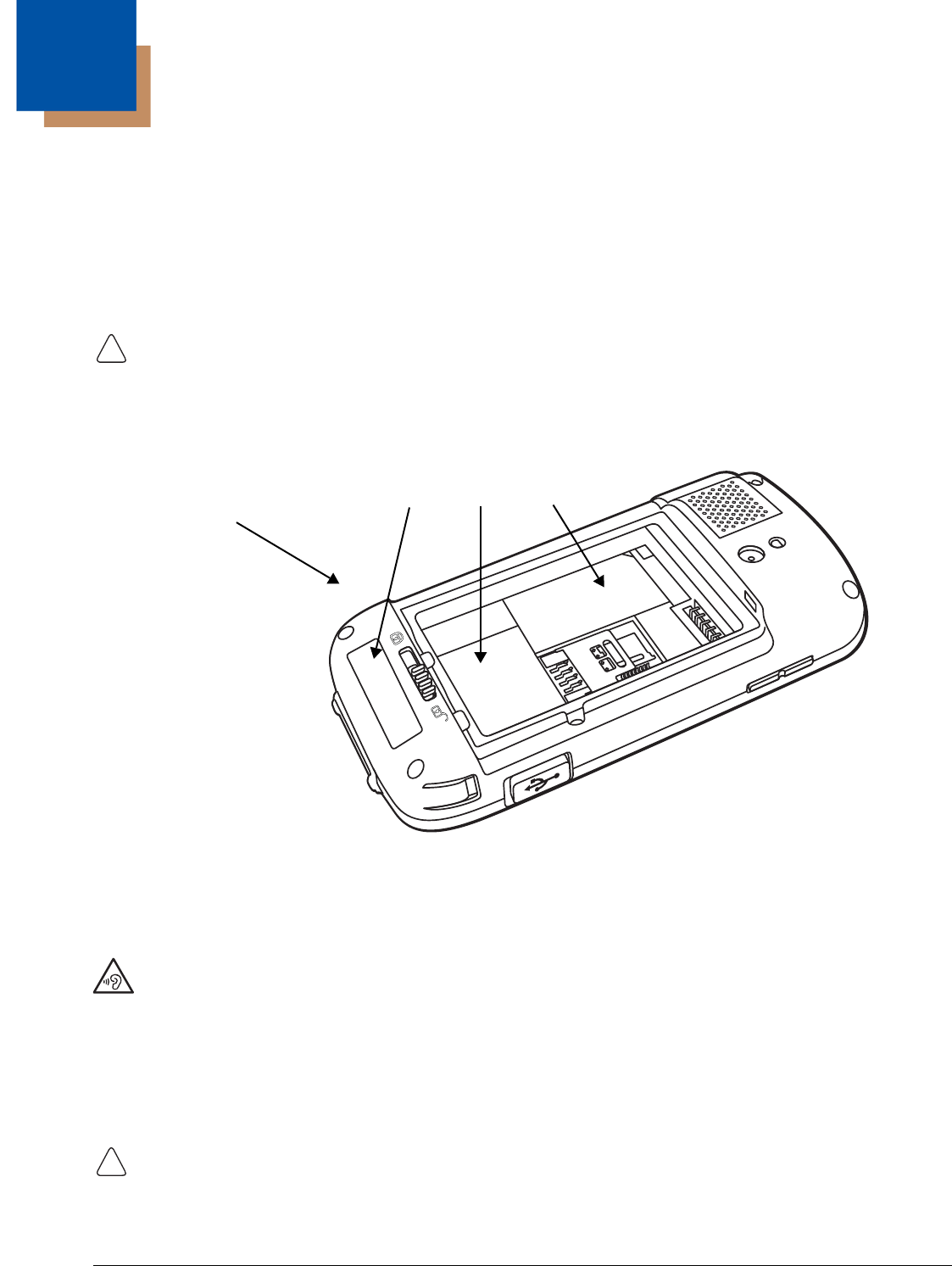
1 - 1
1
Dolphin 60s Terminal Agency Information
Dolphin 60s mobile computers meet or exceed the requirements of all applicable standards organiza-
tions for safe operation. However, as with any electrical equipment, the best way to ensure safe
operation is to operate them according to the agency guidelines that follow. Read these guidelines
carefully before using your Dolphin terminal.
This documentation is relevant for the following Dolphin models: 60sLU, 60sLE, 60sLP, and 60sL0.
CAUTION - Read the Guidelines for Battery Pack Use and Disposal on page 3-14 and all cautionary
markings on the battery, charging peripheral, or device using the battery before attempting to install, use, or
charge the battery. Risk of fire and burns if improperly handled. Do not open, crush, heat above 60°C
(140°F), or incinerate.
Label Locations
Model Number, Serial Number and IMEI Labels
The model (item) number, serial number, and international mobile equipment identity (IMEI) number for
the terminal are located on labels affixed to the bottom of the battery well.
Warning! To prevent possible hearing damage, do not listen at high volume levels for long periods.
LED Safety
LED Safety Statement
LEDs have been tested and classified as “EXEMPT RISK GROUP” to the Standard: IEC 62471:2006.
Caution! Do not view directly with optical instruments.
!
Back Panel of the terminal
with the battery door and
battery removed.
Compliance Labels and Marks
!
Preliminary Draft 6/19/13, Not for Release

1 - 2
UL and C-UL Statement
UL and C-UL listed: UL60950-1 2nd Edition, and CSA C22.2 No. 60950-1-07 2nd Edition.
Underwriters Laboratories Inc. (UL) has not tested the performance or reliability of the global positioning
system (GPS) hardware, GPS operating software or other GPS-related aspects of this product. UL has
only tested for the explosion, fire, shock, and casualty hazards required by the applicable hazardous
locations standards. UL certification does not cover the performance or reliability of the GPS hardware,
GPS operating software, or other GPS-related aspects of this product. UL makes no representations,
warranties, or certifications whatsoever regarding the performance or reliability of any GPS-related
functions of this product.
Approvals by Country
R&TTE Compliance Statement—802.11b/g/n, Bluetooth, and/or GSM
Dolphin RF terminals are in conformity with all essential requirements of the R&TTE Directive
(1999/5/EC).
This product is marked with according to article 12 of the R&TTE Directive. In addition, this
product complies to 2006/95/EC Low Voltage Directive when supplied with the recommended power
supply. Honeywell shall not be liable for use of our product with equipment (i.e., power supplies, personal
computers, etc.) that is not CE marked and does not comply with the Low Voltage Directive.
The equipment is intended for use throughout the European Community; PAN European Frequency
Range: 2.402–2.480 GHz.
European Contact:
Country EMC, Radio, & SAR Safety
U.S.A. FCC Part 15, Subpart B
FCC Part 15, Subpart C, 15.247
FCC Part 22H, FCC Part 24E
FCC SAR OET 65 Supplement C
UL60950-1, 2nd Edition
Canada ICES-003 (Class B), NMB-003 (Class B), RSS 132, RSS 133,
RSS 310
CSA C22.2 No. 60950-1-07, 2nd Edition
European
Community/CE
EN 301 489-1: V1.9.2, EN 301 489-3: V1.4.1,
EN 301 489-7: V1.3.1, EN 301 489-17: V2.2.1,
EN 301 489-24: V1.5.1,
EN 301 511: V9.0.2,
EN 301 908-1&2: V5.2.1,
EN 300 440-1: V1.6.1, EN 300 440-2: V1.4.1,
EN 300 328: V1.8.1, EN 300 330-1: V1.7.1,
EN 55022: 2010/AC: 2011 Class B,
EN 55024: 2010, EN 61000-3-2, EN61000-3-3,
EN 50360: 2001+A1:2012, EN 50360: 2001/AC:2006,
EN 61000-3-2, EN 61000-3-3,
EN 62209-1: 2006, IEC 62209-2: 2010,
EN 62311: 2008, EN 62479: 2010
EN 60950-1: 2006/A11:2009+A1:2010+A12:2011
2006/95/EC - Low Voltage Directive
2011/65/EU-RoHS (recast)
International IEC 60950-1 2nd Edition
IEC 62471
Preliminary Draft 6/19/13, Not for Release

1 - 3
Hand Held Products Europe B.V.
Nijverheidsweg 9-13
5627 BT Eindhoven
The Netherlands
FCC Requirements
Dolphin RF Terminal—802.11b/g/n, Bluetooth, and/or GSM
This device complies with Part 15 of the FCC Rules. Operation is subject to the following two conditions:
(1) this device may not cause harmful interference, and (2) this device must accept any interference
received, including interference that may cause undesired operation.
This equipment has been tested and found to comply with the limits for a Class B digital device pursuant
to Part 15 of the FCC Rules. These limits are designed to provide reasonable protection against harmful
interference in a residential installation. This equipment generates, uses, and can radiate radio
frequency energy and, if not installed and used in accordance with the instructions, may cause harmful
interference to radio communications. However, there is no guarantee that interference will not occur in a
particular installation. If this equipment does cause harmful interference to radio or television reception,
which can be determined by turning the equipment off and on, the user is encouraged to try to correct
the interference by one or more of the following measures:
• Reorient or relocate the receiving antenna.
• Increase the separation between the equipment and receiver.
• Connect the equipment into an outlet on a circuit different from that to which the receiver is connected.
• Consult the dealer or an experienced radio/TV technician for help.
If necessary, the user should consult the dealer or an experienced radio/television technician for
additional suggestions. The user may find the following booklet helpful: “Something About Interference.”
This is available at FCC local regional offices. Our company is not responsible for any radio or television
interference caused by unauthorized modifications of this equipment or the substitution or attachment of
connecting cables and equipment other than those specified by our company. The correction is the
responsibility of the user. Use only shielded data cables with this system.
Caution! - Any changes or modifications not expressly approved by the grantee of this device could void the user’s
authority to operate the equipment.
Canadian Compliance
This device complies with Industry Canada license-exempt RSS standard(s). Operation is subject to the
following two conditions:
1. this device may not cause interference, and
2. this device must accept any interference, including interference that may cause undesired operation
of the device.
ICES-3(B)/NMB-3(B)
Caution! - Any changes or modifications not expressly approved by the grantee of this device could void the user’s
authority to operate the equipment.
Preliminary Draft 6/19/13, Not for Release

1 - 4
Conformité à la règlementation canadienne
Le présent appareil est conforme aux CNR d'Industrie Canada applicables aux appareils radio exempts
de licence. L'exploitation est autorisée aux deux conditions suivantes:
1. l'appareil ne doit pas produire de brouillage, et
2. l'utilisateur de l'appareil doit accepter tout brouillage radioélectrique subi, même si le brouillage est
susceptible d'en compromettre le fonctionnement.
ICES-3(B)/NMB-3(B)
Mise en garde! - Tout changement ou modification non expressément approuvées par le bénéficiaire de cet
appareil peut annuler l'autorisation d'utiliser l'équipement.
RF Exposure Information (SAR)
This mobile phone meets the government's requirements for exposure to radio waves. This phone is
designed and manufactured not to exceed the emission limits for exposure to radio frequency (RF)
energy set by the Federal Communications Commission of the U.S. Government.
The exposure standard for wireless mobile phones employs a unit of measurement known as the
Specific Absorption Rate, or SAR. The SAR limit set by the FCC is 1.6W/Kg and for Europe 2W/Kg.
Although the SAR is determined at the highest certified power level, the actual SAR level of the phone
while operating can be well below the maximum value. This is because the phone is designed to operate
at multiple power levels so as to use only the poser required to reach the network. In general, the closer
you are to a wireless base station antenna, the lower the power output.
For this device, the highest reported SAR value for usage against the head is 0.73 W/kg, for usage near
the body is 0.73 W/kg.
While there may be differences between the SAR levels of various phones and at various positions, they
all meet the government requirement.
The FCC has granted an Equipment Authorization for this model phone with all reported SAR levels
evaluated as in compliance with the FCC RF exposure guidelines. SAR information on this model phone
is on file with the FCC and can be found under the Display Grant section of www.fcc.gov/oet/ea/fccid
after searching on FCC ID: HD560SLU.
SAR compliance for body-worn operation is based on a separation distance of 1.5cm between the unit
and the human body. Carry this device at least 1.5cm away from your body to ensure RF exposure level
remains at or below the maximum levels. To support body-worn operation, choose the belt clips or
holsters, which do not contain metallic components, to maintain a separation of 1.5cm between this
device and your body. RF exposure compliance with any of body-worn accessory, which contains metal,
was not tested and certified, and use such body-worn accessory should be avoided.
IC Radiation Exposure Statement
This EUT is compliance with SAR for general population/uncontrolled exposure limits in IC RSS-102 and
has been tested in accordance with the measurement methods and procedures specified in IEEE 1528.
This equipment should be installed and operated with minimum distance 1.5cm between the radiator
and your body.
Preliminary Draft 6/19/13, Not for Release
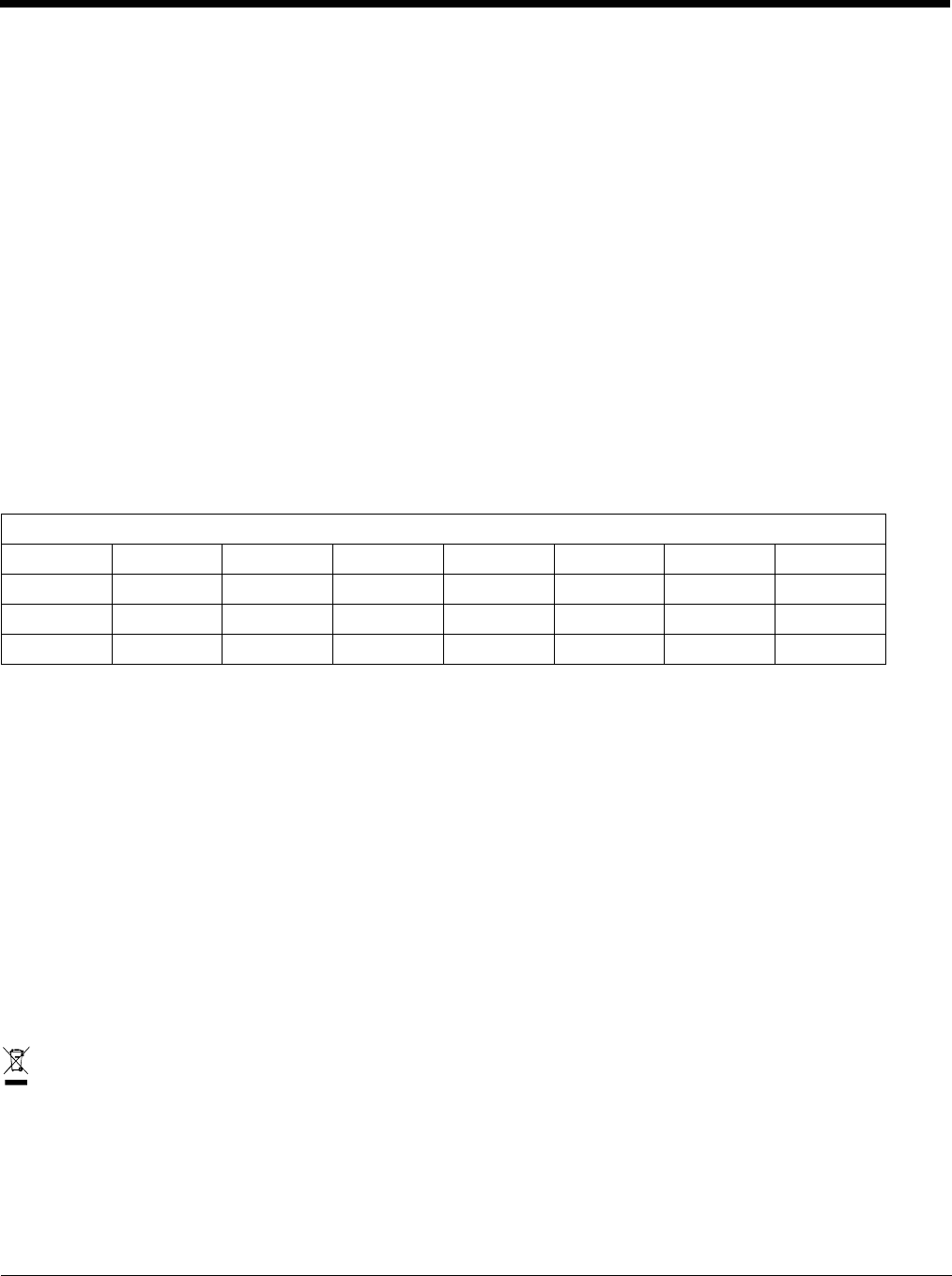
1 - 5
CE SAR Compliance
This device meets the EU requirements (1999/519/EC) on the limitation of exposure of the general public
to electromagnetic fields by way of health protection.
The limits are part of extensive recommendations for the protection of the general public. These recom-
mendations have been developed and checked by independent scientific organization through regular
and thorough evaluation of scientific studies. The unit of measurements for the European Council’s
recommended limit for mobile devices is the “Specific Absorption Rate” (SAR), and the SAR limit is
2.0W/kg averaged over 10 gram of tissue. It meets the requirements of the International Commission on
Non-Ionizing Radiation Protection (ICNIRP).
For body worn operation, this device has been tested and meets the ICNIRP exposure guidelines and
the European Standard EN 62311 and EN 62209-2, for use with dedicated accessories. SAR is
measured with this device at a separation of 1.5cm to the body, while transmitting at the highest certified
output power level in all frequency bands of this device. Use of other accessories which contain metals
may not ensure compliance with ICNIRP exposure guidelines.
CE Country Codes
For European Community Users
Honeywell complies with Directive 2002/96/EC OF THE EUROPEAN PARLIAMENT AND OF THE
COUNCIL of 27 January 2003 on waste electrical and electronic equipment (WEEE).
Waste Electrical and Electronic Equipment Information
This product has required the extraction and use of natural resources for its production. It may contain
hazardous substances that could impact health and the environment, if not properly disposed.
In order to avoid the dissemination of those substances in our environment and to diminish the pressure
on the natural resources, we encourage you to use the appropriate take-back systems for product
disposal. Those systems will reuse or recycle most of the materials of the product you are disposing in a
sound way.
The crossed out wheeled bin symbol informs you that the product should not be disposed of along
with municipal waste and invites you to use the appropriate separate take-back systems for product
disposal. If you need more information on the collection, reuse, and recycling systems, please
contact your local or regional waste administration. You may also contact your supplier for more
information on the environmental performances of this product.
This equipment may be operated in:
AT BE BG CH CY CZ DE DK
EE ES FI FR GB GR HU IE
IT IS LI LT LU LV MT NL
NO PL PT RO SE SI SK TR
Preliminary Draft 6/19/13, Not for Release

1 - 6
China RoHS
Pacemakers, Hearing Aids and Other Electrically Powered Devices
Most manufacturers of medical devices adhere to the IEC 601-1-2 standard. This standard requires
devices to operate properly in an EM Field with a strength of 3V/m over a frequency range of 26 to
1000MHz. The maximum allowable field strength emitted by the Dolphin terminal is 0.3V/m according to
Subpart B of Part 1 of the FCC rules. Therefore, the RF from the Dolphin terminal has no effect on
medical devices that meet the IEC specification.
Hearing Aid Compatibility (HAC)
Dolphin 60s models 60sLU have been tested for hearing aid compatibility. These devices have an M3
and T3 rating. For additional HAC information, including the HAC rating for this product, please refer to
www.honeywellaidc.com.
When some wireless devices are used near some hearing devices such as hearing aids and implants,
users may detect a buzzing or humming noise. Some hearing devices are more immune than others to
this interference noise. Wireless devices may also vary in the amount of interference they generate.
The ratings for compatibility of digital wireless devices with hearing aids are described in the American
National Standards Institute (ANSI) C63.19 standard:
M-Rating: Phones rated M3 or M4 meet FCC requirements and are likely to generate less interference
with hearing devices than phones that are not labeled. M4 is the superior/higher of the two ratings.
T-Rating: Phones rated T3 or T4 meet FCC requirements and are likely to be more usable with hearing
devices' telecoil than unrated phones. T4 is the superior/higher of the two ratings.
The more immune the hearing aid device is, the less likely one is to experience interference noise from
the wireless phone. Hearing aid devices may also be rated. Adding the ratings of the hearing aid and the
phone would determine probable usability:
• Any combined rating equal to or greater than six offers the best use.
• Any combined rating equal to five is considered normal use.
有毒有害物质名称及含量 (Names and Content of Hazardous Substances or Elements)
部件名称 (Parts Name) 有毒有害物质或元素 (Toxic and Hazardous Substances or Elements)
铅(Pb) 汞(Hg) 镉(Cd) 六价铬 (Cr6+)多溴联苯 (PBB) 多溴二苯醚 (PBDE)
成像式条码阅读器 (Imager) oooooo
印刷电路板 (PCB) oooooo
主机及基座外壳 (Housing) oooooo
连线 (Cables) oooooo
液晶显示器 (LCD) oooooo
液晶显示器框架 (LCD Frame) oooooo
相机模组 (Camera) oooooo
按键 (Key) oooooo
电池 (Battery) oooooo
电源供应器 (Power Adapter) oooooo
o: 表示该有毒有害物质在该部件所有均质材料中的含量均在SJ/T11363-2006标准规定的限量要求以下 (Indicates that this toxic or hazardous substance contained in all of the homogeneous
materials for this part is below the limit requirement in China’s SJ/T11363-2006.)
x: 表示该有毒有害物质至少在该部件的某一均质材料中的含量超出 SJ/T11363-2006 标准规定的限量要求 (Indicates that this toxic or hazardous substance contained in at least one of the
homogeneous materials for this part is above the limit requirement in China’s SJ/T11363-2006. )
Preliminary Draft 6/19/13, Not for Release

1 - 7
The ratings are not guarantees. Results will vary depending on the user's hearing device and hearing
loss. If your hearing device happens to be vulnerable to interference, you may not be able to use this
device successfully. Trying out this device with your hearing device is the best way to evaluate it for your
personal needs.
This device has been tested and rated for use with hearing aids for some of the wireless technologies
that it utilizes. However, there may be some newer wireless technologies used in this phone that have
not been tested yet for use with hearing aids. It is important to try the different features of this phone
thoroughly and in different locations, using your hearing aid or cochlear implant, to determine if you hear
any interfering noise. Consult your service provider or the manufacturer of this phone for information on
hearing aid compatibility.
Microwaves
The radio in the Dolphin RF terminal operates on the same frequency band as a microwave oven.
Therefore, if you use a microwave within range of the Dolphin RF terminal you may notice performance
degradation in your wireless network. However, both your microwave and your wireless network will
continue to function.
Preliminary Draft 6/19/13, Not for Release

1 - 8
Preliminary Draft 6/19/13, Not for Release
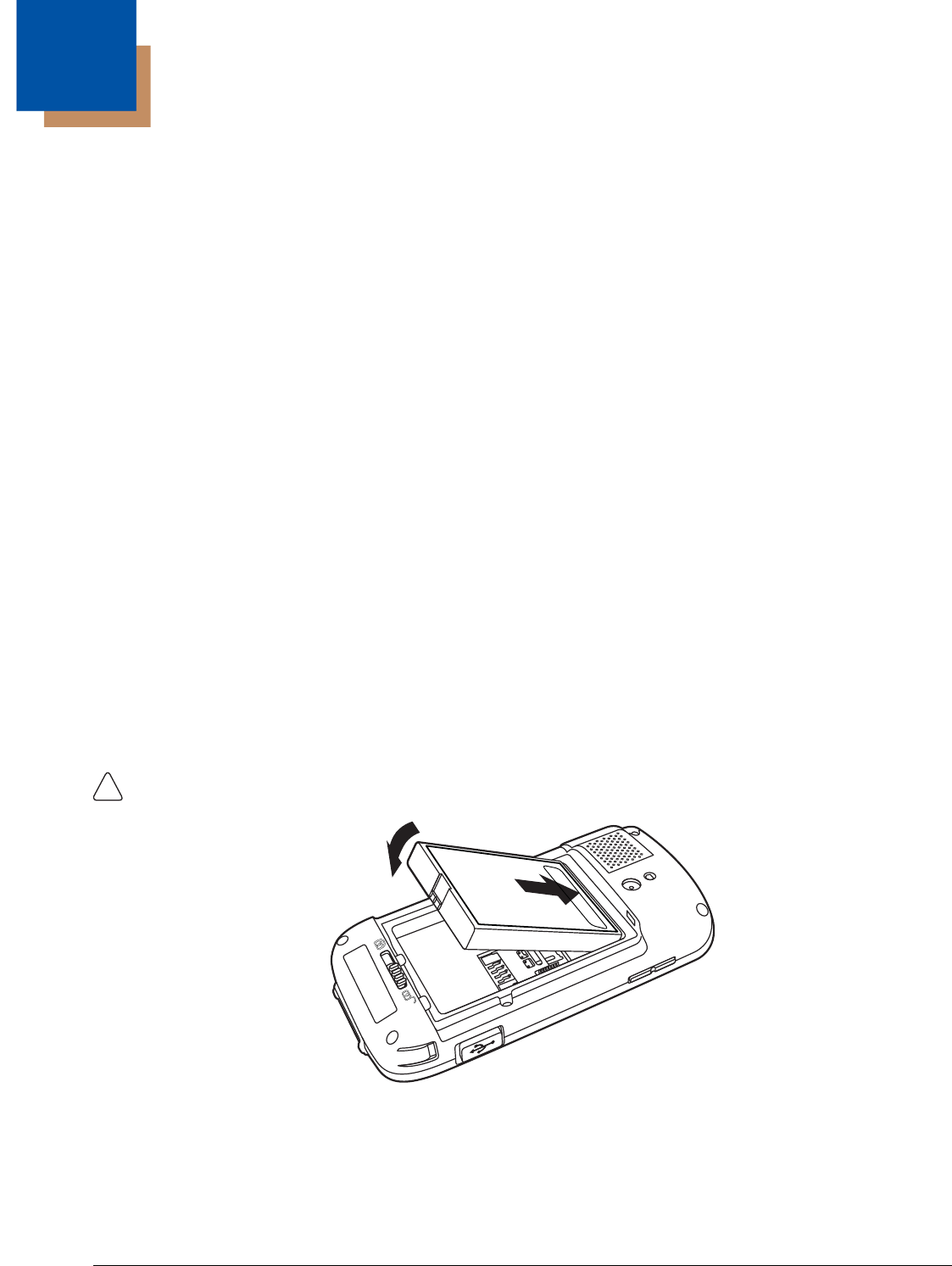
2 - 1
2
Getting Started
Out of the Box
Verify that the carton contains the following items:
• Dolphin 60s mobile computer (terminal)
• 3.7V Li-ion rechargeable battery
• USB charge/communication cable
• Power adapter with regional plug adapters
• Quick start guide
• Compliance Regulatory Sheet
If you ordered accessories for your terminals, verify that they are also included with the order. Be sure to
keep the original packaging in the event that the Dolphin terminal should need to be returned for service.
Note: Your Dolphin model may differ from the model illustrated in this guide; however, the features noted are
standard for all Dolphin 60s models with Windows® Embedded Handheld unless otherwise indicated.
Initial Setup for Dolphin 60s Terminals
Step 1. Install the Battery
Note: Before installing the main battery, read the Guidelines for Battery Pack Use and Disposal on page 3-14.
Dolphin 60s model terminals are designed for use with battery part number BAT-EXTENDED-01 (Li-ion
3.7V, 12.358 watt hour) manufactured for Honeywell International Inc.
The terminal is shipped with the battery packaged separate from the unit. Perform the steps illustrated
below to install the battery. For information on how to remove the battery, see Replacing the Main Battery
on page 2-12.
Ensure all components are dry prior to placing the battery in the terminal. Mating wet components may cause
damage not covered by the warranty.
Step 2. Charge the Battery
The power source for the Dolphin terminal is the 3.7V Li-ion rechargeable battery located under the
battery door on the back panel of the device. See Battery on page 3-8 for additional information on
battery storage, use, and disposal.
!
Preliminary Draft 6/19/13, Not for Release
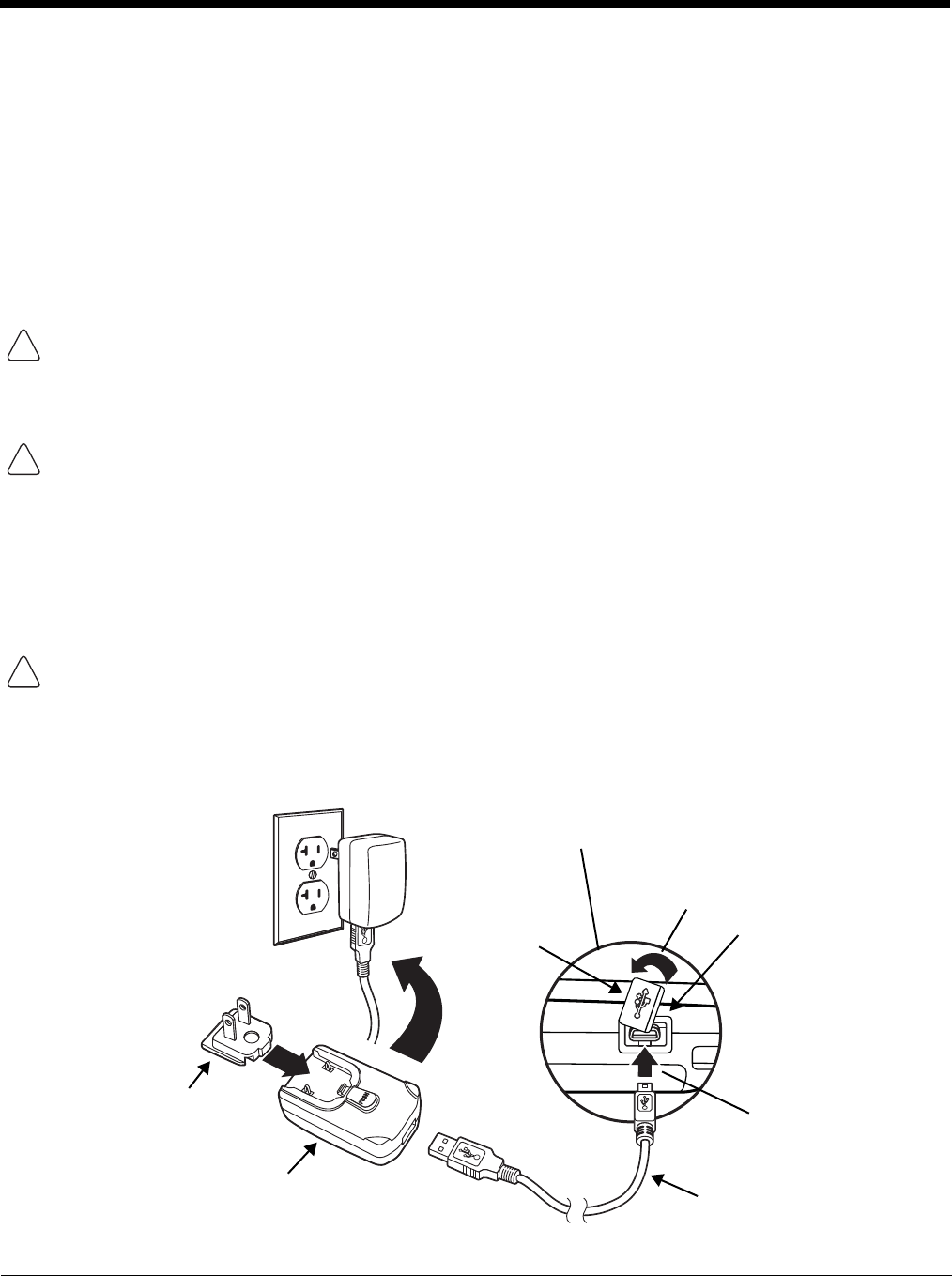
2 - 2
Important: Removing the battery from the terminal erases all non-persistent memory. Always power off the terminal
before removing the battery.
Note: For information on how to remove the battery from the terminal, see Replacing the Main Battery on page 2-12.
Before Initial Use
Dolphin terminals ship with the battery significantly discharged of power. After installing the battery in the
terminal, charge the battery with a Dolphin 60s charging peripheral for a minimum of 6 hours for the
extended battery pack.
Note: Inadequate source current may interfere with effective battery charging; see Important Charging
Guidelines on page 3-11 for additional information.
We recommend use of Honeywell peripherals, power cables, and power adapters. Use of any non-Honeywell
peripherals, cables, or power adapters may cause damage not covered by the warranty.
Dolphin 60s model terminals are designed for use with the following charging devices and cables:
60s-HB, 60s-MC, and 60s-USB ADAPTERKIT. See
Ensure all components are dry prior to mating terminals/batteries with peripheral devices. Mating wet
components may cause damage not covered by the warranty.
Using the USB Charge/Communication Cable (Model 60s-USB ADAPTERKIT)
Dolphin 60s terminals ship with a USB Charge/Communication Cable and a power adapter with regional
plug adapters. The USB Charge/Communication cable provides two options for charging the terminal.
Use the cable in conjunction with the provided power supply adapter and plug adapter to charge the
terminal from a power outlet or connect the cable to a high-power USB port to charge from a host device.
Warning - The terminal shall only be connected to CTIA certified adapters, products that bear the USB-IF logo
or products that have completed the USB-IF compliance program when using the micro USB port as a
charging source.
Option 1: Charging from a power outlet
Use only a UL Listed power supply, which has been qualified by Honeywell with an output rated at 5VDC
and 1A with the device.
!
!
!
USB Door
Plug Adapter
1
3
42
Micro USB Port
Power
Adapter
5Left Side Panel of Dolphin 60s
USB Charging/
Communication Cable
Preliminary Draft 6/19/13, Not for Release
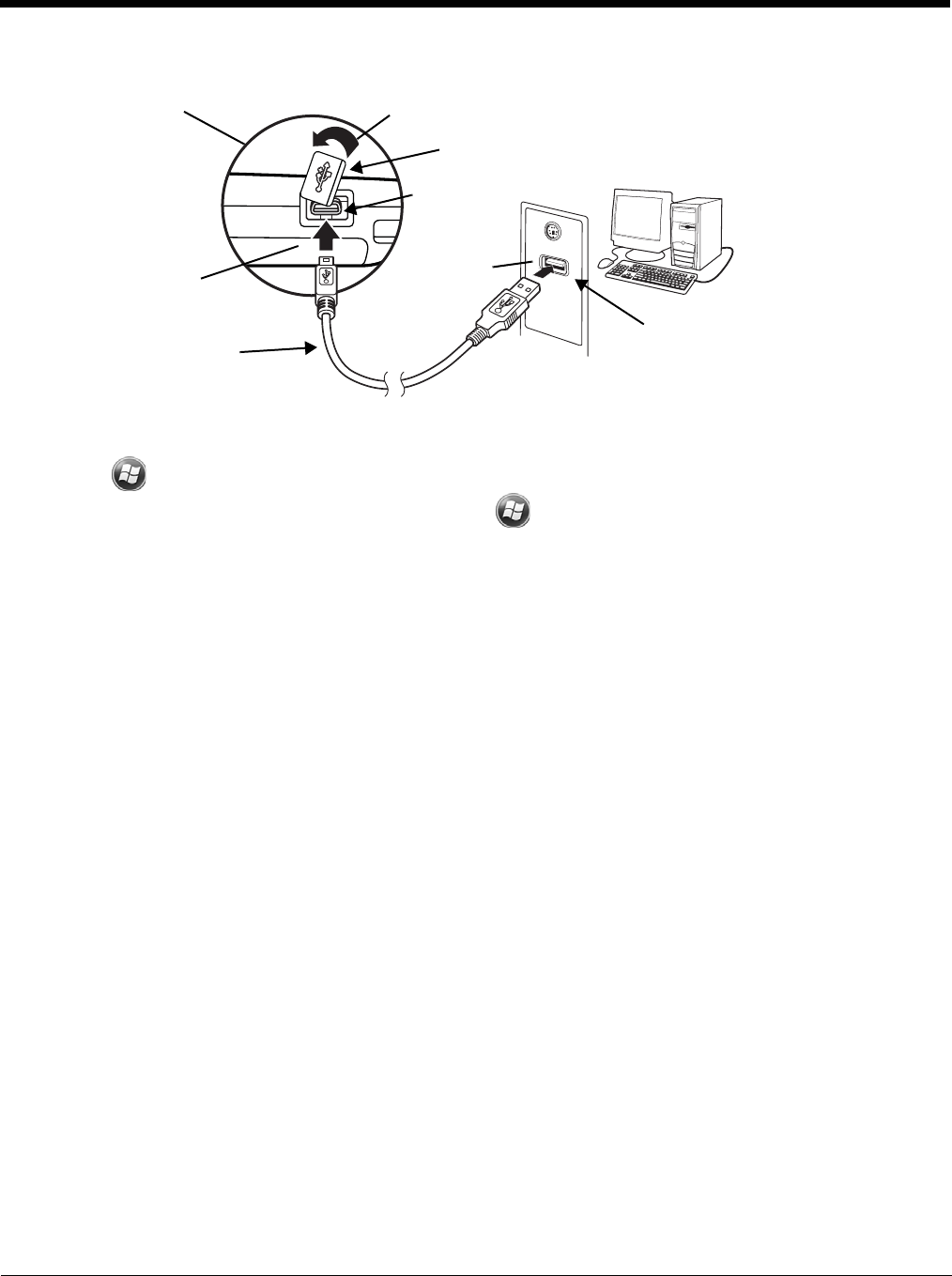
2 - 3
Option 2: Charging from a high power USB port on a host device (PC)
Note: Charging the battery through a USB port takes more time than direct AC adapter charging. USB charging will
not take place if the terminal is drawing more current than supplied by the USB port.
Touch > Settings > System > Power to verify the battery is charging.
To access detailed information on the battery, touch > Settings > System > Battery.
Step 3. Boot the Terminal and Access the Home Screen
The terminal begins booting as soon as power is applied. Do not press any keys or interrupt the boot
process. When the boot process is complete, the Home screen appears depending on your Dolphin
model.
Note: During the initial charging stage, the terminal display may dim to conserve battery power due to inactivity.
Touch the display to turn on the backlight.
USB Door
USB Port on Host Device
1
3
2
Micro USB
Port
USB Charging/
Communication Cable
Left Side Panel of Dolphin 60s
Preliminary Draft 6/19/13, Not for Release
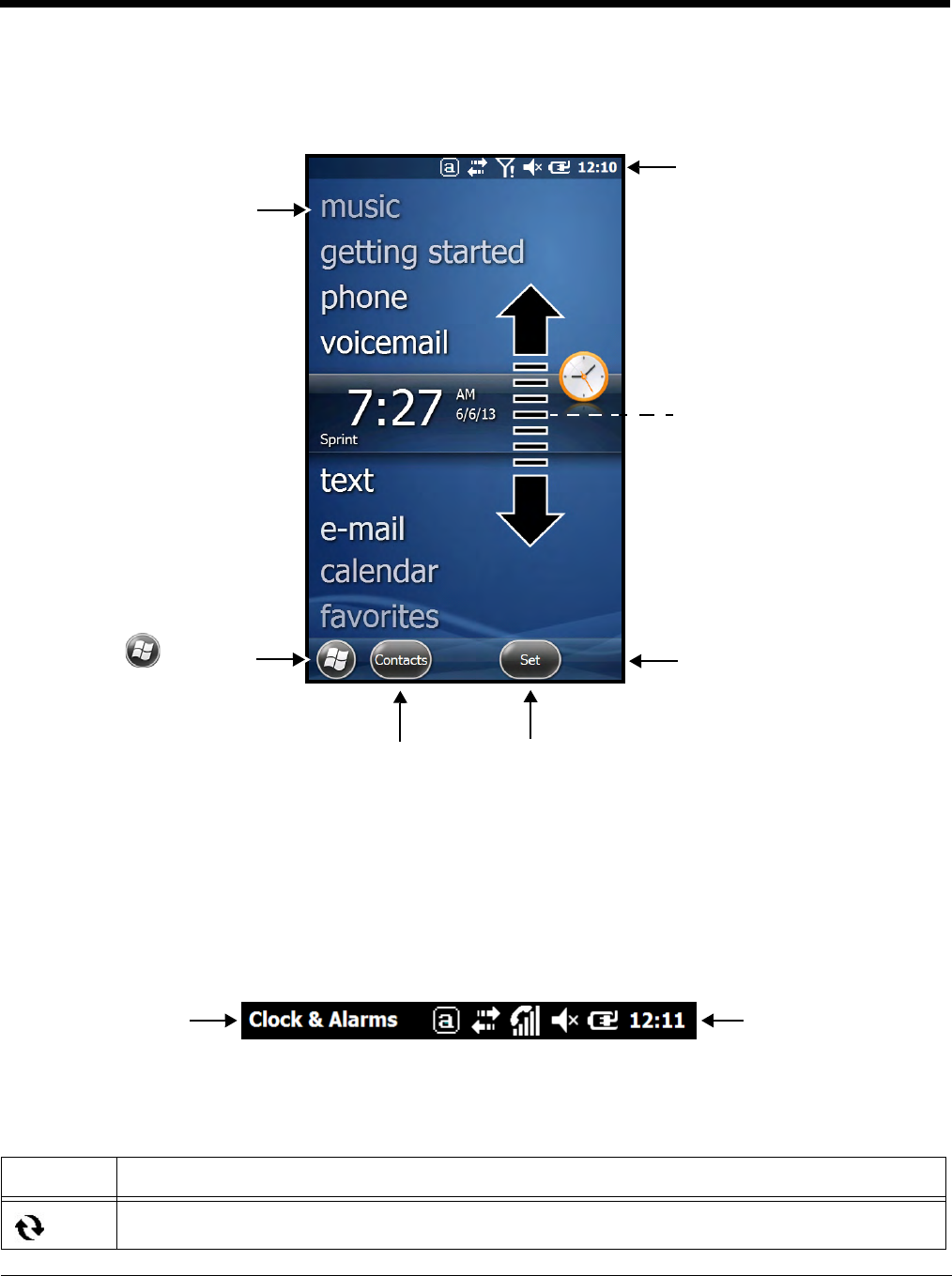
2 - 4
The Home Screen
After the Dolphin terminal initializes, the Home screen appears.
Title Bar
The Title bar, located at the top of the screen, displays the active program, the status of various system
functions, and the current time. Touching on the title bar provides access to the Horizontal Scroll. The
scroll provides access to additional programs and application screens. For additional information, see
Horizontal Scroll on page 2-7.
Icons in the Title Bar
Indicator Meaning
Synchronizing data
Touch to access
the Start menu.
Touch a menu item to
access additional screens.
Title Bar (page 2-4)
Touch to access the Clock &
Alarms settings screen.
Tile Bar (page 2-7)
Swipe up or down with your
finger or stylus to scroll through
the menu items.
Touch to access the
Contacts screen.
Text here indicates
the active program. Icons here indicate the
status of various system
functions.
Preliminary Draft 6/19/13, Not for Release
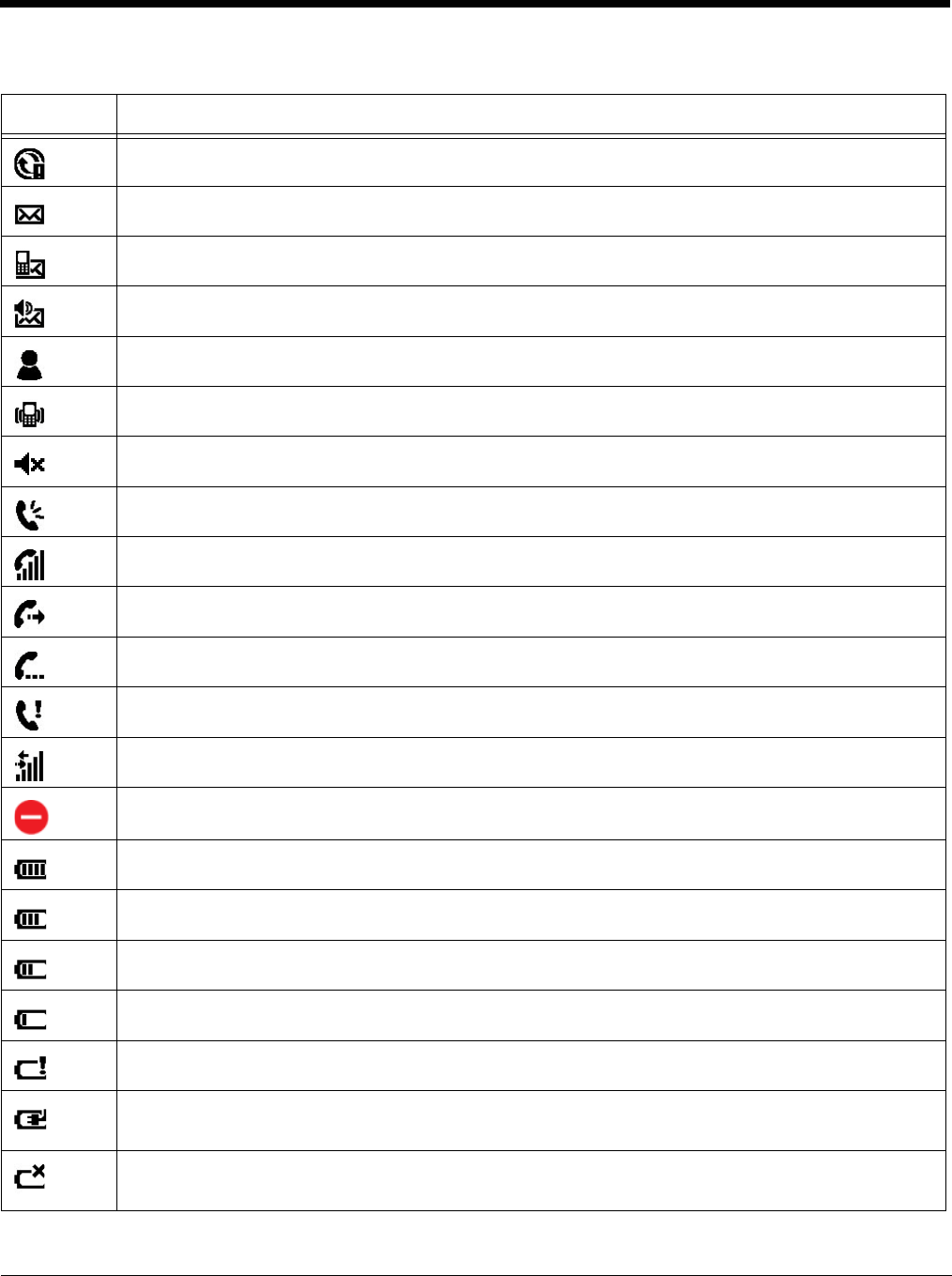
2 - 5
The terminal could not synchronize data with the workstation via ActiveSync.
New e-mail
New text message
New voicemail
New instant message
Vibrate on
Ringer off
Speaker phone on
Voice call in progress
Calls are forwarded
Call on hold
Missed call
Data call in progress
A battery error has occurred. Replace the main battery with a Honeywell Li-ion battery pack.
Battery is has a full charge
Battery has a high charge
Battery has a medium charge
Battery has a low charge
Battery has a very low charge and requires charging
Terminal is running on external power. If a battery pack is installed, the battery is charging in the
background.
The terminal is not connected to external power. A battery is installed, but is defective; specifically,
its charge level cannot be measured.
Icons in the Title Bar
Indicator Meaning
Preliminary Draft 6/19/13, Not for Release
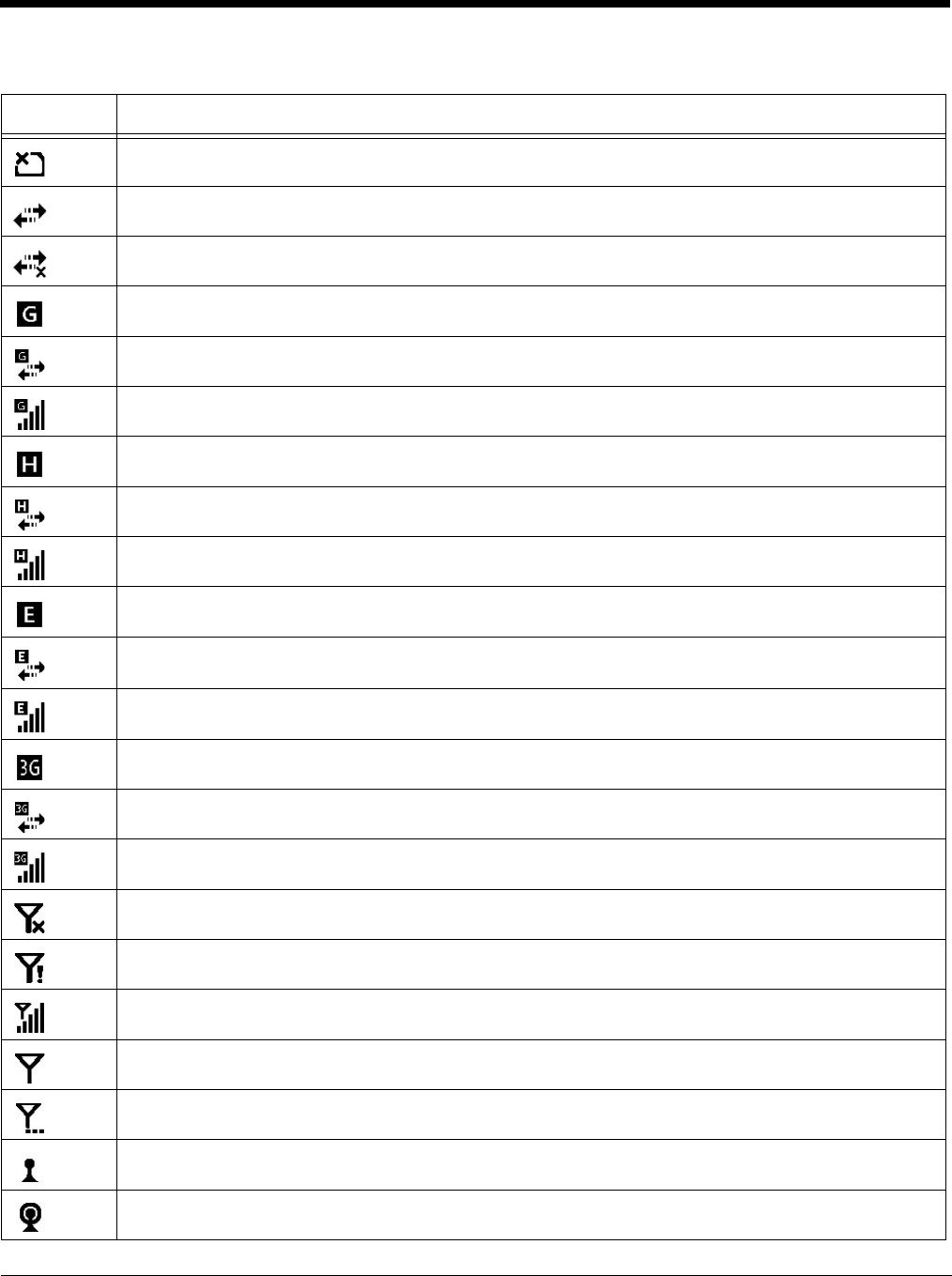
2 - 6
No SIM card is installed
Active network connection
No active network connection
GPRS available
GPRS connecting
GPRS in use
HSDPA available
HSDPA connecting
HSDPA in use
EDGE available
EDGE connecting
EDGE in use
UMTS available
UMTS connecting
UMTS in use
Radio is off
The radio is not connected to a network.
The radio is connected. The bars indicate the signal strength.
No radio signal
The terminal is searching for a signal.
Wi-Fi is on, but device is not connected
Wi-Fi data call
Icons in the Title Bar
Indicator Meaning
Preliminary Draft 6/19/13, Not for Release
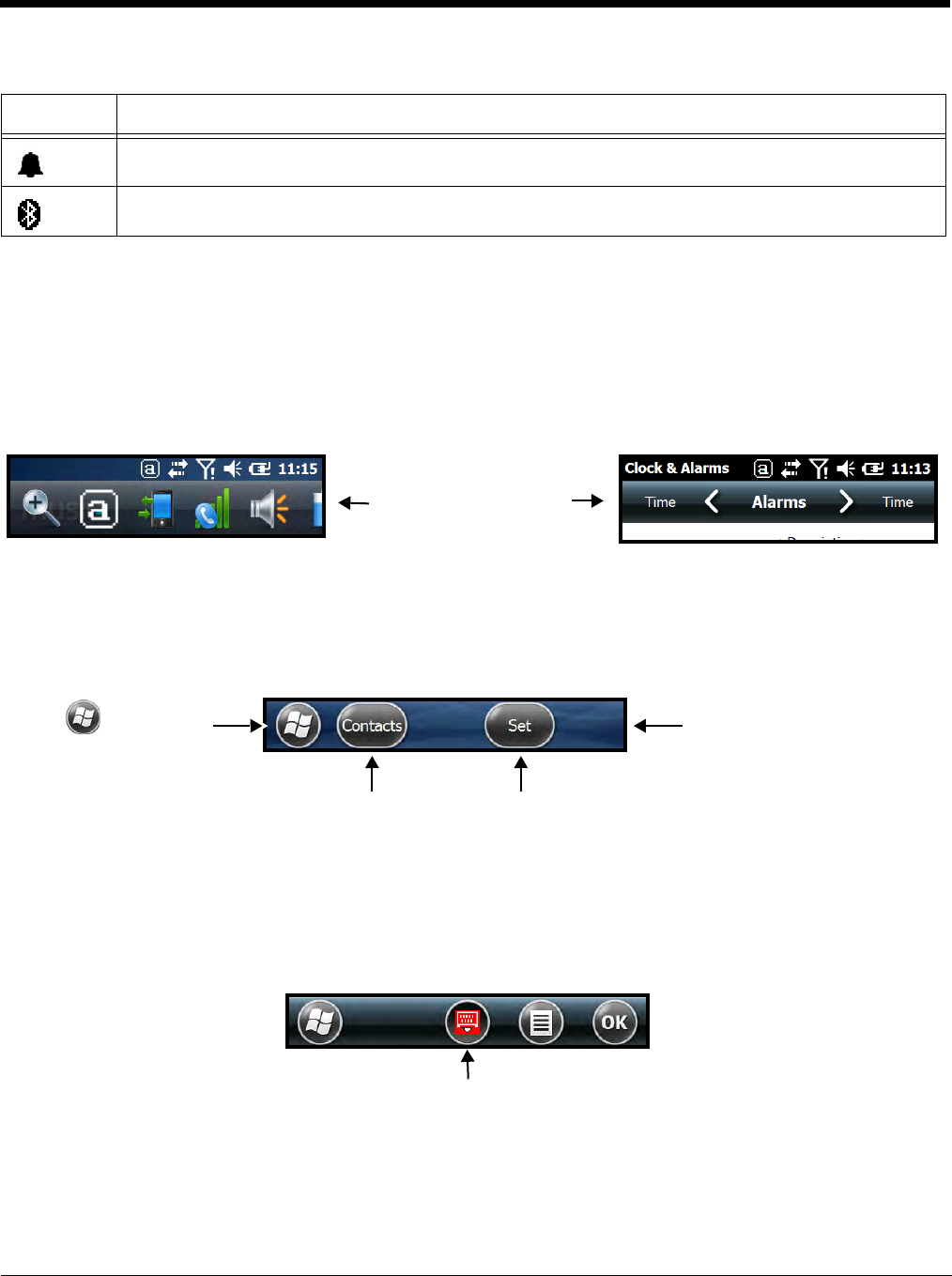
2 - 7
Horizontal Scroll
The Horizontal Scroll, located at the top of most application windows, provides access to additional
application screens. You can swipe left or right on the scroll or touch each label on the scroll, until you
get to the desired screen. Touching a label to the left or right of the center item brings new labels into
view.
Note: Touch the Title bar to access the horizontal scroll if it is not visible on the screen.
Tile Bar
The Tile Bar is located at the bottom of an application window.
Virtual Keyboard
The virtual keyboard appears when you open an application or select a field that requires text or
numerical input. You can also touch the keyboard icon on the tile bar to toggle the keyboard on or off.
When you touch an hold the keyboard icon, a pop-up menu allows you switch between the default
enhanced Honeywell virtual keyboard, which is fully customizable or the standard Windows Embedded
Handheld virtual keyboard.
Pending alarm
Bluetooth
Icons in the Title Bar
Indicator Meaning
The content of the
Horizontal scroll
changes according to
the open application.
The icons change according to the open application.
The Tile Bar displays icons you
use to open and close screens,
menus, and features.
Touch to access the
Start menu (page 2-9).
Touch the keyboard icon to toggle the Virtual Keyboard on or off.
Preliminary Draft 6/19/13, Not for Release

2 - 8
The Enhanced Honeywell Virtual Keyboard
During text input, you may need to switch between keyboard modes to access additional character sets
(e.g., function keys, symbols, and numbers). Each keyboard mode, includes navigation keys, which allow
you to quickly switch between modes. Touch the ABC key to switch to the Qwerty Mode, the 123 key to
switch to the Numeric Mode, and the #@& key to switch to the Function & Symbols Mode.
Note: The content of the keyboard and the mode initially displayed may vary depending on the application in use
and the input field requirements.
Alternate Keys
Some keys include a second symbol in red. In order to use the alternate symbol, press and hold the key
until the alternate symbol appears, then release the key to type the symbol.
Honeywell Virtual Keypad Creator
The default enhanced virtual keyboard is fully customizable using the
Honeywell Virtual Keypad Creator
software available for download at www.honeywellaidc.com. The user-friendly utility allows you to
personalize multiple keyboard features including key position, size, quantity, color, and the keyboard
skin. In addition, you can make language changes, create alternate or function keys for special character
sets, and add application launch keys to streamline common business tasks.
Virtual Keypad consists of two software applications. The first is the
Virtual Keypad Creator
, which
resides on your PC and is used to design and save keypad layouts. The second is the
Virtual Keypad
,
which is downloaded to your mobile device. The
Virtual Keypad
on your mobile device displays the
keypad you designed using
Virtual Keypad Creator
.
The customization process is easy. Simply download and install the
Virtual Keypad Creator
software
onto your PC, modify the provided standard template, then download the customized keyboard to your
terminal using a USB connection.
Preliminary Draft 6/19/13, Not for Release
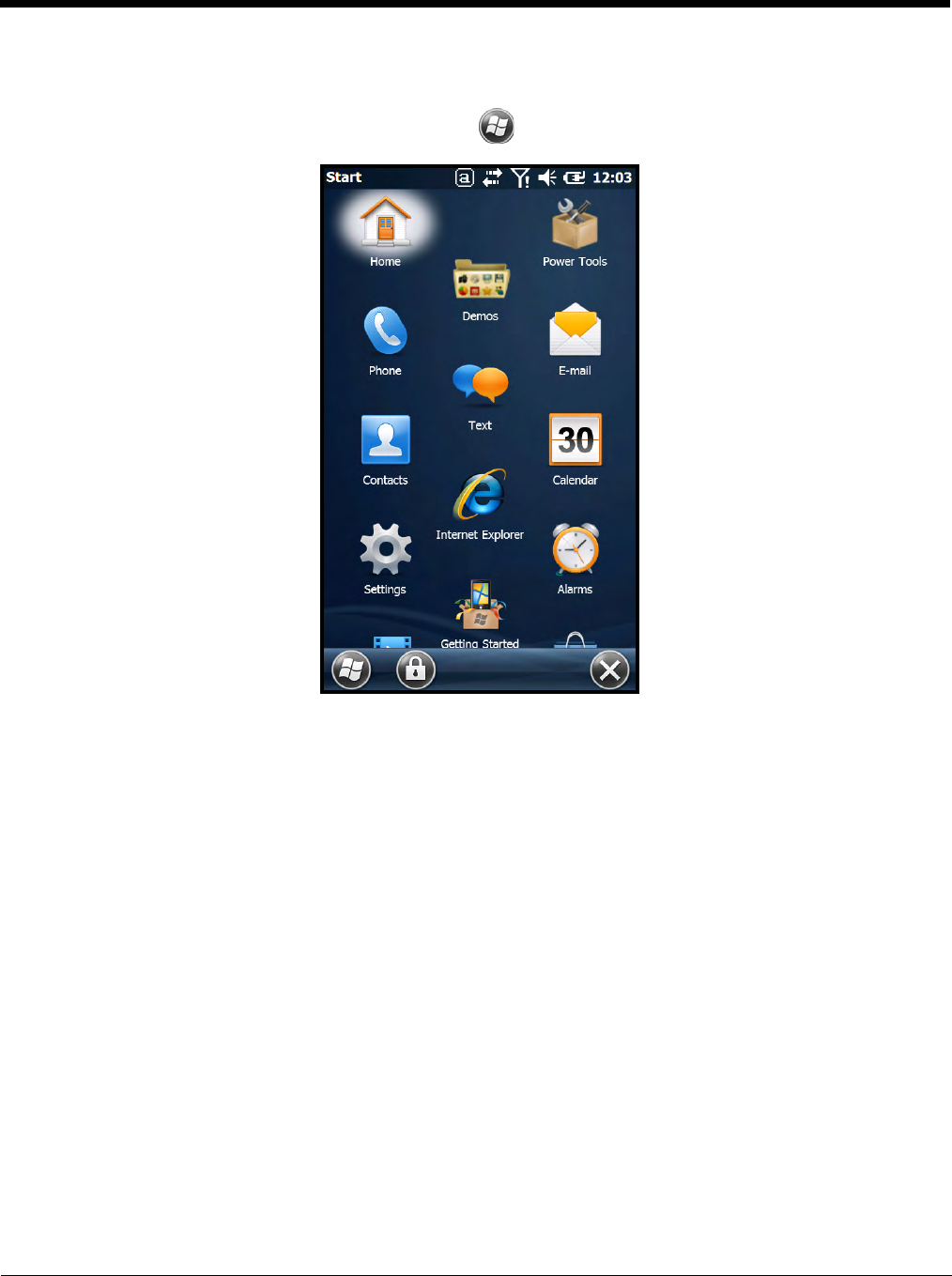
2 - 9
The Start Menu
To see the programs loaded on your terminal, touch to access the Start menu.
Navigating the Start Menu
• Swipe up or down with your finger or stylus to scroll through the menu icons.
• To open a program, touch once on the program icon.
• To reposition an icon on the Start menu, touch and hold the stylus on the icon, then drag the icon to
the desired position.
Pop-Up Menus
With pop-up menus, you can quickly choose an action for a selected item. To access a pop-up menu,
touch and hold on the item name of the action you want to perform. When the menu appears, lift the
stylus, and touch the action you want to perform.
Touch anywhere outside the menu to close the menu without performing an action.
Preliminary Draft 6/19/13, Not for Release
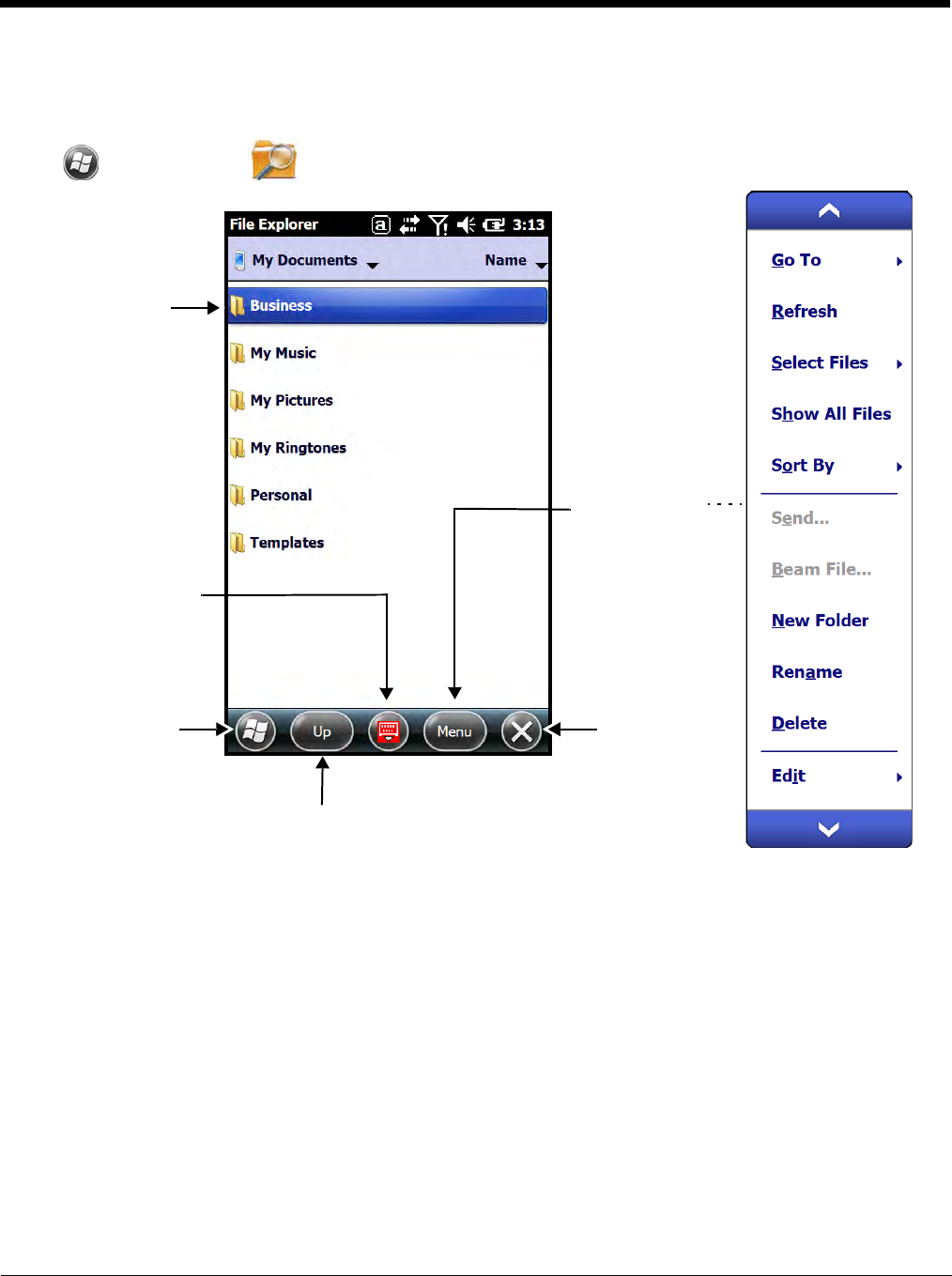
2 - 10
File Explorer
You can use the File Explorer to find files and organize files into folders.
Touch > File Explorer .
To move or copy files between folders using File Explorer:
1. Touch and hold on the item you want to move, then touch Cut or Copy on the popup menu.
2. Navigate to the folder you want to move or copy the file to, then touch and hold a blank area of the
window.
3. Touch Paste on the pop-up menu.
Note: If there is no blank space available in the window, touch
Menu
on the tile bar, navigate to the end of the
menu using the down arrow, then touch
Edit
>
Paste
.
Touch to return to
the Start menu.
Touch to access
additional Menu
options.
Touch to move Up one
level in the directory.
Touch to close
File Explorer.
Touch on the name to
open a file or folder.
Touch to toggle the virtual
keyboard display on or off.
Touch and hold to access a
pop-up menu of keyboard
options.
Preliminary Draft 6/19/13, Not for Release

2 - 11
File Provisioning on the Dolphin 60s
\IPSM\Honeywell
The IPSM folder is the only partition on the terminal that persists across a kernel upgrade (*.UPG file
extension). During a kernel upgrade, files are automatically copied from the \IPSM\Honeywell folder
and then installed in the \Honeywell (root file system) folder as part of the upgrade process.
\IPSM\Honeywell\AutoInstall
The files in the IPSM\Honeywell\AutoInstall folder are only installed when a factory reset or
kernel upgrade occurs. Once the files are installed, they persist through hard and soft resets. If a file is
added to the folder and a hard or soft reset is performed, it will have no effect. If a program is manually
removed using the Remove Programs application (see page 7-25), then the program is not automatically
re-installed on a hard or soft reset.
\Honeywell
The Honeywell partition or root file system partition is persistent over a hard reset, soft reset, and the
removal of the battery pack or the removal of AC power. However, during a kernel upgrade the root file
system is reformatted so all data in the folder is deleted and replaced by any files in the
\IPSM\Honeywell folder as part of the upgrade process.
To prevent data loss, back up all user data to an SD card or external memory device before performing an
upgrade.
\Honeywell\AutoInstall
If you run a CAB file from within the \Honeywell\AutoInstall (user store) folder, after the program
has been installed, the CAB file will be deleted from the User Store. However, the program remains
installed through all successive Hard and Soft resets.
If you want the program to be part of the Autoinstall that occurs after a factory reset or software upgrade,
paste the program file(s) in both the \IPSM\Honeywell\Autoinstall folder and the
\Honeywell\Autoinstall.
Contact a Honeywell technical support representative for information on how to perform a factory reset
or for information on available software upgrades for your Dolphin terminal. For contact information, see
Technical Assistance on page 14-1.
To prevent data loss, back up all user data to an SD card or external memory device before performing an
upgrade.
Search
The Search feature helps you quickly locate information. Touch > Search Phone .
Enter the text you want to find, select a data type, and then touch Search. Select Larger than 64 KB in
the Type drop-down field to quickly find information that is taking up storage space.
!
!
Preliminary Draft 6/19/13, Not for Release
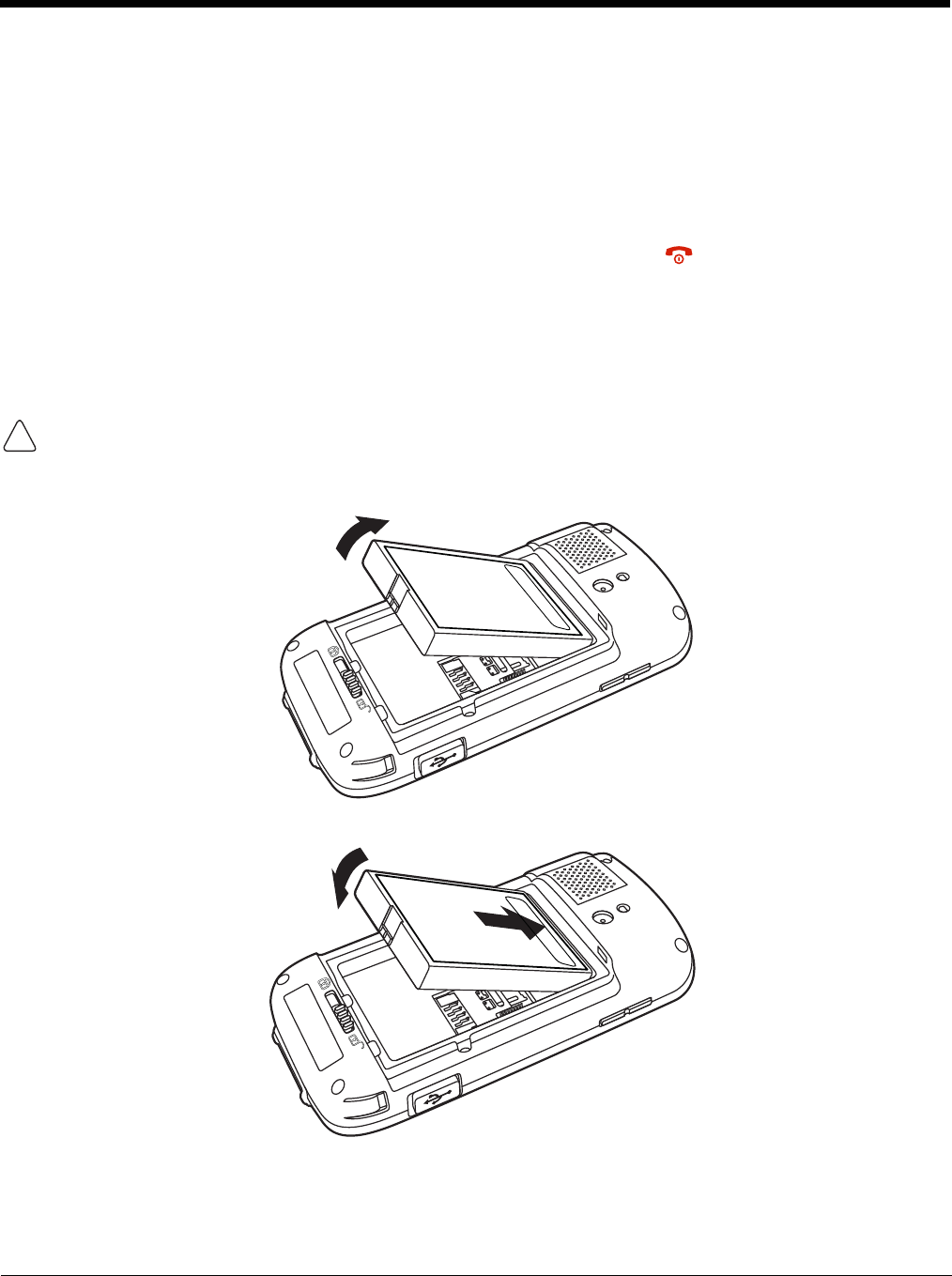
2 - 12
Suspend Mode
In Suspend mode, the device enters a low power state to conserve battery power. The radio associated
with the phone maintains enough power to wake the terminal for incoming phone calls.
Suspend mode automatically turns the touch screen off to save battery power when the terminal is
inactive for a programmed period of time. The automatic timeout limits are adjustable from the
Advanced tab located under Settings > System > Power (see page 7-23).
To put the device into Suspend mode, press and release the Power key for approximately 4-5
seconds. To resume from the Suspend mode, press and release the Power key.
Replacing the Main Battery
Note: Before replacing the main battery, read the Guidelines for Battery Pack Use and Disposal on page 3-14.
Ensure all components are dry prior to mating terminals/batteries with peripheral devices. Mating wet
components may cause damage not covered by the warranty.
1. Remove the battery door, slide the latch to unlock the battery door, remove the battery door, then
remove the battery.
2. Insert the new battery, then attach and lock the battery door.
Note: Do not attempt to use the terminal without the battery door installed.
3. The terminal begins booting as soon as power is applied.
!
Preliminary Draft 6/19/13, Not for Release

2 - 13
We recommend use of Honeywell Li-ion battery packs. Use of any non-Honeywell battery may result in
damage not covered by the warranty.
Resetting the Terminal
There are three types of system resets: a Soft Reset, a Hard Reset, or a Factory Reset. The soft and
hard resets preserve all data stored in the file system. Contact a Honeywell technical support represen-
tative for more information on how to perform a Factory Reset. For contact information, see Technical
Assistance on page 14-1.
Soft Reset (Warm Boot)
A Soft Reset re-boots the device and preserves any objects created in RAM. You would perform a soft
reset when: the terminal fails to respond, after installing some software applications, or after making
changes to certain system settings, such as network cards.
To perform a Soft Reset:
1. Press and hold the Blue key and then Power key for approximately 6-7 seconds.
2. When the reset is complete, the Home screen displays.
Hard Reset (Cold Boot)
A Hard Reset re-boots the terminal and closes any open applications running in RAM at the time of the
reset.
To perform a Hard Reset:
1. Press and hold the Blue key and then Send key for approximately 6-7 seconds.
2. When the reset is complete, the Home screen displays.
!
Preliminary Draft 6/19/13, Not for Release

2 - 14
Preliminary Draft 6/19/13, Not for Release

3 - 1
3
Hardware Overview
Standard Configurations for the Dolphin 60s
WLAN, WPAN & Camera
• Microsoft Windows Embedded Handheld
6.5 Professional
• TI AM3715 Cortex-A8 800MHz Processor
• 256MB RAM X 512MB Flash
• 3.7V Li-ion rechargeable extended battery
pack
• Dedicated imager capable of decoding
standard 1D and 2D bar code symbologies
• 5.0 megapixel auto focus camera
• 802.11b/g/n and Bluetooth
WLAN, WPAN, WWAN, GPS & Camera
• Microsoft Windows Embedded Handheld
6.5 Professional
• TI AM3715 Cortex-A8 800MHz Processor
• 256MB RAM X 512MB Flash
• 3.7V Li-ion rechargeable extended battery
pack
• Dedicated imager capable of decoding
standard 1D and 2D bar code symbologies
• 5.0 megapixel auto focus camera
• 802.11b/g/n and Bluetooth,
• Voice and Data, GSM/CDMA/GPS (US
bands) - SW Definable Radio
WLAN, WPAN, WWAN, NFC, GPS & Camera
• Microsoft Windows Embedded Handheld
6.5 Professional
• TI AM3715 Cortex-A8 800MHz Processor
• 256MB RAM X 512MB Flash
• 3.7V Li-ion rechargeable extended battery
pack
• Dedicated imager capable of decoding
standard 1D and 2D bar code symbologies
• 5.0 megapixel auto focus camera
• 802.11b/g/n and Bluetooth
• Voice and Data, GSM/CDMA/GPS (US
bands) - SW Definable Radio
•NFC
WLAN, WPAN, WWAN, GPS & Camera
• Microsoft Windows Embedded Handheld
6.5 Professional
• TI AM3715 Cortex-A8 800MHz Processor
• 256MB RAM X 512MB Flash
• 3.7V Li-ion rechargeable extended battery
pack
• Dedicated imager capable of decoding
standard 1D and 2D bar code symbologies
• 5.0 megapixel auto focus camera
• 802.11b/g/n and Bluetooth
• Voice and Data GSM/GPS (EU Bands)
WLAN, WPAN, WWAN, NFC, GPS & Camera
• Microsoft Windows Embedded Handheld
6.5 Professional
• TI AM3715 Cortex-A8 800MHz Processor
• 256MB RAM X 512MB Flash
• 3.7V Li-ion rechargeable extended battery
pack
• Dedicated imager capable of decoding
standard 1D and 2D bar code symbologies
• 5.0 megapixel auto focus camera
• 802.11b/g/n, and Bluetooth
• Voice and Data, GSM/GPS (EU Bands)
•NFC
Preliminary Draft 6/19/13, Not for Release

3 - 2
Peripherals for the Dolphin 60s
Each of the following items is sold separately to enhance the capabilities of your Dolphin terminal.
Dolphin 60s
HomeBase
Device (Model D60s-HB)
The Dolphin 60s HomeBase device is a charging and communication cradle equipped with a USB host
port that is Hi-Speed 2.0v compliant, which enables the terminal to interface with the majority of PC-
based enterprise systems. This device also contains an auxiliary battery well that charges a spare
Honeywell extended battery pack.
For more information, see Dolphin 60s HomeBase Device (Model D60s-HB) on page 12-1.
Dolphin 60s Mobile Base Device (Model 60s-MB)
The Dolphin 60s Mobile Base is a charging cradle designed specifically for in-premise and in-transit data
collection applications. It features a flexible mounting bracket, an integrated speaker with volume control,
and a cigarette lighter adapter to adapt it to your mobile environment.
For more information, see Dolphin 60s Mobile Base Device (Model 60s-MB) on page 13-1.
Preliminary Draft 6/19/13, Not for Release

3 - 3
Accessories for the Dolphin 60s
Each of the following items is sold separately to enhance your terminal’s capabilities.
Note: When using accessories where the terminal is worn on the body, the terminal’s touch panel must face away
from the body.
Dolphin 60s Mobile Charger (Model 60s-MC)
The Dolphin 60s Mobile Charger is a charging cable that connects the terminal directly to a 12 Volt DC
power source, such as a cigarette lighter port inside a vehicle, eliminating the need for a cradle. Intel-
ligent battery technology on-board the terminal ensures proper charging. The Dolphin 60s Mobile
Charger is an ideal low-cost charging solution for in-transit mobile applications.
USB Charge/Communication Cable and Adapter Kit (Model 60s-USB ADAPTERKIT)
The Dolphin USB charge/communication cable adapter kit is an all-in-one solution for charging and
communication. Use the 60s-USB cable in conjunction with provided power supply adapter and plug
adapter to charge the terminal from a power outlet or connect the cable to a high-power USB port to
charge from a host device. The 60s-USB cable also supports communication with a computer without
the need for a cradle. See Connecting and Synchronizing the Terminal and Workstation on page 8-9.
Holster (Model HOLSTER-1)
The holster provides convenient storage for the Dolphin 60s terminal in mobile environments. The
holster features an integrated belt clip and spare battery pouch.
Battery
The rechargeable battery provides the main power for the terminal. For more information, see Battery on
page 3-10.
Preliminary Draft 6/19/13, Not for Release
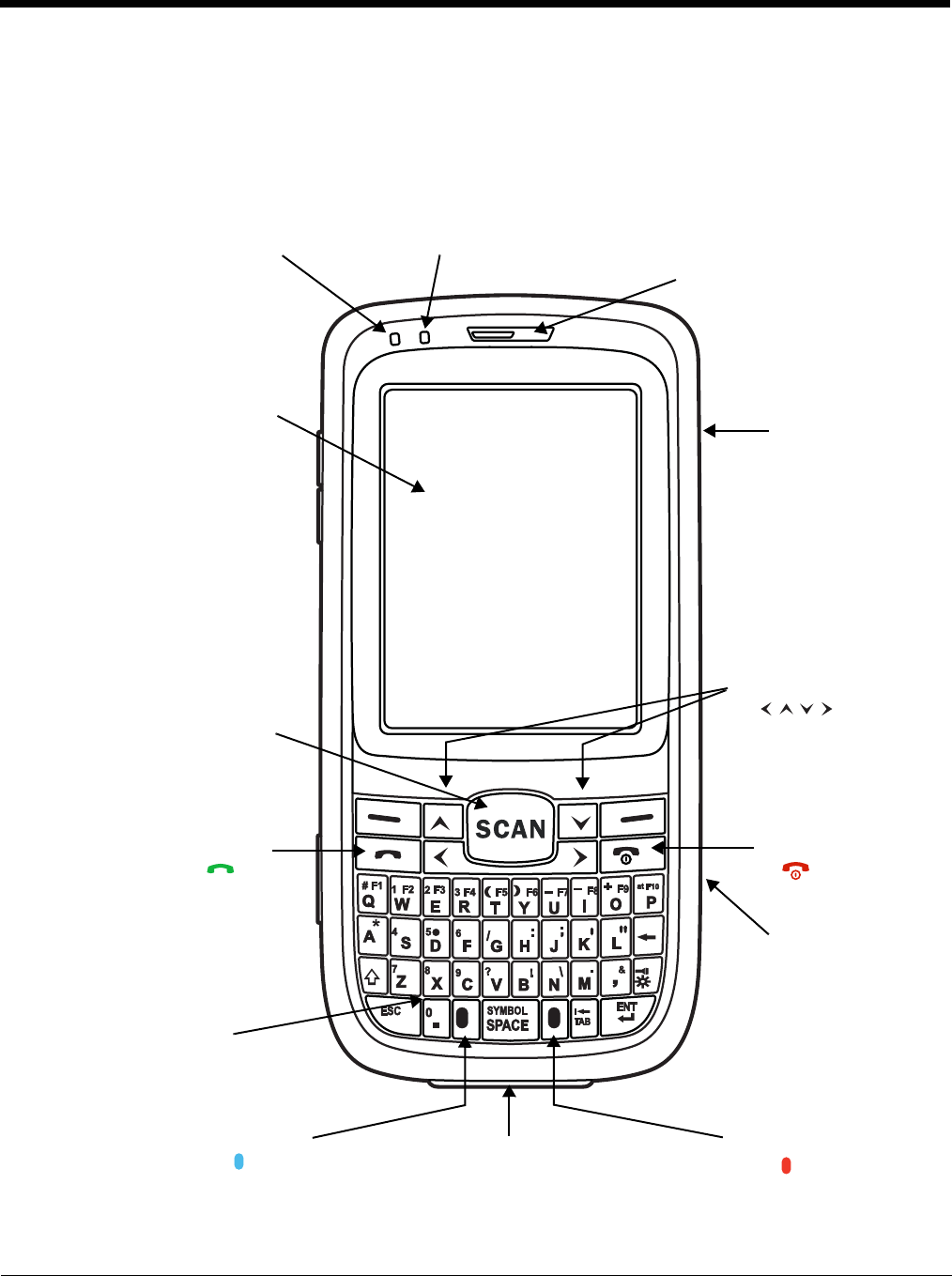
3 - 4
Features of the Dolphin 60s
Note: Your Dolphin model may differ from the model illustrated; however, the features noted are standard for all
Dolphin 60s models with a Windows Embedded Handheld OS unless otherwise indicated. For a complete
overview of the optional keyboards available for the Dolphin 60s, .
Front Panel
For a description of each callout, see page 3-5.
Power/End Call Key
Touch Panel Display
Scan Button
Charge
General Notification LED
Charge Indicator LED
Send Button
Microphone
Blue Modifier Key Red Modifier Key
I/O Connector
(see page 3-10)
Right Scan/Image
Button
Navigation Keys
Audio Jack
Preliminary Draft 6/19/13, Not for Release

3 - 5
Feature Descriptions: Front Panel
Audio Jack
The 3.5mm audio jack supports both speaker (stereo) and microphone (mono) headsets.
Blue Modifier Key
See Using the Modifier Keys on page 6-3.
Power/End Call Key
The Power/End Call key, located in the upper right corner of the keypad, puts the terminal in
Suspend Mode or wakes the terminal from Suspend Mode. See Suspend Mode on page 2-11.
The key is also used to end/disconnect a phone calls.
Charge Indicator LED
The light emitting diode (LED) located above the top left corner of the LCD display illuminates
when the Power Tools BattMon application is enabled and the device is on AC charge. For
more information, consult the Dolphin Power Tools User’s Guide for Windows Embedded
Handheld 6.5.
Front Speaker
The front speaker is the receiver for handset voice calls. See Voice Communication on page
9-4.
General Notification LED
The light emitting diode (LED) located above and to the right of the LCD display flashes and
illuminates during resets, scanning/imaging, and taking a picture. The LED indicates that an
external power source is connected to the terminal. This LED can be programmed by various
software applications.
Microphone
The integrated microphone that provides audio input for handset and speaker phone voice
calls. See Voice Communication, Using the Dolphin as a Phone on page 9-3.
Navigation Keys
The centrally located navigation keys enable you to move and position the cursor through
software programs. The up and down arrows are programmed to perform specific functions
when pressed in combination with the Blue and Red modifier keys. For more details, see Using
the Navigation Keys on page 6-3.
Red Modifier Key
See Using the Modifier Keys on page 6-3.
Right Scan/Image Button
By default, the right button triggers the scanner/imager. You can reassign the button to launch
applications or execute commands. For additional information, see Changing Button
Assignments on page 7-5.
Scan Button
The Scan button is centrally located for easy access with the right or left hand. By default, the
button activates the scanner/imager.
Preliminary Draft 6/19/13, Not for Release

3 - 6
Send Button
Answers a phone call or initiates a phone call. See Voice Communication on page 9-4.
Touch Panel Display
The color 2.8 inch (liquid crystal display (LCD) touch panel is covered with an industrial,
protective lens for greater durability. The quarter video graphic array (QVGA) display
resolution is 240 X 320. The touch panel can be activated with a finger or with the stylus.
The touch panel backlight illuminates when the screen is touched. For more information, see
Backlight on page 7-12.
Preliminary Draft 6/19/13, Not for Release
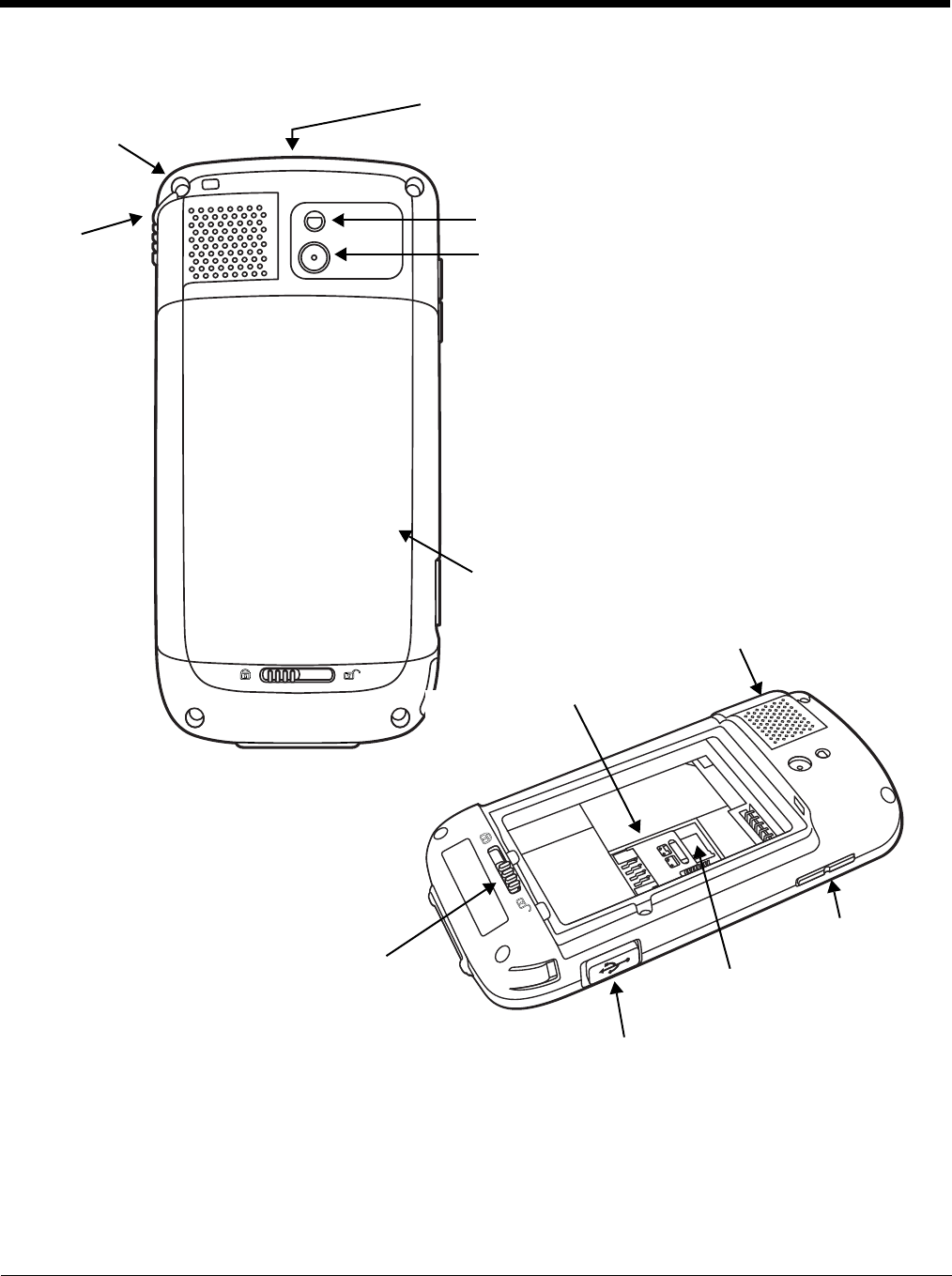
3 - 7
Back Panel
Note: Your Dolphin model may differ from the model illustrated; however, the features noted are standard for all
Dolphin 60s with Windows Embedded Handheld models unless otherwise indicated.
For a description of each callout, see Feature Descriptions: Back Panel on page 3-8.
Image Engine Window (LED Aimer Aperture)
Fastener for the
Stylus Tether
Battery Lock
Battery Lock (battery and
battery door not shown)
SIM Card Socket
Back Speaker
Volume Control
Button
Battery Door
Memory Card Socket
USB Door/Micro USB Port
Lanyard Slot
Stylus/Stylus
Slot
Preliminary Draft 6/19/13, Not for Release

3 - 8
Feature Descriptions: Back Panel
Back Speaker
The integrated rear speaker sounds audio signals as you scan bar code labels and enter data.
The integrated speaker also supports playback of wave and MP3 files, software mixer, and
Speakerphone for WWAN/GSM audio. The operating frequency range is 600-3000Hz at
>90dB.
Battery
Dolphin 60s model terminals are designed for use with battery part number
BAT-EXTENDED-01 (Li-ion 3.7 V, 12.358 watt hour) manufactured for Honeywell International
Inc. For information on how to remove the battery, see Replacing the Main Battery on page 2-
12.
Battery Door
The battery door protects the battery and any installed SIM and/or memory cards in the
terminal’s battery well. When the battery door is installed properly, the terminal’s
environmental rating is preserved. For information on how to remove the battery, see
Replacing the Main Battery on page 2-12.
Note: Do not use the terminal without the battery door installed.
Battery Lock
The Battery Lock allows the user to lock the battery door in place.
Color Camera
The 5.0-Megapixel Resolution auto-focus color camera provides easy picture and video
capture. The camera lens and camera flash are located on the back panel of the terminal.
Fastener for the Stylus Tether
The Stylus Tether helps prevent accidental loss when the stylus is not stored in the stylus slot.
A stylus tether is a coiled, elastic cord that tethers the stylus to the terminal. Secure one end
of the cord to the back panel of the terminal and the other end to the stylus.
Flashlight/Camera Flash
The flashlight/camera flash is located on the back panel of the terminal.
When used as a Flashlight, touch > Flashlight or press the Red Key > ,to
turn the flashlight On or Off.
When used as a Camera Flash with the terminal’s color camera, the flash is controlled by the
camera application.
Image Engine Window
The image engine reads and decodes linear, stacked linear (e.g., PDF417), and 2D matrix bar
code symbologies. The LED aperture for the imaging engine’s LED aimer is contained behind
this window. For more details, see Using the Scan Image Engine on page 4-1.
Preliminary Draft 6/19/13, Not for Release

3 - 9
Memory Card Socket
The memory card socket provides the user with the option to expand the terminal’s memory
capacity using microSD or microSDHC memory interfaces. The expansion socket is located
under the battery door and battery.
Note: Honeywell recommends the use of Single Level Cell (SLC) industrial grade microSD or
microSDHC memory cards with Dolphin terminals for maximum performance and durability.
Contact a Honeywell sales representative for additional information on qualified memory card
options.
When the battery door and battery pack are properly installed, the card is sealed against
moisture and particle intrusion, read/write data is stored securely, and the terminal’s
environmental rating is preserved; see Installing a SIM Card and/or Memory Card on page 3-
16.
SIM Card Socket
The card socket for the Subscriber Identity Module (SIM) is located under the battery door and
main battery. When the battery door and battery are properly installed, the card is sealed
against moisture and particle intrusion, read/write data is stored securely, and the terminal’s
environmental rating is preserved; see Installing a SIM Card and/or Memory Card on page 3-
16.
Stylus/Stylus Slot
The stylus is used to operate the touch panel. The back panel of the terminal features a storage
slot to hold the stylus when not in use. The stylus features a special tip for added accuracy and
ease of use.
USB Door/Micro USB Port
The Micro USB port is located under the protective USB door on the right side of the terminal.
To access the micro USB port, gently lift the top edge of the door closest to the digital
microphone, and then twist 90° counterclockwise.
The micro USB port in conjunction with the USB Charge/Communication Cable (model 70e-
USB) powers the terminal, charges the main battery, and facilitates communication. The micro
USB port supports low, full, and high-speed USB v2.0 client communication with a maximum
rate of 480 Mbps.
For additional information, see Using the USB Charge/Communication Cable (Model 60s-USB
ADAPTERKIT) on page 2-2 and Connecting and Synchronizing the Terminal and Workstation
on page 8-9.
Volume Control Button
Press the top or bottom of the volume button to raise or lower the volume of the active speaker.
Preliminary Draft 6/19/13, Not for Release
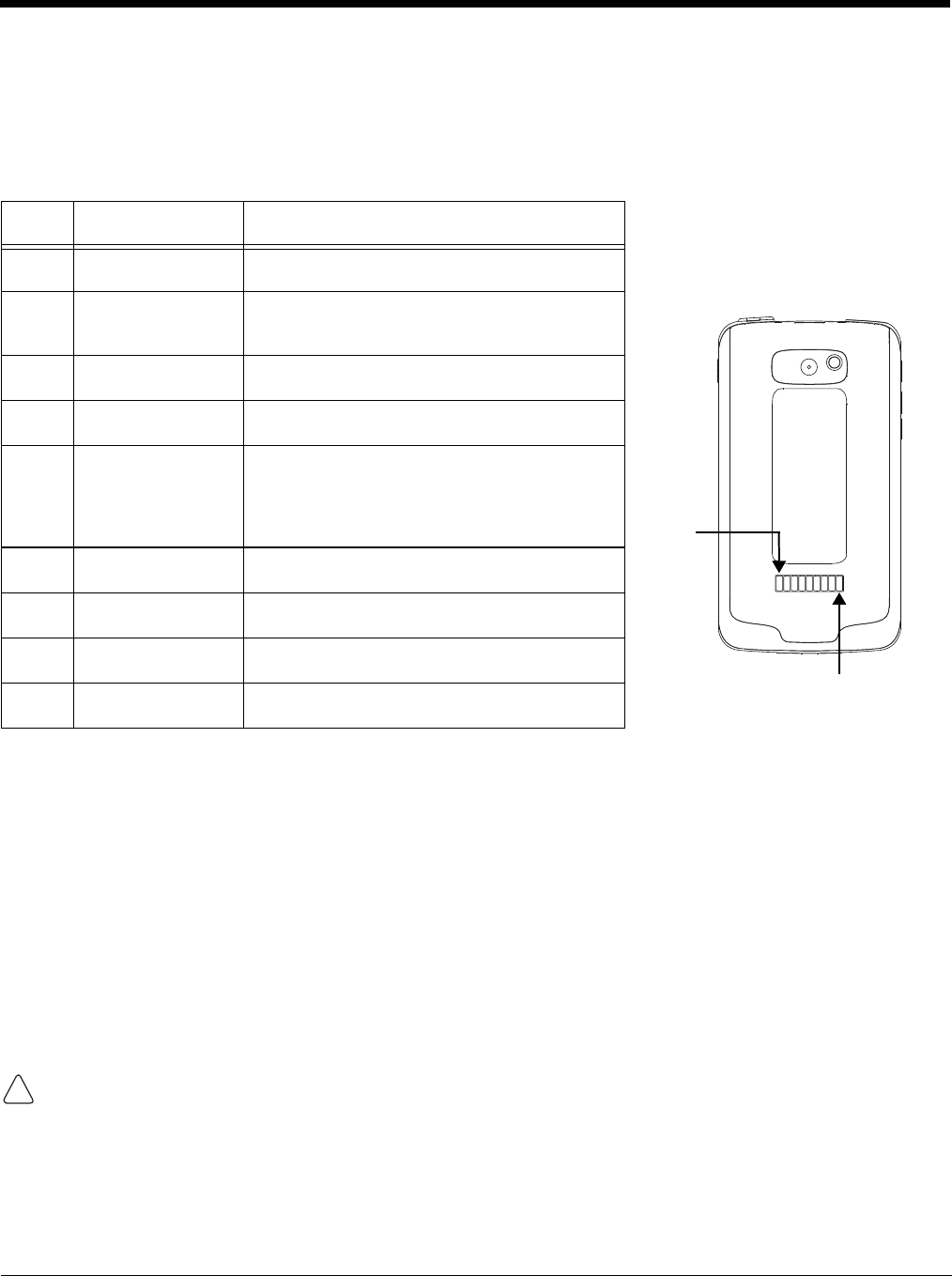
3 - 10
The I/O Connector
The I/O connector powers the terminal, charges the main battery, and facilitates communication. Dolphin
60s peripherals are designed to work exclusively with this connector. The I/O connector supports low,
full, and high speed USB v2.0 communication with a maximum rate of 480 Mbps.
Note: Signals referenced are for a DTE device.
Battery
The primary power source for the Dolphin terminal is the 3.7V Li-ion rechargeable battery located under
the battery door on the back panel of the device. Honeywell recommends, you keep the battery in the
terminal charged at all times to help prevent data loss. Letting the battery become fully discharged
causes the terminal to lose all data in RAM.
Note: All data in RAM is cleared when the battery is removed. Always Power Off the terminal before removing the
battery to ensure any changes made are saved to the flash memory.
Dolphin 60s model terminals are designed for use with battery part number BAT-EXTENDED-01 (Li-ion
3.7 V, 12.358 watt hour) manufactured for Honeywell International Inc.
We recommend use of Honeywell Li-ion battery packs. Use of any non-Honeywell battery may result in
damage not covered by the warranty.
Charging Options
Dolphin terminals ship with the battery significantly discharged of power. The battery must be
completely charged for a minimum of 6 hours before using a Dolphin terminal for the first time.
Pin Signal Description
1 VDC_IN 5V DC input for charging and operation
2 VBUS_HOST 5V output for USB host and peripheral
power
3 USB_DM_HOST USB D- for the host port
4 USB_DP_HOST USB D+ for the host port
5 USBC_DET Multipurpose pin to allow for detection of an
unpowered SLED, determine SLED type,
and to signal a HomeBase the docking of
the terminal.
6 GND Ground connection
7 USB_DN_DOCK USB D- for the client port
8 USB_DP_DOCK USB D+ for the client port
9 VBUS_DOCK 5V input for USB client (and charging)
Pin 1
Pin 9
Terminal Back Panel
!
Preliminary Draft 6/19/13, Not for Release

3 - 11
When the main battery is installed in the terminal, use one of the following:
•Dolphin 60s HomeBase Device (Model D60s-HB), see page 12-1
•Dolphin 60s Mobile Base Device (Model 60s-MB), see page 13-1
• Dolphin 60s USB Charge/Communication Cable (Model 60s-USB ADATPERKIT), see page 2-2
When the main battery is not installed in the terminal:
• Place the battery pack in the Auxiliary Battery Well of the Dolphin 60s HomeBase Device (Model D60s-
HB).
For information on how to remove the battery from the terminal, see Replacing the Main Battery on page
2-12.
Charging Time
The extended battery pack requires 6 hours to charge completely.
Note: Using the terminal while charging the battery significantly increases the time required to reach a full charge.
Important Charging Guidelines
Source Current Specifications
Battery charging times can be significantly lengthened or charging may not occur if the terminal is
drawing more currant than is supplied by the charging peripheral (e.g., HomeBase), USB wall charger, or
USB Host (e.g., workstation PC).
• The maximum current supplied through a charging peripheral is 2.0A.
• The maximum current supplied by the USB wall charger is 900 mA.
• The maximum current supplied by a USB Host can vary from 100mA to 500mA.
Do not attempt to charge the terminal from a 100 mA source. An active Dolphin terminal uses more
current than supplied by a 100 mA source causing the terminal to continue to draw power from the
battery.
Note: Placing the terminal in Suspend mode while charging reduces the current draw of the terminal and shortens
the charging time of the battery.
To verify your terminal is not drawing more current then supplied by the charging source:
1. Touch > Settings > System > Battery when the terminal is connected to a
charging source.
2. Check the Battery Current. If the current is positive, then charging current is going into the battery. If
the current is negative, the battery is discharging current and your terminal is drawing more current
than the charging source.
Note: The charging current is always less than source current due to the terminal being in operation.
Preliminary Draft 6/19/13, Not for Release

3 - 12
Charging a Severely Low or Completely Discharged Battery
Use one of the following options to charge a severely low or completely discharged battery.
1. Insert the battery into the auxiliary battery well of the HomeBase. When the auxiliary battery LED on
the HomeBase turns green, the battery is fully charged.
2. Dock the terminal into the charging well of a peripheral (e.g., HomeBase). The terminal starts to boot
as soon as power is supplied by the base.
Note: To prevent the possible loss of unsaved data, do not remove the terminal from the base until the battery
has sufficiently charged. Touch the Start > Settings > System > Battery to view detailed information
on the status of the battery.
3. Charge the terminal from a wall power outlet using the USB Charge/Communication Cable and
power supply provided with your terminal. As the battery charges, the charge indicator LED will be
red. When the battery reaches a safe charge threshold and the terminal begins to boot. The length
of time before the battery reaches a safe charge threshold varies depending on the extent of the
battery discharge.
4. Charge the terminal from a USB host device (PC) using the USB Charge/Communication Cable.
Note: Inadequate source current may interfere with effective battery charging; see Important Charging
Guidelines on page 3-11 for additional information.
As the battery charges, the charge indicator LED will be red. When the battery reaches a safe
charge threshold and the terminal begins to boot. The length of time before the battery reaches a
safe charge threshold varies depending on the extent of the initial battery discharge level and the
current supplied by the USB charging source.
Battery Error Notification
If your terminal displays the following indicators, replace the battery with a Honeywell Dolphin 60s
extended battery pack. For information on how to remove the battery from the terminal, see Replacing
the Main Battery on page 2-12.
• An “Authentication Error” pop up window appears during startup.
• appears in the Title bar at the top of the touch screen.
• The General Notification LED illuminates red.
• A Notification appears on the Tile bar at the bottom of the touch screen.
Storing Batteries
To maintain top performance from batteries, avoid storing batteries outside of the following temperature
ranges:
• 14°F to 113°F (-10°C to +45°C) for short term storage of less than one month
• 32°F to 86°F (-0°C to +30°C) for long term storage
Battery Charge Status Symptom
Severely Low Pressing the Power button does not wake the terminal from Suspend mode. The general
notification LED may flash once when the Power button is pressed.
Completely Discharged Pressing the Power button does not wake the device and the general notification LED
remains off.
Preliminary Draft 6/19/13, Not for Release

3 - 13
Do not store batteries in extremely high humidity. For prolonged storage, do not keep batteries stored in
a charger that is connected to a power source.
Preliminary Draft 6/19/13, Not for Release

3 - 14
Guidelines for Battery Pack Use and Disposal
The following are general guidelines for the safe use and disposal of batteries:
• Do not disassemble or open crush, bend or deform, puncture or shred.
• Do not modify or remanufacture, attempt to insert foreign objects into the battery, immerse or
expose to water or other liquids, expose to fire, explosion or other hazard.
• Improper battery use may result in a fire, explosion or other hazard.
• We recommend use of Honeywell Li-ion battery packs. Use of any non-Honeywell battery may
pose a personal hazard to the user.
• Only use the battery for the system for which it is specified. Do not use a battery in any other
manner outside its intended use in Dolphin terminals and peripherals.
• Only use the battery with a charging system that has been qualified with the system per CTIA
Certification Requirements for Battery System Compliance to IEEE 1725. Use of an unqualified
battery or charger may present a risk of fire, explosion, leakage, or other hazard.
• Replace the battery only with another battery that has been qualified with the system per this
standard, IEEE-Std-1725. Use of an unqualified battery may present a risk of fire, explosion,
leakage or other hazard.
• Replace defective batteries immediately; using a defective battery could damage the Dolphin
terminal.
• Never throw a used battery in the trash. Promptly dispose of used batteries in accordance with
local regulations.
• Do not short-circuit a battery or throw it into a fire; it can explode and cause severe personal
injury. Do not allow metallic conductive objects to contact battery terminals.
• If you observe that the Honeywell battery supplied is physically damaged, please send it to
Honeywell International Inc. or an authorized service center for inspection, see Product Service
and Repair on page 14-1.
• Battery usage by children should be supervised.
• Avoid dropping the terminal or battery. If the terminal or battery is dropped, especially on a hard
surface, and the user suspects damage, send it to a Honeywell International Inc. or an authorized
service center for inspection.
• If you are not sure the battery or charger is working properly, send it to Honeywell International
Inc. or an authorized service center for inspection, see Product Service and Repair on page 14-1.
• Excessive discharge can degrade battery performance. Recharge the battery when your terminal
indicates low battery power.
• Although your battery can be recharged many times, the battery life is limited. Replace it after the
battery is unable to hold an adequate charge.
• The Dolphin 60s should only be connected via its microUSB connector to CTIA certified
adapters, products that bear the USB-IF logo or products that have completed, the USB-IF
compliance program.
Managing Battery Power
Letting the battery become fully discharged causes the terminal to lose all data in RAM. Honeywell
recommends, you keep a charged battery in the terminal at all times to help prevent data loss. Removing
the battery from the terminal erases all non-persistent memory.
Default Critical and Low Battery Points
When the terminal is running on battery power (as opposed to external power), warnings are displayed
when the battery reaches critical and low battery points. The warning points are determined by the
following registry entry:
[HKEY_LOCAL_MACHINE\ControlPanel\Power]
Preliminary Draft 6/19/13, Not for Release
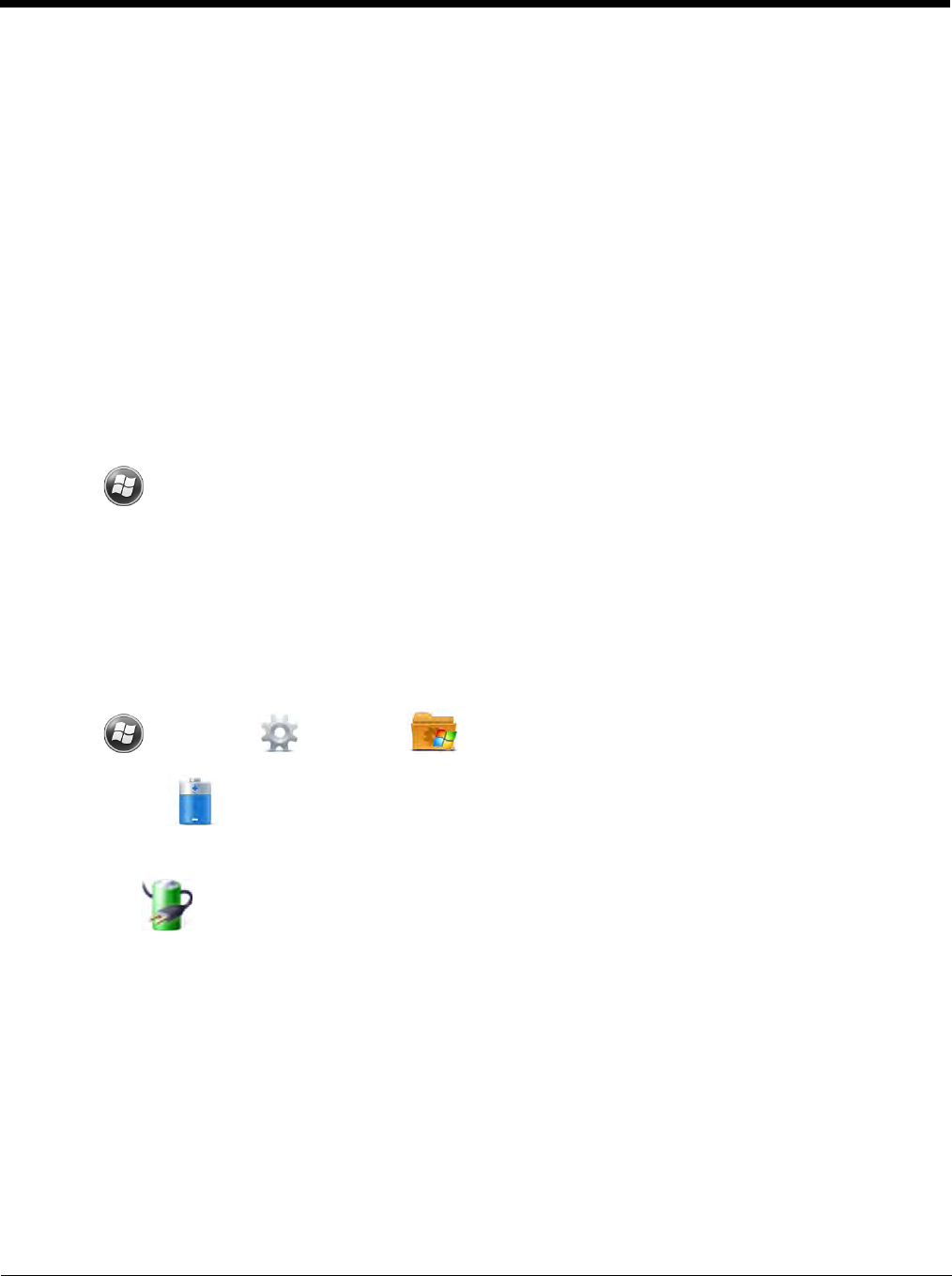
3 - 15
There are two DWORD values in this registry entry: MedState and LowState.
The default values for these entries are as follows:
MedState=25%
This sets the Low Battery point to 25%. When the battery hits the percentage charge specified
here, the user is notified.
LowState=10%
This sets the Critical Battery point to 10%. When the battery hits the percentage charge
specified here, the user is notified.
Note: Warnings do not appear when the terminal is on external power.
Setting Critical and Low Battery Points
Developers can reset the battery parameters in the registry from 0 (no warning) to 99 (would nearly
always warn). You can review and set these battery points in the RegEdit Power Tool.
1. Touch > Power Tools > RegEdit.
2. Drill down to HKEY_LOCAL_MACHINE > ControlPanel > Power.
3. Touch the Value Name (i.e., MedState or LowState) to change the Value Data.
You can reset the Value Data from 0 (no warning) to 99 (would nearly always warn).
4. Touch OK to save changes.
Checking Battery Power
1. Touch > Settings > System
2. Touch Power to view the power status of the main battery.
Or
Tou ch Battery to view detailed information on the installed battery pack.
For additional information on Advanced Power Settings, see page 7-25.
For additional information on the Battery Log Configuration, see page 7-14.
System Resets
See Resetting the Terminal on page 2-13.
Preliminary Draft 6/19/13, Not for Release
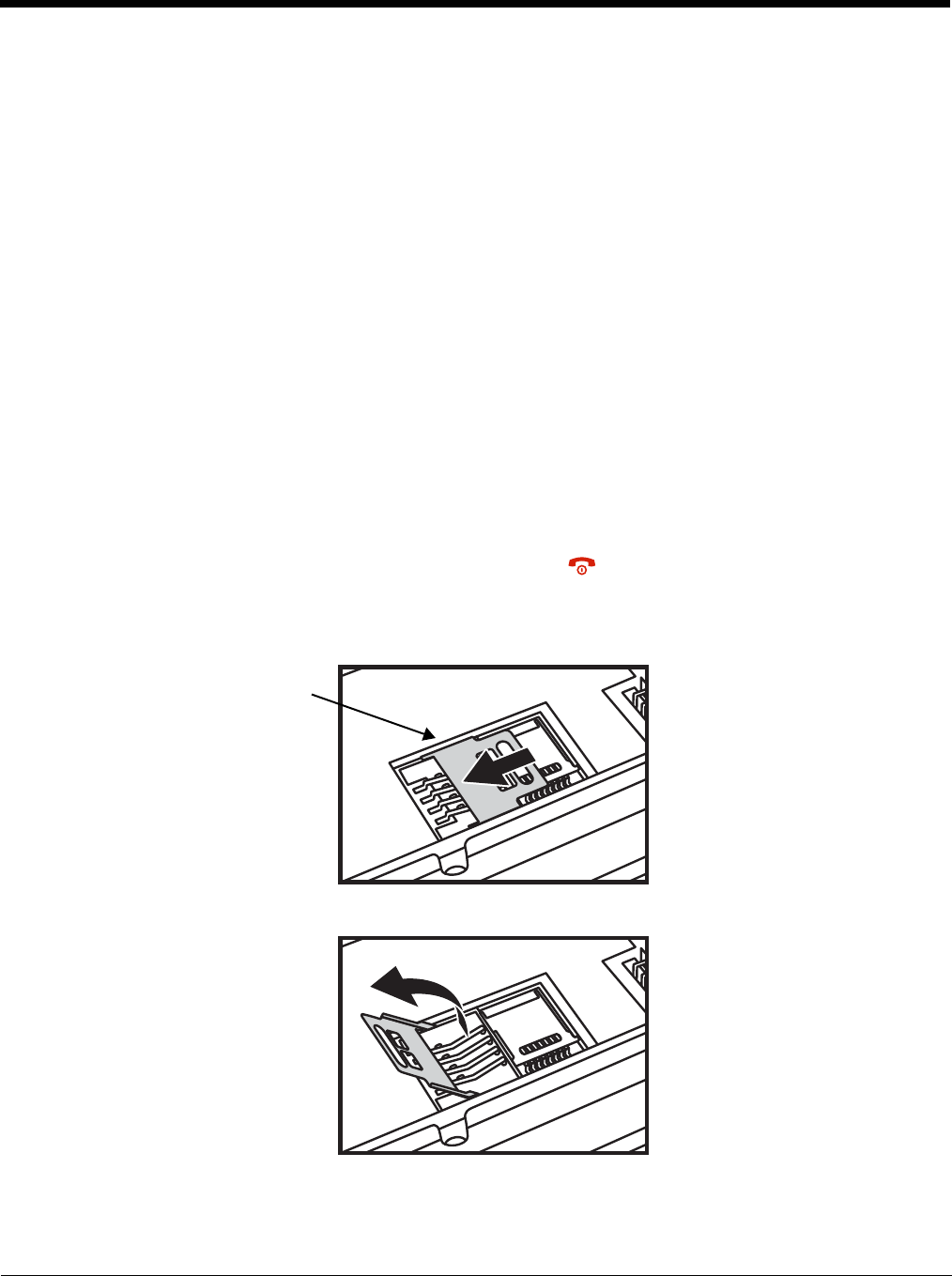
3 - 16
Hardware Maintenance
When needed, clean the image engine window and the touch screen with a clean, non-abrasive, lint-free
cloth. The terminal can be cleaned with a damp cloth.
Important - All battery and connector doors must be present, undamaged, and properly closed on the
terminal to maintain an IP54 rating.
Installing a SIM Card and/or Memory Card
SIM Card
Short for Subscriber Information Module, a SIM card stores the subscriber's personal information,
GSM/GPRS radio settings, security keys, contacts, etc. SIM cards can be installed in compatible mobile
devices, enabling you to switch devices without losing personal and setup information.
Before installing the SIM card, the service provider must activate the SIM card.
Note: If no SIM card is installed, you can still make emergency phone calls (e.g., 9-1-1).
Installation
1. Suspend the terminal. Press and release the Power key for approximately 4-5 seconds.
2. Unlock and remove the battery door, then remove the battery.
3. Slide the SIM Card latch toward the bottom of the terminal to unlock.
4. Lift the SIM card latch.
SIM Card Latch
Preliminary Draft 6/19/13, Not for Release
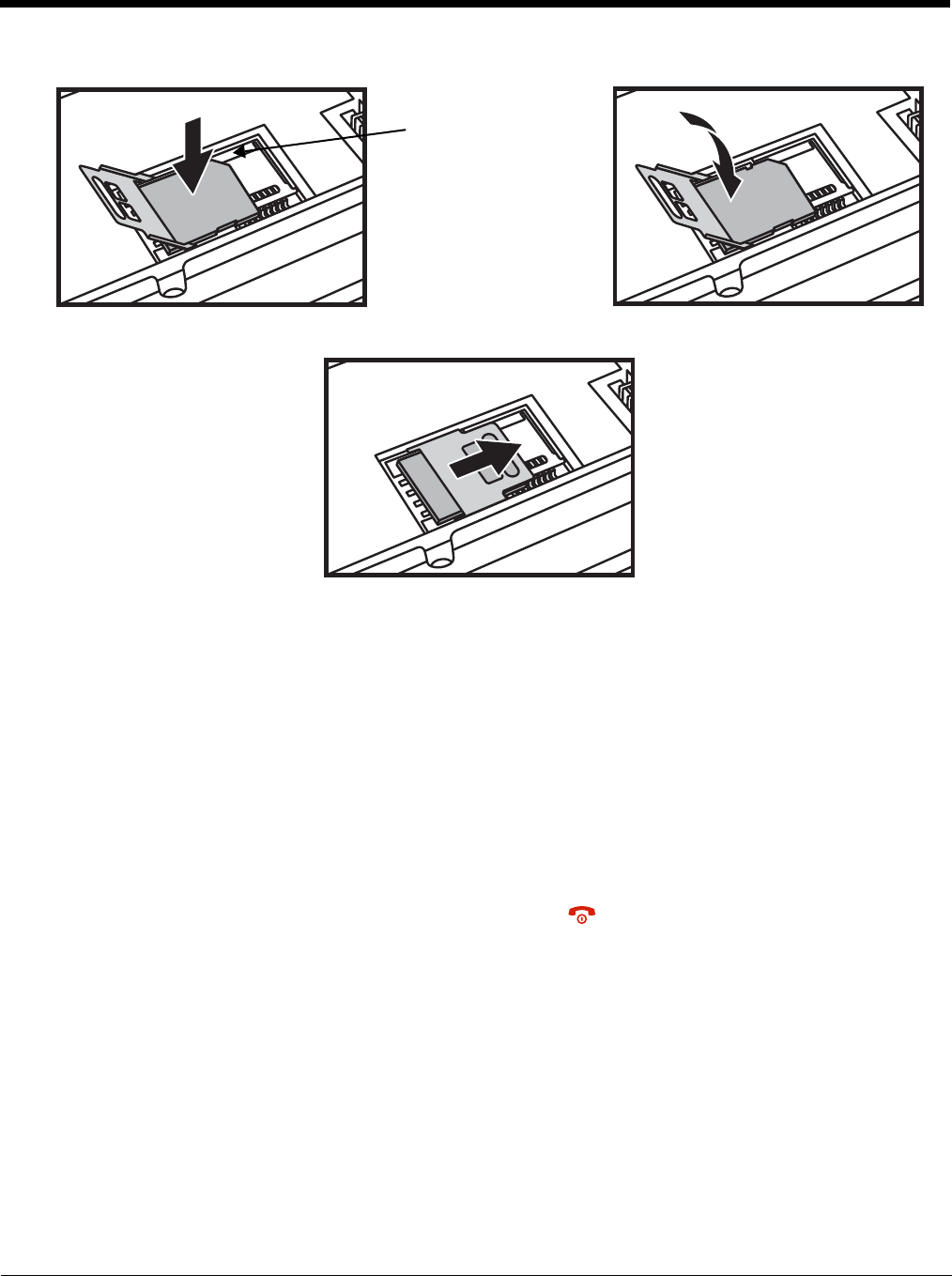
3 - 17
5. Slide the SIM (contacts facing down) into the socket, then close the SIM card latch.
6. Lock the SIM card latch by sliding the latch toward the top of the terminal.
7. Install the battery, then attach and lock the battery door The terminal begins booting as soon as
power is applied.
Memory Card
You can expand the terminal’s memory capacity by installing a microSD or microSDHC memory card.
Honeywell recommends the use of Single Level Cell (SLC) industrial grade microSD or microSDHC
memory cards with Dolphin terminals for maximum performance and durability. Contact a Honeywell
sales representative for additional information on qualified memory card options.
Note: Format the memory card before initial use.
Installation
1. Suspend the terminal. Press and release the Power key for approximately 4-5 seconds.
2. Unlock and remove the battery door, then remove the battery.
Chamfered Corner
of SIM Card
Preliminary Draft 6/19/13, Not for Release
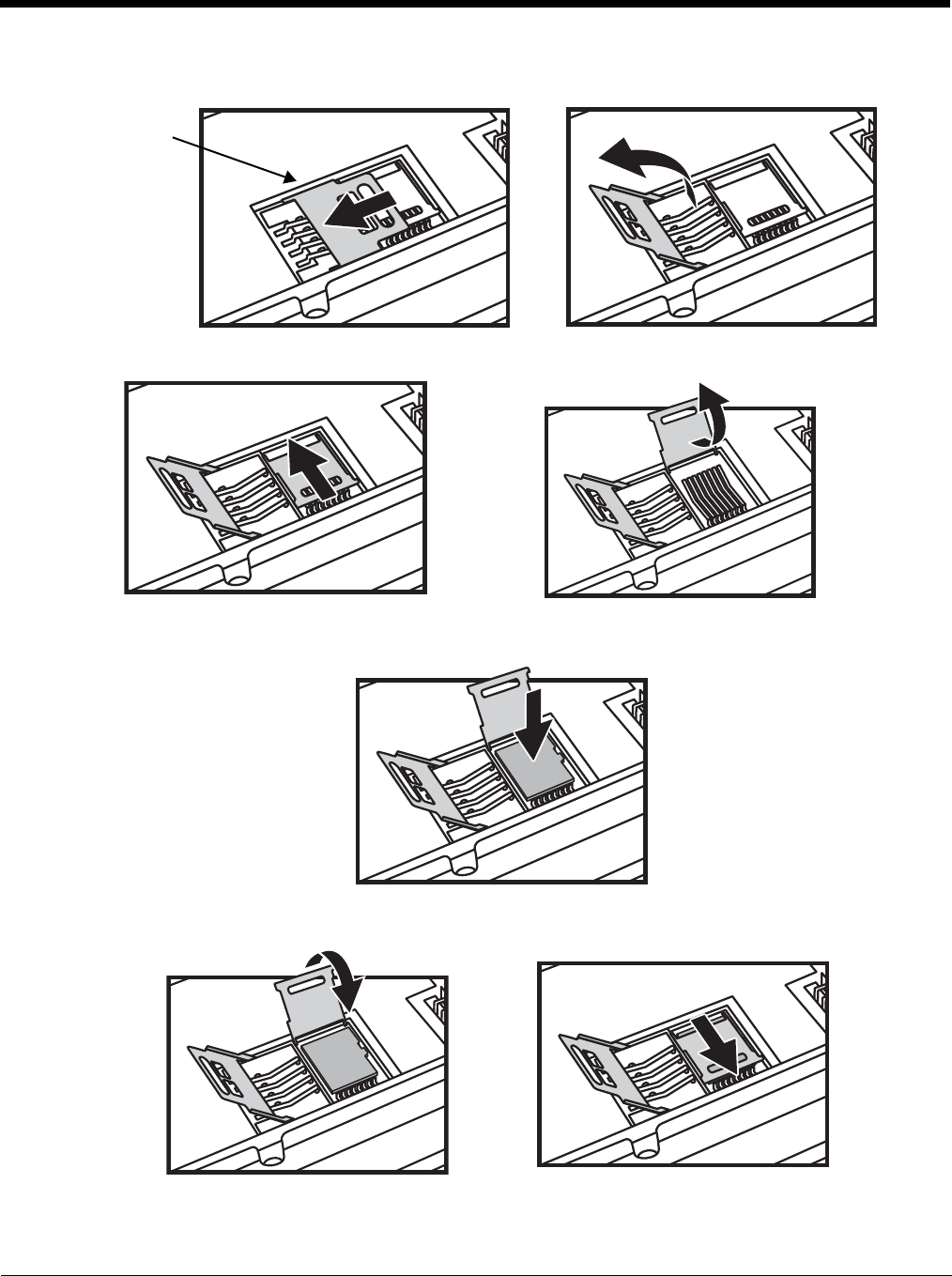
3 - 18
3. Slide the SIM Card latch toward the bottom of the terminal to unlock, then lift the SIM card latch. If a
SIM card is installed, remove the SIM card to reveal the memory card latch.
4. Slide the memory card latch to the left to unlock, then lift the memory card latch.
5. Insert a MicroSD or MicroSDHC card into the socket aligning the corner on the card with the corner
of the socket.
6. Close the memory card latch, then lock by sliding the latch right. If you want to install a SIM card,
insert the card into the SIM card socket (see SIM Card).
SIM Card Latch
Preliminary Draft 6/19/13, Not for Release

3 - 19
7. Close the SIM card latch, then lock the SIM card latch by sliding the latch toward the top of the
terminal.
8. Install the battery, then attach and lock the battery door The terminal begins booting as soon as
power is applied.
Preliminary Draft 6/19/13, Not for Release

3 - 20
Preliminary Draft 6/19/13, Not for Release

4 - 1
4
Using the Scan Image Engine
Overview
The Dolphin 60s terminal houses a compact image engine that instantly reads popular 1D and 2D bar
codes and supports omni-directional aiming and decoding for greater flexibility in real-world settings. The
image engine can also capture black and white digital images, such as signatures and pictures of
damaged inventory.
With the latest CMOS-based technology, the engine works like a digital camera and enables black and
white digital image capture, signature capture, and reading of OCR characters.
LED Safety
See LED Safety on page 1-1.
Image Engine Specifications
Field of View
Horizontal Field Angle (°) 21.9+/-0.5 degree
Vertical Field Angle (°) 15.9+/-0.5 degree
Depth of Field
The depth of field measurements used the following parameters:
• Distances are measured from the front of the engine.
• +23°C (+73°F), 0 lux
• Photographic quality codes
Symbology Distance (in/cm)
Near Distance (in/cm)
Far Delta (in/cm)
3 mil C39/128 - - -
5 mil C39/128 2.25 (5.7) 4.35 (11.049) 2.1 (5.3)
7.5 mil C39/128 1.25 (3.2) 6.87 (17.4) 5.62 (14.3)
10 mil C39/128 0.67 (1.7) 9.93 (25.2) 9.26 (23.5)
15 mil C39/128 1.01 (2.6) 15.16 (38.5) 14.15 (35.94)
20 mil C39/128 1.80 (4.57) 18.56 (47.14) 16.76 (42.57)
100% 13 mil UPC 1.57 (3.9) 12.18 (30.9) 10.61 (26.9)
5 mil PDF417 - - -
6.7 mil PDF417 1.53 (3.8) 4.63 (11.7) 3.1 (7.8)
10 mil PDF417 1.38 (3.5) 7.34 (18.6) 5.96 (15.1)
Preliminary Draft 6/19/13, Not for Release

4 - 2
Supported Bar Code Symbologies
5 mil microPDF - - -
5 mil DataMatrix - - -
10 mil DataMatrix 1.52 (3.8) 4.87 (12.3) 3.35 (8.5)
20 mil DataMatrix 1.07 (2.7) 9.66 (24.5) 8.59 (21.8)
10 mil QR 1.50 (3.8) 5.13 (13.0) 3.63 (9.2)
20 mil QR 2.48 (6.3) 9.66 (24.5) 7.18 (18.2)
32 mil Maxicode 1.56 (3.9) 13.19 (33.5) 11.63 (29.5)
Symbology Type Symbology Name
1D Symbologies Codabar
Codablock F
Code 3 of 9
Code 11
Code 32 Pharmaceutical (PARAF)
Code 93
Code 128
EAN with Add-On
EAN with Extended Coupon Code
EAN-8
EAN-13
GS1-128
GS1 Databar
Interleaved 2 or 5
ISBT 128
Matrix 2 of 5
MSI Plessey
Straight 2 of 5 IATA
Straight 2 of 5 Industrial
Telepen
Trioptic Code
UPC with Add On
UPC-A
UPC-E
2D Symbologies Aztec
Codablock A
Codablock F
Data Matrix
GS1 Databar
MaxiCode
Micro PDF
PDF417
QR Code
Composite Codes UPC/EAN
UCC/EAN
GS1 Databar
OCR MICR E 13-B
OCR-A
OCR-B
Postal Codes Postnet and most international 4-state codes
Australian Post
British Post
Canadian Post
China Post
Preliminary Draft 6/19/13, Not for Release
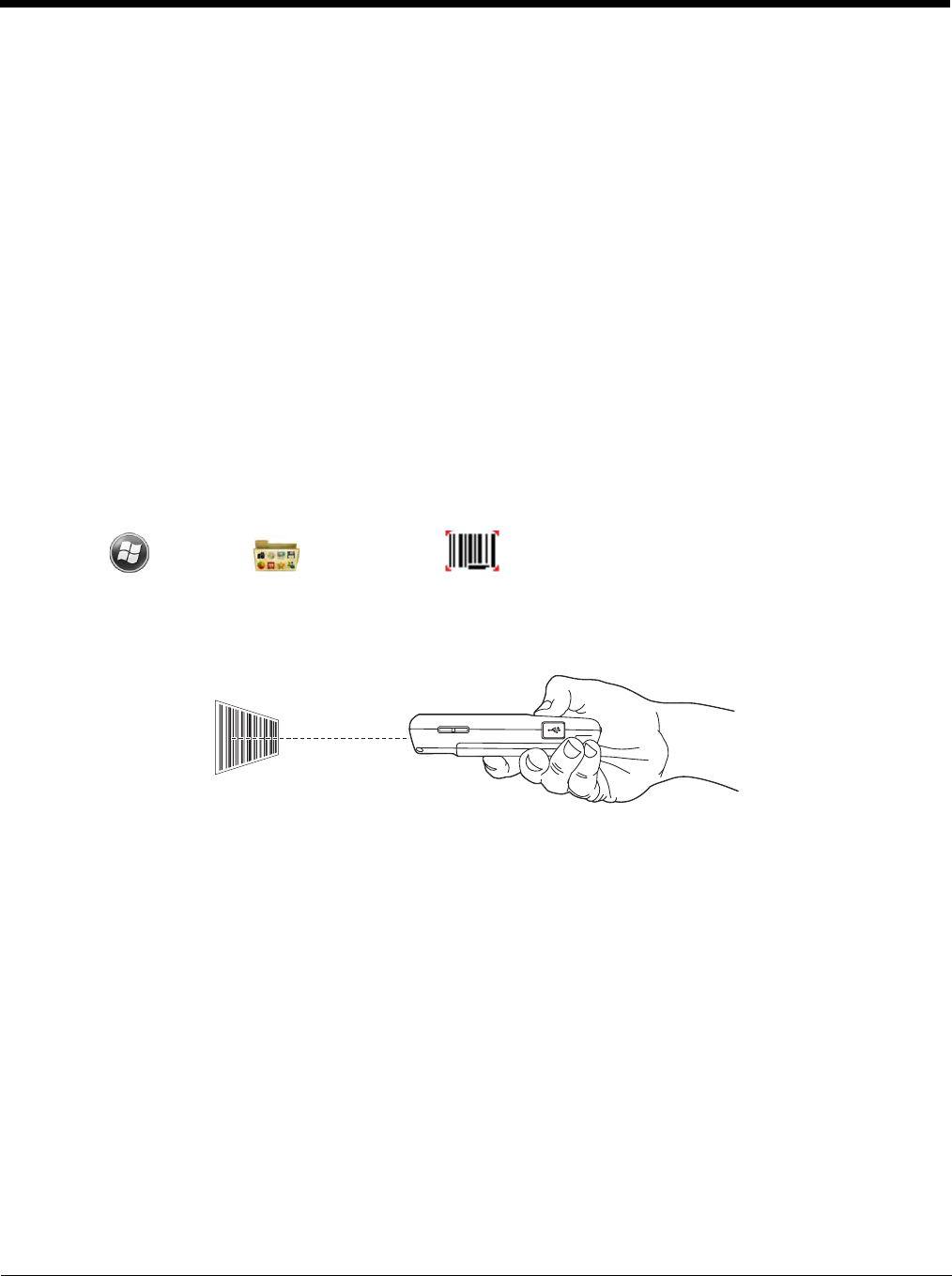
4 - 3
Decoding
The terminal supports two types of image decoding for use in various bar code reading and imaging
applications: full-area imaging and Advanced Linear Decoding (ALD).
Full-Area Imaging
Full-area imaging provides omni-directional reading of linear and non-linear 1D and 2D bar codes, OCR,
signature capture, and picture taking. When reading all bar code types using full-area imaging, a positive
read can be obtained from many positions; see The Aiming Beam on page 4-3. To achieve the best read,
the aiming beam should be centered horizontally across the bar code.
ALD
ALD provides fast reading of linear and stacked linear bar codes. To achieve a positive read when
reading linear 1D and PDF417 bar codes, the aiming beam should be centered horizontally across the
bar code. When ALD is enabled, the reader does not read matrix or postal codes.
Using the Scan Demo to Decode a Bar Code
The aiming beam should be oriented in line with the bar code to achieve optimal decoding.
1. Touch > Demos > Scan Demo .
2. Point the Dolphin terminal at the bar code. Press and hold the Scan button.
Note: The right side buttons also trigger the scan/imager.
.
3. Center the aiming beam over the bar code; see The Aiming Beam on page 4-3.
Note: By default, the LED illumination and aiming beam options are enabled. For optimum performance, avoid
reflections by scanning the bar code at a slight angle.
4. When the bar code is successfully decoded, the terminal beeps and the bar code information
appears on the touch screen.
The Aiming Beam
The aiming beam is smaller when the terminal is held closer to the code and larger when it is farther
from the code. Symbologies with smaller bars or elements (mil size) should be read closer to the unit
whereas symbologies with larger bars or elements (mil size) should be read farther from the unit.
Preliminary Draft 6/19/13, Not for Release
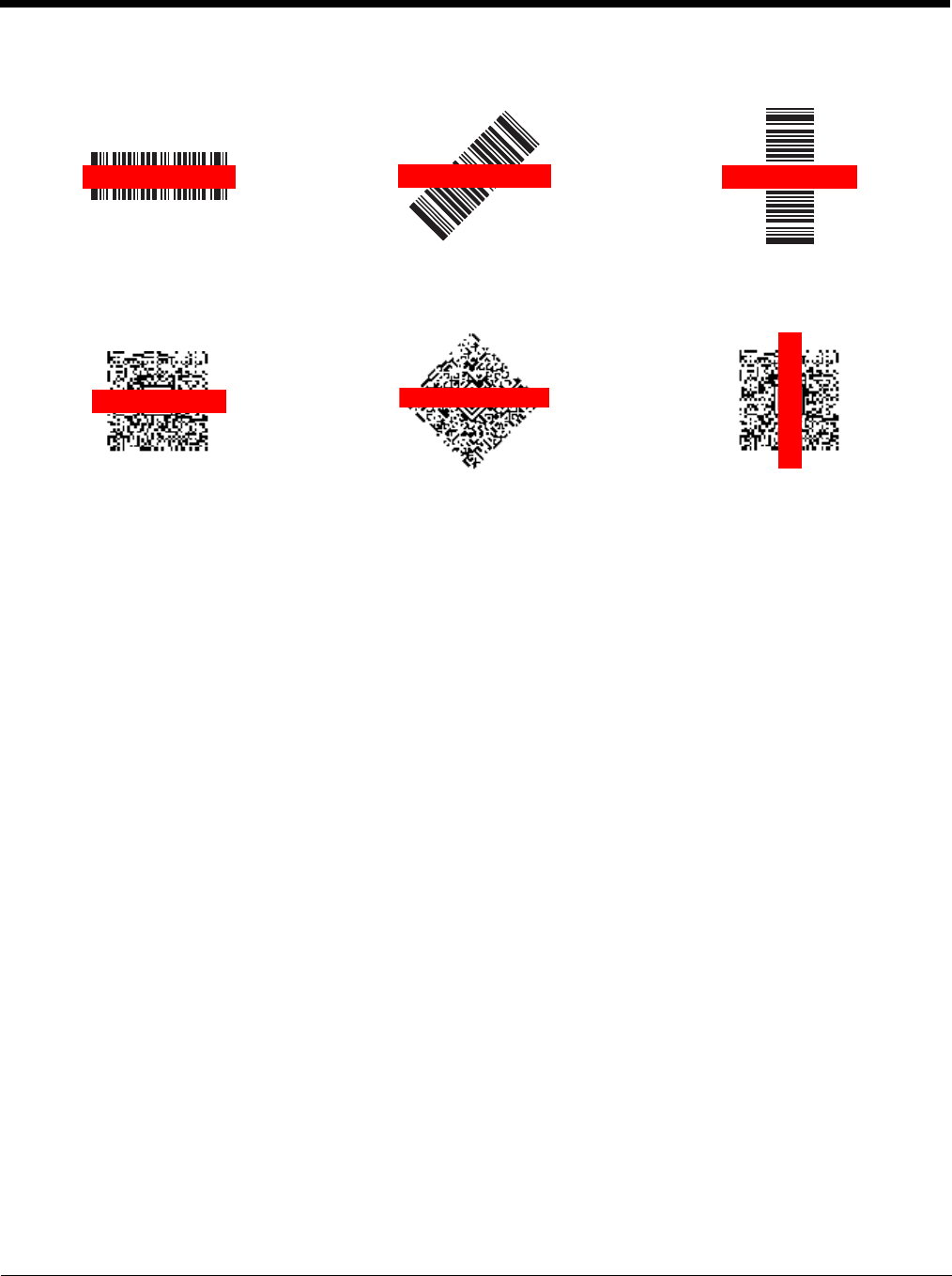
4 - 4
Linear Bar Code
2D Matrix Symbol
Capturing Images Using the Imaging Demo
The image-capture process is an intuitive, split-second operation for experienced users. By following the
basic guidelines, new users can easily develop their own technique and, with practice, quickly learn to
adapt it to different application environments.
Image Preview
When the imaging process is initiated, the touch screen displays a preview of the object. This is a live
video image of what the imager is currently viewing. The live video image has a slightly degraded
appearance compared to the captured image. This is normal.
Scan Key
On all Dolphin 60s terminals, the Scan button captures images.
File Formats
File formats supported for image storage include Bitmap (BMP), JPEG (JPG) and Portable Network
Graphics (PNG). The default file format for images is a gray scale JPG.
Compression
Digital images have a maximum image size of 640 x 480 pixels and may have up to a 256 (8 bit) gray
scale image definition.
The image quality and related file size are determined by the data compression method used by the
software application used to take images. The average size of the image file is approximately 4–8K.
However, the size of the image depends on the content of the image - the more complex the content, the
larger the file size.
Taking an Image
The following steps are basic guidelines for taking images:
Preliminary Draft 6/19/13, Not for Release

4 - 5
1. Touch > Demos > Imaging Demo .
2. Point the Dolphin terminal at the object. To preview the image, press and hold the Scan button.
Note: The general notification LED above the touch screen illuminates red while the Scan button is pressed.
3. Adjust the terminal’s position until the object appears on the touch screen the way you want it to
appear in the image.
4. Release the Scan button to capture the image.
5. Touch File on the Tile bar, then select Save or Save As.
Note: Unless otherwise specified, the image is saved to the \My Device\My Documents folder.
Enabling the Aimer
By default, the Aiming Beam (see page 4-3) is turned off in the Imaging Demo application. To enable the
aiming beam for image capture:
1. Touch File at the bottom of the Imaging Demo screen.
2. Select Setup from the menu, then touch Aimer.
Note: If an option is enabled, a check mark appears next to the name.
3. The aiming beam is now enabled for imaging.
Uploading Images
Image files can be uploaded to a host workstation using Microsoft ActiveSync or Windows Mobile Device
Center and a Dolphin communication peripheral. For additional information see Connecting and
Synchronizing the Terminal and Workstation on page 8-9.
Preliminary Draft 6/19/13, Not for Release

4 - 6
Preliminary Draft 6/19/13, Not for Release
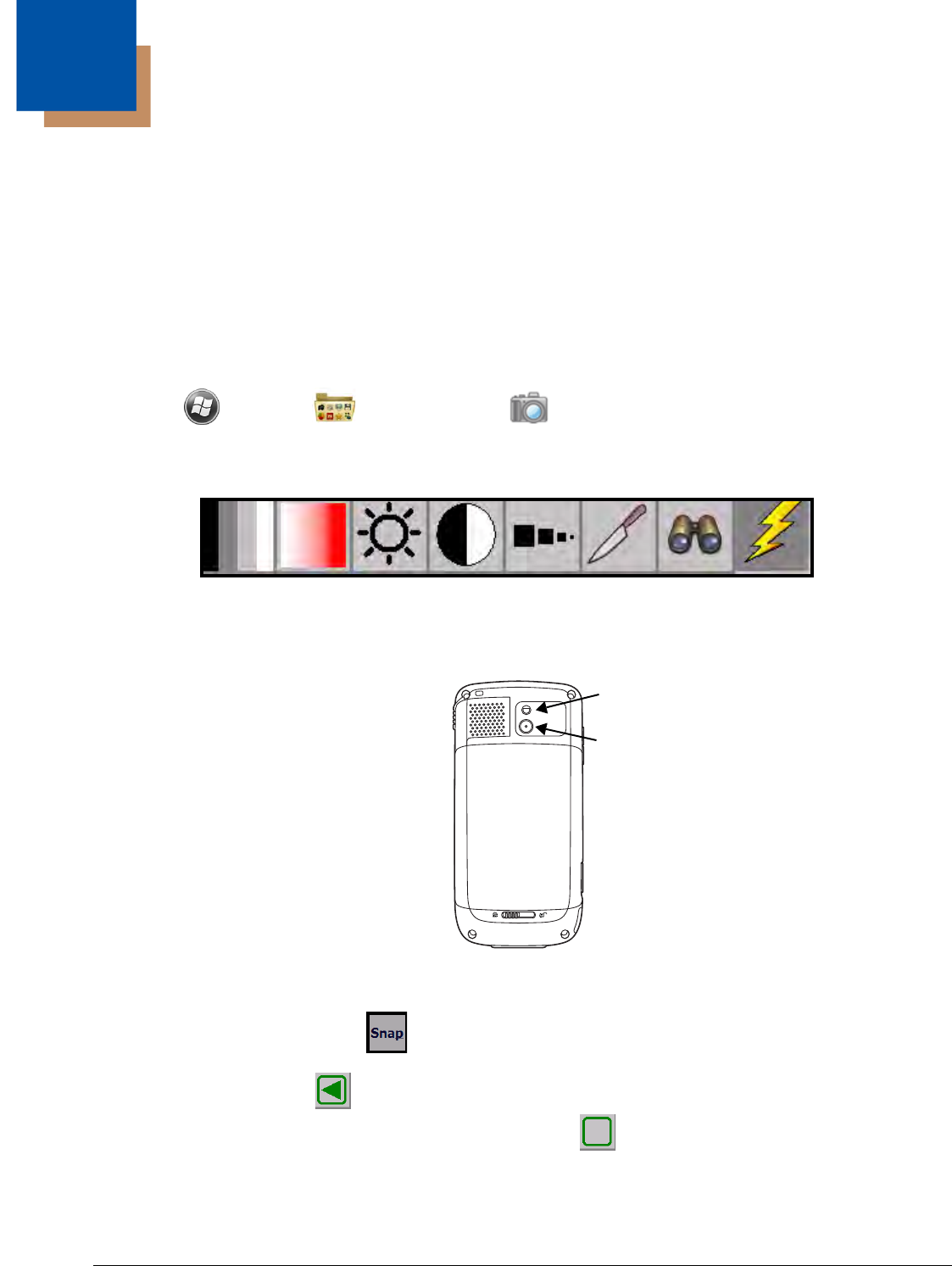
5 - 1
5
Using the Color Camera
Overview
Dolphin 60s terminals are equipped with 5.0-Megapixel auto focus cameras to provide easy integration
of color picture and video capture into business applications. The camera lens and camera flash are
located on the back panel of the terminal.
Taking a picture using the Camera Demo tool
1. Touch > Demos > Camera Demo .
2. Adjust the camera settings using the icon menu at the top of the display screen.
3. Point the terminal's camera lens at the object you want to capture.
4. Center the object you want to take a picture of on the live preview screen.
5. Press the ENT key or Touch
on the touch screen.
Note: Touch the green arrow to review or edit your pictures.
To exit the picture review/edit screen, touch the green box .
Color
Saturation Contrast Lamp
Brightness Pixels
Sharpness
Zoom
Flashlight/
Camera Flash
Camera Lens
Preliminary Draft 6/19/13, Not for Release
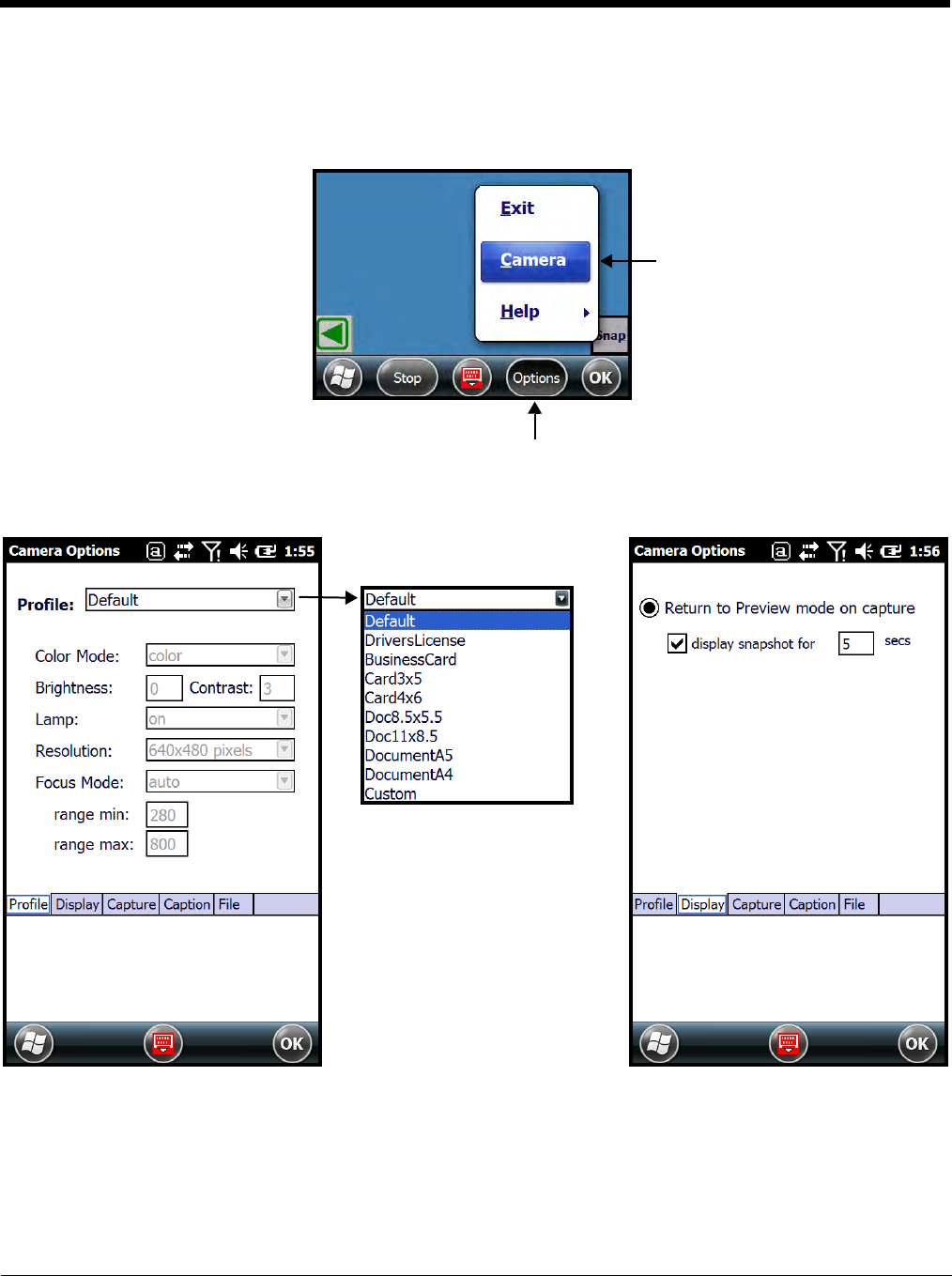
5 - 2
Camera Options
The Camera Options menu provides access to create customized profiles, adjust audible feedback,
modify file preferences, and set caption options. Touch Options > Camera to access the Camera
Options menu.
The Camera Options screen contains five tabs: Profile, Display, Capture, Caption, and File.
Profile Tab
The profile tab allows you to
customize your camera
settings, or chose from several
predefined profiles designed to
provide the best picture quality
for common tasks.
Display Tab
Preliminary Draft 6/19/13, Not for Release
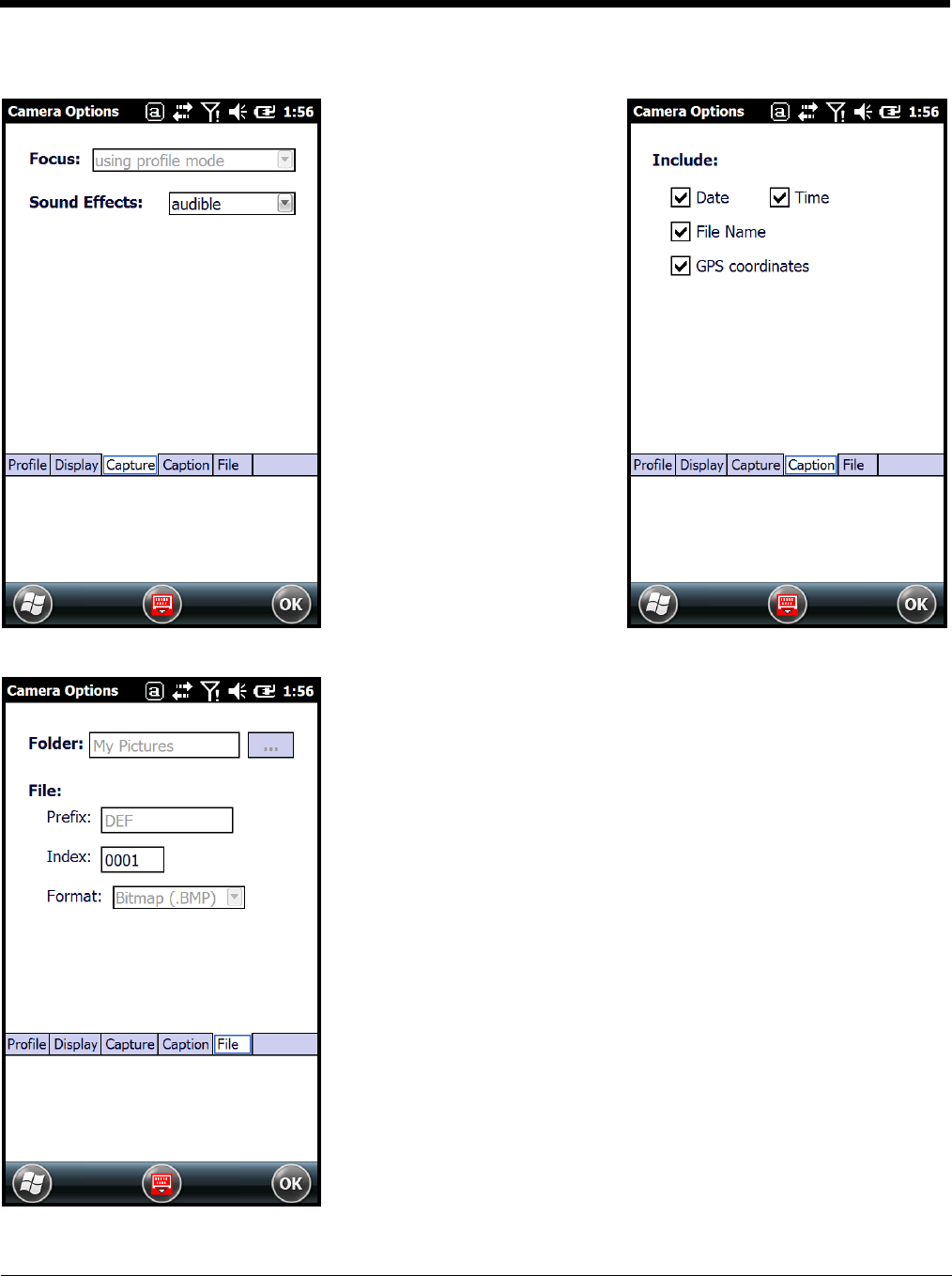
5 - 3
Capture Tab Caption Tab
Capture Tab
Preliminary Draft 6/19/13, Not for Release

5 - 4
Taking a picture using the Windows Embedded Handheld 6.5 Camera tool
1. Touch > Pictures & Videos > Camera
2. Point the terminal's camera lens at the object you want to capture.
Note: The camera lens is located on the back panel of the terminal.
3. Center the object you want to take a picture of on the live preview screen. Adjust the camera
settings or let the camera auto-focus.
Note: Focus On is the default Focus mode. In this mode, the camera performs auto-focus while it is in preview
mode but not during picture capture.
4. Press the Scan button to capture the photo.
5. The touch screen displays the captured photo. Touch OK or Camera on the Tile Bar to return to the
active viewfinder screen.
Menu
Tou ch Menu on the Tile Bar at the bottom of the touch screen to adjust the camera settings, switch to
video mode, and access additional camera options.
Item Descriptions
Video Activate Video Mode
Mode Set Mode (i.e., Normal, Burst, or Timer)
Resolution Set Picture Resolution (i.e., QVGA, VGA, SVGA, XGA, UXGA, QXGA, or MEGA5)
Zoom Set Zoom (i.e., x1, x2, or x3)
Flash Set Camera Flash On or Camera Flash Off
Focus Set Focus Off, Focus On (default), Focus on Trigger, or Fixed-Focus
Focus On (default setting):
The camera auto-focuses while it is in preview mode. As you move the camera, the lens
targets and auto-focuses on different objects. Once the picture is in focus in preview
screen, the camera is ready for the picture to be taken. To reduce the capture time of the
photo, the camera does not auto-focus during picture capture process.
Focus on Trigger:
The camera auto-focuses while it is in preview mode and again during picture capture.
The Focus on Trigger lengthens the capture time of the photo.
Brightness Set the brightness setting from +2.0 EV to -2.0 EV in .5 EV increments
Full Screen Switch to full screen mode
Options Set Camera Options, Video Options, Slide Show Options or General Options
Preliminary Draft 6/19/13, Not for Release
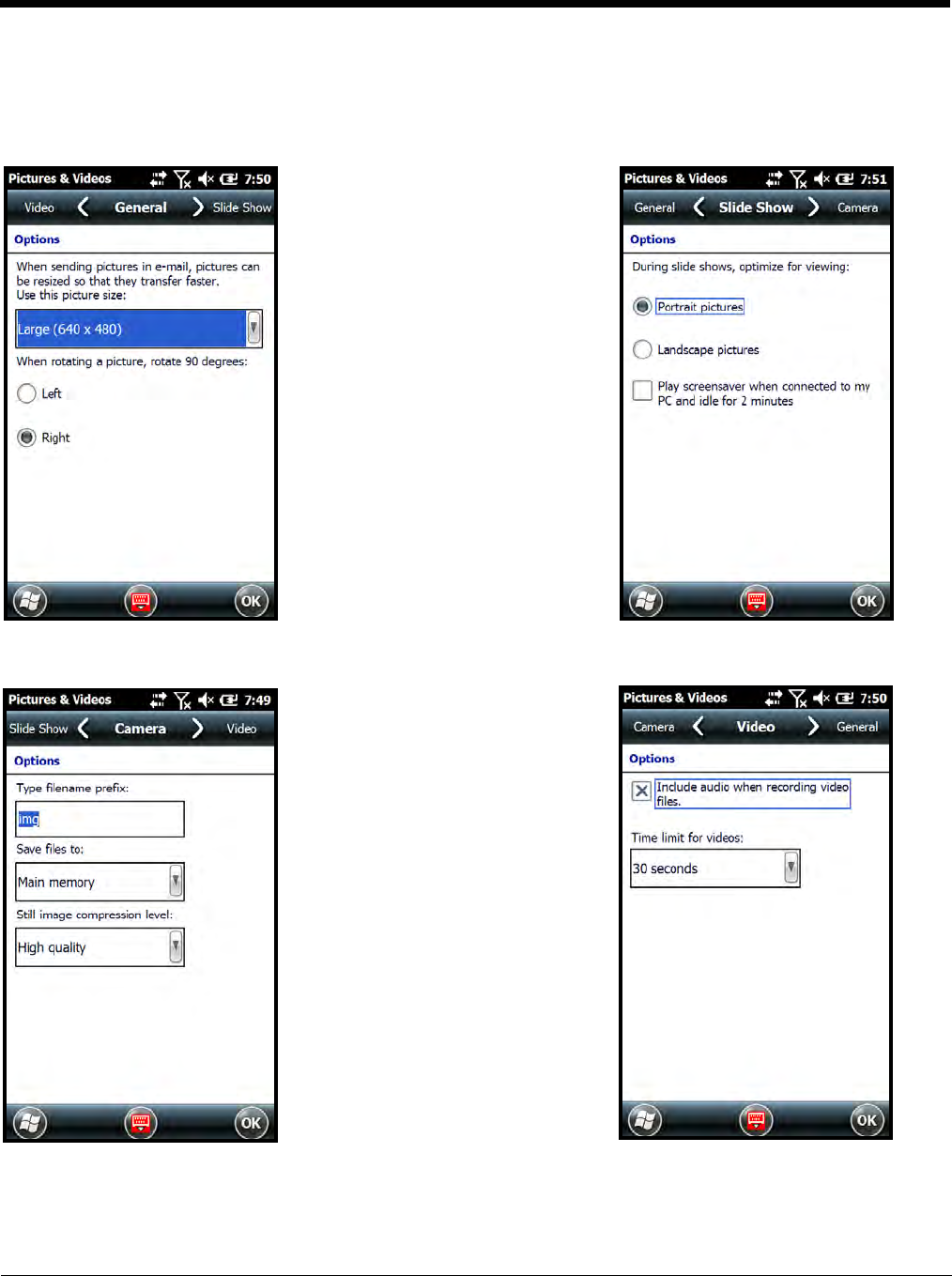
5 - 5
Options
Tou ch Menu > Options. The Options menu contains four screens:
General Tab Slide Show Tab
Camera Tab Video Tab
Preliminary Draft 6/19/13, Not for Release

5 - 6
Recording Video using the Windows Embedded Handheld 6.5 Camera Tool
1. Touch > Pictures & Videos > Camera > Menu > Video
2. Point the terminal's camera lens at the object you want to capture.
3. Press the Scan button to start recording.
4. Touch Stop on the screen or press Scan button to stop recording.
Uploading Pictures and Videos
Picture and Video files can be uploaded to a host workstation using Microsoft ActiveSync or Windows
Mobile Device Center and a Dolphin communication peripheral. For additional information see
Connecting and Synchronizing the Terminal and Workstation on page 8-9.
Preliminary Draft 6/19/13, Not for Release
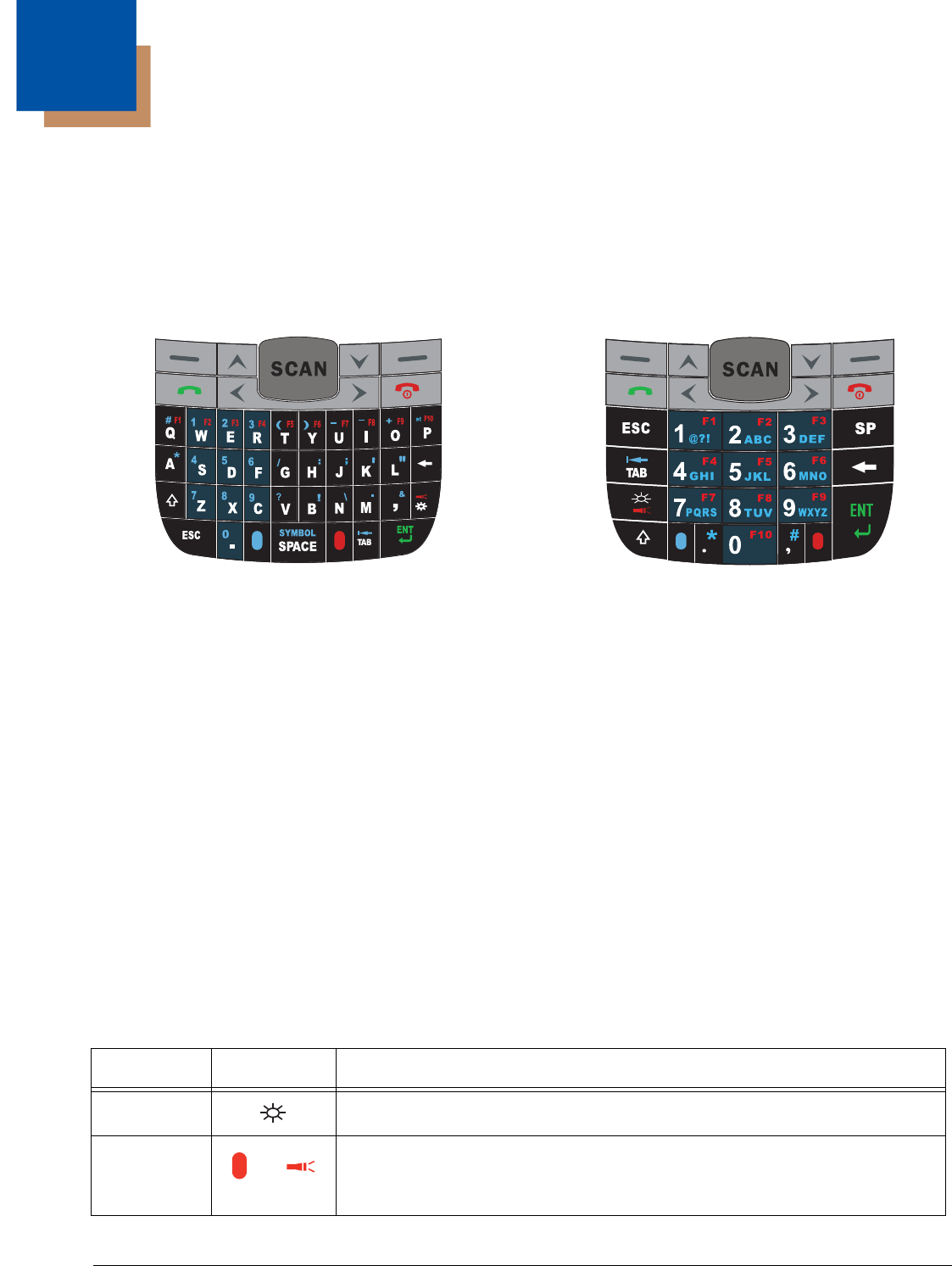
6 - 1
6
Using the Keyboards
Available Keyboards
Note: Contact a sales representative for information on additional keyboard options.
All Keyboards Contain the Following:
• Backlit for easy viewing in various lighting conditions.
• Centrally located Scan key for both right- and left-hand operation.
• Color-coding so you can clearly see the most common keyboard combinations.
• Function, navigation, and modifier keys.
Keyboard Combinations
See 30-Key Numeric Keyboard on page 6-4.
See 46-Key QWERTY Keyboard on page 6-6.
Common Buttons
See Using the Function Keys on page 6-1.
See Using the Modifier Keys on page 6-3.
See Using the Navigation Keys on page 6-3.
Using the Function Keys
Name Key Symbol Function
Backlight Turns the keyboard backlight on or off.
Flashlight & Turns the flashlight on or off. The flashlight is located on the back panel of the
terminal.
30-Key Numeric Keyboard 46-Key QWERTY Keyboard
Red
Preliminary Draft 6/19/13, Not for Release
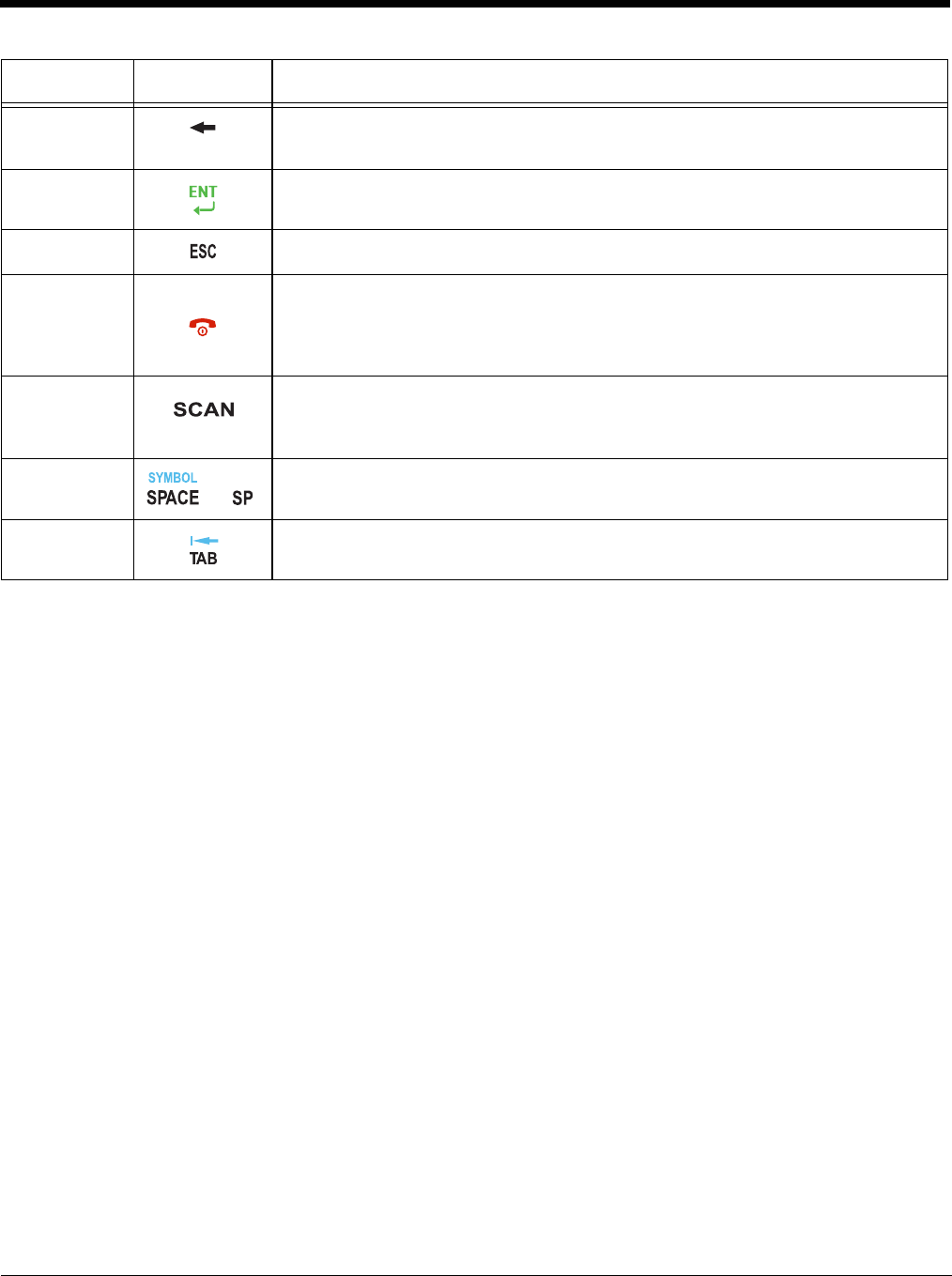
6 - 2
Backspace Moves the cursor back one space each time the key is pressed. If you are
typing text, it deletes the previous character each time it is pressed.
Enter Confirms data entry.
Escape Cancels the current action.
Power/End
Call Key The Power key, located in the upper right corner of the keypad, puts the
terminal in Suspend Mode or wakes the terminal from Suspend Mode, see
Suspend Mode on page 2-12. This key is also used to end/disconnect a phone
calls.
SCAN Key Activates the scan and wakes the terminal from Suspend Mode.
The key location allows convenient one-handed image-taking and/or bar code
decoding.
Space
or
Moves the cursor one space.
Tab Moves the cursor to the next tab stop or the next control (on a form).
Name Key Symbol Function
Preliminary Draft 6/19/13, Not for Release
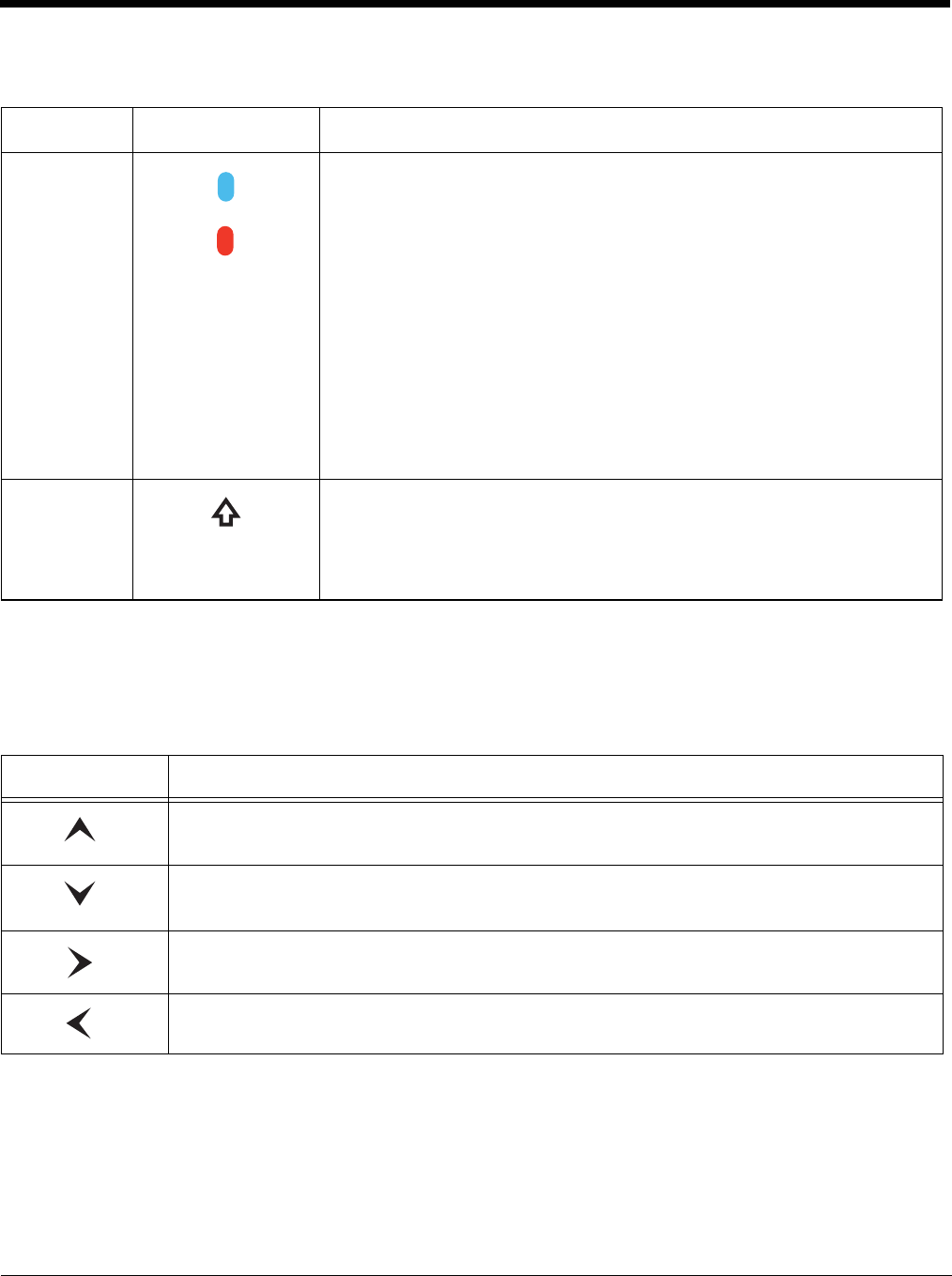
6 - 3
Using the Modifier Keys
Using the Navigation Keys
Located in the center of each keyboard for easy access with either hand, the navigation keys navigate
the cursor through application screens.
Note: Additional functionality varies according to the application in use.
Name Key Function
Blue & Red The blue and red keys are used in combination with other keys to type
special characters and perform system functions. Each keyboard is
color-coded to indicate the character typed or function performed when
specific keys are pressed immediately after the blue or red modifier key.
Normal
Press the blue or red key once to modify only the next key pressed.
Locked
Press the blue or red key twice to toggle the modifier lock on or off.
If a modifier key is locked on, the next keys pressed are modified until the
lock is turned off. This prevents having to press the modifier key each
time a key is pressed.
Note: Press the locked modifier key once to temporarily unlock the
modifier key for a single key stroke.
Shift The shift key modifies only the next key pressed; it must be pressed
before each key you wish to modify. Shift toggles the keyboard between
uppercase alphabet mode and lowercase alphabet mode.
Press the shift key twice to toggle Caps Lock ON or OFF.
Key Function
Moves the cursor up one row or line.
Moves the cursor down one row or line.
Moves the cursor one character to the right.
Moves the cursor one character to the left.
Blue
Red
Preliminary Draft 6/19/13, Not for Release
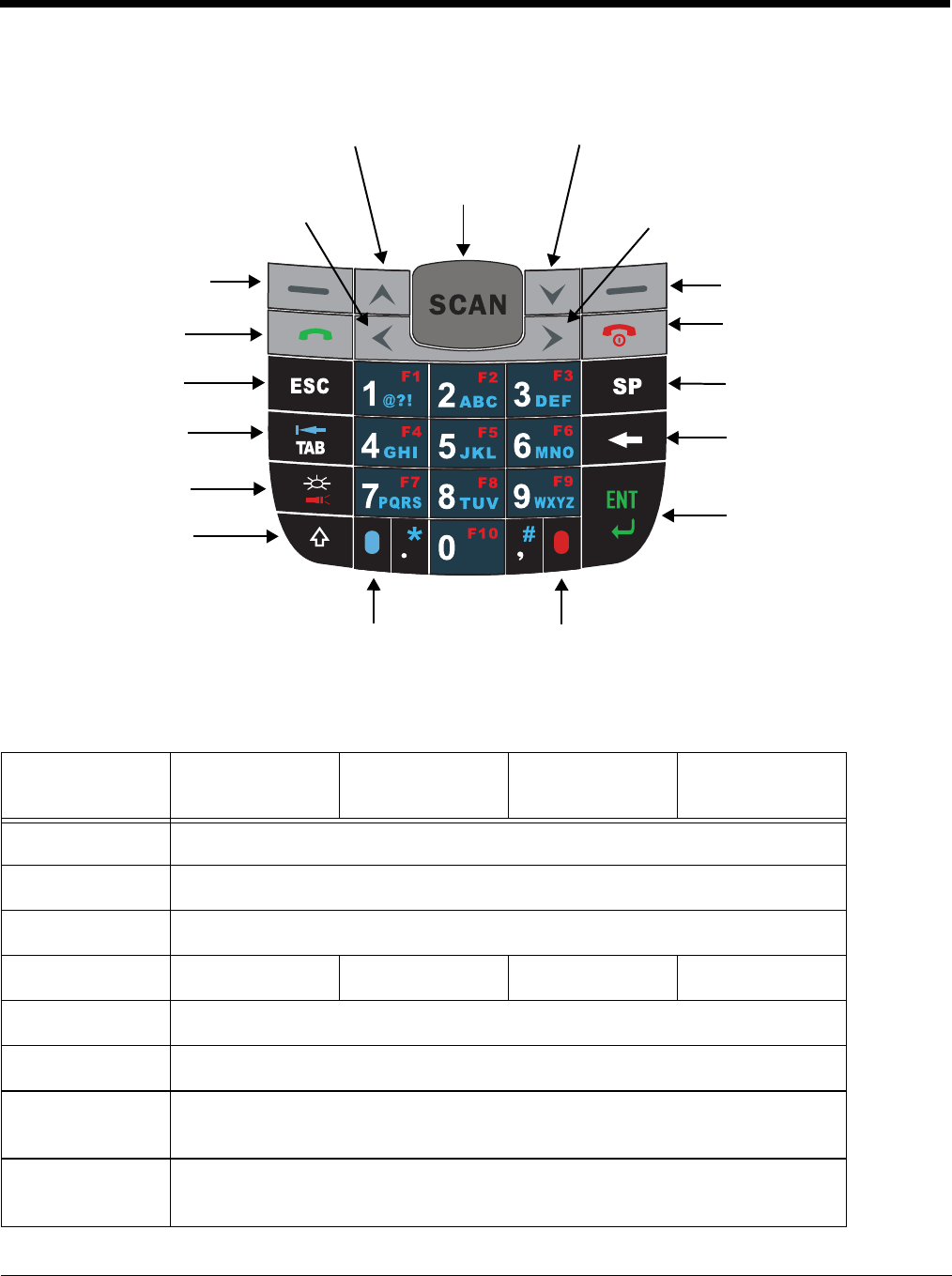
6 - 4
30-Key Numeric Keyboard
30-Key Numeric Keyboard Combinations
Key Normal Blue + Normal Blue + Normal +
Shift Red + Normal
Left Soft Key Left Soft Key performs the left function.
SCAN SCAN
Right Soft Key Right Soft Key performs right function.
SEND SEND Cold Boot Cold Boot SEND
Left Navigation Left
Up Navigation Up
Down
Navigation Down
Right
Navigation Right
Backlight /
Flashlight Key
SCAN Key
Enter Key
Tab Key
Escape Key
Power Key / END Key
Left Soft Key Right Soft Key
Red Key
Blue Key
Down Navigation Key
Backspace Key
Space Key
Shift Key
Right Navigation Key
Left Navigation Key
SEND key
Up Navigation Key
Preliminary Draft 6/19/13, Not for Release

6 - 5
Power/END Power On/Off or
END Call Warm Boot Warm Boot Power On/Off or
END Call
TAB TAB back TAB TAB TAB
11 @ ? ! @ or ? or ! F1
22 ABC abc F2
33 DEF def F3
Space Space
Backlight Backlight Backlight Backlight flashlight
44 GHI ghi F4
55JKLjklF5
66MNOmnoF6
Backspace backspace
ESC Escape
77 PQRS pqrs F7
88TUVtuvF8
99 WXYZ wxyz F9
ENTER Enter
Shift Shift
Period period asterisk asterisk period
Blue Blue
0000F10
Red Red
Key Normal Blue + Normal Blue + Normal +
Shift Red + Normal
Preliminary Draft 6/19/13, Not for Release
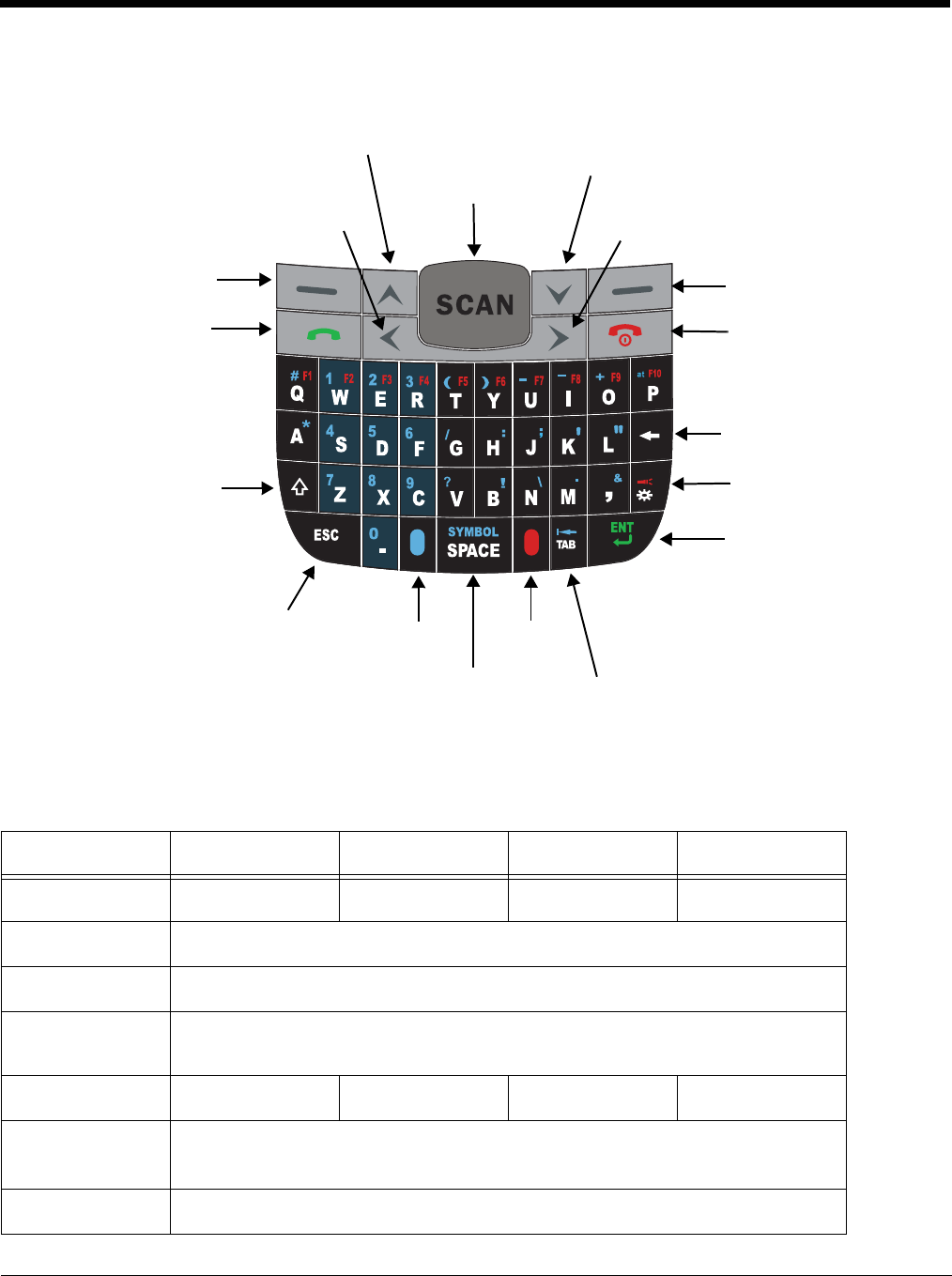
6 - 6
46-Key QWERTY Keyboard
46-Key QWERTY Keyboard Combinations
Key Normal Shift + Normal Blue + Normal Red + Normal
Send Send Send Cold Boot Send
Left Soft Key Left Soft Key
SCAN Scan
Right Soft Key Right Soft Key
Power/End Power/End Power/End Warm Boot Power/End
Left Navigation
Key Left
Up Navigation Up
SCAN key
Enter key
Tab key
Escape key
Power key, End Key
Left Soft Key Right Soft Key
Red key
Blue key
Down Navigation Key
Backspace,
Delete key
Space\Symbol key
Shift key
Right Navigation key
Left Navigation key
Send key
Up Navigation Key
Backlight\Flashlight key
Preliminary Draft 6/19/13, Not for Release

6 - 7
Down
Navigation Down
Right
Navigation Right
Qq Q # (pound/group) F1
WwW1F2
EeE2F3
RrR3F4
TtT(F5
YyY)F6
UuU_ (underscore) F7
IiI- (minus) F8
OoO+ (plus) F9
PpP@F10
AaA* (asterisk)
SsS4
DdD5
FfF6
GgG/
HhH: (colon)
JjJ; (semi-colon)
KkK‘ (single quote)
LlL“ (double quote)
Backspace Backspace Backspace
Shift Shift
ZzZ7
Key Normal Shift + Normal Blue + Normal Red + Normal
Preliminary Draft 6/19/13, Not for Release

6 - 8
XxX8
CcC9
VvV? (question mark)
BbB!
(exclamation
point)
NnN\ (back slash)
MmM. (period)
Comma , (comma) , (comma) & (ampersand) , (comma)
Backlight Backlight Backlight Backlight Flashlight
ESC Escape
Period . (period) . (period) 0 . (period)
Blue Blue
SYMBOL/
SPACE Space Space SYMBOL Space
Red Red
TAB Tab Back Tab Back Tab Tab
ENT Enter
Key Normal Shift + Normal Blue + Normal Red + Normal
Preliminary Draft 6/19/13, Not for Release
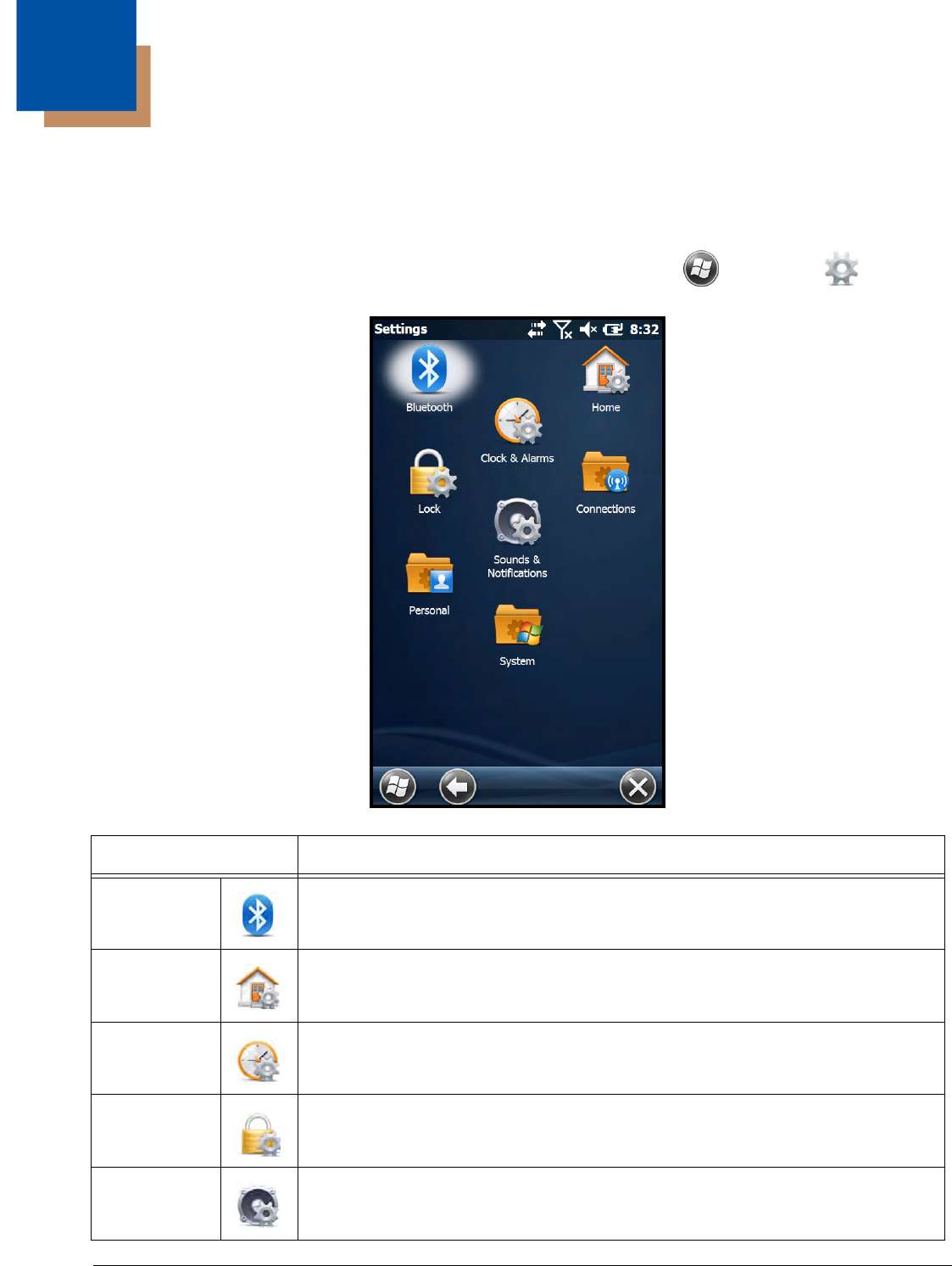
7 - 1
7
System Settings
Overview
Customized settings are available on the System Settings menu. Touch > Settings and the
settings screen opens.
Icon Description
Bluetooth Configure the Bluetooth radio. See Working with the Bluetooth Radio on page 10-1.
Home Customize the look and the information displayed on the Home screen.
Clock &
Alarms Set the system clock, date, time and schedule alarms. See Clock & Alarms on page
7-2.
Lock Password protect the terminal to limit access. See Lock on page 7-3.
Sounds &
Notifications Set the sound volume, enable or disable sounds for specific actions, set sound
parameters for system notifications and enable or disable vibrator notification.
Preliminary Draft 6/19/13, Not for Release
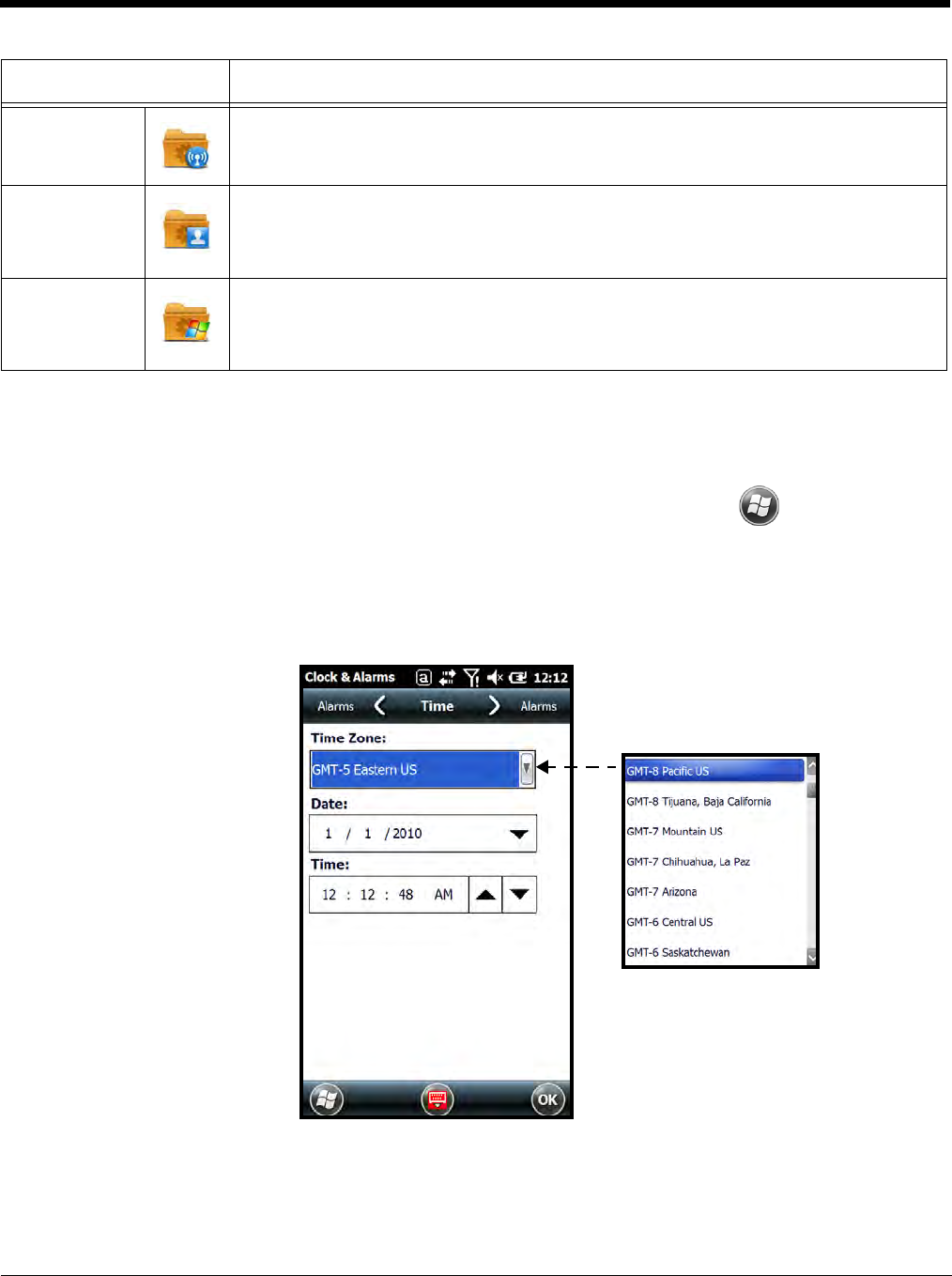
7 - 2
Clock & Alarms
The Clock & Alarms settings can be accessed from the Home screen or the Settings menu.
1. On the Home screen, touch the line that displays the time and date or touch > Settings >
Clock & Alarms.
2. The Time settings screen provides access to set the system clock (i.e., Time Zone, Date, and
Time). All scheduled items run according to the settings on the screen. Touch the arrow to the right
of the time zone to open the drop down menu. Select the appropriate time zone from the menu. Set
the correct time and date in the remaining fields and touch OK to save.
Connections Establishes network connections settings. See Connections Menu on page 8-1.
Personal Customizes buttons, and set SIP options. See Personal Menu on page 7-4.
System Adjusts system settings. See System Menu on page 7-9.
Icon Description
Preliminary Draft 6/19/13, Not for Release

7 - 3
Lock
The Lock settings screen provides access to additional password security features that enable you to
prevent an unauthorized person from unlocking the touch screen and accessing the terminal. Select
from two password security options: a Strong Alphanumeric Password or a Simple PIN.
To add password protection:
1. Touch > Settings > Lock .
2. Check the box next to the phrase “Prompt if phone unused for”.
3. Select the length of inactive time you want the terminal to wait before implementing password
security for terminal access.
4. Select Strong Alphanumeric Password or Simple Pin from the Password type drop-down menu.
5. Input the Password you want to use to unlock the terminal.
6. Input the password a second time to Confirm.
7. Touch OK on the tile bar.
8. Select Yes to save the password settings.
To remove password protection:
1. Touch > Settings > Lock .
2. Enter your password.
3. Uncheck the box next to the phrase “Prompt if phone unused for”.
4. Touch OK on the tile bar.
Preliminary Draft 6/19/13, Not for Release
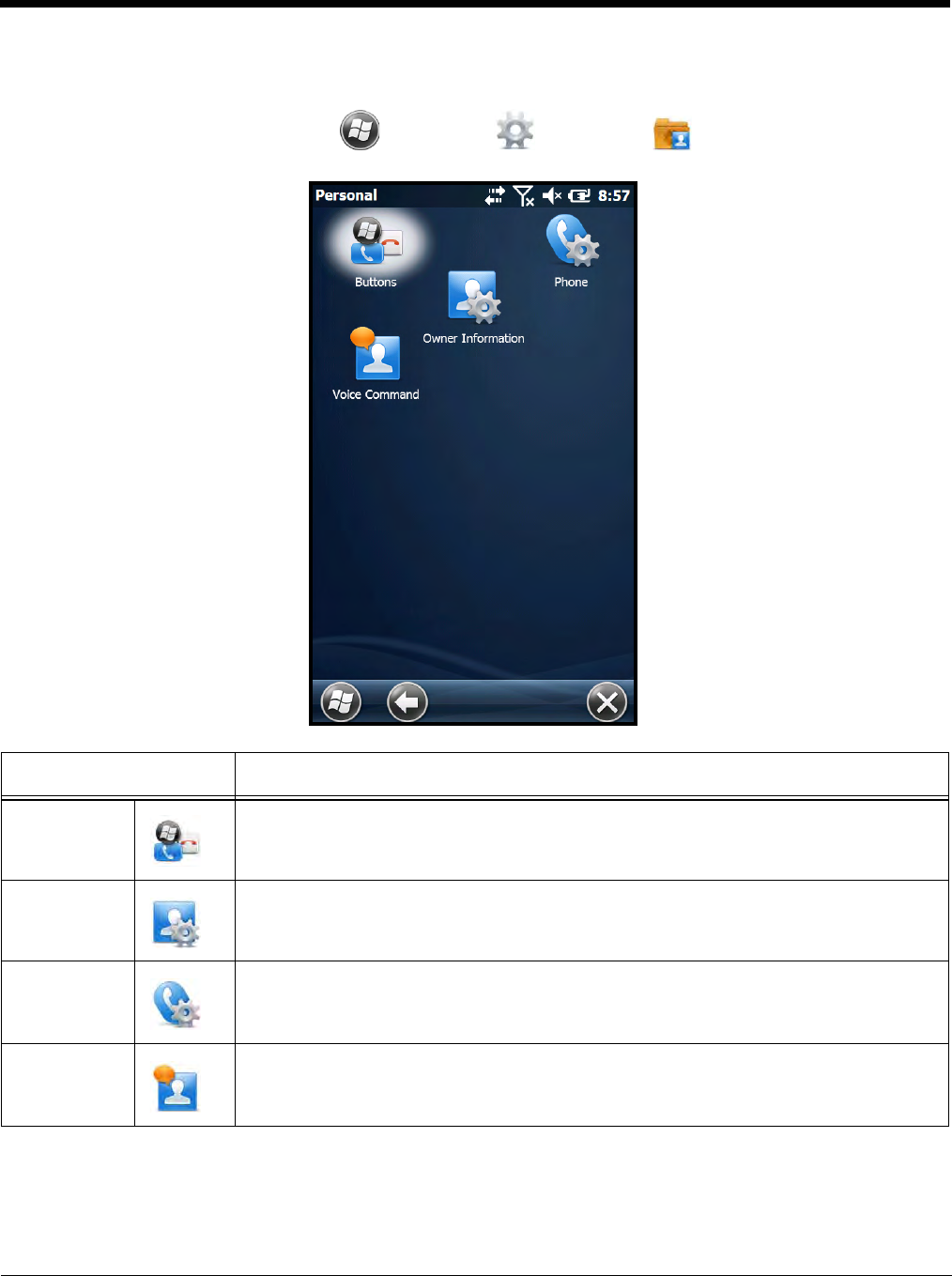
7 - 4
Personal Menu
To access the Personal Menu, touch > Settings > Personal . The screen opens
displaying the Personal Menu.
Icon Description
Buttons The Dolphin 60s has six programmable buttons (i.e., Right, Left, Home, Scan, Back,
and End). Touch the Buttons icon to program the buttons to perform specific tasks.
See Buttons on page 7-5.
Owner
Information Enter your contact information (e.g., name, company, address, telephone number
and E-mail address).
Phone The Phone icon is present on Dolphin models equipped with WWAN radio (GSM/
UMTS/GPRS/EDGE) capabilities. Touch this icon to set up user parameters. See
Options on page 9-6.
Voice
Command Touch the voice command icon to enable or disable voice command for specific
applications, adjust how calendar and notification announcements are performed
and set up voice activated password protection. See Voice Command on page 7-8.
Preliminary Draft 6/19/13, Not for Release
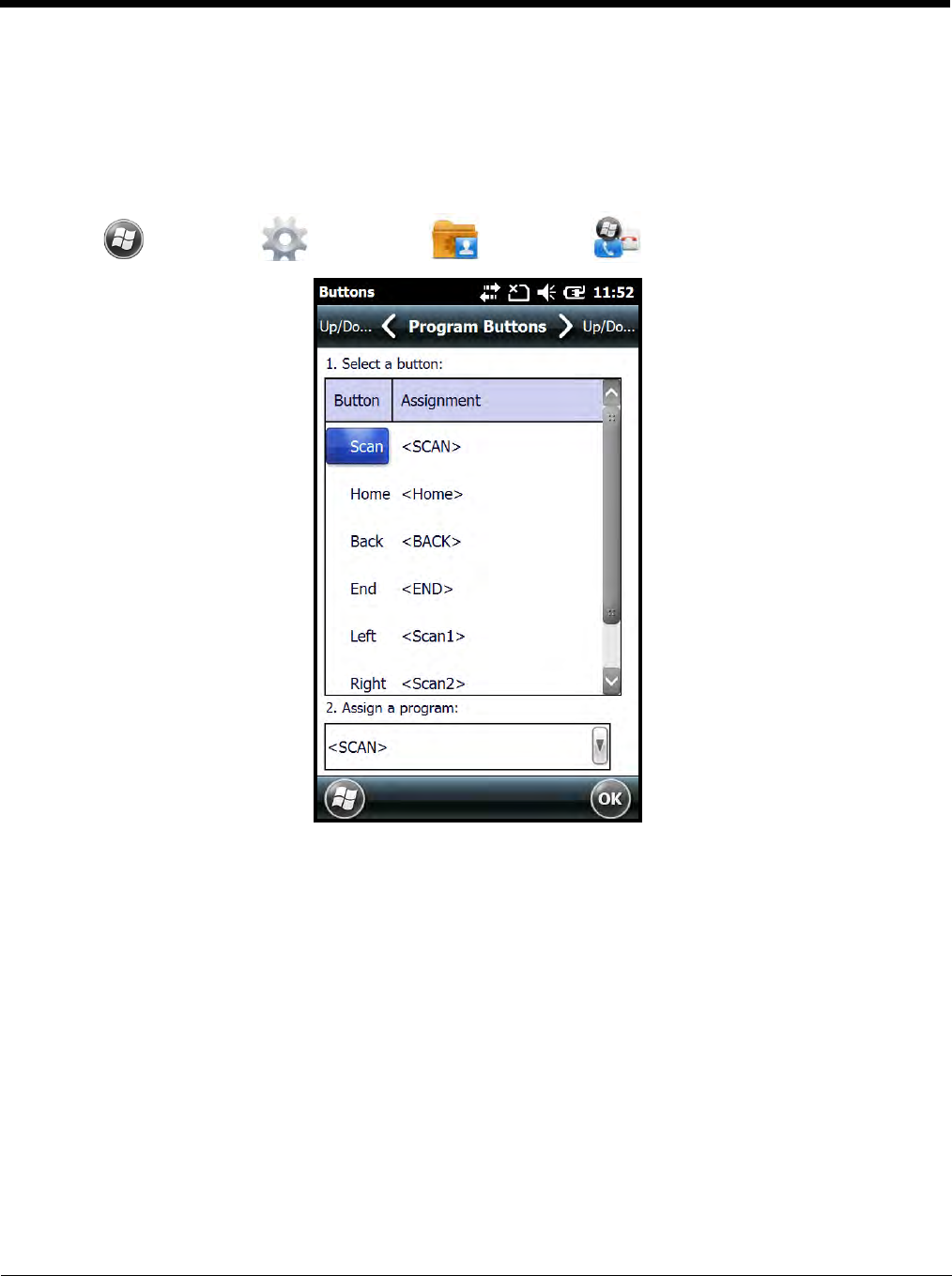
7 - 5
Buttons
The Dolphin 60s has two programmable buttons: Right side button and xxx button. Use the Buttons
setting to reassign the buttons to launch applications or execute commands.
Changing Button Assignments
1. Touch > Settings > Personal > Buttons .
Note: The buttons that appear on this window are the only buttons that can be programmed via the Buttons setting.
You cannot add buttons to this window.
2. To change button assignment, touch on the name of the button in the Button column, and then
select a program or command in the Assign a program drop down list.
3. Touch OK to save.
4. Press the button to verify that the program is launched or action performed.
Available Applications
The Assign a program list contains the applications installed on the terminal. If there is a program
installed that you would like to see in this list, paste a Shortcut to the program in the \\Windows\Start
Menu\Programs folder. For instructions about creating shortcuts, see Using File Explorer on page 7-6.
Preliminary Draft 6/19/13, Not for Release

7 - 6
Additional Functions
The Assign a program list also contains the following commands:
Using File Explorer
If you do not see the program listed under the Assign a Program list, you can either use File Explorer on
the terminal or ActiveSync (see page 7-7) on the workstation to create a shortcut to the program and
place the shortcut in the Start Menu folder.
Note: We recommend that you Copy and Paste Shortcut so that you do not alter your program configurations by
accident. Using Copy and Paste Shortcut (as opposed to Cut and Paste) ensures that the program files
remain where they need to be for the system to find them to perform system functions.
1. Touch > File Explorer .
1. Touch the Program Files folder under My Device.
2. Touch and hold on the program, then touch Copy on the pop-up menu.
Command Description
<BACK> Returns to the previous screen.
<Context Menu> Performs the same function as touch-and-hold to open the context menu for the control.
<END> Ends a phone call.
<Home> Returns to the Home screen.
<Input Panel> Opens the soft input panel.
<Left Softkey> Opens the menu or performs the action displayed on the left side of the Command bar.
<None> Nothing happens when the button is pressed.
<OK/Close> Performs the same function as touching OK on the screen.
<Right Softkey> Opens the menu or performs the action displayed on the right side of the Command bar.
<Rotate Screen> Changes the screen orientation from portrait to landscape.
<SCAN> Front panel scan button - Activates the scanner/imager.
<Scan1> Left side button - Activates the scanner/imager.
<Scan2> Right side button - Activates the scanner/imager.
<Scroll Down> Scrolls down in the open application.
<Scroll Left> Scrolls left in the open application.
<Scroll Right> Scrolls right in the open application.
<Scroll Up> Scrolls up in the open application.
<Start Menu> Opens the Start menu.
Preliminary Draft 6/19/13, Not for Release
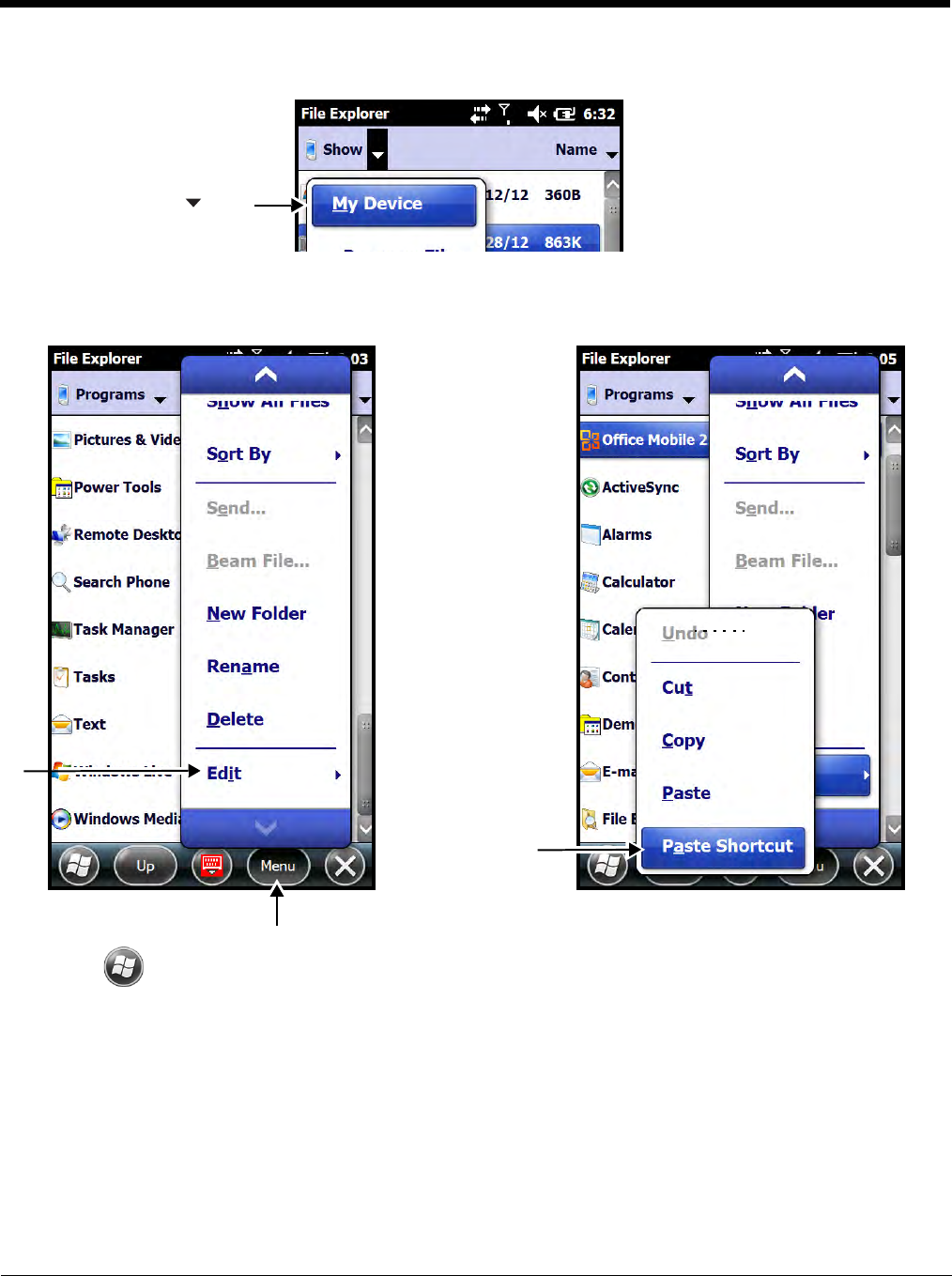
7 - 7
3. Navigate back to the My Device root directory, then touch Windows > Start Menu.
4. Touch and hold a blank area of the window, then touch Paste Shortcut on the pop-up menu.
Note: If there is no blank space available in the window, touch on
Menu
>
Edit
>
Paste Shortcut
.
5. Touch to verify that the program now appears on the Start menu.
Using ActiveSync on the Workstation
Here, you are performing the same basic process as on the terminal, except that you are using the
Explore utility (Windows Explorer) to copy and paste the shortcut.
1. Connect the terminal to the workstation using a Dolphin 60s peripheral.
2. Open ActiveSync > Explore and navigate to the program.
3. Right-click on the program and select Create Shortcut.
4. Select the shortcut, right-click, and select Cut.
Touch the arrow , then
select My Device.
Preliminary Draft 6/19/13, Not for Release
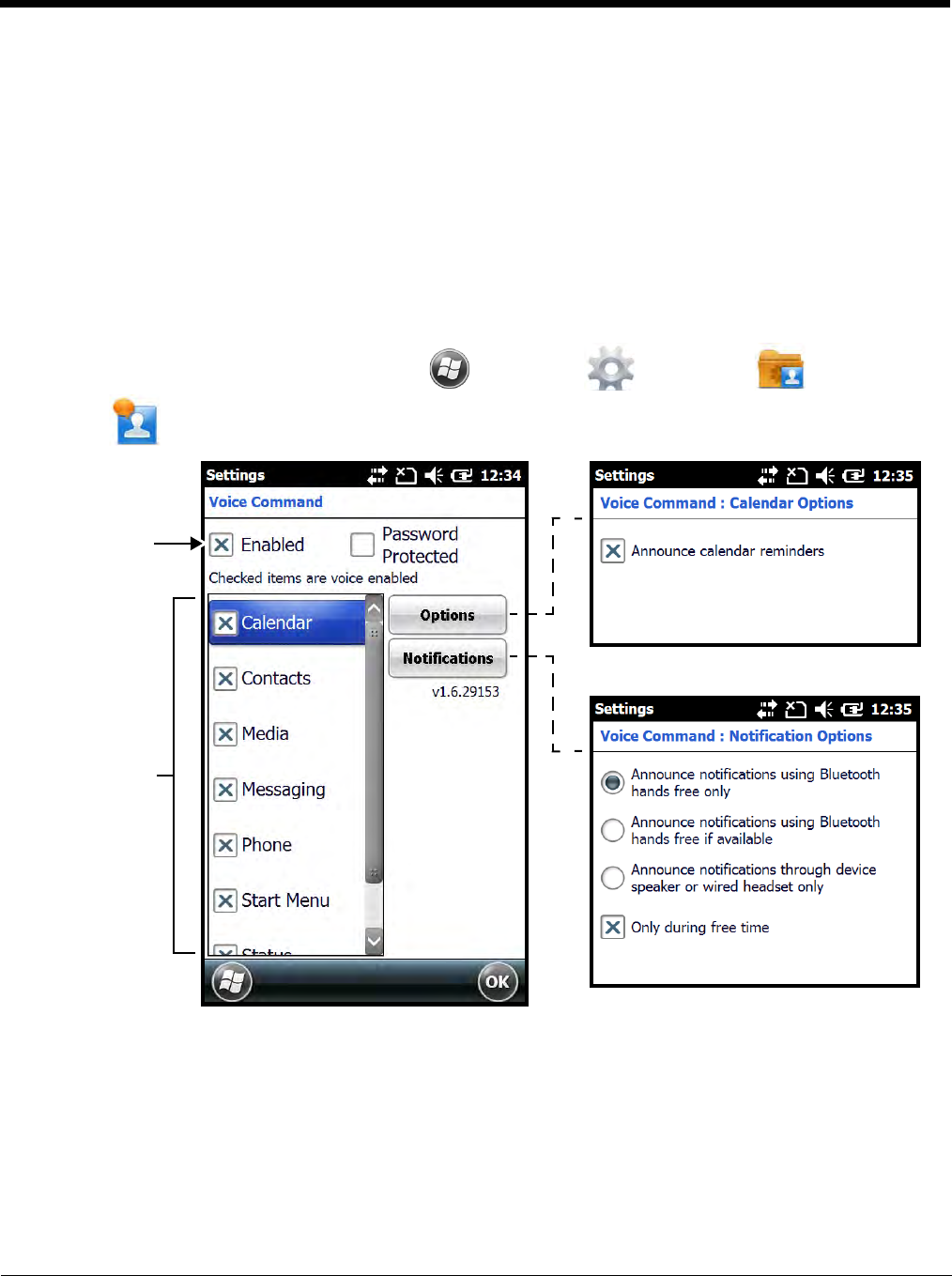
7 - 8
5. Navigate to the Start Menu folder (Windows > Start Menu > Programs).
6. Right-click on an empty area and select Paste Shortcut.
7. On the terminal, touch the Start menu.
8. Verify that program appears.
Voice Command
The Voice Command screen provides access to enable or disable voice command for specific applica-
tions, adjust how calendar and notification announcements are performed and set up voice activated
password protection.
To access the Voice Command settings, touch > Settings > Personal > Voice
Command .
Enable or Disable
Voice Command
functionality.
Enable or Disable
Voice Command for
specific applications.
Preliminary Draft 6/19/13, Not for Release
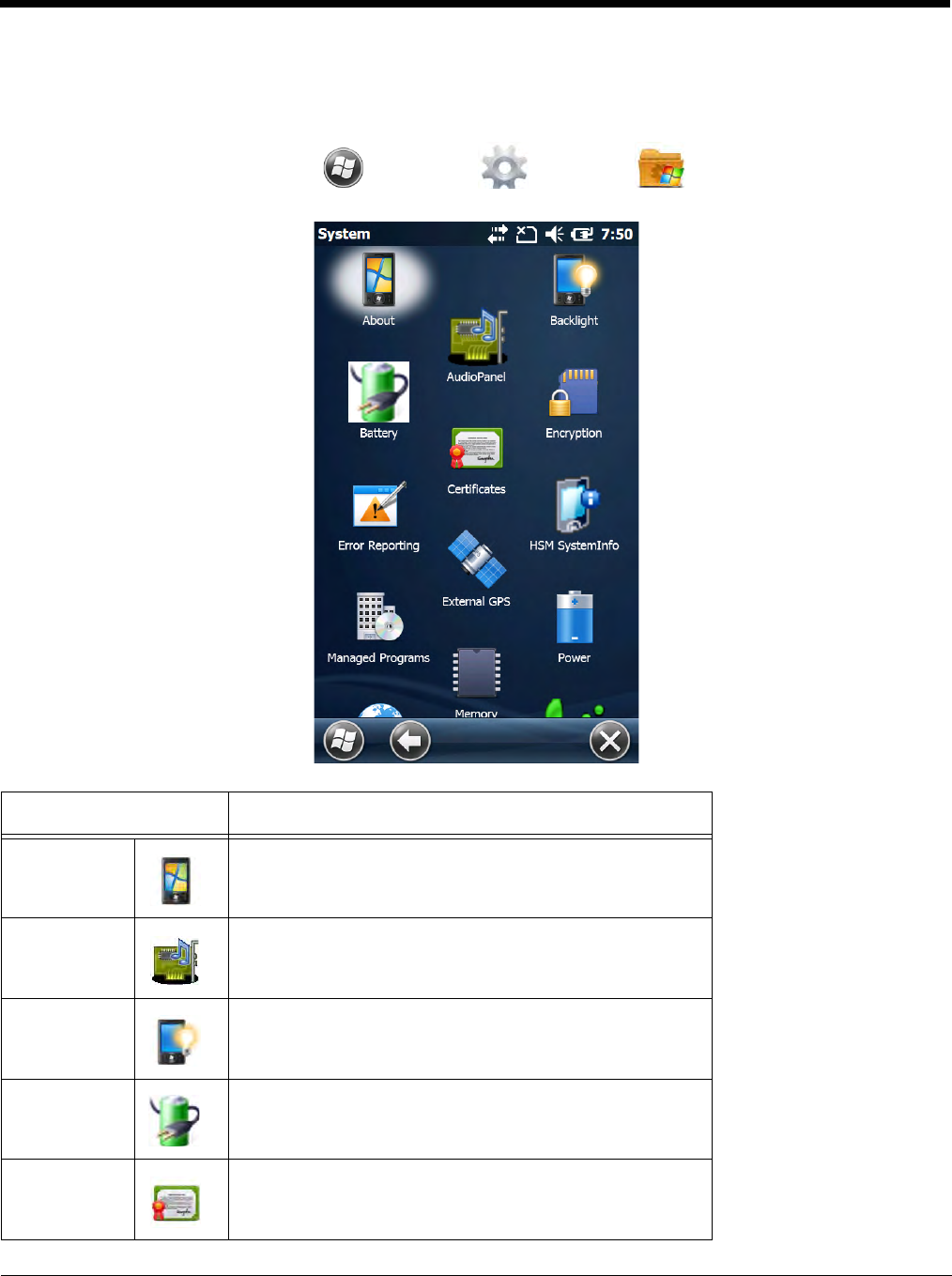
7 - 9
System Menu
The System menu enables you to verify and sometimes alter system parameters.
To access the System menu, go to > Settings > System . Touch the appropriate icon
to open that system setting.
Icon See Page
About See About on page 7-11.
AudioPanel See Audio Panel on page 7-11.
Backlight See Backlight on page 7-12.
Battery See Battery on page 7-14.
Certificates See Certificates on page 7-16.
Preliminary Draft 6/19/13, Not for Release
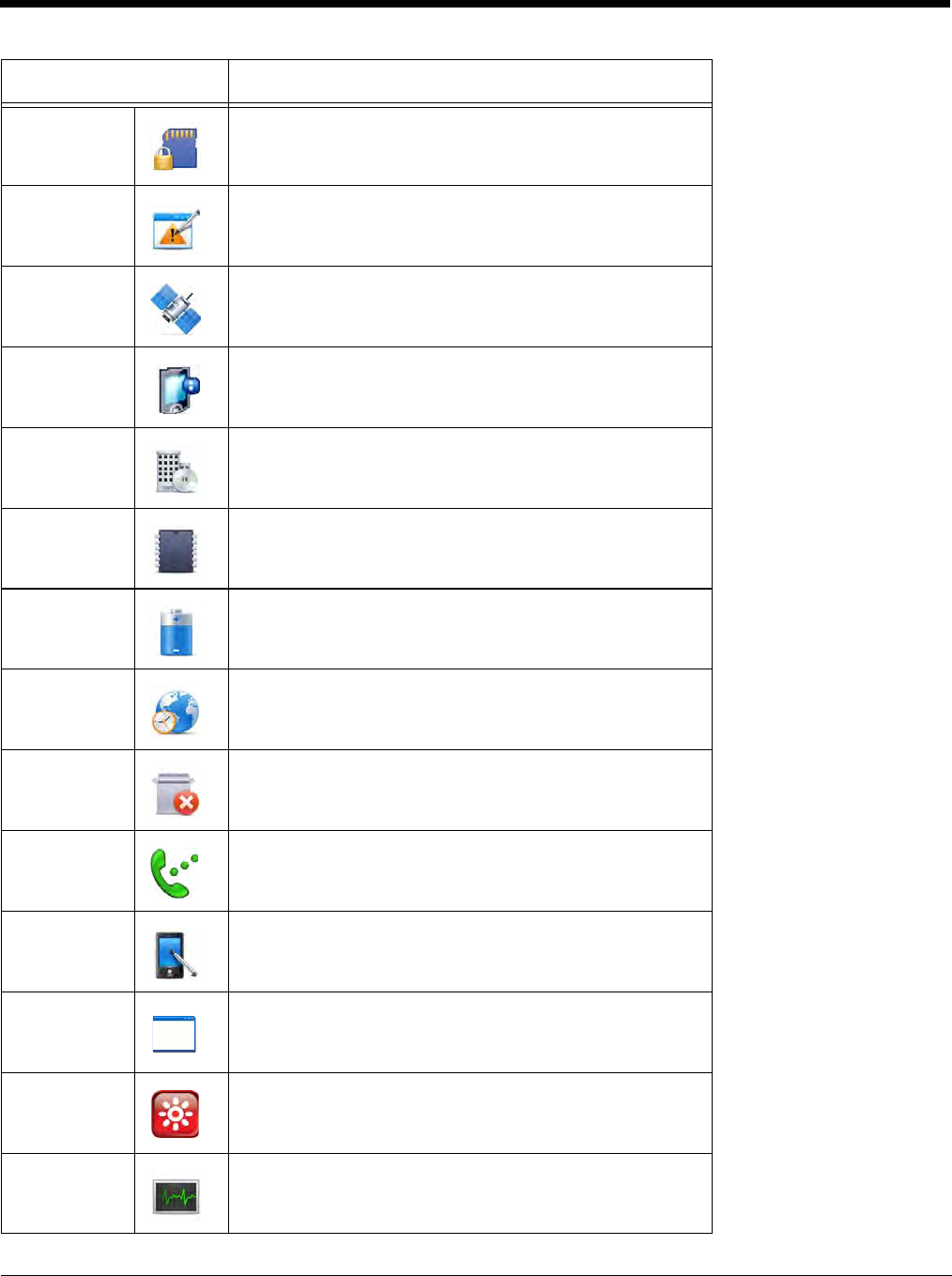
7 - 10
Encryption See Encryption on page 7-16.
Error
Reporting See Error Reporting on page 7-17.
External
GPS See External GPS on page 7-17.
HSM
SystemInfo See HSM SystemInfo on page 7-17.
Managed
Programs See Managed Programs on page 7-22.
Memory See Memory on page 7-22.
Power See Power on page 7-23.
Regional
Settings See Regional Settings on page 7-24.
Remove
Programs See Remove Programs on page 7-25.
RIL See RIL on page 7-26.
Screen See Screen on page 7-26.
SIP Config See SIP Config on page 7-18.
Smart
Sensors See Smart Sensor on page 7-19.
Task
Manager See Task Manager on page 7-27.
Icon See Page
Preliminary Draft 6/19/13, Not for Release
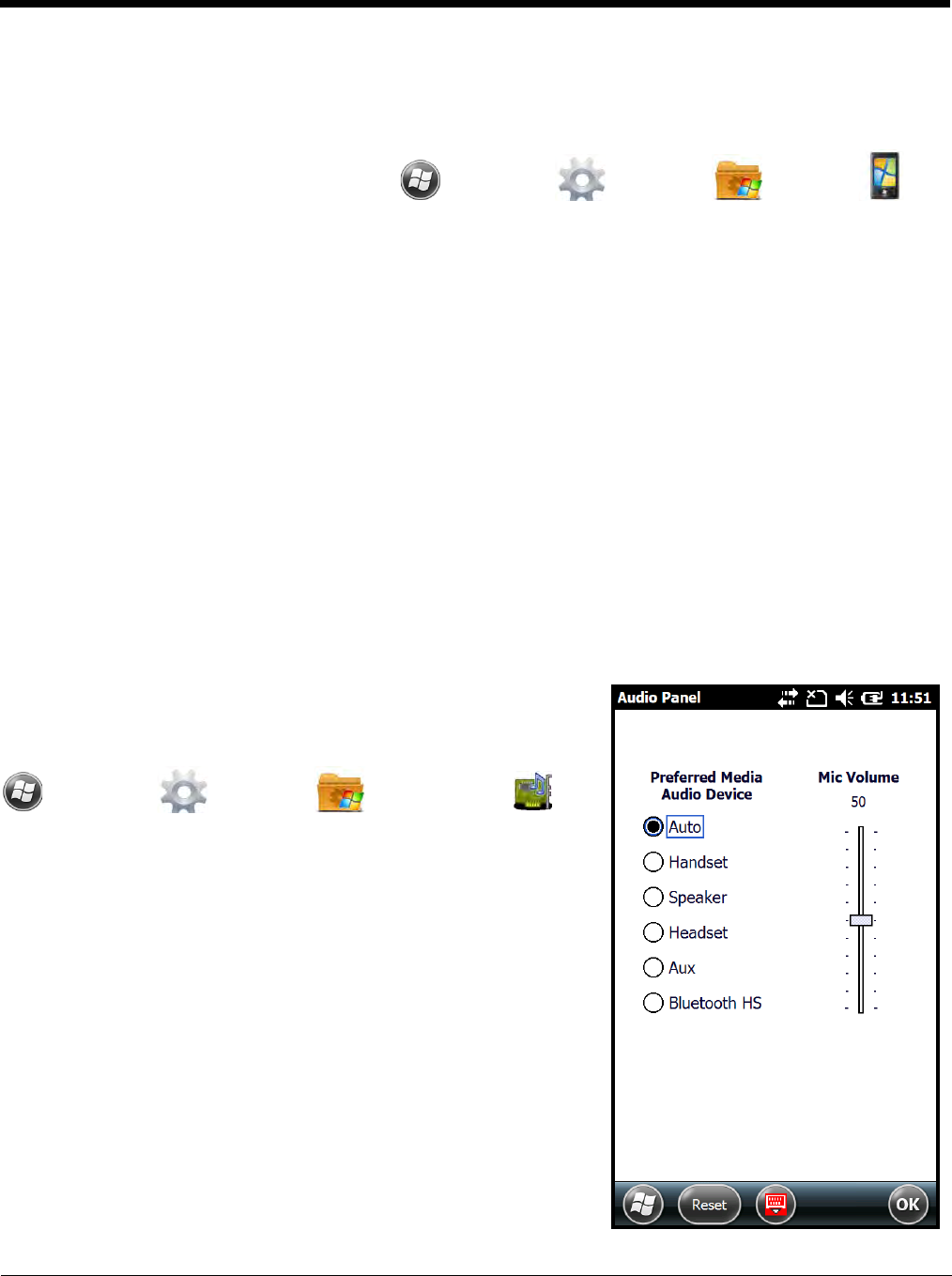
7 - 11
About
The About system settings screen displays specific information about the terminal. Three information
screens are available: Version, Device ID, and Copyrights.
To access the About system screen, touch > Settings > System . > About .
The Version Screen
Displays the information about the software, operating system, and processor.
The Device ID Screen
Displays the information the terminal uses to identify itself to other devices. It can be important to know
this information if the Dolphin terminal is going to be part of a networked system of devices.
•Device name: Displays the system’s default name. This is the name used by ActiveSync.
•Description: Displays the description of the device ID.
The Copyrights Screen
Displays important copyright information.
Audio Panel
The Audio Panel settings allow you to specify the Preferred Media Audio Device used for media
playback and audio recording. There are six device options: Auto, Handset, Speaker, Headset, Aux, or
Bluetooth HS. The Mic Volume slider adjusts the audio input volume (gain) for the preferred device
selected.
Note: Changes made to the Audio Panel only affect media playback
and recording. Phone audio settings are not affected.
To access the Audio Panel settings, touch
> Settings > System > Audio Panel .
Select Auto from the Preferred Media Audio Device list to
set the terminal to automatically detect and use the system
default device.
Note: If you select a preferred device that is not available, for
example, you select Headset but do not connect the headset
to the terminal; the audio defaults to Auto until the preferred
device becomes available.
Tou ch Reset on the tile bar to discard changes and revert to
the default Audio Panel settings or select OK to save
changes.
Preliminary Draft 6/19/13, Not for Release
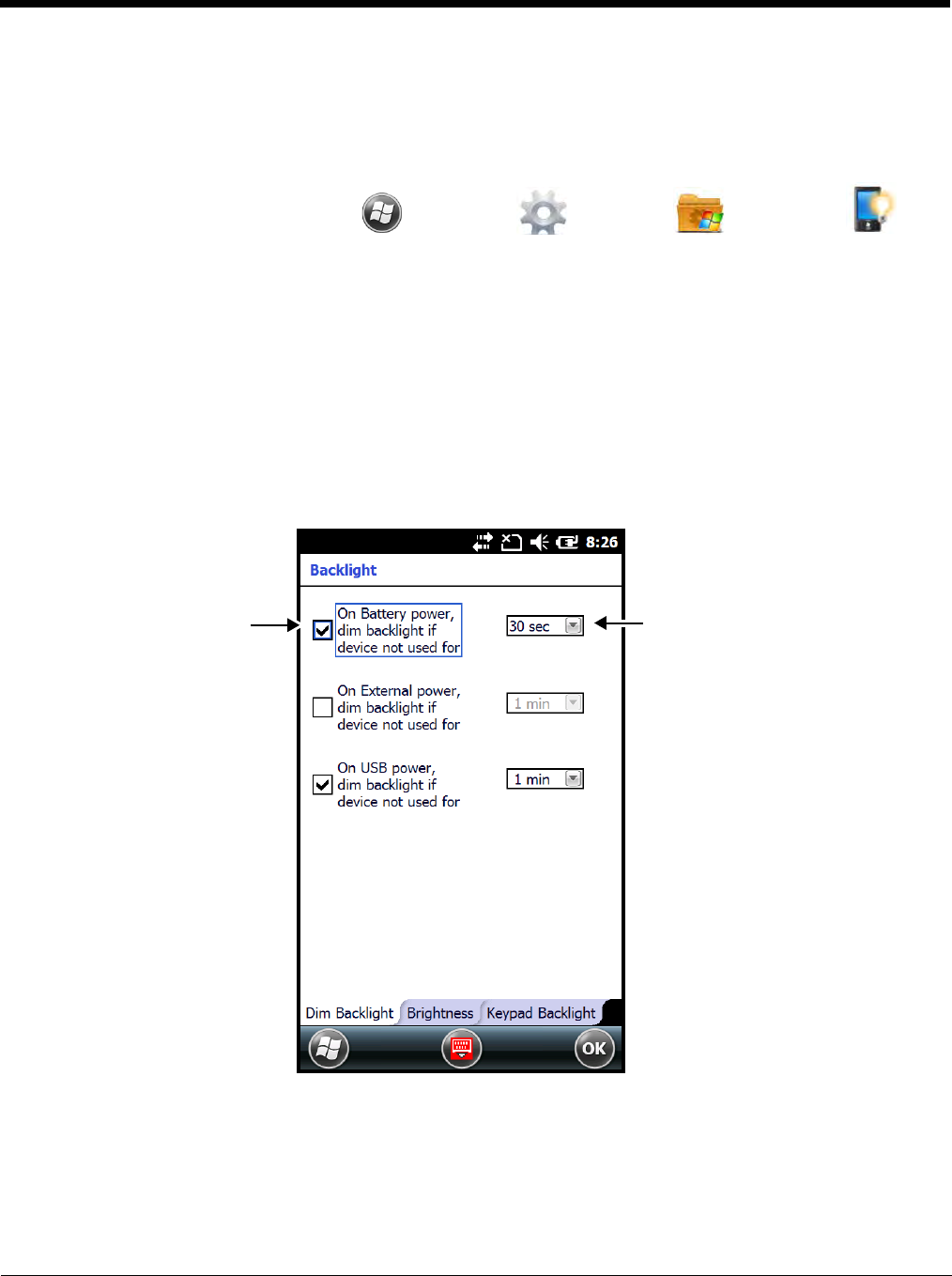
7 - 12
Backlight
The Backlight system setting enables you to customize backlight functionality for the display and keypad
(i.e., Send, Home, Back and End buttons). The settings menu contains three tabs: Dim Backlight,
Brightness and Keypad Backlight.
To access the Backlight settings, touch > Settings > System > Backlight .
Dim Backlight
The Dim Backlight settings determine if the backlight dims during periods of non-use and how many
minutes you want to elapse before the backlight automatically dims when the terminal is running on
battery power, external power or USB power.
•Battery Power: The terminal is being powered by the battery.
•External Power: The terminal is being powered by an external power source, e.g., HomeBase,
ChargeBase or Mobile Base.
•USB Power: The terminal is being powered by a USB connection, e.g., the Charge/
Communication cable connected to a workstation (PC) or used in conjunction with the provided
power supply (70e-USB ADAPTERKIT).
Check the box next to the
option to enable automatic
backlight dimming.
Touch the arrow, then select
the time increment you want to
elapse before the backlight
automatically dims.
Preliminary Draft 6/19/13, Not for Release
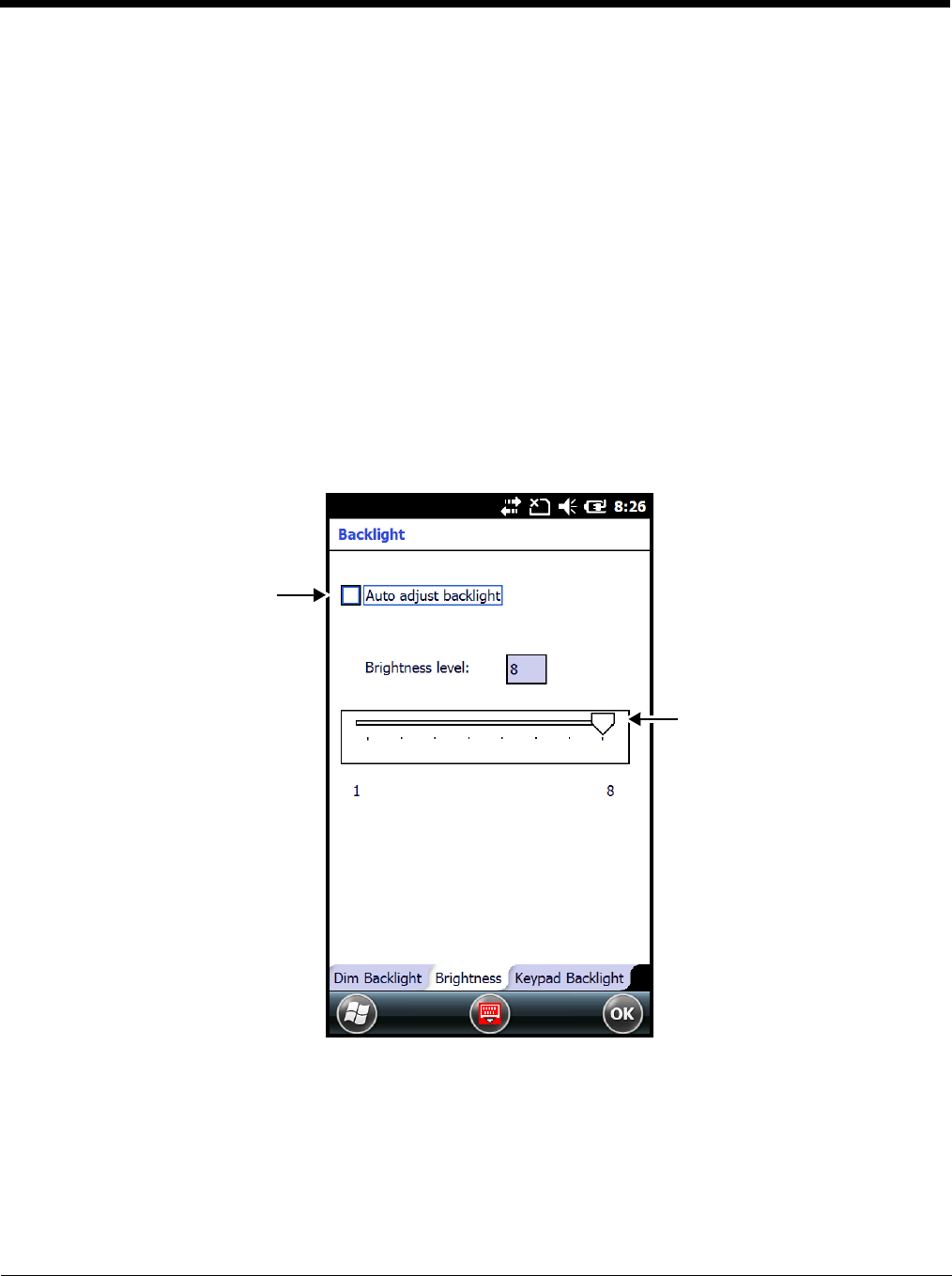
7 - 13
Brightness
The Brightness tab determines the backlight intensity of the display when the terminal is in use. The
settings customize how the terminal responds to the environmental lighting conditions in which the
terminal is being used.
Check the "Auto adjust backlight" box to enable automatic adjustment of the backlight intensity
depending on the operating environment. Once enabled, the terminal automatically adjusts the backlight
intensity to low, medium or high depending on the detected operating environment.
• Low light environments (e.g., dark areas with a limited light source) trigger a low intensity
backlight.
• Medium light environments (e.g., standard lighting in office buildings) trigger a medium intensity
backlight.
• High light environments (e.g., outside environments with bright sunlight) trigger a high intensity
backlight.
When the terminal is in a specific environment, you can manually adjust the brightness level for the
environment by changing the Brightness level number from 1 to 8 or by dragging the slider left or right on
the screen. The highest Brightness level is indicated with an 8.
Check the box to enable
automatic adjustment of the
backlight intensity for low,
medium, and high light
environments.
Touch and drag the slider to
manually adjust the
Brightness level setting of
the current environment.
Preliminary Draft 6/19/13, Not for Release
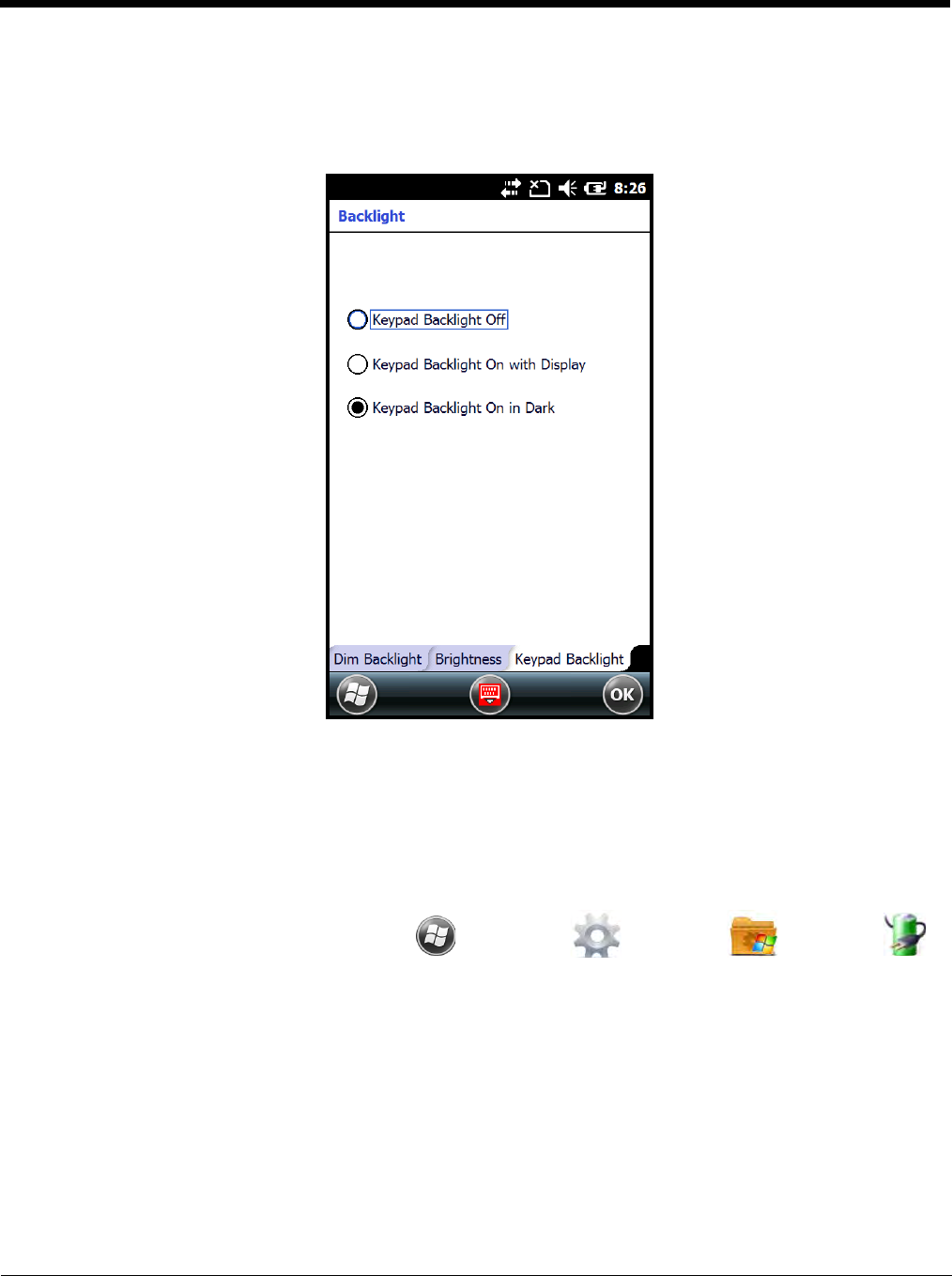
7 - 14
Keypad Backlight
The Keypad Backlight tab setting determines when the keypad (i.e., Send, Home, Back and End
buttons) backlight is activated. The backlight can be set to turn on with the display, to turn on in dark
environments or to stay turned off.
Battery
The Battery system settings menu contains two tabs: Battery Status and Log Config. The Battery
Status tab provides the status of the battery pack (e.g., Battery Time to Full or Battery Time to Empty,
Voltage, Current, Temperature, Chemistry, and Serial Number). The Log Config Tab allows you to
configure the BatteryLogFile.
To access the Battery system settings, touch > Settings > System > Battery .
Battery Status
The Battery Status tab provides the following information on the battery.
Battery Life Percent
The Battery Life Percent indicates the percentage of charge remaining on the battery.
Battery Time to Full or Empty
When external power is supplied to the terminal, the estimated charging time remaining to achieve a full
charge is listed. When power is supplied by the battery, the estimated time remaining on the battery
charge is listed.
Note: Time estimates are based on the present voltage and current readings.
Preliminary Draft 6/19/13, Not for Release
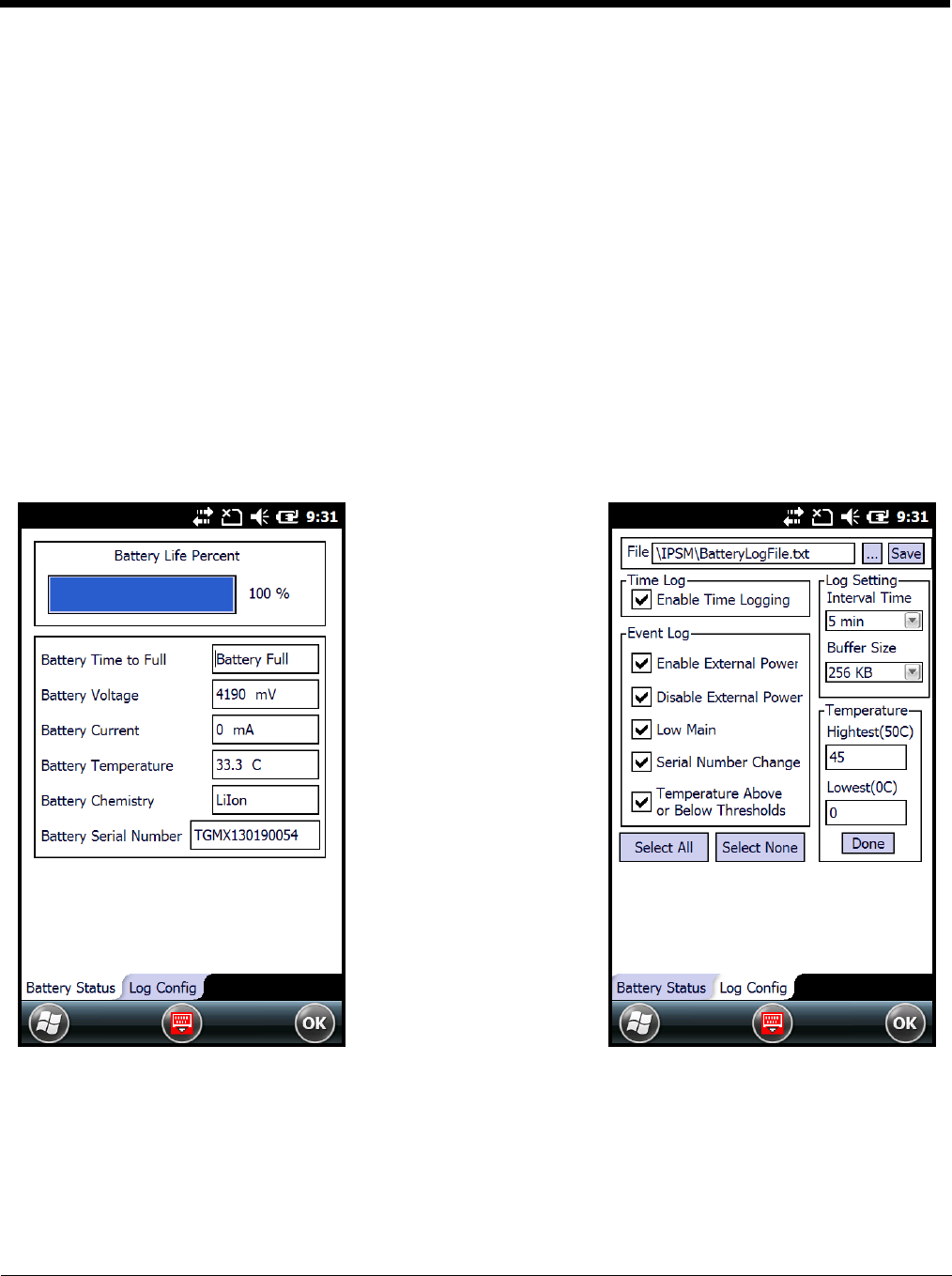
7 - 15
Battery Voltage
The Battery Voltage status can range from approximately 3.2 V to 4.2 V.
Battery Current
The Battery Current reflects the charging current going into the battery when it is a positive and the
discharge current when it is negative.
Note: The charging current is always less than current source due to device being in operation.
Battery Temperature
The Battery Temperature indicates the temperature status of the battery.
Battery Chemistry
The Battery Chemistry provides the battery type (e.g., LiIon).
Battery Serial Number
The Battery Serial Number displays the serial number of the authenticated Honeywell battery.
Battery Status Tab Log Config Tab
Preliminary Draft 6/19/13, Not for Release
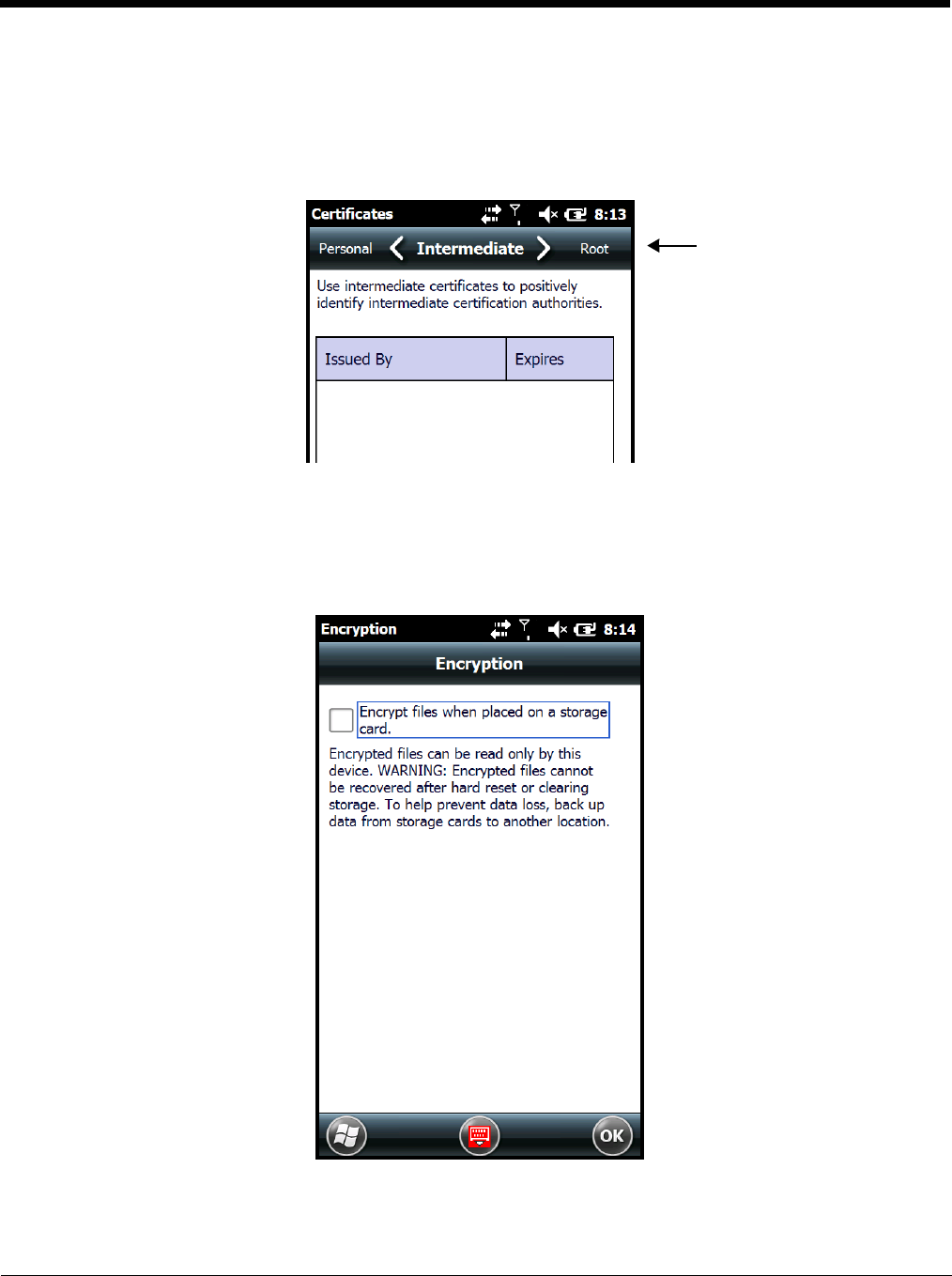
7 - 16
Certificates
Certificates shows you the certificates that are recognized by the operating system. The Horizontal scroll
bar at the top of the screen provides access to the three certificate screens: Intermediate, Personal,
and Root.
Encryption
Encryption gives you the option of encrypting files placed on storage cards so that those files cannot be
read by any other device. Check the box to enable file encryption when saving to a storage card.
Swipe left or right on the
Horizontal scroll or touch
the label (e.g., Root or
Personal) to access the
additional screens.
Preliminary Draft 6/19/13, Not for Release
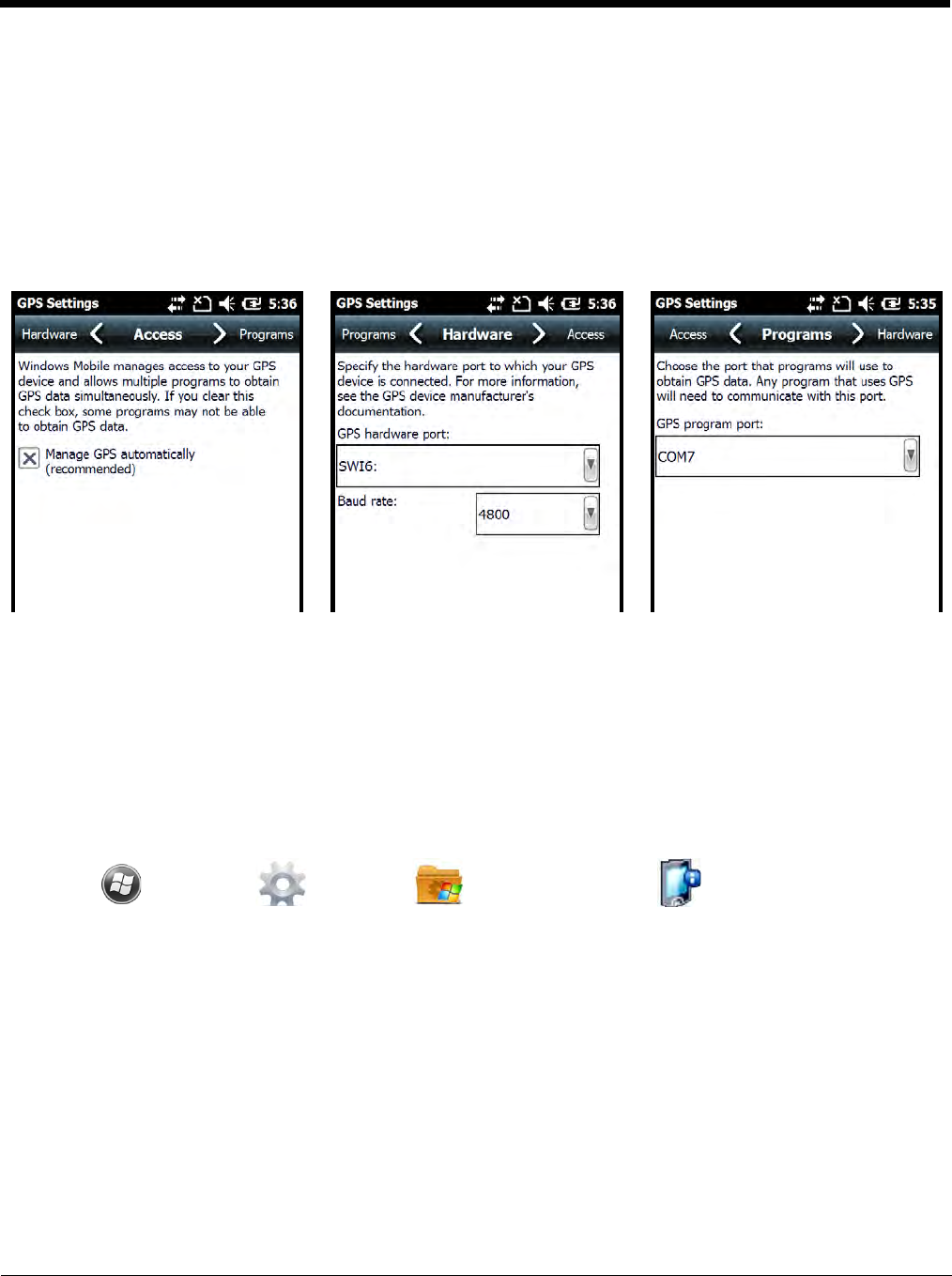
7 - 17
Error Reporting
Error Reporting gives you the option of enabling or disabling the error reporting function of Windows
Embedded Handheld 6.5.
External GPS
External GPS determines which port a third-party GPS software application can use to access the GPS
receiver.
Note: You need the installation parameters from the GPS manufacturer to configure the connection.
HSM SystemInfo
The HSM SysInfo screen provides important system information including firmware versions, DLL
versions, system parameters, as well as network and radio information. HSM SysInfo screen contains six
tabs: System, HW, SW, Radio, EXE and DLL.
To output the system information to a text file:
1. Touch > Settings > System > HSM SystemInfo .
2. Touch Save on the tile bar.
3. A text file containing the collected system information is created and saved to IPSM/SysInfo.txt.
To upload SysInfo.txt file to a Workstation via ActiveSync:
1. Connect the Dolphin terminal to the workstation using a Dolphin communication peripheral.
2. Open Windows Explorer on the workstation.
3. Navigate to the Mobile Device folder.
4. Double click My Windows Mobile-Based Device and navigate to the IPSM folder.
5. Copy the SysInfo.txt file to your workstation.
Access Screen Hardware Screen Programs Screen
Preliminary Draft 6/19/13, Not for Release
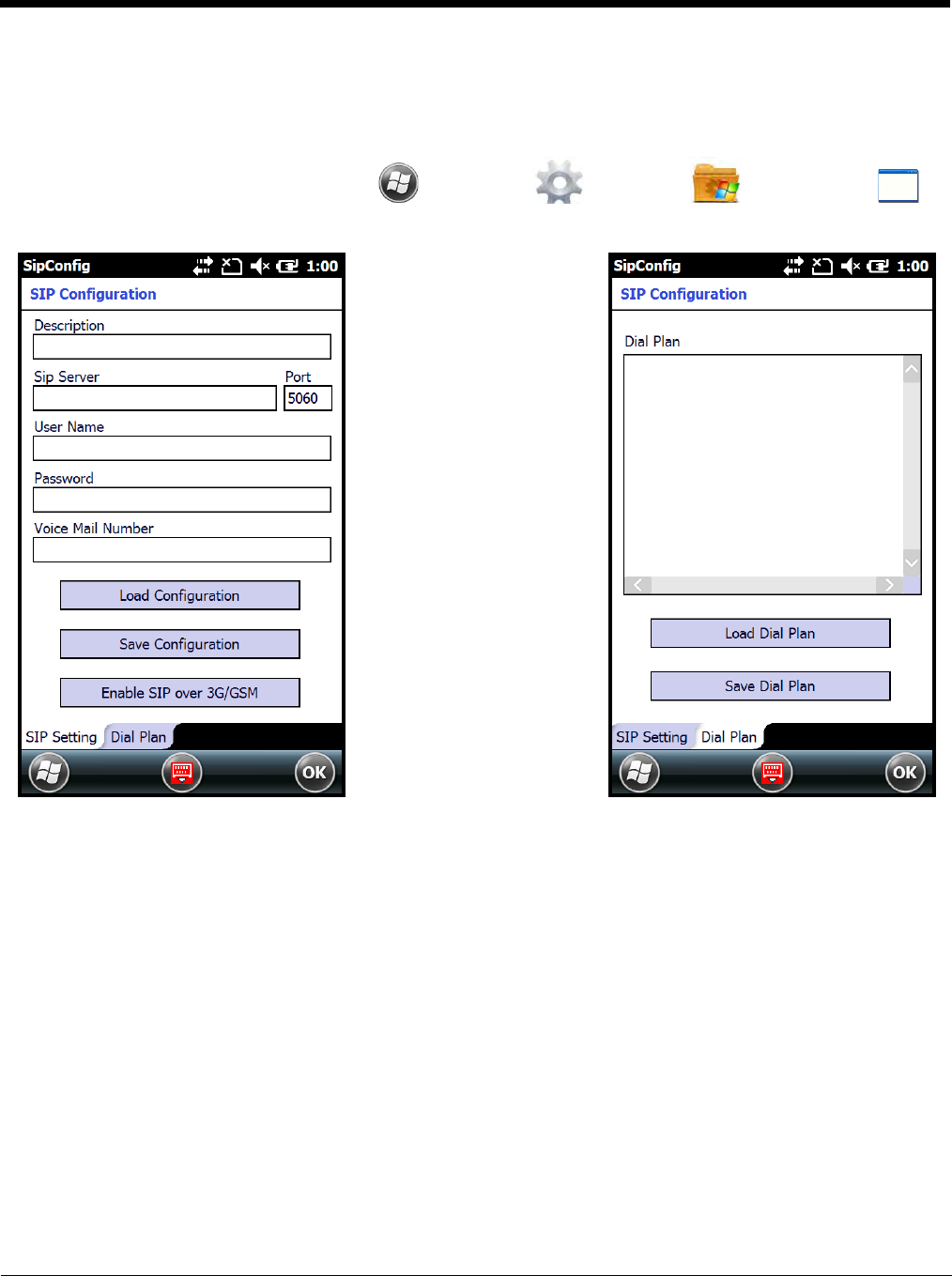
7 - 18
SIP Config
The SIP Config settings screen enables you to configure Session Initiation Protocol (SIP) for Voice Over
IP (VoIP) and Telephony communication.
To access the SIP Config screens, touch > Settings > System > SIP Config .
SIP Setting Tab Dial Plan Tab
Preliminary Draft 6/19/13, Not for Release
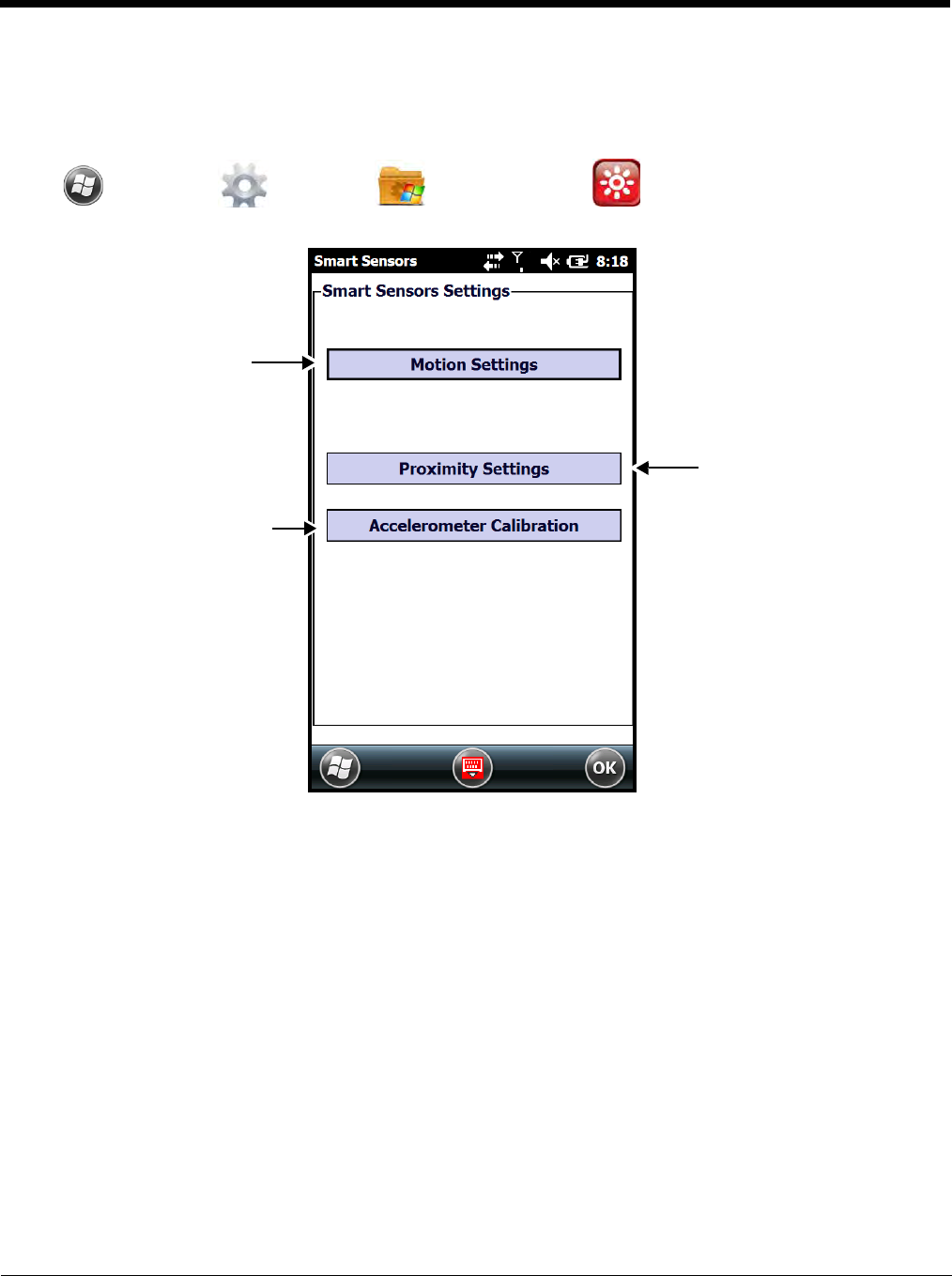
7 - 19
Smart Sensor
The Smart Sensor configuration utility enables you to configure the Dolphin’s integrated accelerometer,
and motion settings.
Touch > Settings > System > Smart Sensor .
Motion Settings
Motion Settings enable you to customize how the terminal responds to motion and object orientation for
ease of operation and advanced power management. The Motion Settings menu contains three tabs:
Display, Power, Management, and Event Tracker.
Display
The Display tab provides access to enable or disable Auto Display Orientation. When enabled, the
Dolphin's display automatically switches between portrait and landscape depending on how you hold the
terminal.
Power Management
The Power Management tab provides access to customize how the terminal responds to object orien-
tation and motion to reserve power and reduce time between charge cycles.
•Face Down:
Save power by turning off the display and/or suspending the device when the terminal is placed
face down.
Touch to customize how
the terminal responds to
motion and object
orientation for ease of
operation and advanced
power management.
Touch to calibrate the
integrated accelerometer
sensor used for motion
detection.
Touch to customize how the
terminal responds to objects
detected close to the touch
screen display.
Preliminary Draft 6/19/13, Not for Release
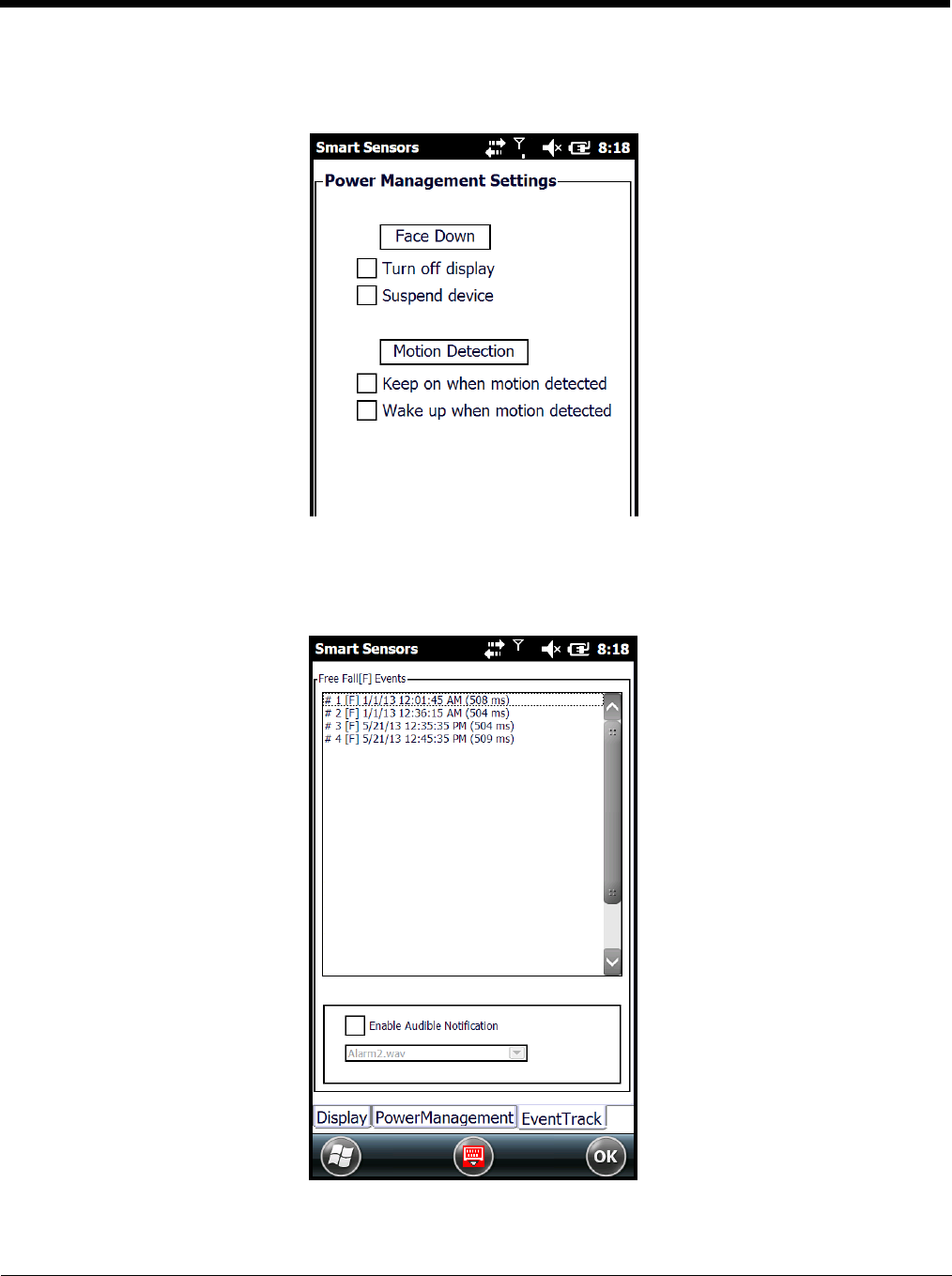
7 - 20
•Motion Detection:
Modify the Motion Detection settings to wake the terminal from suspend mode or prevent the
terminal from entering suspend mode when motion is detected.
Event Track
The Event Track tab displays an event log summary of detected free fall events exceeding 2 ft. over
500ms. The summary includes the time, date, and duration of the most recent 50 events. Several options
are provided for audible notification of free fall events.
Preliminary Draft 6/19/13, Not for Release
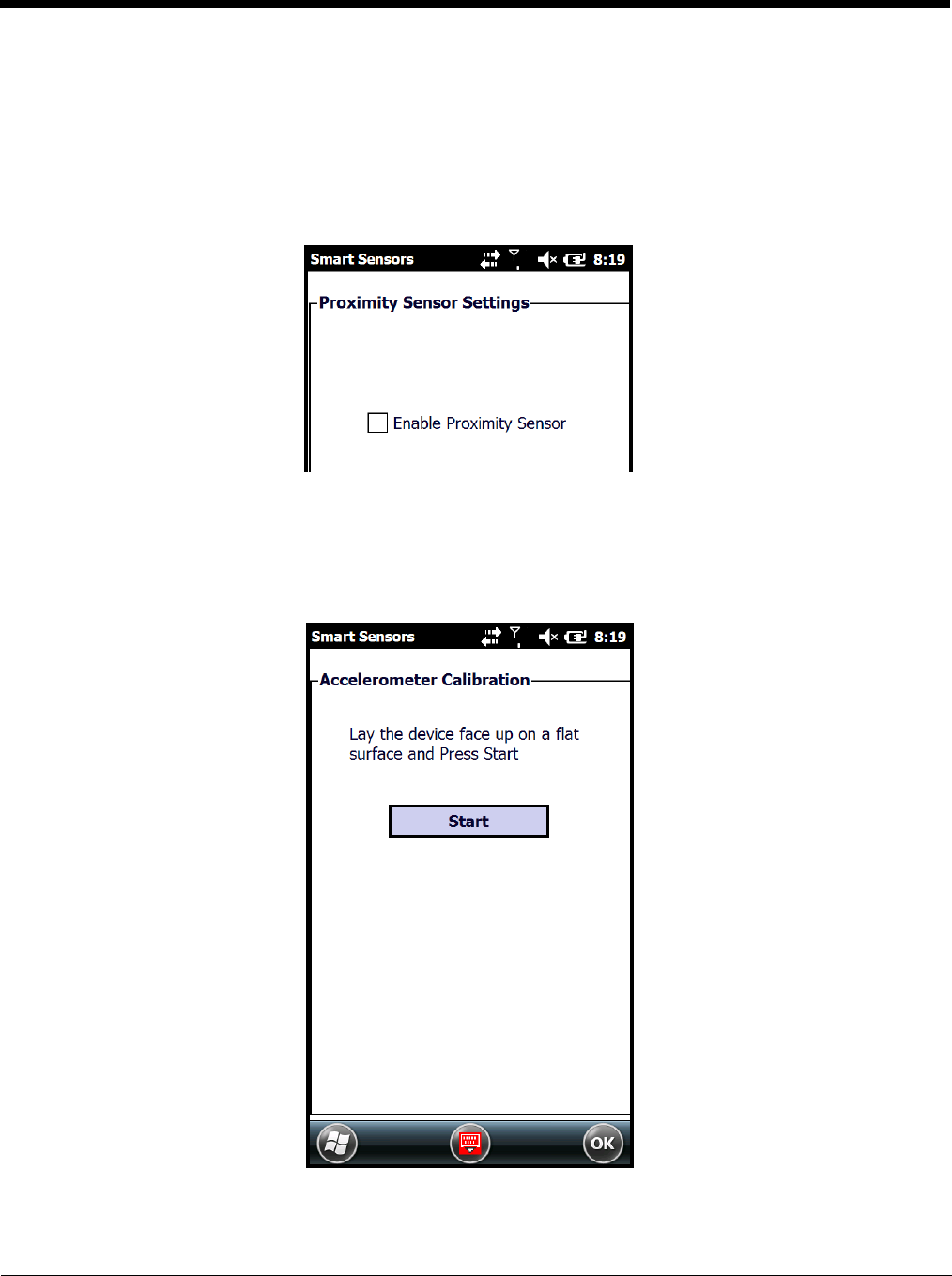
7 - 21
Proximity Sensor Settings
The integrated proximity sensor detects when an object is in close proximity to the entire touch panel
display (e.g., a person's face, carrying holster, or tabletop). By default, the proximity sensor automatically
turns the display and touch panel off when you hold the terminal near your ear during a phone call. The
display and touch panel turn back on when the sensor detects the removal of the object.
To enable this feature at all times, not just during phone calls, check the Enable Proximity Sensor box.
Accelerometer Calibration
Tou ch Start to calibrate the integrated accelerometer sensor used for motion detection. When calibration
is complete, the “Accelerometer Calibration Finished!” message window appears.
Preliminary Draft 6/19/13, Not for Release
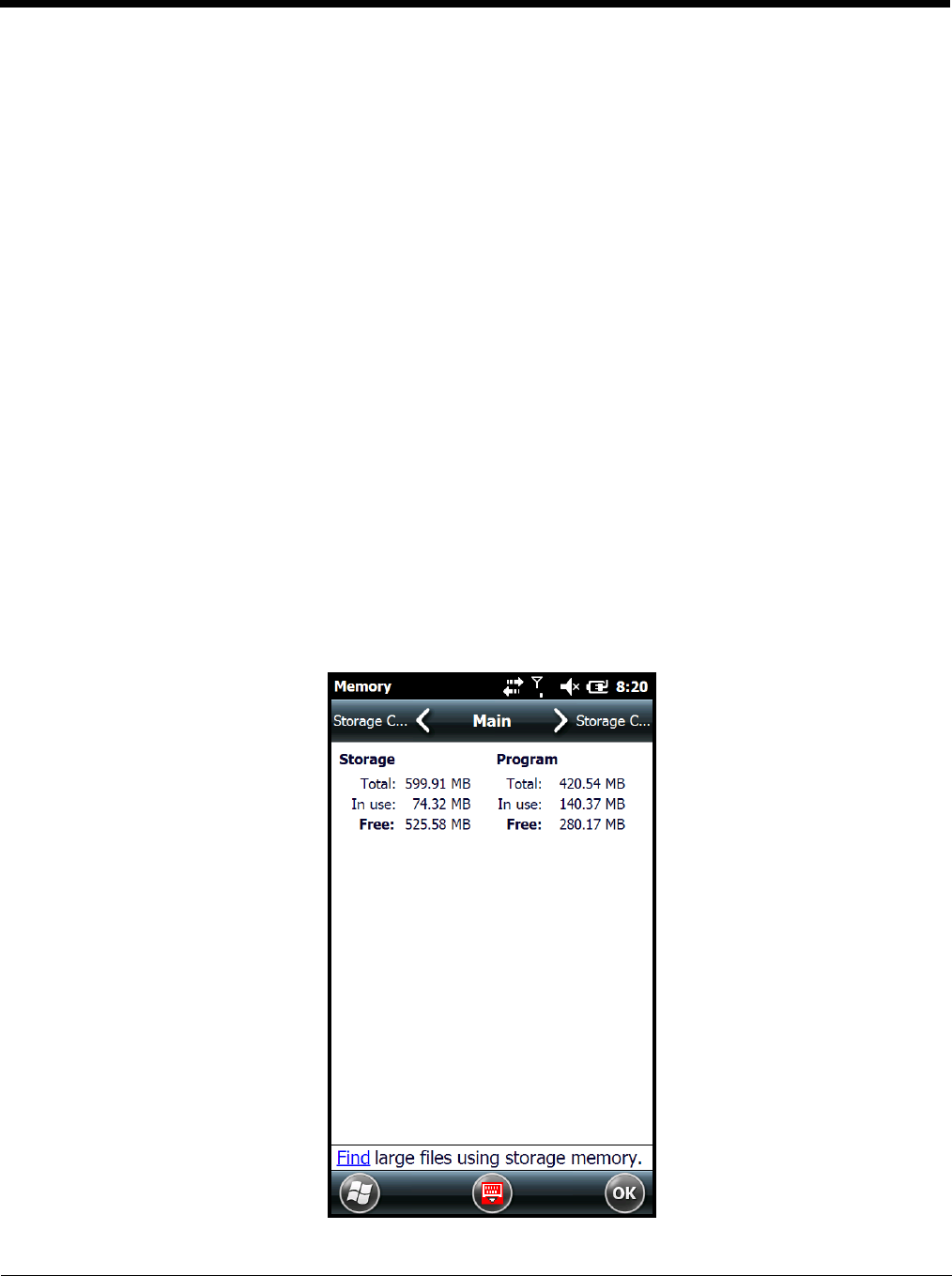
7 - 22
Managed Programs
The Managed Programs screen lists the installation history of programs on the terminal that are
managed by and enrolled to an enterprise domain. Managed Programs is the client-side that works with
the server product System Center Mobile Device Manager (MDM). MDM consists of MDM Gateway
Server and one or more computers that run MDM Device Management Server; MDM Enrollment Server;
and Microsoft SQL Server® 2005 databases.
It lets system administrators:
• provide an authenticated connection to Line of Business (LOB) applications, managed Group Policy,
and application packages.
• use Group Policy and software packages to manage the enrolled Windows phones (enforce policy,
wipe devices, etc.).
• manage the requests for and retrieving of certificates for devices and for creating the Active Directory®
Domain Service objects that represent these devices. By using these objects, you can manage the
devices as if they were members of a domain.
Memory
The Memory applet shows the capacity and usage of the Storage and Program portions of the Flash file
system. The Storage portion includes the IPSM folder, which can be detailed under the Storage Card
tab. When the Program portion becomes too full, you can use the Task Manager to remove any unnec-
essary tasks.
Main Screen
The Main screen displays the usage statistics of the flash memory.
Preliminary Draft 6/19/13, Not for Release
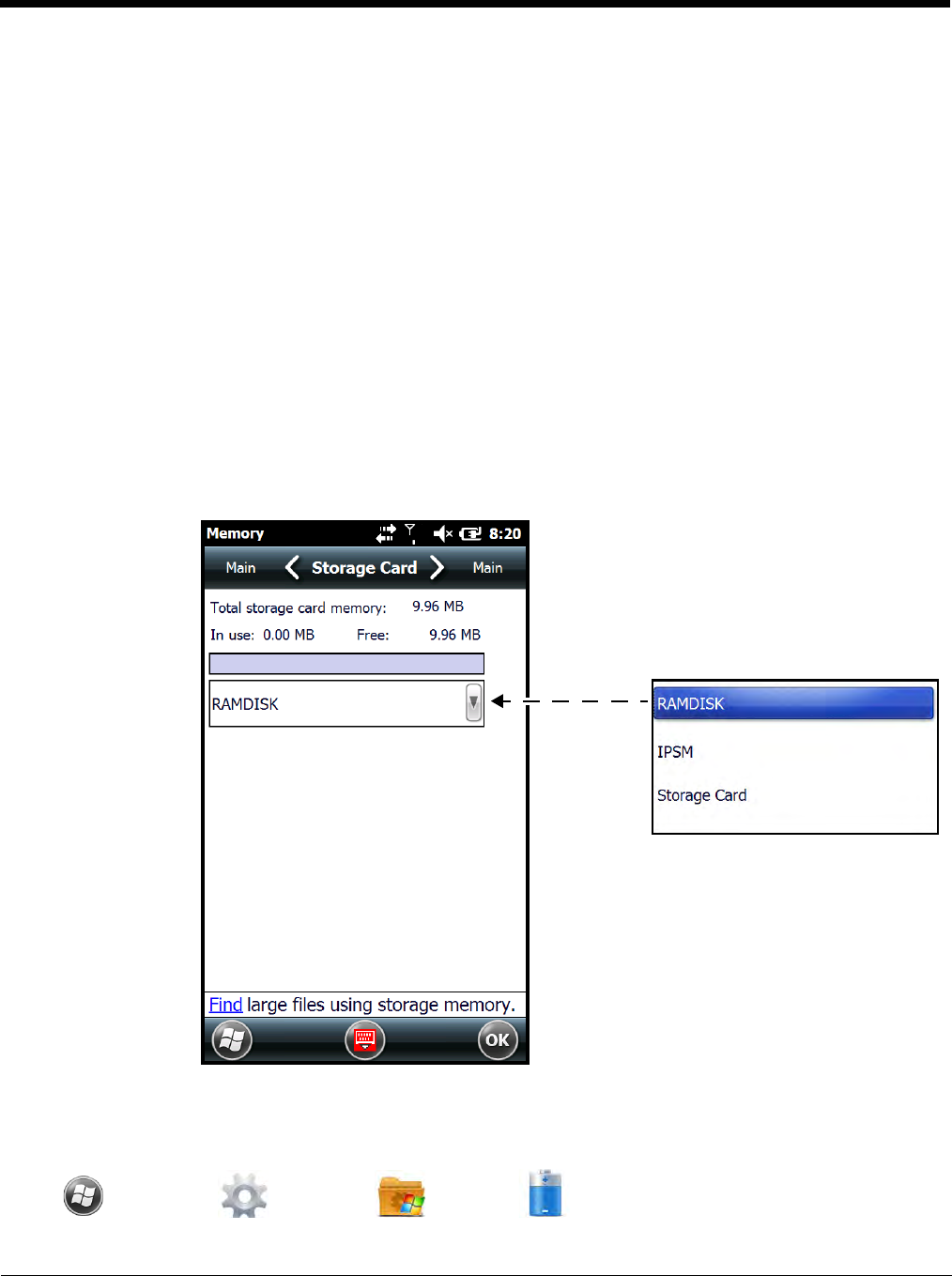
7 - 23
Storage Card Screen
The Storage Card screen displays the current capacity and usage statistics of the selected memory
type: IPSM, RAMDISK or Storage Card. Select the memory type from the drop-down list. RAMDISK is
selected by default.
•IPSM (Internal Persistent Storage Manager)
Data or programs stored in the IPSM are not affected when the operating system is upgraded.
Autoinstall programs, for example, are stored in \\IPSM\Honeywell\Autoinstall so that they are
always installed after an operating system upgrade or factory reset. Contact a Honeywell
technical support representative for more information on how to perform a factory reset. For
contact information, see Technical Assistance on page 14-1.
•RAMDISK, is a virtual disk that resides in RAM, volatile memory. The virtual disk provides faster
access speed than the ISPM or other system folders. RAMDISK is volatile and is cleared when
a reset (i.e., soft, hard or factory) is performed or power is lost.
•Storage Card
You can install one memory card in Dolphin terminals (see Installing a SIM Card and/or Memory
Card on page 3-16). If a storage card is installed in the terminal, you can select it in the drop-
down list and see capacity and usage statistics for the card.
Power
Power system settings contains two tabs: Battery and Advanced
Touch > Settings > System > Power
Preliminary Draft 6/19/13, Not for Release
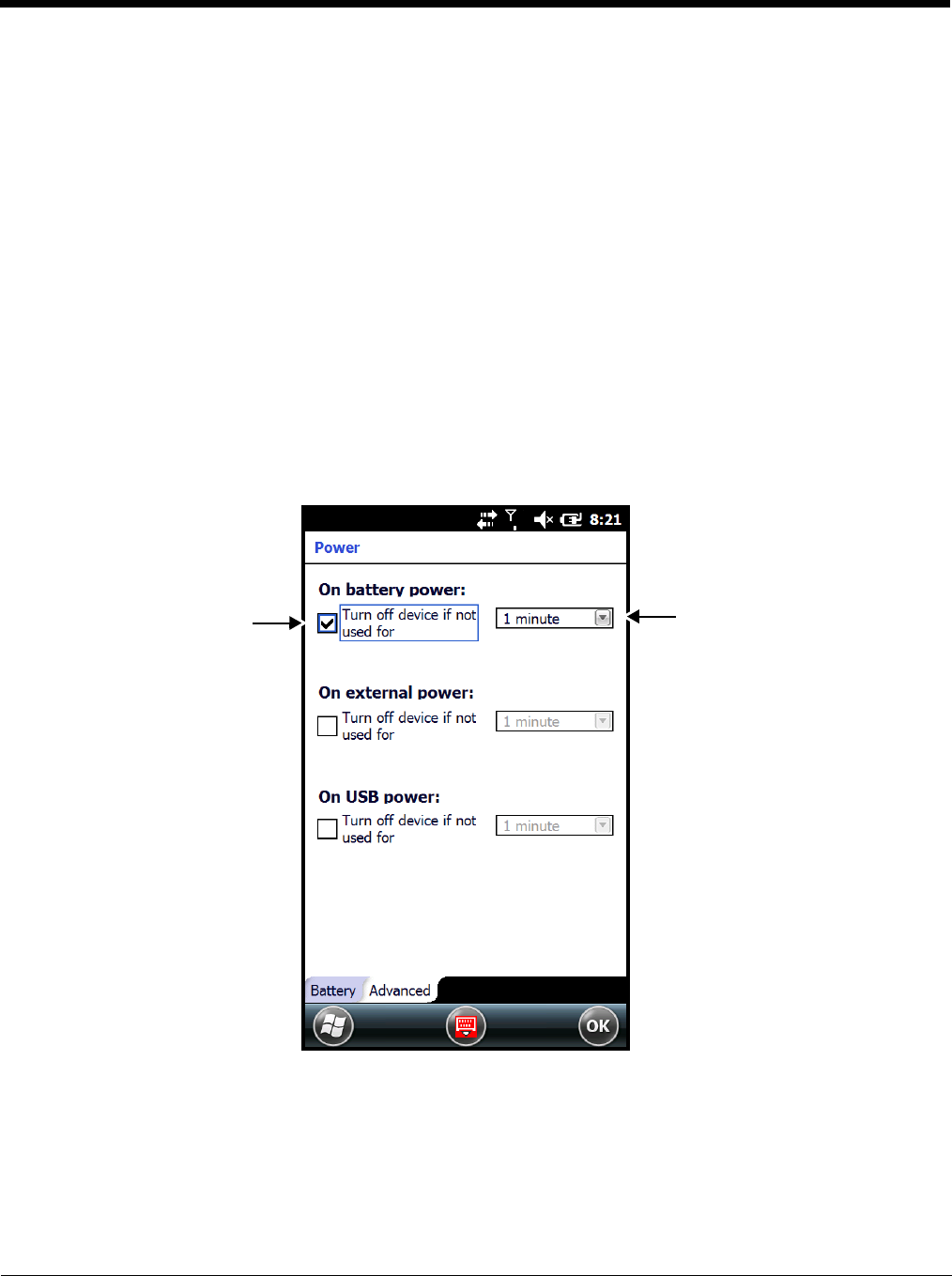
7 - 24
Battery Tab
The battery tab displays the power level status of the battery. For detailed information on the main
battery, see Battery on page 7-14.
Advanced Tab
The Advanced tab settings determine power time-outs when running on battery power, external power,
or USB power. To reserve power and extend time between charging cycles, configure the terminal to
automatically enter Suspend Mode (see page 2-12) after a specific number of minutes of inactivity.
On battery power: The terminal is being powered by the battery.
On external Power: The terminal is being powered by an external power source, e.g., HomeBase.
On USB Power: The terminal is being powered by a USB connection, e.g., the Charge/Communication
cable connected to a workstation (PC) or used in conjunction with the provided power supply (60s-USB
ADAPTERKIT).
Note: The On USB power time-out setting does not auto-spend the terminal if an ActiveSync connection between
the terminal and workstation is active. Disable ActiveSync on the workstation in order for the device to auto-
suspend while connected to the workstation.
Regional Settings
Regional Settings enables you to customize the appearance and formatting to your geographic region.
Specifically, you can customize numbers (i.e., number of decimal places allowed), currency (i.e.,using
the $ or €
€ symbol), time, and date. These specifications apply to all screens, including the Home screen.
The Region screen displays an overview of the region selected in the drop-down list at the top.
Check the box next to the
option to enable power
time-outs.
Touch the arrow, then select
from the drop-down list, the
number of minutes of inactivity
you want to pass before the
terminal enters Suspend Mode.
Preliminary Draft 6/19/13, Not for Release
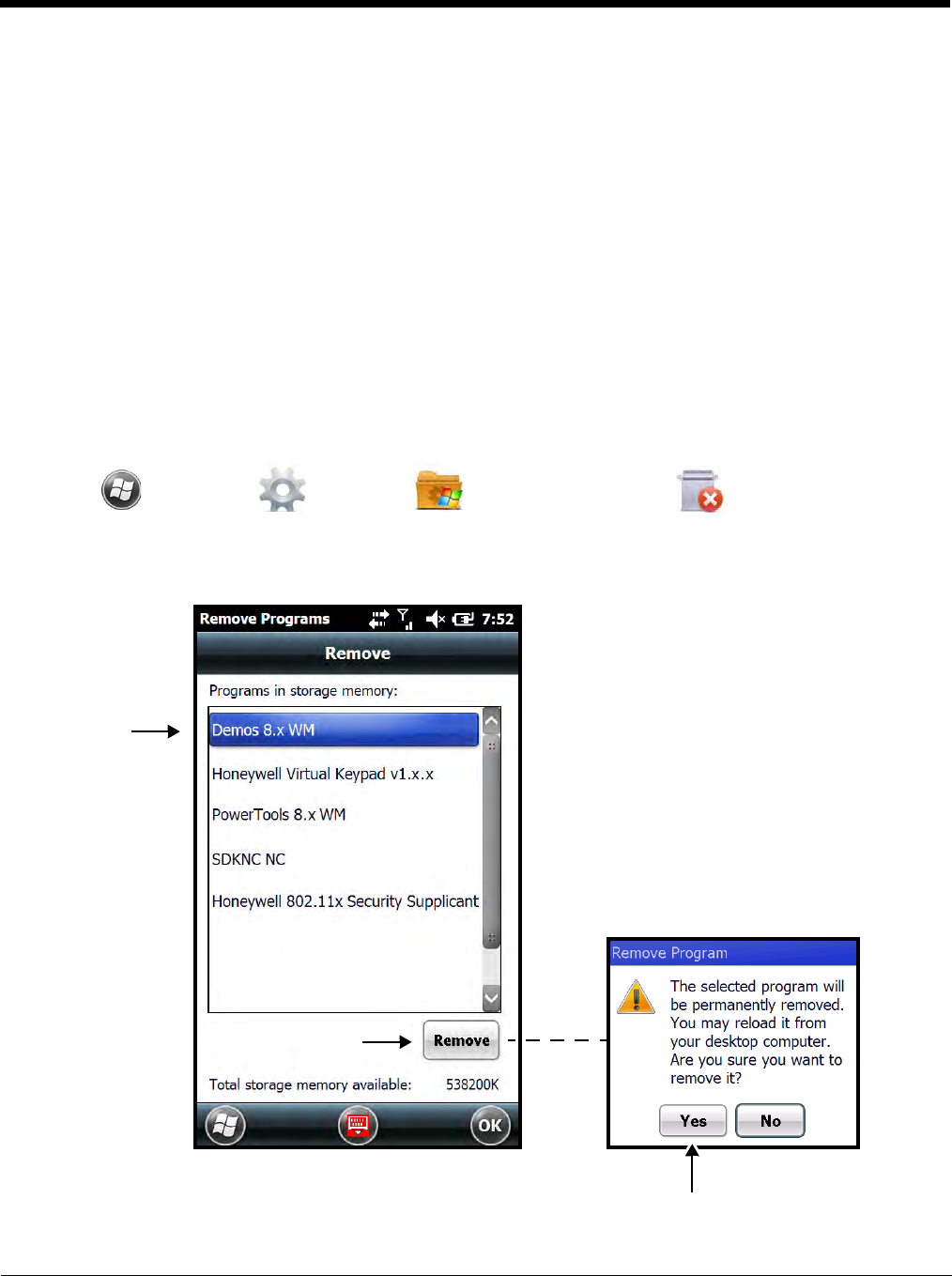
7 - 25
The terminal is loaded with a number of pre-programmed regional settings. Select one from the list and
the results appear on the screen. To see specific settings or to change a specific setting, touch on one of
the items on the horizontal scroll bar (i.e., Region, Number, Date), make the change, and touch OK to
save.
Remove Programs
Remove Programs enables you to remove programs installed on the terminal. Any program (usually CAB
or DLL files) stored in the \\IPSM\Honeywell\Autoinstall folder re-installs after a software upgrade or a
factory reset. If a program is manually removed using the Remove Programs application, the program
does not re-install on a hard or soft reset.
Note: A program (file) does not automatically install if it is added to the \\IPSM\Honeywell\Autoinstall folder and a
hard or soft reset is performed. For information on program installation, see Installing Additional Software on
page 8-11.
For information about the system resets, see Resetting the Terminal on page 2-13. See Honeywell
support for more information on how to perform a factory reset.
1. Touch > Settings > System > Remove Programs .
2. Select the program you want to remove on the list, and then touch Remove.
3. Touch Yes. Wait while the program is removed.
4. Verify that the program no longer appears in the list.
Preliminary Draft 6/19/13, Not for Release
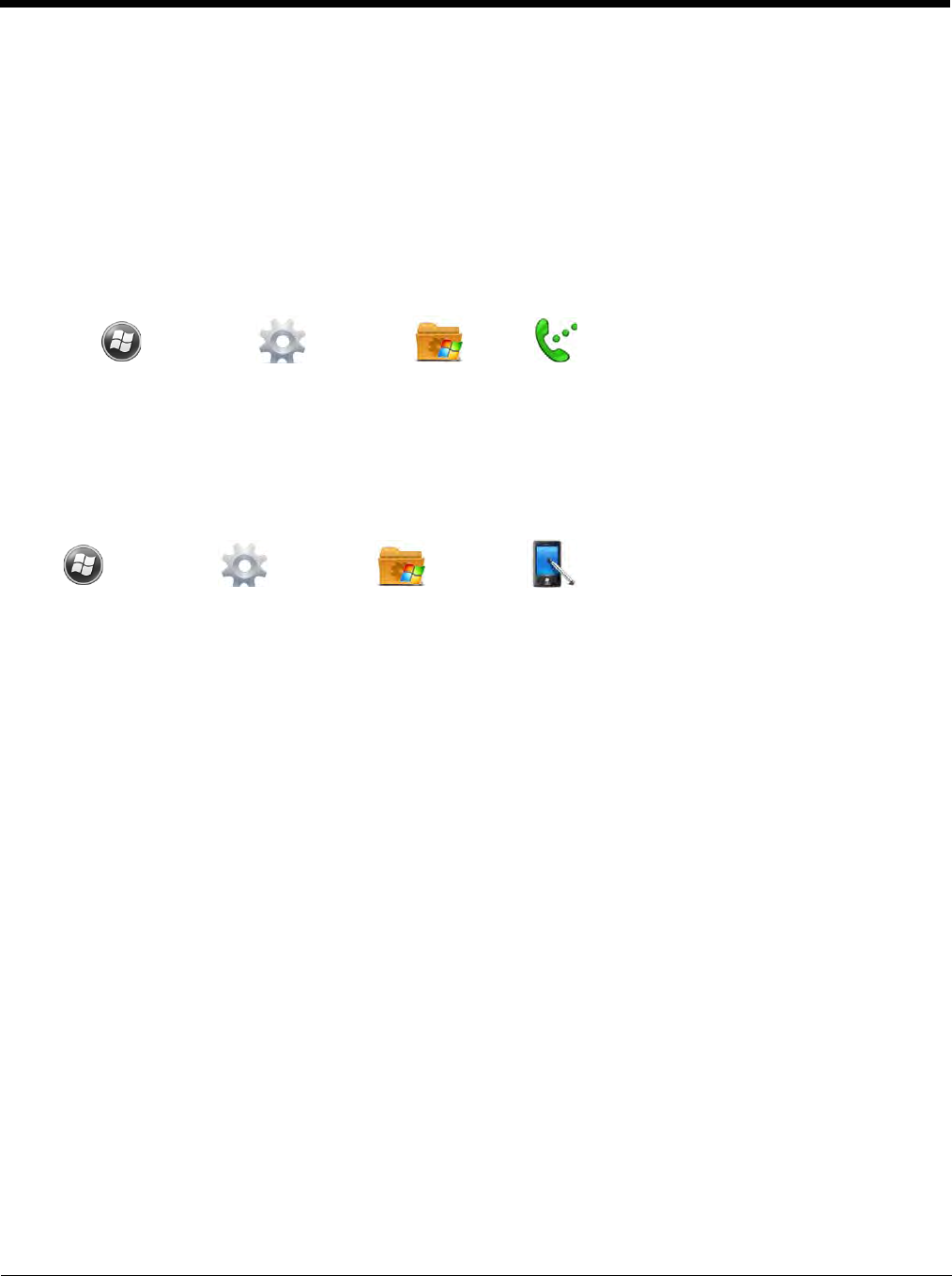
7 - 26
RIL
The RIL Information screen displays useful statistics for the GSM/CDMA WWAN Voice module and
enables you to turn HAC Audio Mode on or off. When HAC Audio mode is enabled, a magnetic/voice
coil activates in the terminal earpiece/receiver speaker allowing the terminal to interface with a hearing-
aid. To verify whether or not the WWAN radio is enabled, check the Dolphin Wireless Manager (see page
8-6).
HAC Audio Mode
To enable the terminal for use with a hearing-aid:
1. Touch > Settings > System > RIL .
2. Check the box next to Use HAC Audio Mode.
3. Touch OK.
Screen
The Screen system setting contains two screens: Clear Type, and Text Size.
Touch > Settings > System > Screen .
ClearType Screen
The display supports ClearType font rendering, which is a Microsoft technology that dramatically
increases the readability of text on LCD displays.
To enable ClearType font rendering, select Enable ClearType and touch OK.
Note: For more information about ClearType font rendering, visit: www.microsoft.com/typography/
WhatIsClearType.mspx.
Preliminary Draft 6/19/13, Not for Release
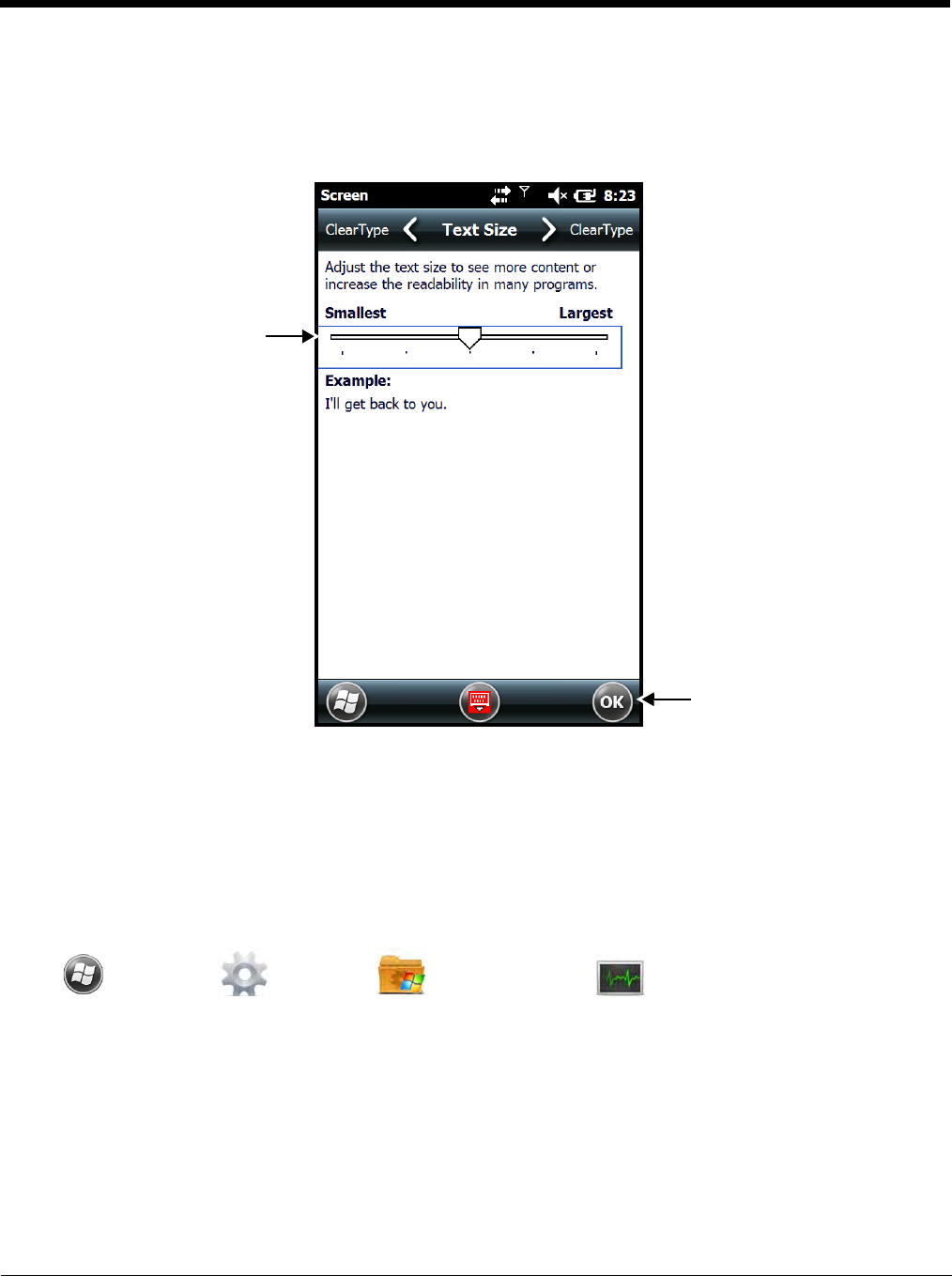
7 - 27
Text Size Screen
The Text Size screen enables you to perform font scaling within certain views of the: Home screen (only
on non-phone devices), Contacts, Calendar, Messaging, and Tasks. Font scaling means that you can
increase or decrease the point size of the font on application windows.
Task Manager
The Task Manager provides information about applications and processes running on your mobile
computer. You can use the Task Manager to monitor the memory and CPU usage of specific applications
and processes. Check the Task Manager when you are receiving out of memory errors or when the
mobile computer is running slowly.
Touch > Settings > System > Task Manager .
To change the text size,
move the slider toward
Smallest or Largest. The
Example text changes to
reflect the font change.
Tou ch OK to save the
new text size.
Preliminary Draft 6/19/13, Not for Release
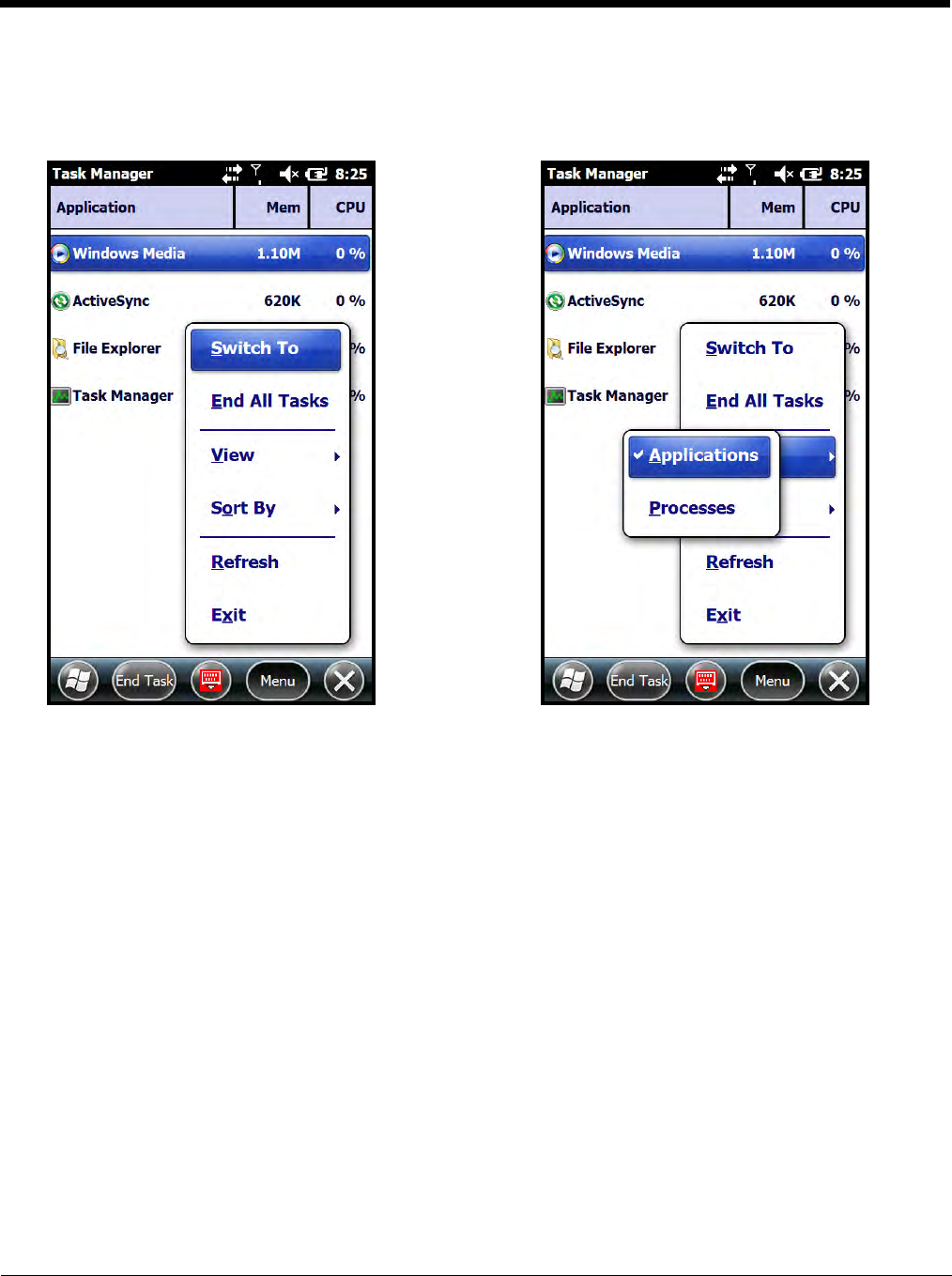
7 - 28
Applications
To view the status of the programs running on your mobile computer, touch the Menu button at the
bottom of the screen, then touch View > Applications.
From the application list, you can:
• Touch and hold on an application, then touch Switch To on the pop-up menu.
• Touch and hold on an application, then touch End Task or End All Tasks on the pop-up menu.
Note: Anytime you stop a running program, it frees up memory. To free up memory, return to the running program,
save your data, and close the application.
Preliminary Draft 6/19/13, Not for Release
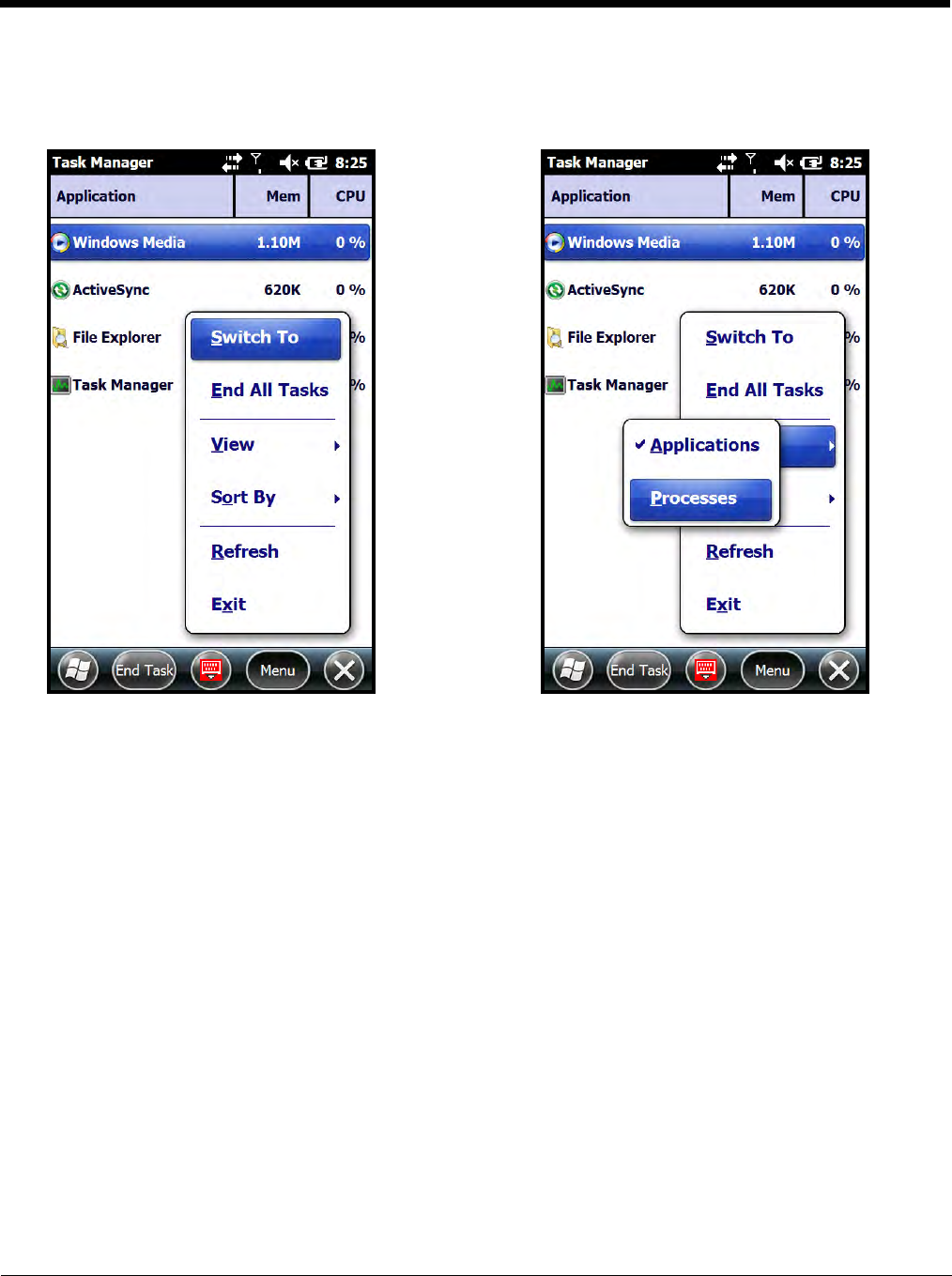
7 - 29
Processes
To view information about the processes running on the mobile computer, touch the Menu button at the bottom of
the screen, then touch View > Processes.
Preliminary Draft 6/19/13, Not for Release

7 - 30
Preliminary Draft 6/19/13, Not for Release
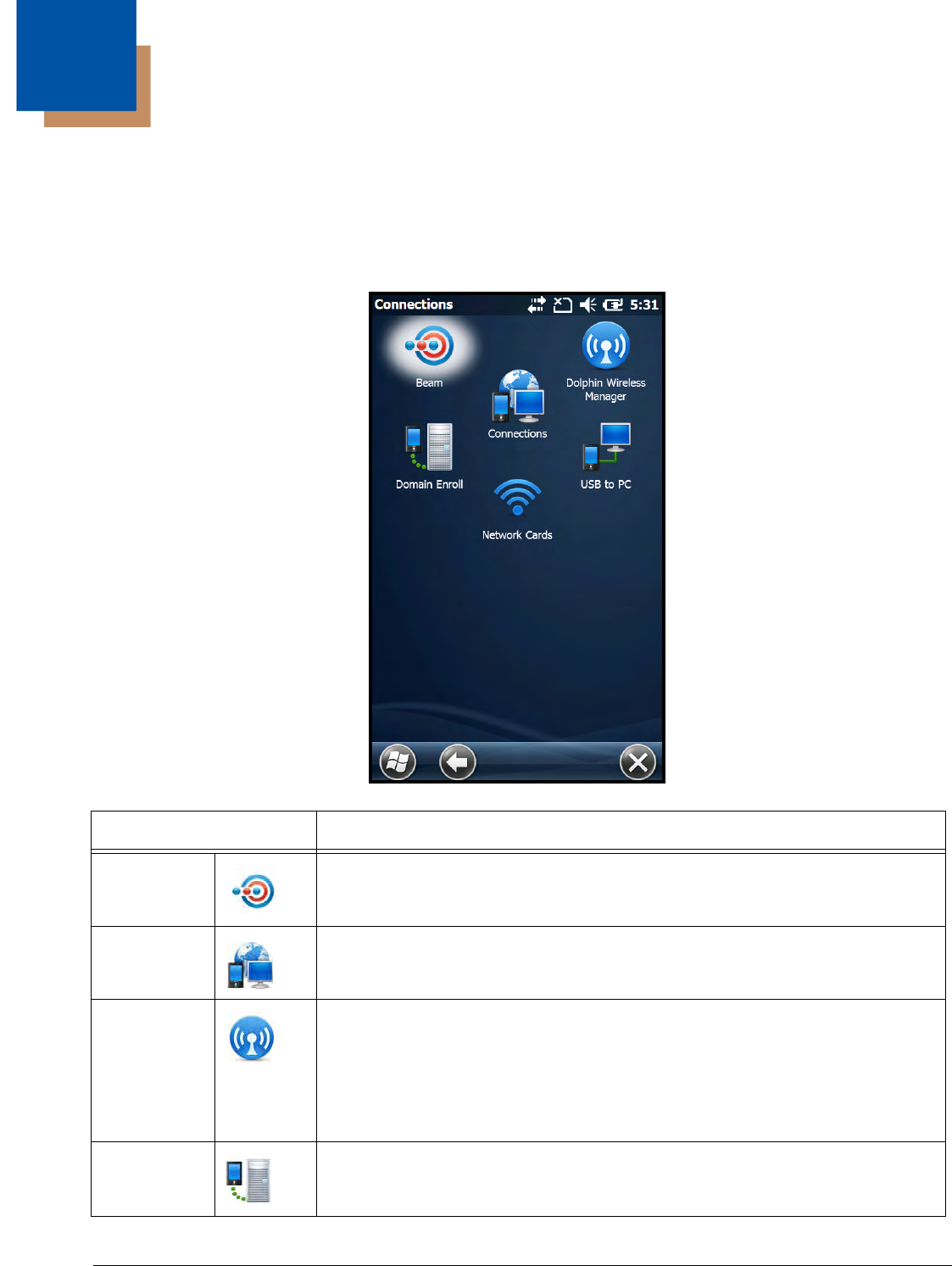
8 - 1
8
Communication
Connections Menu
The Connections system setting provides access to the terminal’s various wireless communication
options.
Icon Description
Beam Enable the terminal to receive incoming beams from devices using Bluetooth
wireless technology. See Working with the Bluetooth Radio on page 10-1.
Connections Open the Microsoft connections application. See Microsoft Connections
Application on page 8-2.
Dolphin
Wireless
Manager
Manage the wireless radios installed in the terminal. See Dolphin Wireless
Manager on page 8-5.
Note: The Dolphin Wireless Manager icon may not appear on the Connections
menu on terminals running Microsoft Windows Embedded Handheld 6.5
Classic. For information on how to access the Dolphin Wireless Manager,
see page 8-5.
Domain
Enroll Open the Enrollment screen for connecting your phone with company resources.
Note: System administrator password is required for domain enrollment.
Preliminary Draft 6/19/13, Not for Release
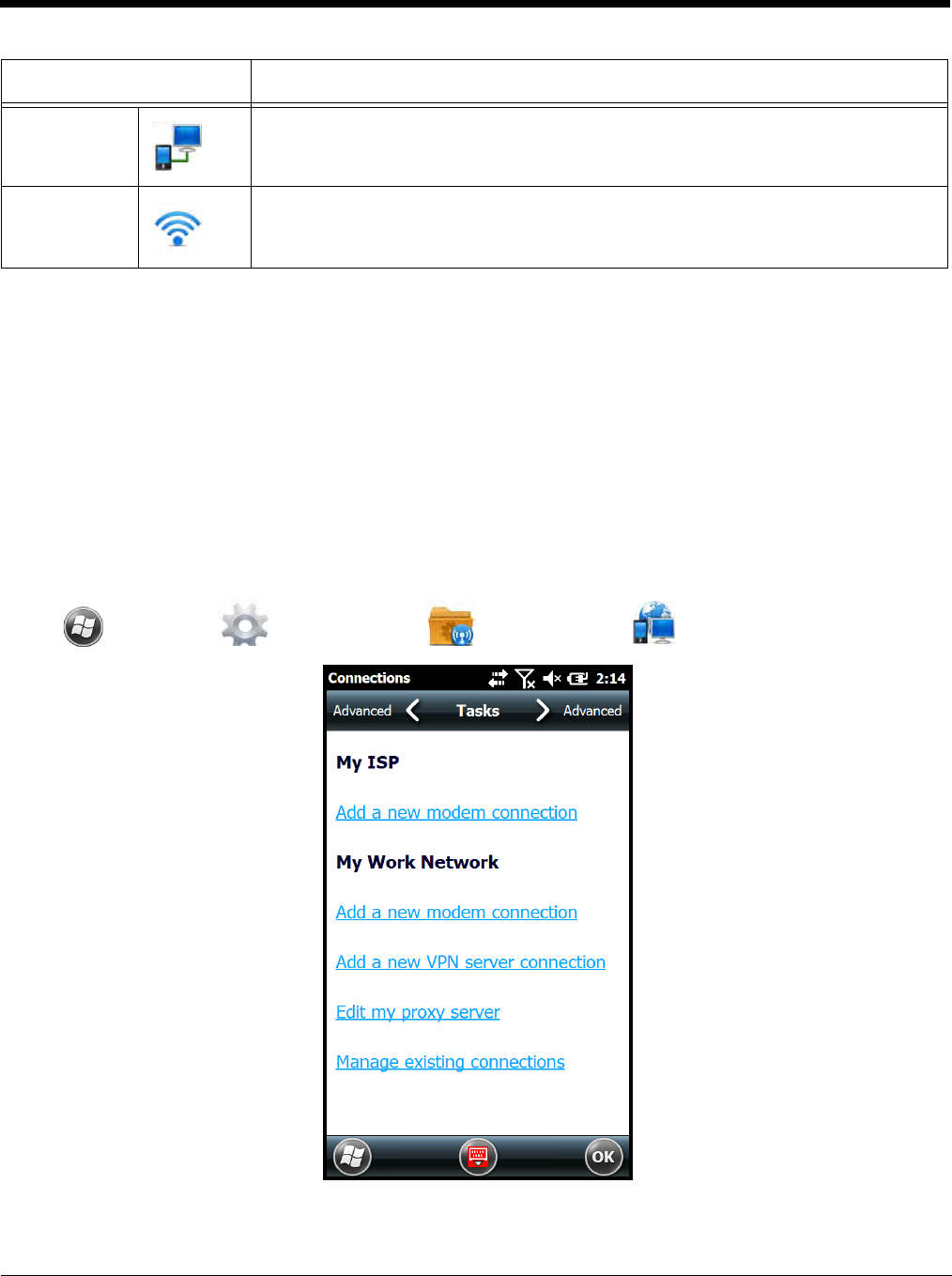
8 - 2
Microsoft Connections Application
The Microsoft Connections application sets up multiple network connections to Internet Service
Providers (ISPs) via an external modem.
Do NOT enter connection parameters in the Connections application if:
• you are using one of the on-board wireless radios to connect to a network. The Dolphin terminal uses
the settings from each radio’s configuration utility to connect. The connections application is used
primarily to setup WAN modem dial up connections.
• you are using Wireless Zero Configuration (WZC). By default, WZC is disabled on Dolphin terminals.
To Access the Connections Application
Touch > Settings > Connections > Connections .
USB to PC Enable advanced wired USB to PC communication via sync software. See
Connecting and Synchronizing the Terminal and Workstation on page 8-9.
Network
Cards Manage Network card settings, search and add wireless networks, and modify
advanced Wi-Fi settings (e.g., network notifications and connection time-outs).
Icon Description
Preliminary Draft 6/19/13, Not for Release
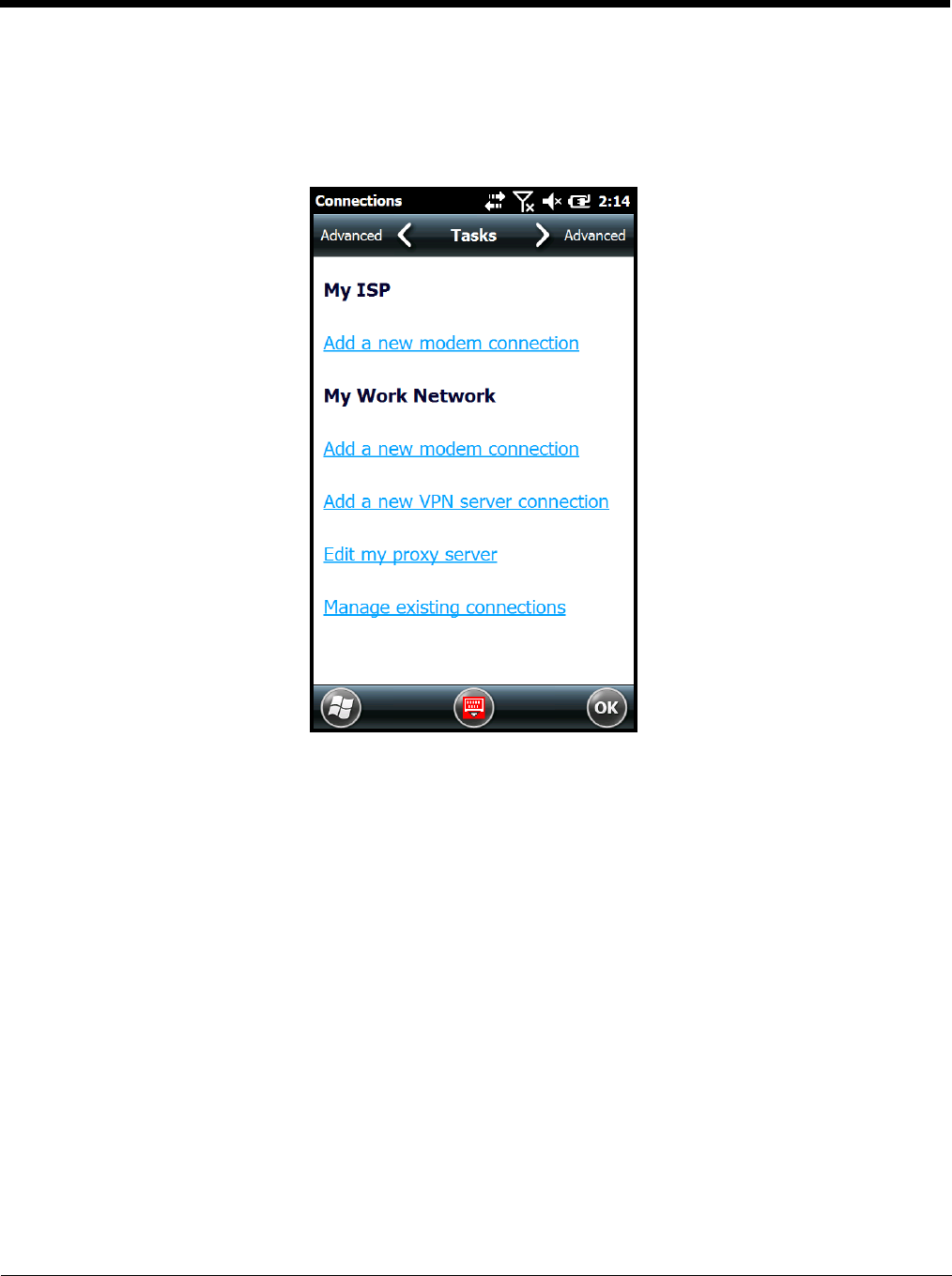
8 - 3
Tasks
The Tasks screen enables you to initially configure, and then manage network settings when using a
modem. Select an item in this list and then complete the setup screens that follow with the appropriate
information for your network.
My ISP
The links under the
My ISP
heading enable you to add and manage modem connections to an Internet
Service Provider (ISP). To complete the setup screens, obtain the following information from your ISP:
• ISP dial-up access telephone number
• User name
• Password
• TCP/IP settings
My Work Network
The links under
My Work Network
enable you to establish the following connection types:
• Modem
• Virtual Private Network (VPN)
• Proxy server connection
Note: If you are connected to your ISP or private network during synchronization, the terminal should download the
proper proxy settings during synchronization with the workstation. If these settings are not on your workstation
or need to be changed, ask your ISP or network administrator for the proxy sever name, server type, port,
type of Socks protocol used, and your user name and password.
To complete the setup screens, obtain the network parameters from your system administrator.
Preliminary Draft 6/19/13, Not for Release
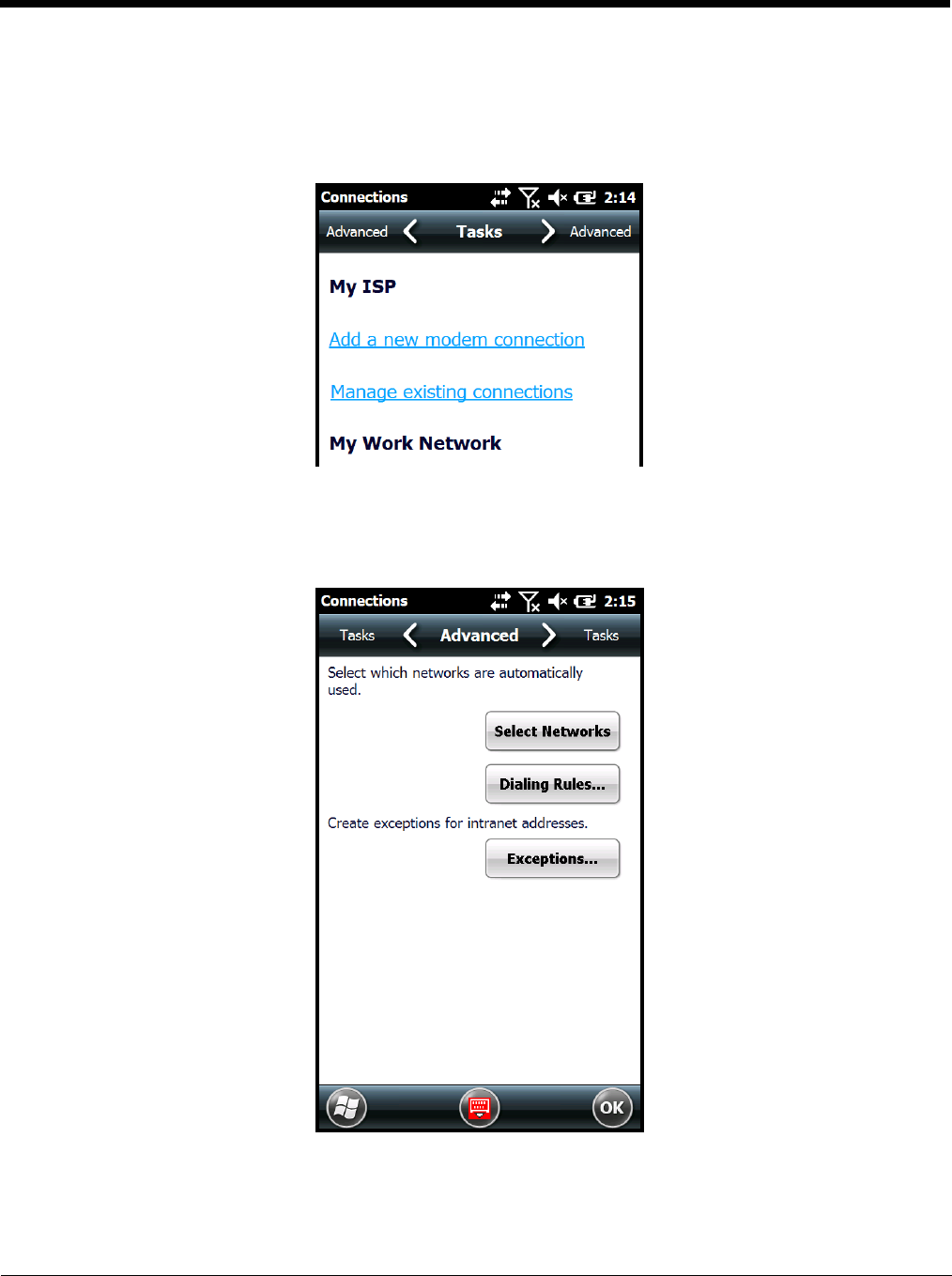
8 - 4
Modify an Existing Connection
The Manage existing connections link appears on the Connections screen under the
My ISP
heading
after at least one network connection has been established. Touch Manage Existing Connections,
then follow the setup screens to modify an existing connection.
Advanced
The Advanced screen enables you to select the default network, dialing rules, and IP address exceptions
for modem connections.
Note: You should not need to change Advanced settings because most ISPs now use DHCP addresses.
Preliminary Draft 6/19/13, Not for Release
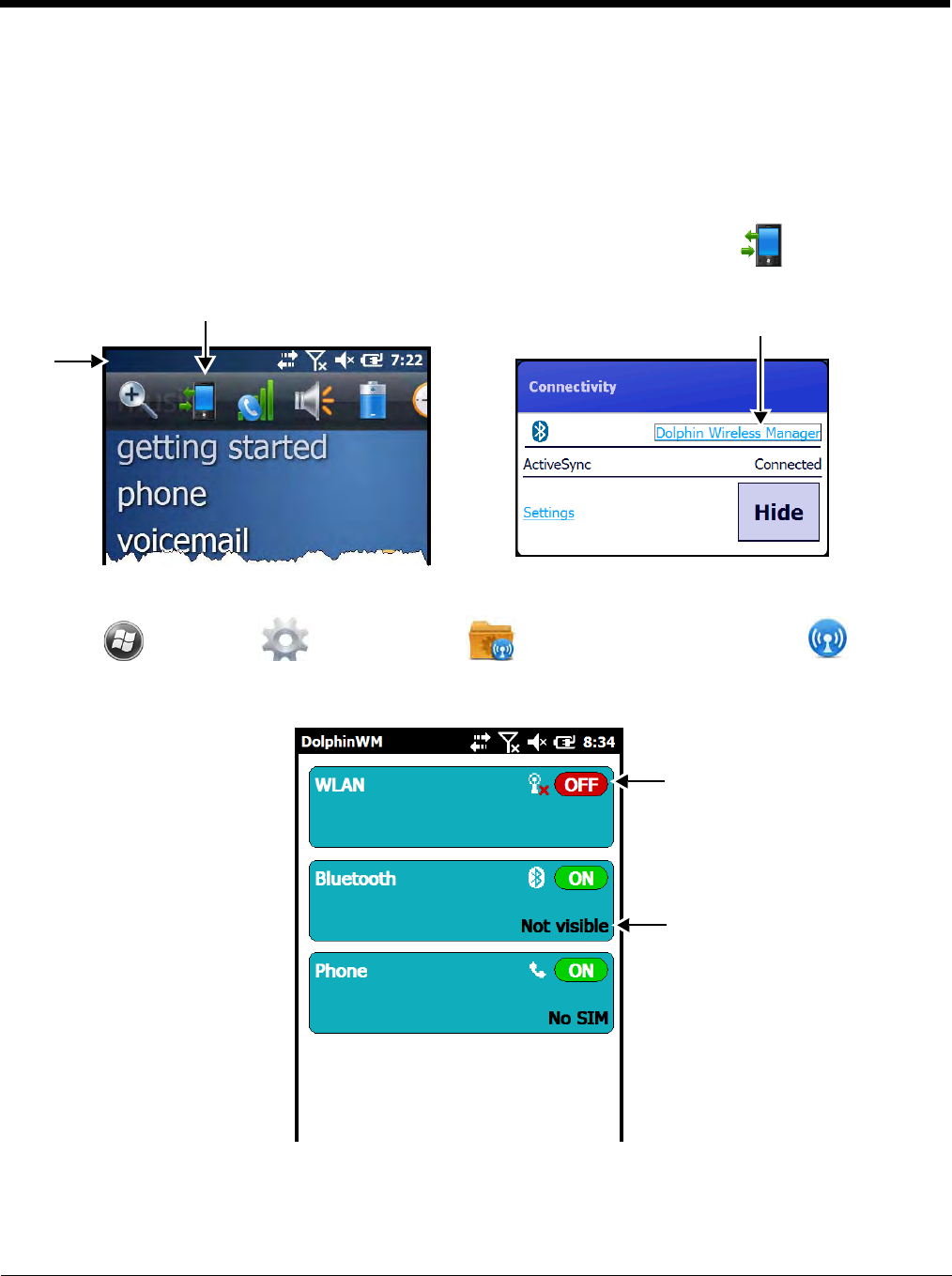
8 - 5
Dolphin Wireless Manager
The Dolphin Wireless Manager provides a centralized interface that enables and disables all the on-
board radios. Each radio has its own configuration program. The Dolphin Wireless Manager also
provides shortcuts to the configuration utilities for each radio.
To open the Dolphin Wireless Manager do one of the following:
1. Touch once on the Title bar to access the Horizontal Scroll bar, then touch .
2. Select, Dolphin Wireless Manager.
OR
1. Touch > Settings > Connections > Dolphin Wireless Manager .
Dolphin Wireless Manager Window
If applicable, information about
the radio displays when the
radio is activated.
The state of the radio is shown
in the upper right corner of the
radio box.
Preliminary Draft 6/19/13, Not for Release
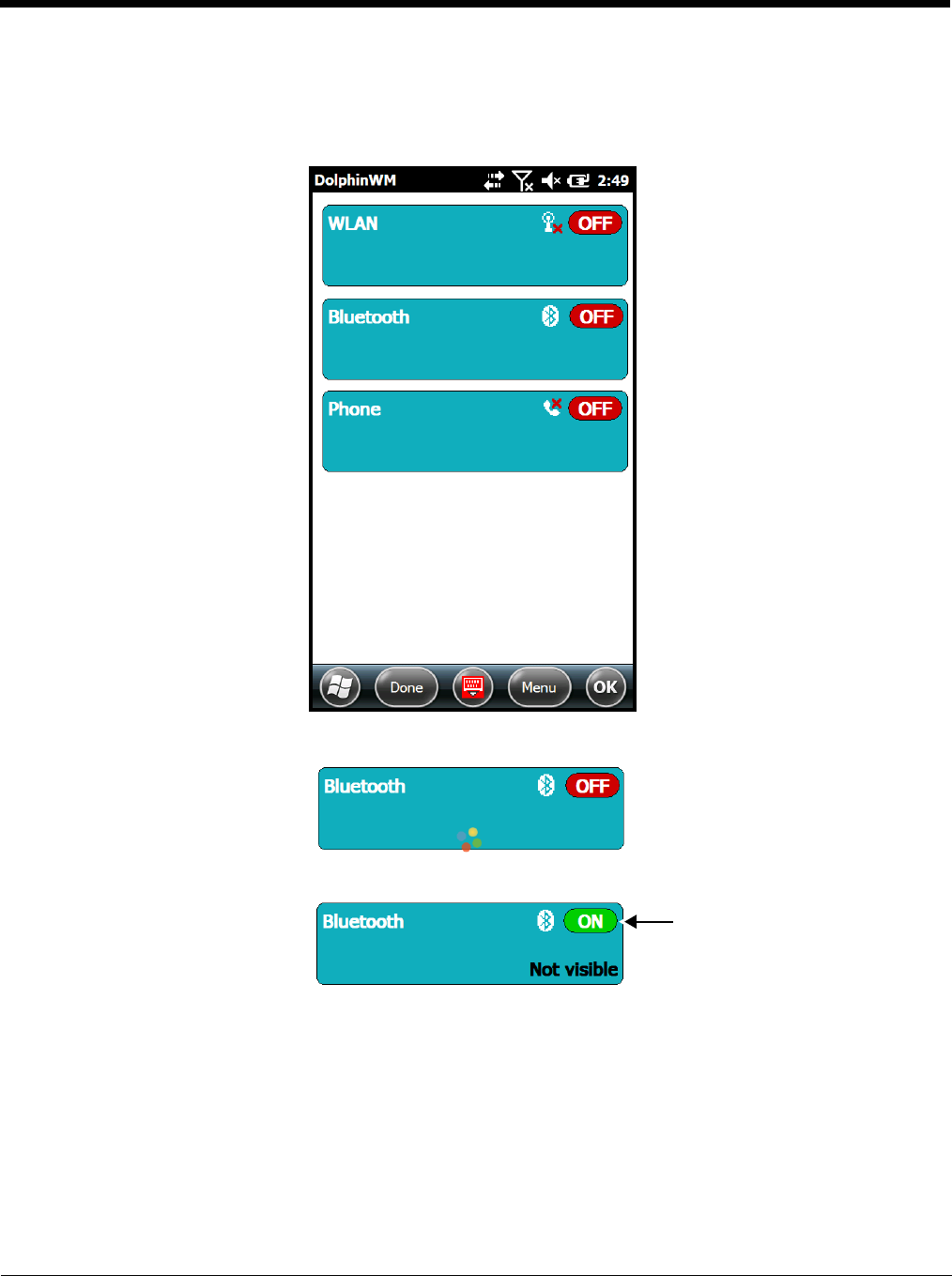
8 - 6
Enabling the Radios
1. Open the Dolphin Wireless Manager (see page 8-5).
2. Touch anywhere inside the rectangle of the radio you want to enable.
3. The radio begins activating.
4. When the radio is activated (i.e., transmitting a signal), the Off button changes to ON.
Note: If applicable, information about the radio appears in the rectangle.
Preliminary Draft 6/19/13, Not for Release
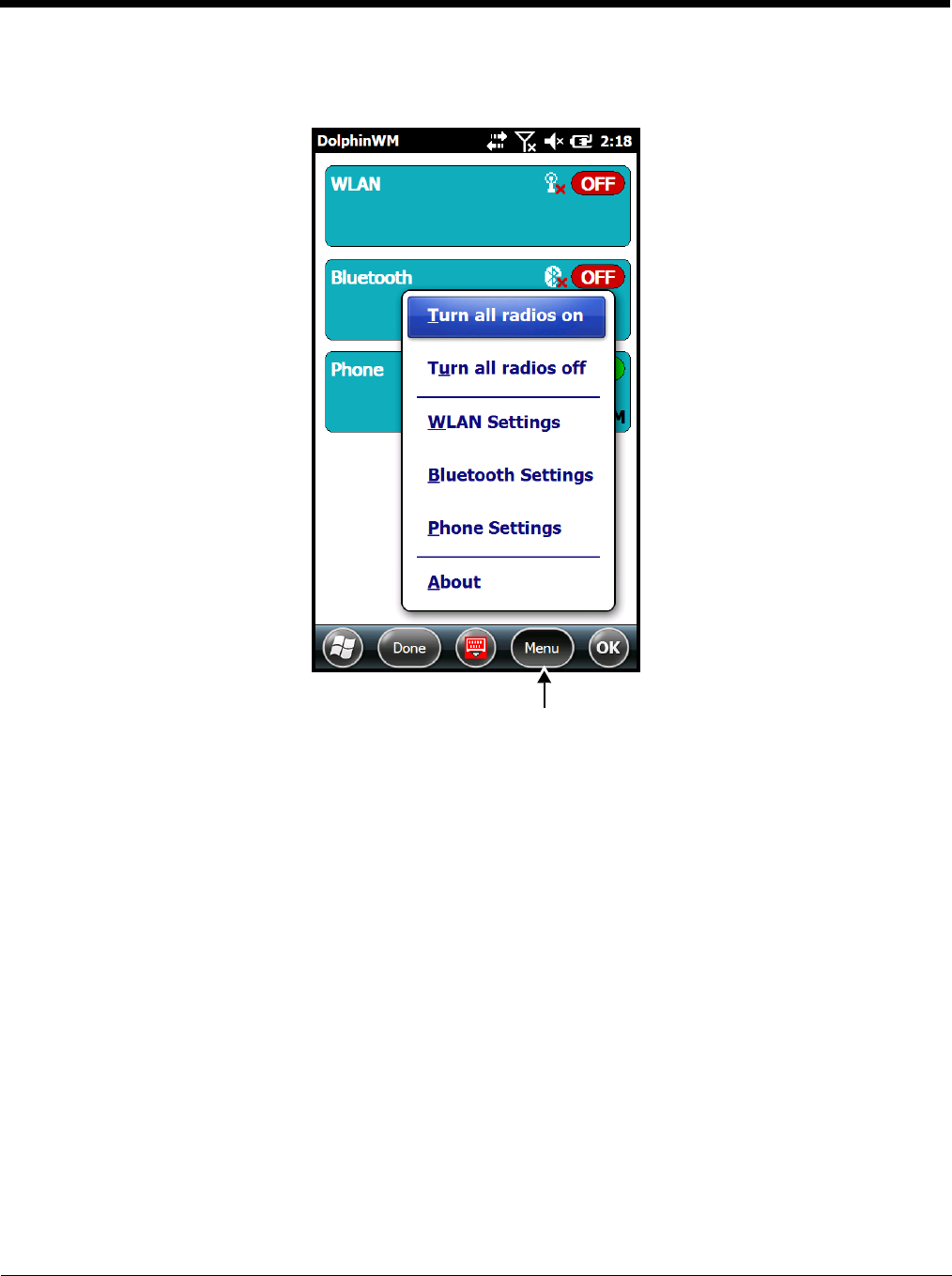
8 - 7
Accessing Radio Configuration Utilities
Each radio has its own configuration utility that you can access by touching Menu on the tile bar.
Radio Type Menu Option
802.11b/g/n Touch WLAN Settings and the Honeywell WLAN Security Supplicant
opens.
The
Honeywell WLAN Security Supplicant User’s Guide
is available for
download from at www.honeywellaidc.com.
Bluetooth Touch Bluetooth Settings and the Bluetooth Settings screen opens.
For details, see Working with the Bluetooth Radio on page 10-1.
GSM/HSDPA/UMTS/
GPRS/EDGE/CDMA Tou ch Phone Settings and the Phone opens.
For details, see Working with Wireless Wide Area Networking (WWAN) on
page 9-1.
Preliminary Draft 6/19/13, Not for Release
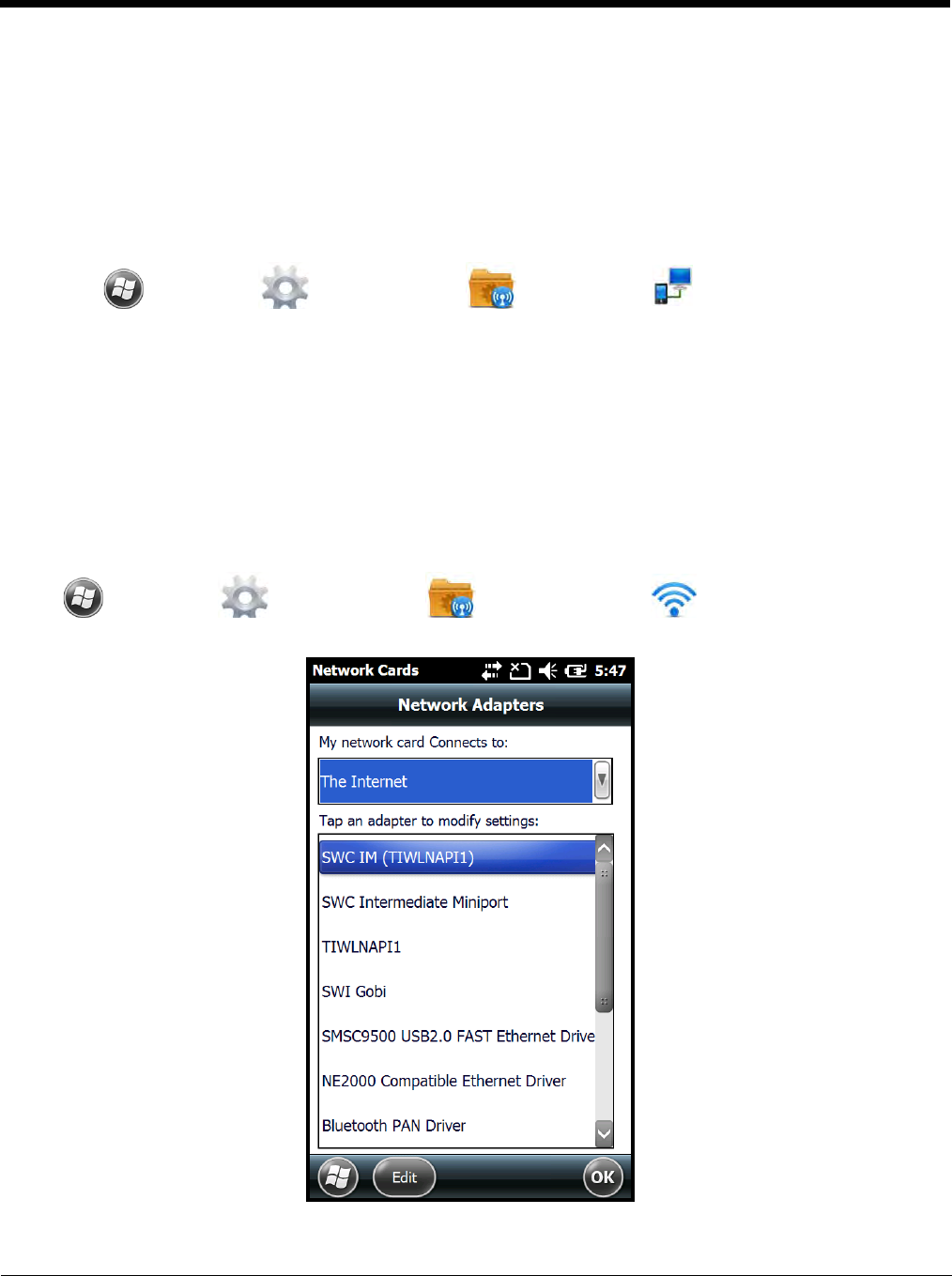
8 - 8
USB to PC
Enable advanced network functionality under the USB to PC connection settings if you are having
trouble connecting and synchronizing your terminal with a workstation PC using a wired USB connection
and ActiveSync or Windows Device Mobile Center. The advanced network functionality can also be
enable to improve transfer speeds when synchronizing large groups of data or copying large files
between the terminal and workstation. See Connecting and Synchronizing the Terminal and Workstation
on page 8-9.
1. Touch > Settings > Connections > USB to PC .
2. Check the box next to “Enable advanced network functionality”.
3. Touch OK, then attempt to sync the terminal and workstation PC.
Network Cards
The Network Adapters screen provides access to set and configure the type of Network Adapter used
by the Network card in the terminal. You can modify the adapter settings (e.g., Name Servers or IP
address) by touching on the adapter type or highlighting the adapter and touching Edit at the bottom of
the screen.
Touch > Settings > Connections > Network Cards to access the Network
Adapters screen.
Preliminary Draft 6/19/13, Not for Release

8 - 9
Connecting and Synchronizing the Terminal and Workstation
To synchronize data between the terminal and the workstation, ActiveSync (version 4.5 or higher) or
Windows Mobile Device Center (WMDC) must be installed and configured for the appropriate communi-
cation type on the host workstation (Windows-based PC) and the Dolphin terminal. Dolphin terminals
ship with ActiveSync already installed. Therefore, if ActiveSync or WMDC is already installed on the host
workstation, you just need to connect the Dolphin terminal to the host workstation (via Dolphin
peripheral) to initiate communication.
If ActiveSync (4.5 or higher) or WMDC is not installed on the host workstation, you can download and
install the most current version of the software from the Microsoft Web site
(http://go.microsoft.com/fwlink/?LinkId=147001).
Note: ActiveSync on your Dolphin terminal works with WMDC on host workstations running Windows Vista or
Windows 7 and with ActiveSync on host workstations running Windows XP. For detailed information on
ActiveSync and WMDC visit the Microsoft Windows Phone Web site.
When communicating via ActiveSync or WMDC, your terminal is designed to be connected to the host
workstation with a communication peripheral sold/manufactured by Honeywell, such as the charge/
communication cable. Use of any peripheral not sold/manufactured by Honeywell may cause damage not
covered by the warranty.
Capabilities
• Back up and restore your device data.
• Copy (rather than synchronize) files between your device and workstation.
• Control when synchronization occurs by selecting a synchronization mode. For example, you can
synchronize continually while connected to your workstation or only when you choose the synchronize
command.
• Select which information types are synchronized, controlling how much data is synchronized. For
example, you can choose how many weeks of past appointments you want synchronized.
Communication Types
The Dolphin 60s terminal supports Hi-Speed USB communication (USB 2.0) via ActiveSync through the
The I/O Connector (see page 3-10) on the back panel of the terminal and the microUSB port (see page
3-7) on the right side panel of the terminal. The maximum data transfer rate is 480 Mbps. A USB cable
and/or a Honeywell hardware peripheral (e.g., HomeBase) allow the terminal to communicate with a
workstation or to be networked through a USB hub. The Dolphin terminal defaults to USB communi-
cation out of the box.
Hardware Requirements for Setup
• HomeBase, power supply (shipped with HomeBase) and a USB cable if one is not supplied with your
Dolphin communication peripheral
OR
• The USB charge/communication cable (70e-USB) provided with your Dolphin terminal.
Software Requirements for Communication
• ActiveSync (v4.5 or higher) or Windows Mobile Device Center installed and configured on the host
workstation (PC), see Setting Up the Host Workstation on page 8-10.
Note: ActiveSync or Windows Mobile Device Center must be setup on your workstation before you initiate
synchronization from the terminal for the first time.
!
Preliminary Draft 6/19/13, Not for Release

8 - 10
• Windows 98 Second Edition, Windows Me, Windows 2000, Windows NT (4.0 SP6 or higher), Windows
XP, Windows Vista, and Windows 7 operating systems.
Setting Up the Host Workstation
To synchronize data between the terminal and the workstation, ActiveSync (v4.5 or higher) or Windows
Mobile Device Center must be configured for same communication type on both the host workstation
and the Dolphin terminal.
ActiveSync
Verify that ActiveSync is configured to use the appropriate communication type.
1. In the ActiveSync window on your workstation, select File > Connection Settings.
2. Check the box next to “Allow USB connections”.
Connecting the Dolphin Terminal to the Host Workstation
After setting up both the workstation and the terminal:
1. Connect the Dolphin terminal to the workstation using a Dolphin communication peripheral.
2. ActiveSync or Windows Mobile Device Center should open and connect automatically to the Dolphin
terminal.
Synchronizing with the Host Workstation
After setup, synchronization begins automatically whenever the terminal’s mechanical connector
connects to a Dolphin peripheral that is connected to a host workstation with ActiveSync or Windows
Mobile Device Center installed. For additional information visit the Microsoft Phone Web site
(http://go.microsoft.com/fwlink/?LinkId=147001).
Note: if you are having trouble connecting and synchronizing your terminal with a workstation PC using a wired USB
connection and ActiveSync or Windows Device Mobile Center, try enabling the advanced network
functionality setting from the USB to PC connections screen.
Exploring the Terminal from the Workstation
ActiveSync
1. Open the main ActiveSync window (on the desktop).
2. Click Explore. This opens the Mobile Device folder for the terminal in Windows Explorer.
3. The Dolphin terminal is now treated as a mass storage device, and transferring files is as simple as
dragging and dropping or copying and pasting.
Windows Mobile Device Center
1. Open Windows Mobile Device Center (on the desktop).
2. Click File Management. This opens the Mobile Device folder for the terminal.
3. The Dolphin terminal is now treated as a mass storage device, and transferring files is as simple as
dragging and dropping or copying and pasting.
Preliminary Draft 6/19/13, Not for Release

8 - 11
Installing Additional Software
Dolphin terminals ship with the operating system, radio drivers, and custom Honeywell software already
installed. These are the default programs that install when your terminal first boots up. You can install
additional software programs to the terminal provided that the following parameters are met:
• The software program was created for a Windows Embedded Handheld 6.5 device.
• The terminal has enough memory to store and run the program.
• The program has an EXE, CAB, or DLL extension.
When selecting programs, verify that the program and version of the program are designed for the
Windows Embedded Handheld 6.5 and the terminal’s processor. You can verify your processor by
touching > Settings > System > About. Make a note of the information in the Processor field on the
Version screen.
To install additional software, you can use the communication options described in this chapter.
•Adding Programs Using ActiveSync or Windows Mobile Device Center, see page 8-11.
•Adding Programs Using the Internet, see page 8-12.
Adding Programs Using ActiveSync or Windows Mobile Device Center
Generally, software for Windows Embedded Handheld devices must be installed to the host workstation
first, then transferred to the Dolphin terminal.
Note: An active Microsoft ActiveSync or Windows Mobile Device Center connection between a host workstation and
the Dolphin terminal is required to add programs. For additional information, see Connecting and
Synchronizing the Terminal and Workstation on page 8-9.
1. Download the program to the workstation from either the Internet or the install CD. You may see a
single *.exe or setup.exe file, a *.cab file, or a *.dll file.
Note: There may be several versions of files for different device types and processors. Select the file that
matches the terminal’s processor.
2. Read any installation instructions, Read Me files, or documentation that comes with the program.
Many programs provide special installation instructions.
3. Connect the terminal to the workstation via a Dolphin communication peripheral.
If the File is an Installer (*.exe or *.setup.exe)
An installer program is one that installs on the workstation and the terminal simultaneously; one process
installs to both devices.
1. On the workstation, double-click the *.exe or setup.exe file. The installation wizard begins.
2. Follow the directions on the workstation screen. The installation process includes transferring the
software to the Dolphin terminal.
If the File is Not an Installer
Some programs cannot be installed on PCs because they are designed exclusively for Windows
Embedded Handheld devices. In these cases, the appropriate files must be stored on the host
workstation and transferred to the terminal via ActiveSync Explore or Windows Device Mobile File
Management.
Note: You know that the program is not an installer because an error message stating that the program is valid but
designed for a different type of computer appears when you try to install the program on the workstation.
Preliminary Draft 6/19/13, Not for Release

8 - 12
1. If you cannot find any installation instructions for the program in the Read Me file or documentation
provided with the software, do one of the following:
a. Open ActiveSync and click Explore, or
b. Open Windows Mobile Device Center and click File Management
2. On the workstation, navigate to the folder containing the program file(s).
3. Copy and paste the file(s) into the Program Files folder on the Dolphin terminal.
Note: If you want the program to be part of the Autoinstall that occurs after a factory reset or software upgrade,
paste the program file(s) in both the
\IPSM\Honeywell\Autoinstall
folder and the
\Honeywell\Autoinstall
.
4. On the terminal from the Start screen, touch File Explorer, navigate to the folder where the
program is located.
5. Touch on the program file to start the installation.
Note: If you copied the file to the
\Honeywell\Autoinstall
folder, you can perform a Soft Reset
to install the program. For more information, see Hardware Maintenance on page 3-16.
Connecting the Terminal to a Wireless Network
You connect the terminal to a wireless network through the on-board radio (802.11b/g/n, Bluetooth, and/
or GSM/CDMA). Each radio has its own configuration utility and requires specific information about the
wireless network to connect. Successful connection depends on your network infrastructure about which
you will need specific information from your network administrator.
WLAN (802.11b/g/n)
The Dolphin 60s has a 2.4 GHz 802.11b/g/n WLAN (Wireless Local Area Network) radio. The radio is
interoperable with other 802.11b/g/n, Wi-Fi compliant products including access points (APs), worksta-
tions via PC card adapters, and other wireless portable devices. By default, the 802.11b/g/n radio is
enabled after each factory reset. The next step is to configure the connection parameters of the radio to
connect to a wireless network.
WLAN Radio
The WLAN radio is configured in the Honeywell WLAN Security Supplicant, which you access by
touching the WLAN SWC icon on the Start menu. For complete configuration instructions, download the
Honeywell Secure Wireless Client (SWC) User’s Guide
from www.honeywellaidc.com. A link to this
guide appears on the Dolphin 60s product page.
Adding Programs Using the Internet
When you have established a network connection, you can access the Internet and download additional
software programs.
Note: When selecting programs, verify that the program and version of the program are designed for Windows
Embedded Handheld and the terminal’s processor. You can verify your processor by touching
> Settings > System > About > Version
. Make a note of the information in the Processor field.
1. Open Internet Explorer and navigate to the program’s location. You may see a single *.exe or
setup.exe file, or several versions of files for different device types and processors.
Preliminary Draft 6/19/13, Not for Release
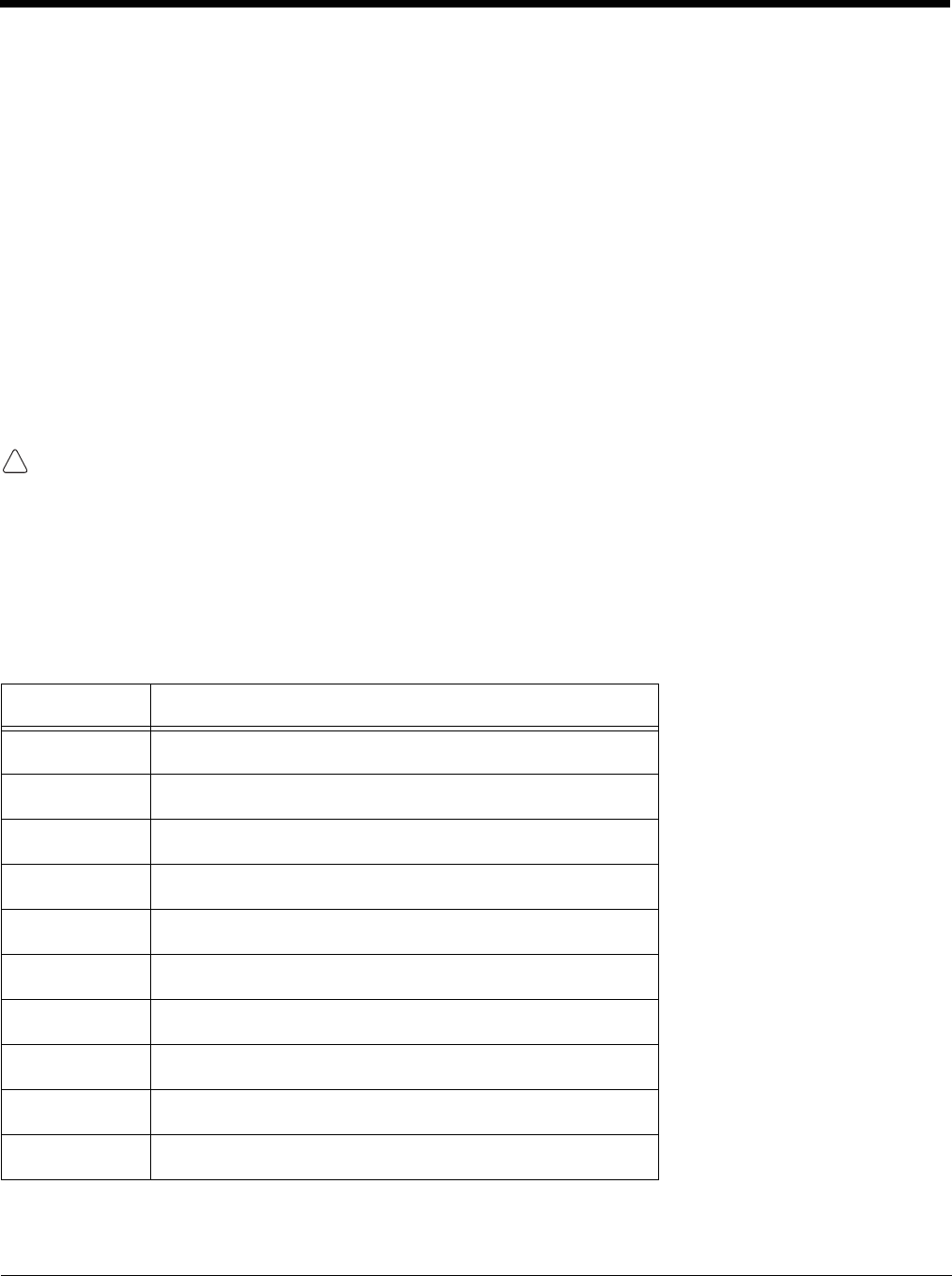
8 - 13
2. Select the program version that matches your Dolphin terminal and processor.
3. Read any installation instructions, Read Me files, or documentation that comes with the program.
Many programs provide special installation instructions.
4. Download the program to the terminal directly from the Internet. You would normally store the
program in the \Program Files folder unless another location is required by the program.
5. On the terminal, touch the installer file: e.g., *.exe or setup.exe file.
6. The installation wizard for the program begins.
7. Follow the directions on the screen to complete the installation.
Software Upgrades
Contact a Honeywell technical support representative for information on available software upgrades for
your Dolphin terminal, see Customer Support on page 14-1. or go to www.honeywellaidc.com.
To prevent data loss, back up all user data to a microSD card or external memory device before
performing an upgrade.
Note: An active Microsoft ActiveSync or Windows Mobile Device Center connection between a host workstation and
the Dolphin terminal may be required for some types of software upgrades. For additional information, see
Connecting and Synchronizing the Terminal and Workstation on page 8-9.
For information on File Provisioning on the Dolphin 60s, see page 2-11.
Dolphin 60s COM Port Assignment Table
COM Port Description
COM0 Bluetooth Serial Port Service
COM1 USB Host - Dock - Switched
COM2 Bluetooth
COM3 Unused
COM4 Bluetooth Serial Port Service
COM5 Unused
COM6 Unused
COM7 GPS: COM Port for the GPS receiver
COM8 USB Serial: Virtual USB Serial port for ActiveSync
COM9 Bluetooth BTHATCI server
!
Preliminary Draft 6/19/13, Not for Release

8 - 14
Preliminary Draft 6/19/13, Not for Release

9 - 1
9
Working with Wireless Wide Area Networking (WWAN)
Overview
The Dolphin 60s has two radio options for WWAN connectivity:
• a muli-mode WWAN radio, which provides support for three band UMTS/HSPA+ (3G) 850/1900/
2100 MHz, quad band GSM/GPRS/EDGE (2G/2.5G) 850/900/1800/1900 MHz, and dual band
EV-DO/CDMA 800/1900 Mhz, or
• a GSM WWAN radio, which provides support for two-band UMTS/HSPA+ (3G) 900/2100 Mhz
and quad-band GSM/GPRS/EDGE (2G/2.5G) 850/900/1800/1900 MHz.
Both radio options support voice and data communication.
Requirements
Using GSM/HSPA+/UMTS/GPRS/EDGE requires:
• a network subscription to a GSM/HSPA+/UMTS/GPRS/EDGE network (you need to know what service
providers are in your geographic area), and
• an installed SIM card that has been activated by the network service provider (see Installing a SIM Card
and/or Memory Card on page 3-16).
Using CDMA requires:
• an active account with a CDMA carrier. The account is linked to the Mobile Equipment Identifier (MEID)
of the integrated WWAN radio.
Antenna Band
The WWAN radio features an internal antenna that is optimized for power output and receiver sensitivity.
This is an omni-directional antenna.
For terminals with the multi mode WWAN radio, there is a penta band antenna that supports 850, 1900,
2100 Mhz (UMTS/HSPA), 850/900/1800/1900 Mhz (GSM/GPRS/EDGE) and 800/1900 Mhz (EV-DO/
CDMA).
For terminals with the GSM WWAN radio, there is a slightly different penta band antenna that supports
900, 2100 Mhz (UMTS/HSPA) and 850/900/1800/1900 Mhz (GSM/GPRS/EDGE).
GSM Short for Global System for Mobile communications, GSM is an open, non-proprietary wireless
WAN system that is constantly evolving and growing.
HSPA+ Short for High-Speed Download Packet Access, HSPA+ is a non-voice value added service that
allows packet-switched data to be instantly sent and received across mobile telephone networks.
UMTS Short for Universal Mobile Telecommunications System, UMTS is a non-voice value added service
that allows packet-switched data to be instantly sent and received across mobile telephone
networks.
GPRS Short for General Packet Radio Service, GPRS is a non-voice value added service that allows
packet-switched data to be instantly sent and received across mobile telephone networks.
EDGE E-GPRS is a non-voice value added service that allows packet-switched data to be instantly sent
and received across mobile telephone networks at a higher data rate than standard GPRS.
CDMA Short for Code Division Multiple Access.
1xRTT Short for Single-Carrier Radio Transmission Technology.
EVDO Short for Evolution-Data Optimized.
Preliminary Draft 6/19/13, Not for Release

9 - 2
Signal Strength
On terminals equipped with a WWAN (voice + data) radio, the signal strength of the WWAN connection
is indicated by the number of bars that appear in the signal strength icon in the Title bar at the top of the
window.
Voice and Data Communication
Dolphin terminals with integrated GSM/HSPA+/UMTS/GPRS/EDGE (voice + data) radios are optimized
for the following two-way communications:
Voice: GSM voice data (dial-up)
Data: Available speed depends on the wireless network carrier and their supported packet-data
technology in addition to network conditions.
GPRS Class 10: data transmission max. 85.6 kbps (DL), max. 42.8 kbps (UL)
HSPA+: data transmission max. 14.4 Mbps (DL), max. 5.76Mbps (UL)
UMTS: data transmission max. 384 kbps (DL), max 384 kbps (UL)
EDGE (E-GPRS) Class 10: data transmission max. 237 kbps (DL), max. 118 kbps (UL)
Note: You can use the GSM radio for simultaneous voice and data communication on a UMTS (3G) network only.
On a GSM network, if you want to communicate over the phone (voice), you cannot send data. If you want to
send data, you cannot use the phone.
Icon Indicates…
The signal strength of the radio connection.
The signal strength of the phone (voice) connection.
The signal strength of the data connection.
Preliminary Draft 6/19/13, Not for Release
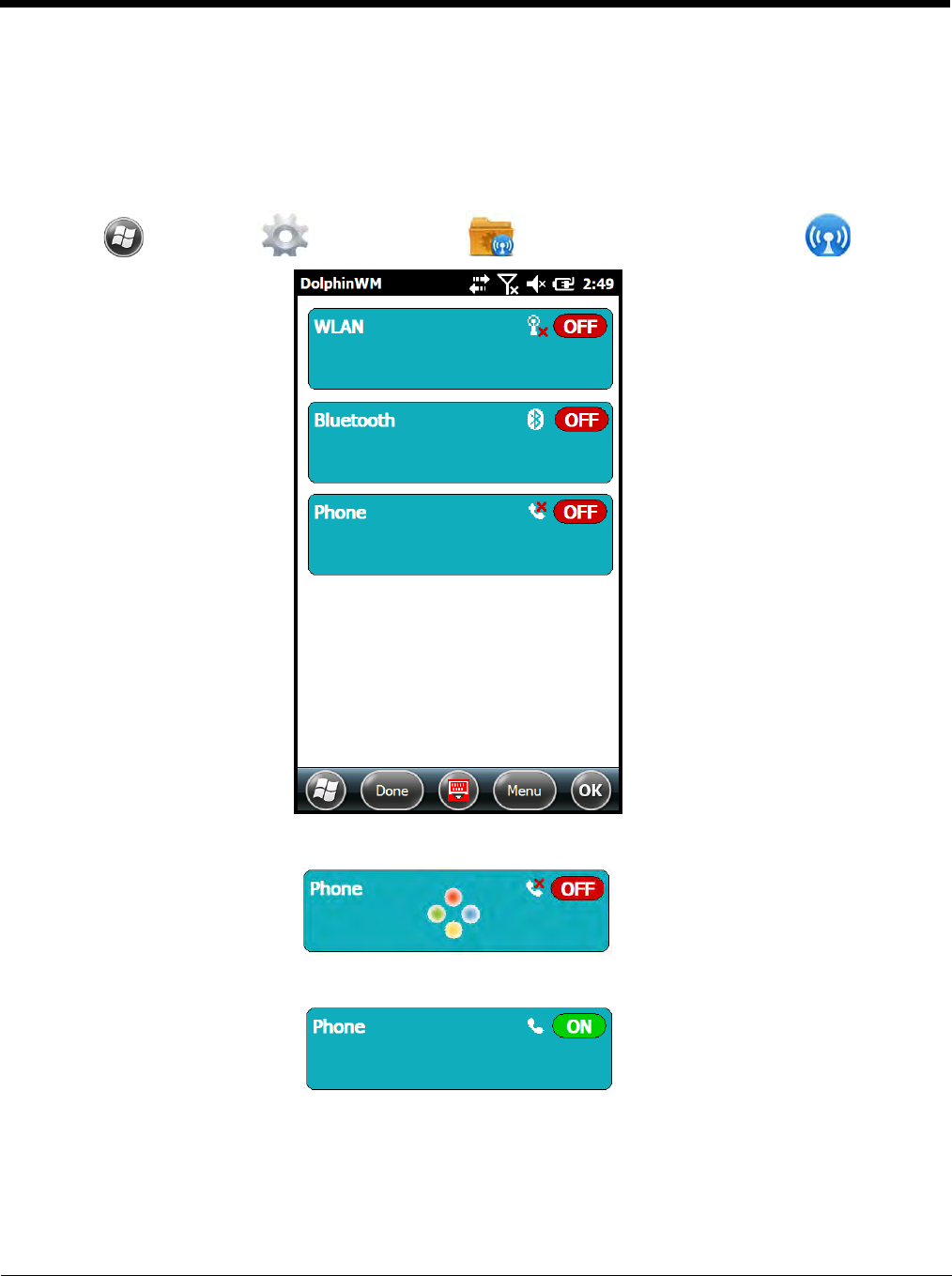
9 - 3
Enabling the WWAN Radio
You can enable or disable the WWAN radio in the Dolphin Wireless Manager (see page 8-5).
Note: By default, the WWAN radio is enabled after a factory reset.
To enable the WWAN radio:
1. Touch > Settings > Connections > Dolphin Wireless Manager .
2. Touch anywhere inside the Phone rectangle and WWAN radio begins activating.
3. When the radio is activated (i.e., transmitting a signal), the Off button changes to On.
Preliminary Draft 6/19/13, Not for Release

9 - 4
Audio Modes
The Dolphin 60s terminal is equipped with speakers on the front and back of the terminal and a micro-
phone that you can use to send and receive audio signals over the GSM network, see Features of the
Dolphin 60s on page 3-4.
There are three audio modes:
•Handset Mode - The front speaker is used for receiving handset voice calls.
•Headset Mode - When a headset is plugged into the Audio Jack, the terminal defaults to the
headset for receiving calls and audio input.
•Hands-Free Mode - The back speakers are used a speaker phone. To switch to speaker phone
during a call, touch on the phone icon in the tile bar at the bottom of the screen, then select
Speaker On.
Volume Control
Press the up or down arrow on the Volume Control button on the left side of the device to adjust the
volume of the active speaker, see Volume Control Button on page 3-9.
Voice Communication
Accessing the Dialer Window
Note: The WWAN radio must be active for voice communication, see Enabling the WWAN Radio on page 9-3.
To open the Phone dialer do one of the following:
• From the Home screen, touch twice on “phone”.
• From the Home screen, touch > Phone .
•Press the Send button .
Preliminary Draft 6/19/13, Not for Release
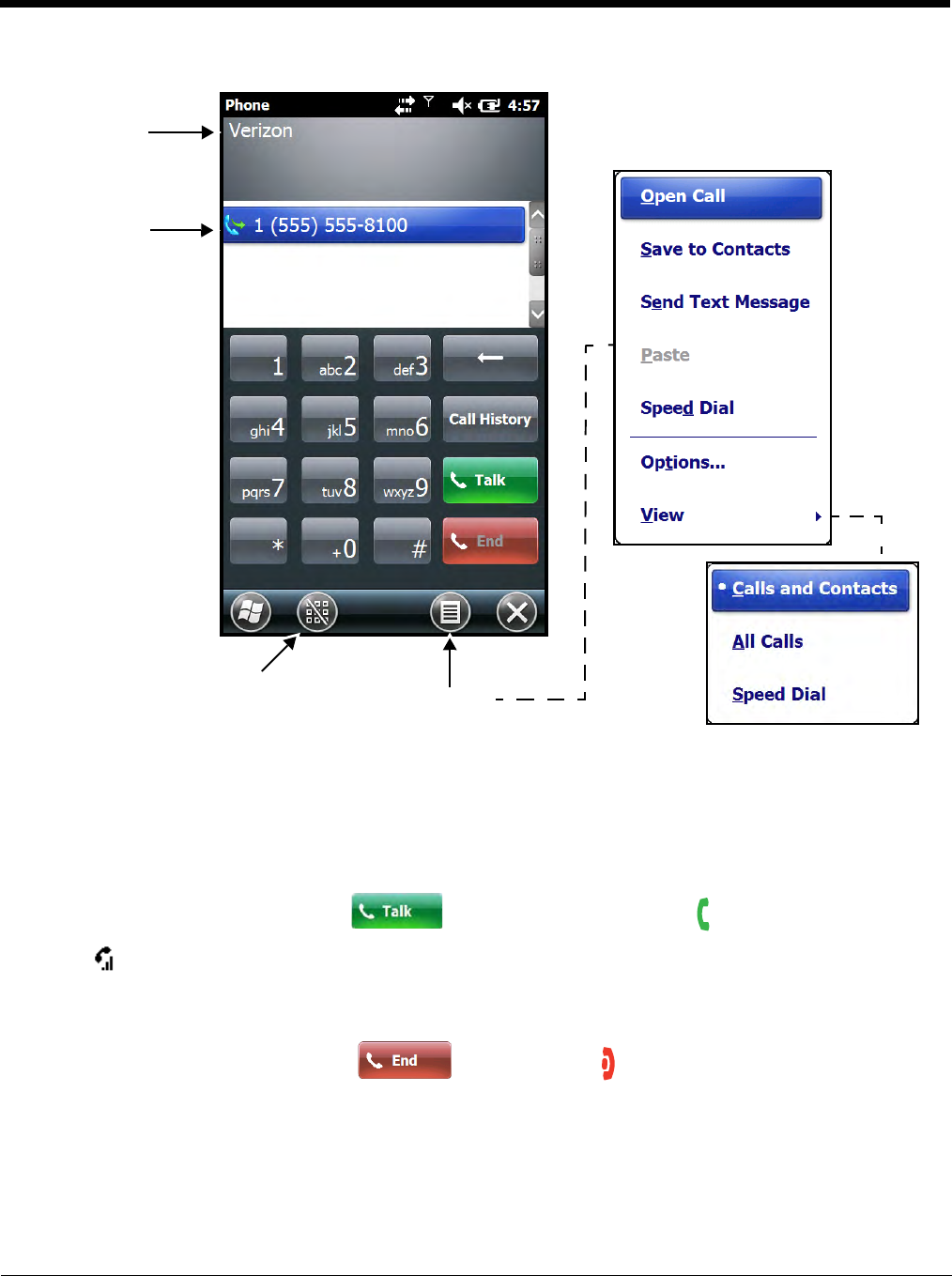
9 - 5
Dialing
Touch the buttons on the dialer window.
Sending Calls
After the number is dialed, touch Talk or press the Send button .
Note: The icon indicates that the phone is in use.
Ending Calls
While the phone call is live, touch End or End button .
Accessing Voice Mail
From the Home screen, touch twice on “voicemail”.
Note: Update the voice mail retrieval number by turning the phone Off and then On via the Dolphin Wireless
Manager, see Enabling the WWAN Radio on page 9-3.
Displays the
network carrier
from the SIM card.
Displays the
most recent
calls.
Toggles the touch screen
keypad On or Off. Menu
Preliminary Draft 6/19/13, Not for Release
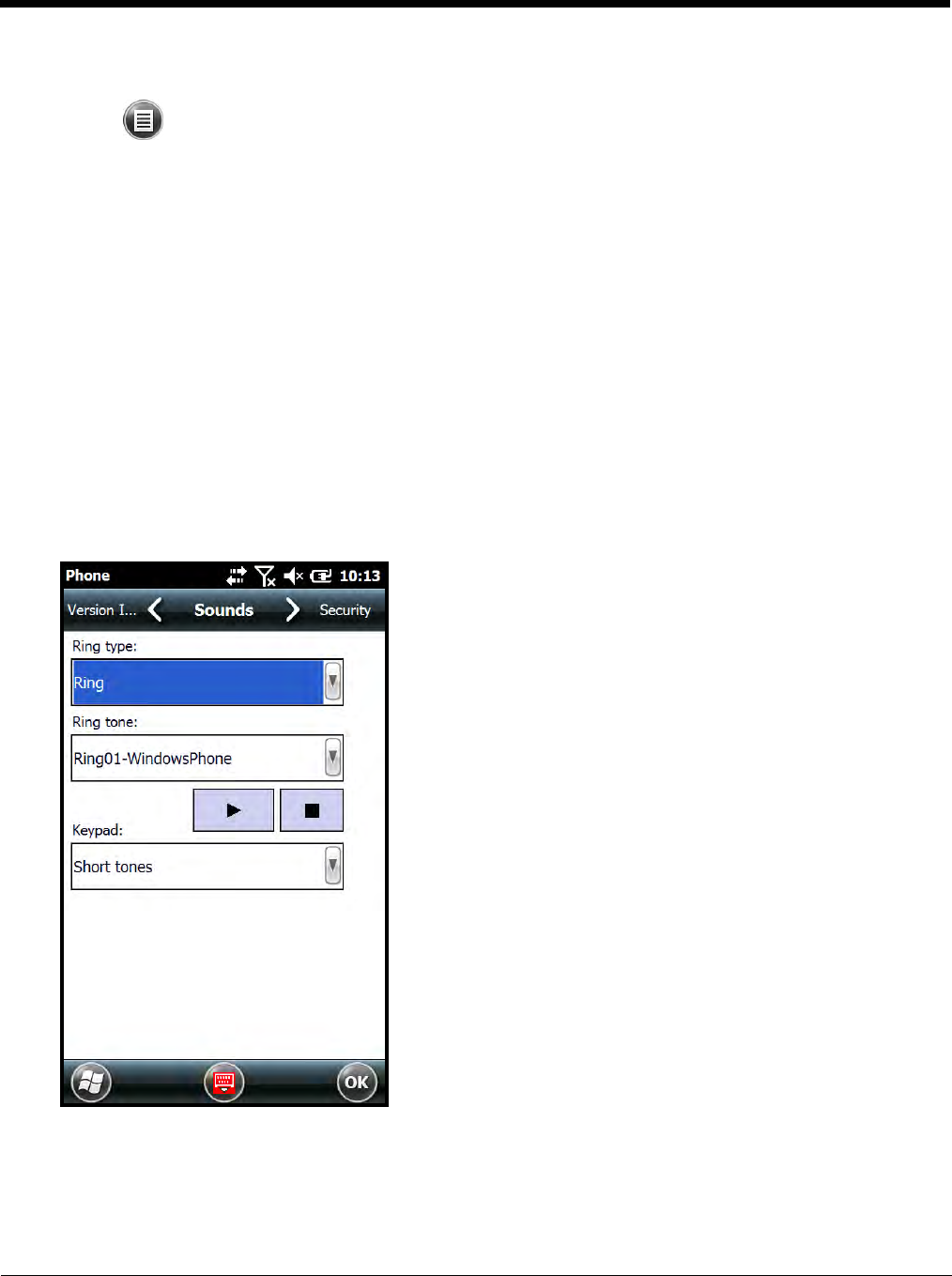
9 - 6
Customizing the Phone
Tou ch Menu from the Dialer screen to customize options for your phone.
View
Select View on the Menu to modify the display screen to show Calls and Contacts, All Calls or Speed
Dial numbers.
Options
Select Options on the Menu to customize and view features specific to the network firmware the
terminal is configured to use (e.g., GSM/UMTS or CDMA) for voice and data communication. See
Dolphin Connection Manager (page 9-12) for information on Network firmware configuration.
GSM/UMTS Options
When the WWAN radio is configured to communicate with GSM/UMTS networks, the Options menu
contains four setting widows: Sounds, Security, Services, and Network. For information on CDMA
Options, see page 9-8.
Sounds
The Sounds screen enables you to customize the:
• Ring type (e.g., Ring, Increasing ring, Ring once,
Vibrate, Vibrate and ring, Vibrate then ring or None)
• Ring tone
• Keypad tone (e.g., Long, Short, or Off)
Preliminary Draft 6/19/13, Not for Release
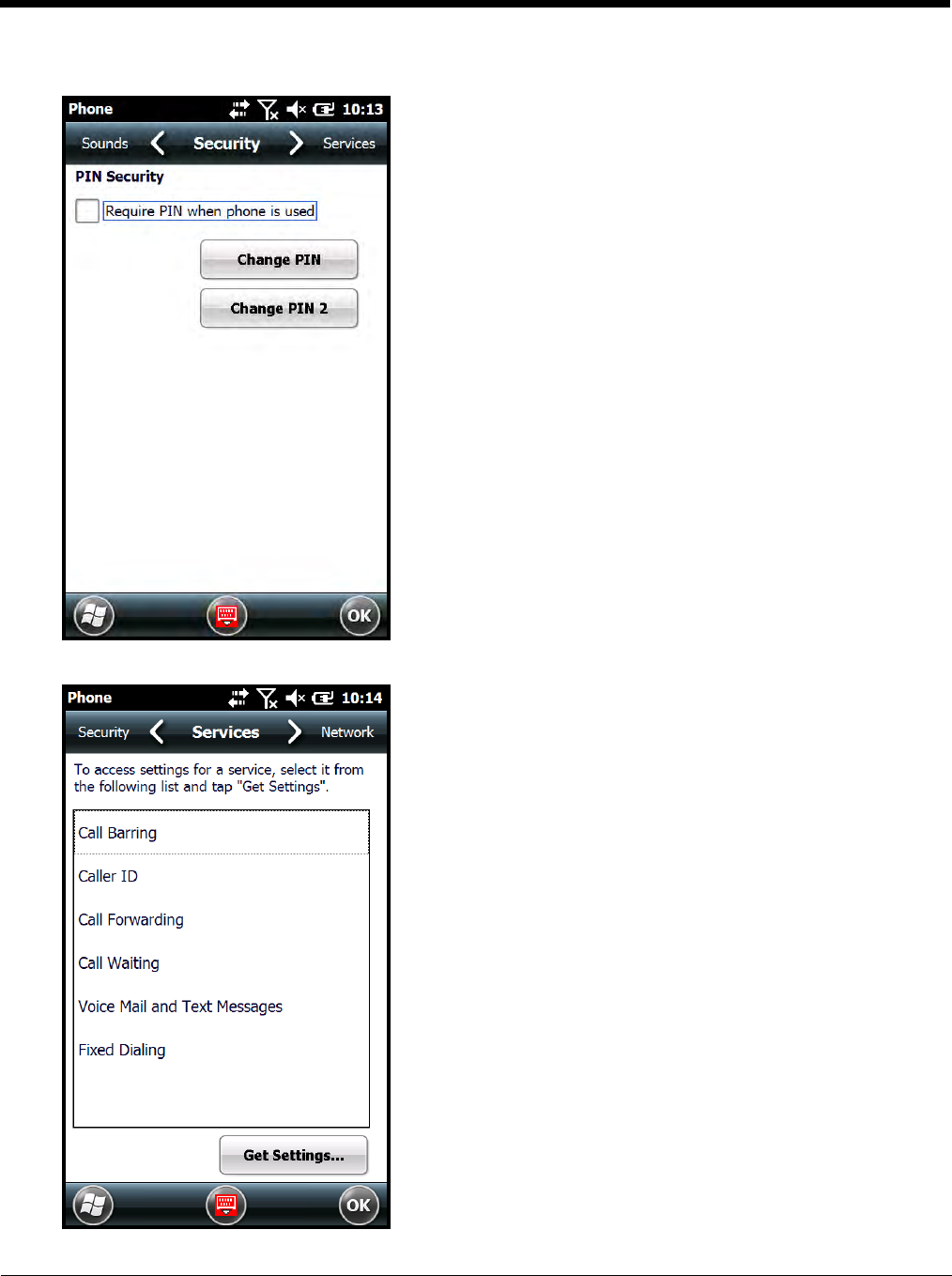
9 - 7
Security
The Security screen provides access to establish or
change your security PIN for phone calls. Check the
box next to, “Require a PIN when the phone is used”
to enable the PIN security feature.
Services
For each service, the phone reads settings from the
network stored on the SIM card and then displays the
available options from the carrier on the screen. To
customize the settings, select it from the list and
touch “Get Settings”.
Preliminary Draft 6/19/13, Not for Release
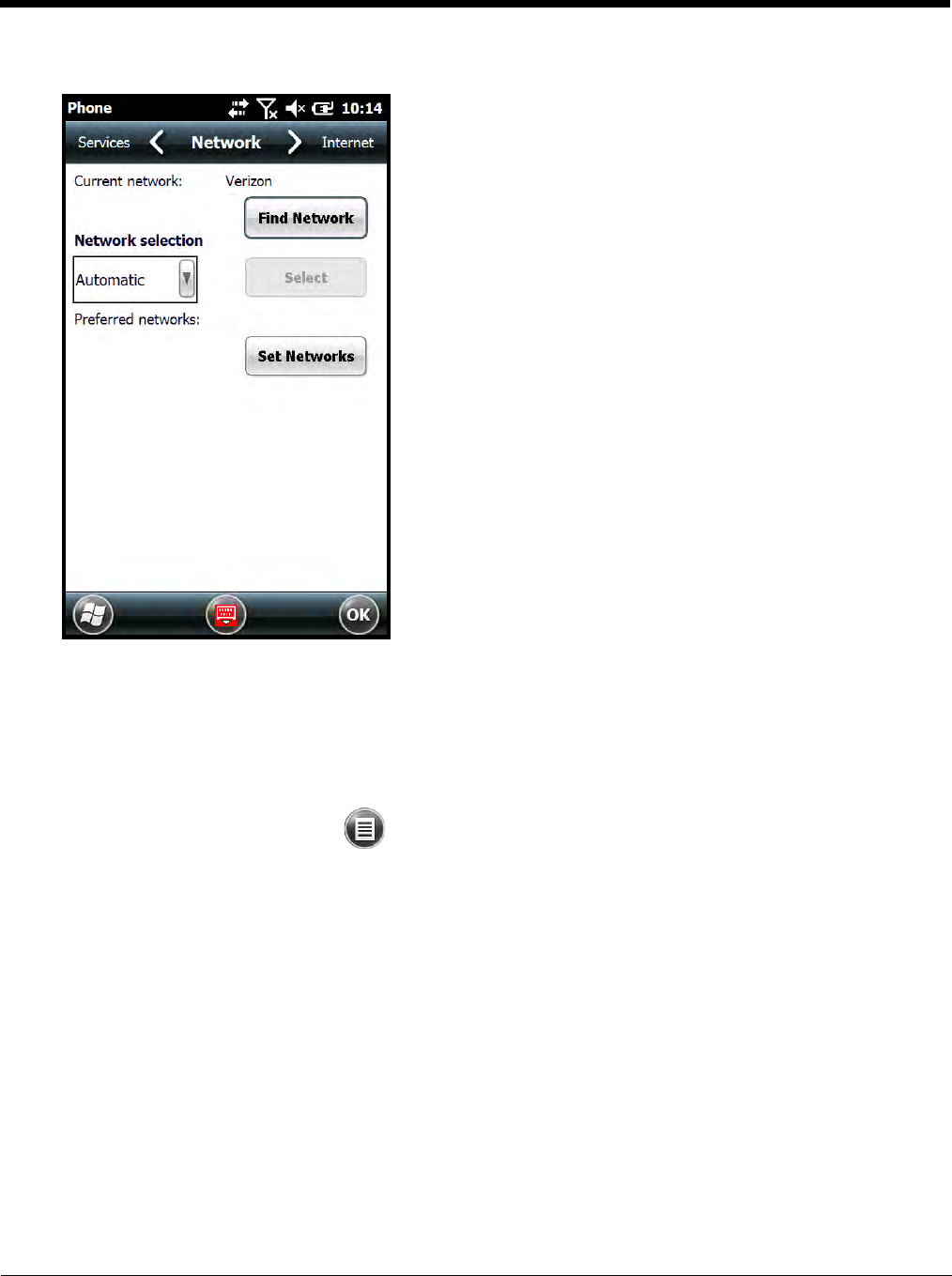
9 - 8
CDMA Options
When the WWAN radio is configured to communicate with CDMA networks, the Options menu contains
three or four setting widows depending on your network firmware configuration: Sounds, Location
Settings, Data Settings (Sprint® specific), and Version Information. See Dolphin Connection
Manager (page 9-12) for information on Network firmware configuration.
From the Dialer window, touch Menu > Options.
Sounds
The Sounds screen enables you to customize the:
• The Voicemail phone number used by the carrier
• Ring type (e.g., Ring, Increasing ring, Ring once, Vibrate, Vibrate and ring, Vibrate then ring or
None)
• Ring tone
• Keypad tone (e.g., Long, Short, or Off)
Location Settings
Selecting the radio button next to “Location ON” enables the network to detect the physical location of
the Dolphin terminal, which improves ease of use for some carrier specific applications.
Selecting the radio button next to “911 Only” turns the location feature off hiding the physical location of
the terminal from everyone except 911.
Note: Even if location is turned on in this handset no service may use your location without your express permission.
Network
You can find, select, and set your preferred network
order from the Network screen.
Preliminary Draft 6/19/13, Not for Release

9 - 9
Data Settings
The Data Settings screen is available only if the terminal is configured Sprint network communication.
Touch the “Provision” button, to initiate an auto-update of your Sprint Vision profile.PC5 Vision.
Version Information
The Version Information screen displays useful statistics for the CDMA WWAN Voice module including:
• RIL, SDK, USB, and OEM Aux Versions
• Modern HW, FW, and PRL Versions
• Boot Loader Version
• ESN number
• MEID number
Data Communication
You set up data communication using the Microsoft Connections application.
Touch >Settings > Connections > Connections to access the Microsoft
Connections application.
System Requirements
• The WWAN radio must be enabled; see Enabling the WWAN Radio on page 9-3.
• If the terminal is configured for GSM/UTMS network communication, you must have an active SIM card
with a DATA plan installed; see Installing a SIM Card and/or Memory Card on page 3-16. The carrier
on the SIM card is the ISP.
• If the terminal is configured for CDMA network communication, you must have an active account with
a CDMA carrier that includes a DATA plan. The account is linked to the Mobile Equipment Identifier
(MEID) of the integrated WWAN radio.
Information Requirements
You must have from the SIM card carrier:
• The APN (access point name).
• The user name and password of the account.
You must have from the CDMA carrier:
• The carrier account access phone number.
• The user name and password of the account.
Establishing Data Communication
1. Touch >Settings > Connections > Connections .
2. Under My ISP, touch Add a new modem connection.
Preliminary Draft 6/19/13, Not for Release
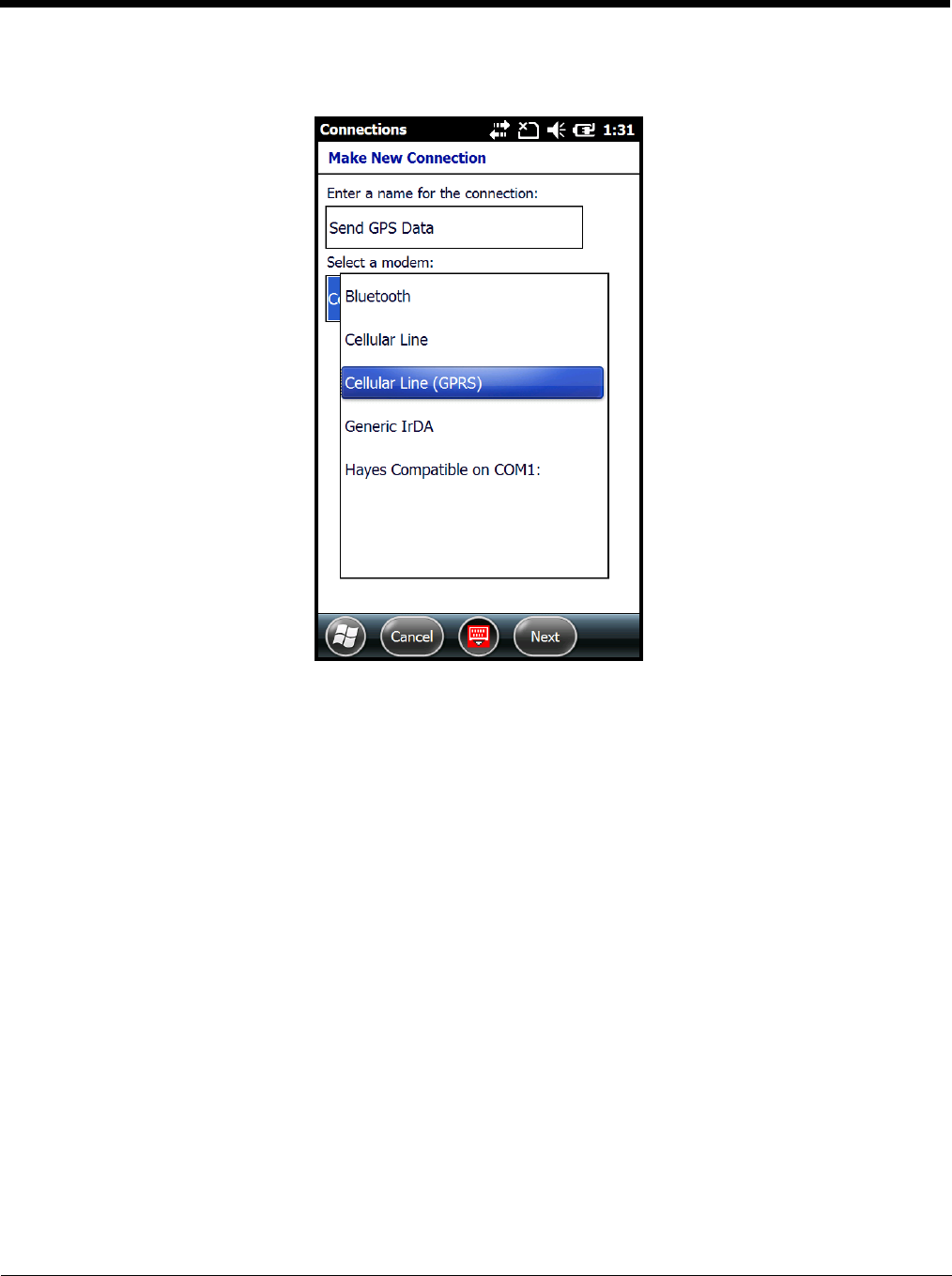
9 - 10
3. Enter a name for the connection in the “Enter a name for the connection” box. Select Cellular Line
(GPRS) from the drop-down list in the “Select a modem” box. Touch Next.
4. For GSM/UMTS terminal network configuration, enter the APN in the “Access point name” box.
For CDMA terminal network configuration, enter the number exactly as it should be dialed. Including
any extra numbers, such as an outside line or credit card.
5. Touch Next.
6. Enter the user name and password from the account. Enter a Domain if provided by the ISP or
network administrator.
Note: Touch the Advanced button to access advanced TCP/IP or Server settings screens.
7. Touch Finish.
8. The connection you just created should appear in the list on the Modem screen under My ISP >
Manage existing connections.
Preliminary Draft 6/19/13, Not for Release
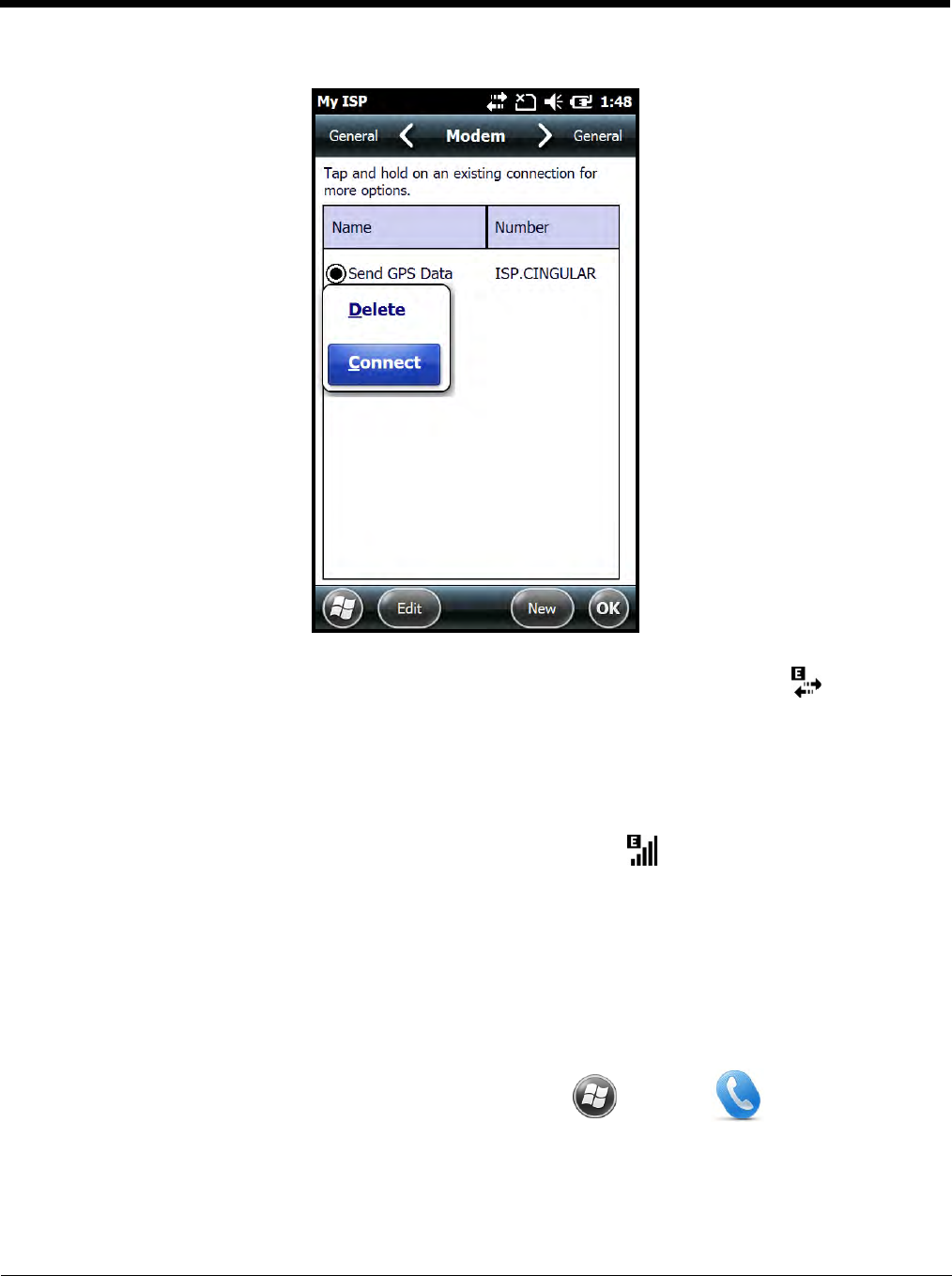
9 - 11
9. Touch and hold on the connection name. Select Connect on the popup menu.
10. The network icon in the Title bar indicates the GSM radio is attempting to connect .
Note: When the device is on a 2G (EDGE/GPRS) network, a data connection failure occurs if the phone is in
use for a voice call while attempting a data connection. Simultaneous voice and data use is only
supported if the device is on a 3G network. In 2G mode, a voice call takes precedence over data
connections. Active data connections are placed in "park" mode automatically and the data is "retrieved"
when the voice call ends.
11. When the connection is complete, the network icon changes to: .
12. You can now send data over GSM.
Manual Network Selection (GSM/UTMS)
You can select Automatic or Manual network selection. The Phone defaults to Automatic network
selection.
Note: Manual Network Selection is not applicable for CDMA network communication.
1. When an active SIM card is inserted in the terminal, touch > Phone > Menu > Options.
2. Select the Network on the Horizontal Scroll bar.
Preliminary Draft 6/19/13, Not for Release
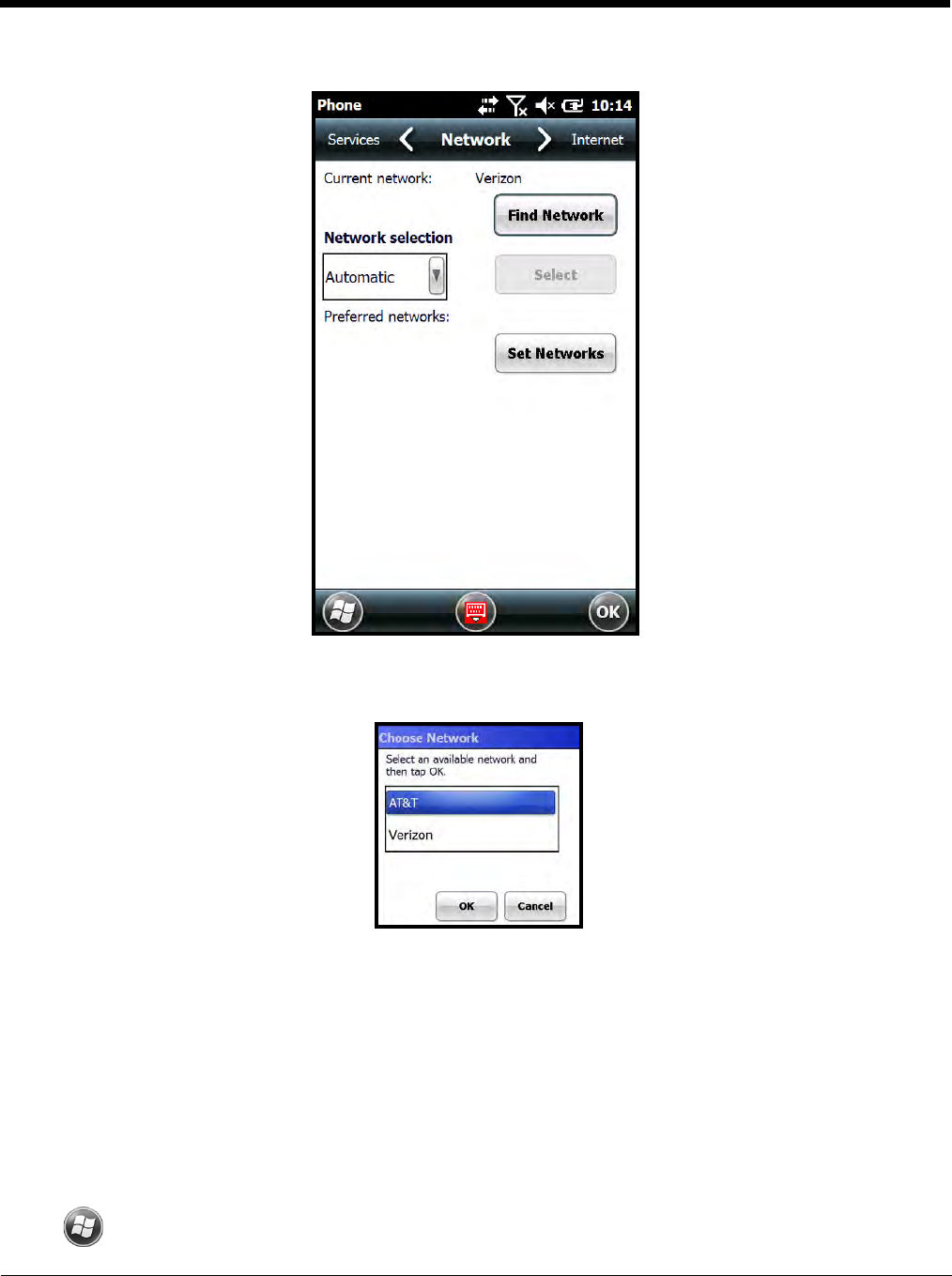
9 - 12
3. Under Network selection, select Automatic (the default selection) or Manual.
a. If you select Manual, the Phone searches for available networks.
b. Select a new network and touch OK.
c. The Phone registers on the new network and the Network screen appears.
d. To switch to another network, touch the now active Select button to repeat the process.
4. To switch back to automatic roaming, select Automatic under Select networks, then touch OK.
Dolphin Connection Manager
The Dolphin Connection Manager (DolphinCM) enables you to see real time status of the radio, setup
your Network selection, view you’re profile and scan for networks. The DolphinCM contains four tabs:
Status, Setup, Profile, Hyper Roaming and About.
Touch > DolphinCM to access the Dolphin Connection Manager.
Preliminary Draft 6/19/13, Not for Release
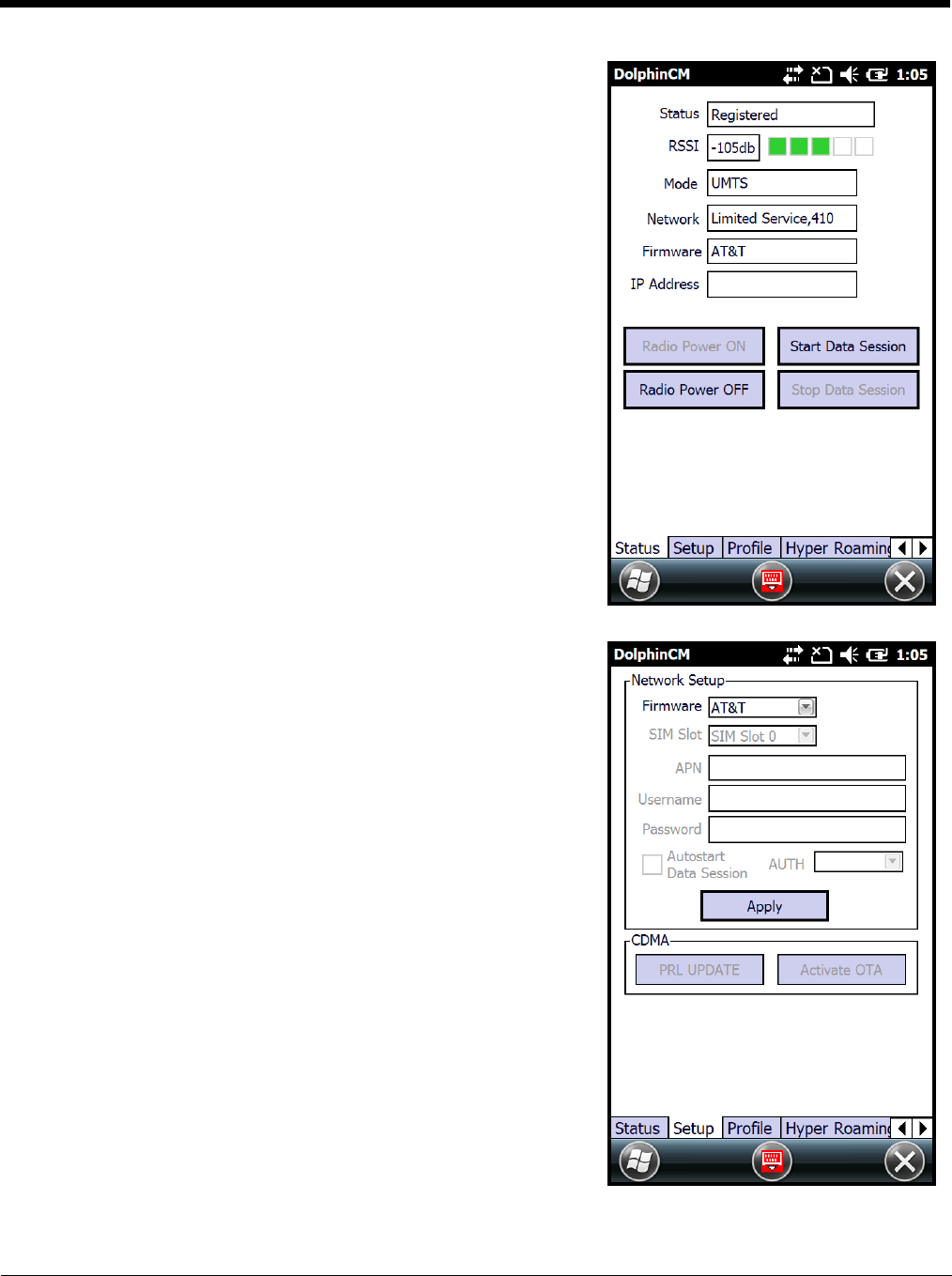
9 - 13
Status Tab
The Status tab contains the real time radio status information
including:
• The power status of the radio (e.g., ON or OFF)
• The received signal strength intensity (RSSI)
• The radio mode used (e.g., GSM, UMTS, EVDO or 1xRTT)
• The network firmware used
• The IP Address assigned
You can also turn the radio ON or OFF and Start or Stop a data
session from the Status tab.
Setup Tab
The Setup tab allows you to view and customize the Network
Setup including:
• The Network Firmware (e.g., AT&T, Verizon, Sprint, or
T-Mobile)
• The SIM Slot accessed
• The Access Point Name (APN)
• The User name of the account
• The Password of the account
• Enable or Disable Automatic Data Sessions
• Update the Preferred Roaming List (PRL) for CDMA
• Activate Over the Air (OTA) Provisioning in CDMA
Preliminary Draft 6/19/13, Not for Release
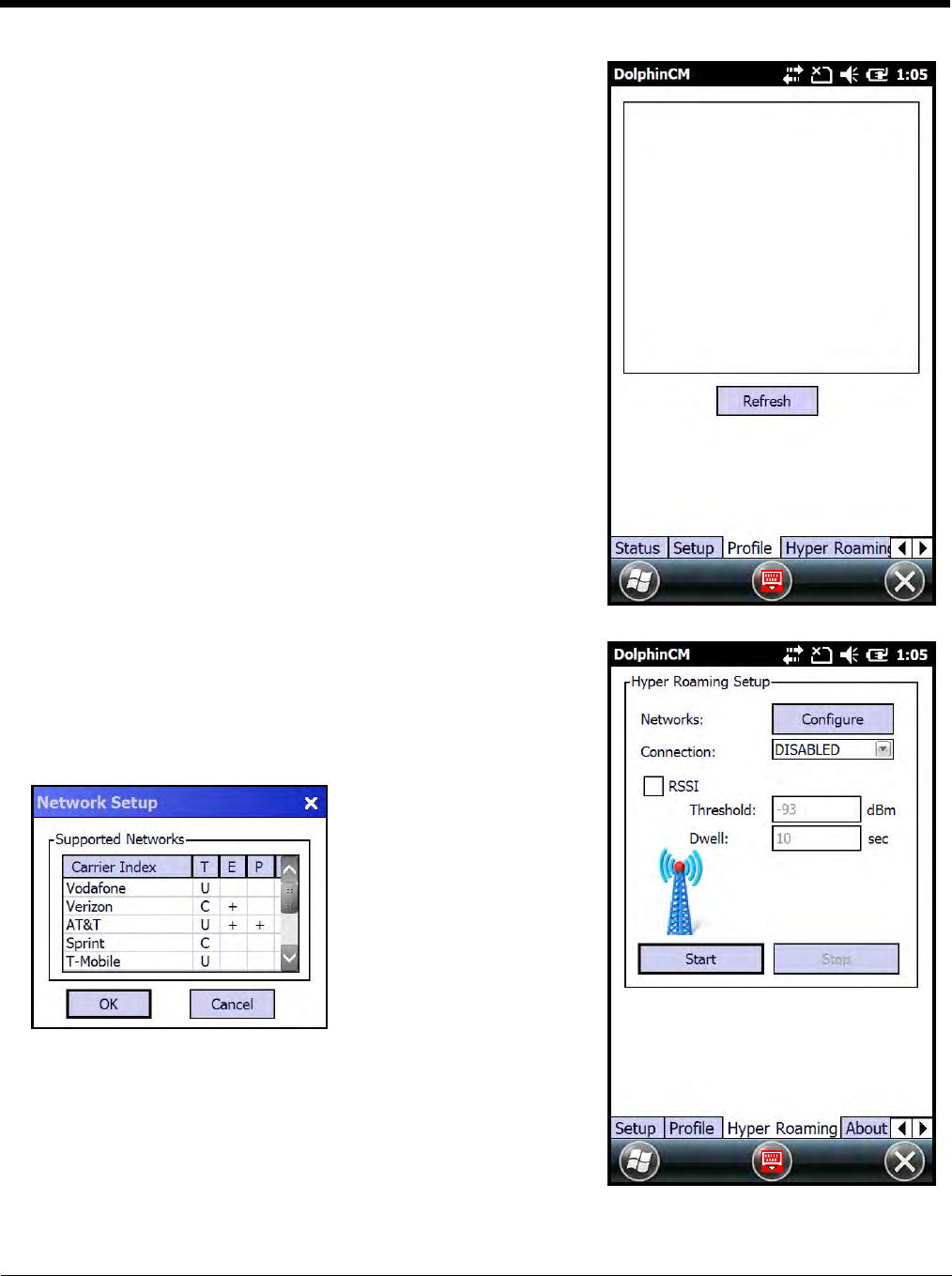
9 - 14
Profile Tab
The Profile tab allows you to see Radio capability information
and network statistics including:
• Radio Hardware and Software versions
• Radio and SIM identification numbers
• Serving network connection type and state
• Available radio interfaces for the current serving network
Hyper Roaming Tab
The Hyper Roaming tab allows you to turn roaming capabilities
on or off and customize network and connection settings includ-
ing:
• Designating and configuring supported networks
• Selecting a connection type (e.g., 2G, 3G or DISABLED)
• Setting the RSSI Threshold and Dwell
About Tab
Displays copyright and version information for the Dolphin Connection Manager.
Preliminary Draft 6/19/13, Not for Release
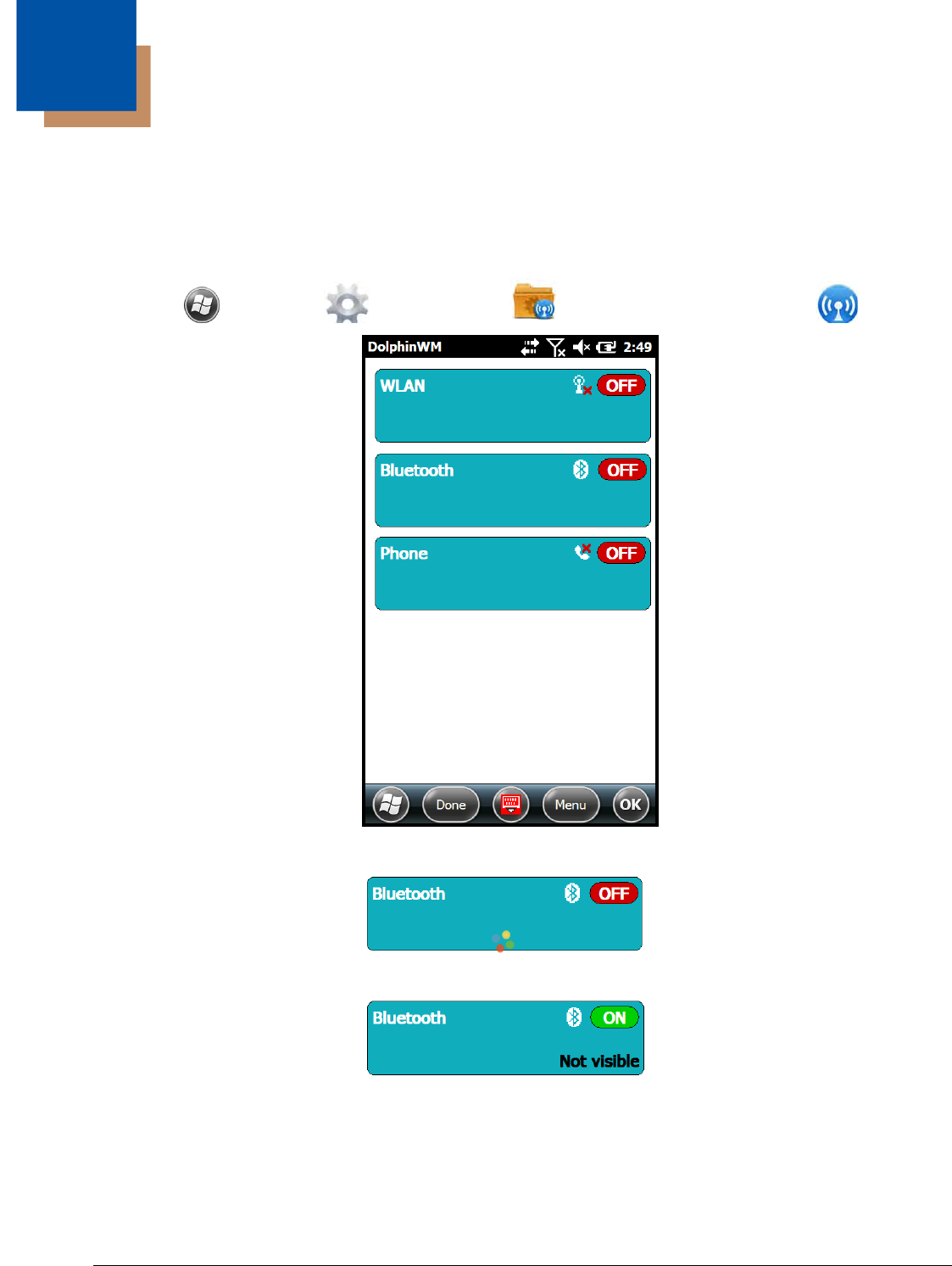
10 - 1
10
Working with the Bluetooth Radio
Enabling the Bluetooth Radio
You enable the Bluetooth radio in the Dolphin Wireless Manager Window (see page 8-5).
1. Touch > Settings > Connections > Dolphin Wireless Manager .
2. Touch anywhere inside the Bluetooth rectangle to begin activation of the Bluetooth radio.
3. When the radio is activated (i.e., transmitting a signal), the Off button changes to On.
When the Bluetooth radio is transmitting a signal, additional text displays in the Bluetooth section
providing information about the radio. “Visible” and “Not visible” indicates whether the Bluetooth
radio is set to be discoverable or not discoverable by other Bluetooth devices. To make the terminal
discoverable, see page 10-6.
Preliminary Draft 6/19/13, Not for Release
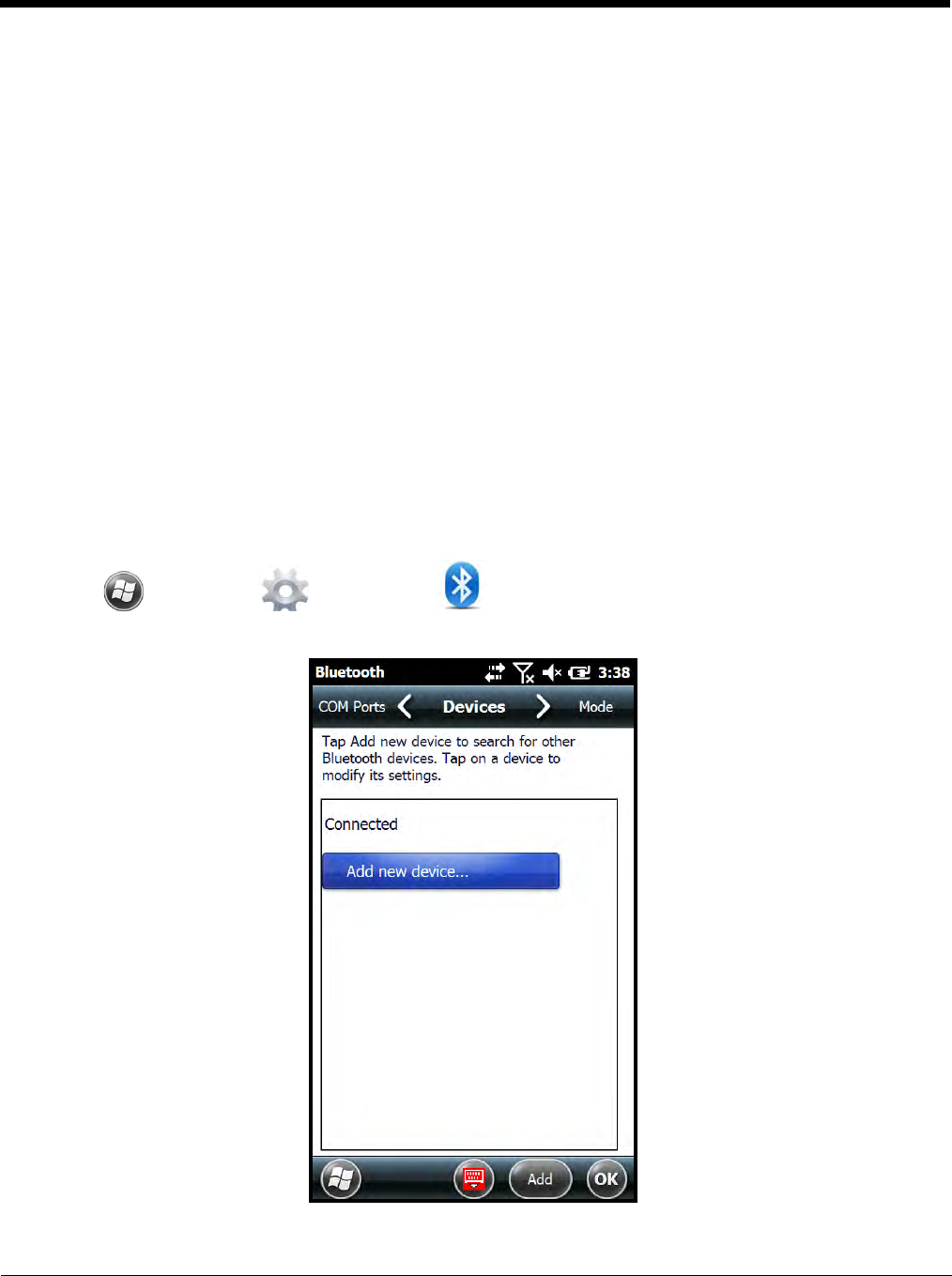
10 - 2
Pairing and Trusted Devices
The terminal supports pairing. Pairing happens during the general connection setup. Paired devices are
"trusted" devices. This means that there is unrestricted access to all services (including services that
require authorization and authentication).
A connection can exclude pairing. A device that is connected to the terminal but not paired with it is
considered an untrusted device. Content can still be passed to untrusted devices by requiring authori-
zation with each attempt (for example, with the initialization of a file exchange).
Connecting to Other Bluetooth Devices
To connect to other Bluetooth equipped devices, you need to perform a device discovery, select a
discovered device, and then connect to the selected device. Pairing happens as part of the connection
process.
1. Make sure the Bluetooth device is in range and set to be discoverable by other bluetooth devices.
2. In the Dolphin Wireless Manager, touch Menu > Bluetooth Settings.
OR
Touch > Settings > Bluetooth .
3. Touch Add new device. The terminal begins searching for discoverable Bluetooth devices.
Preliminary Draft 6/19/13, Not for Release
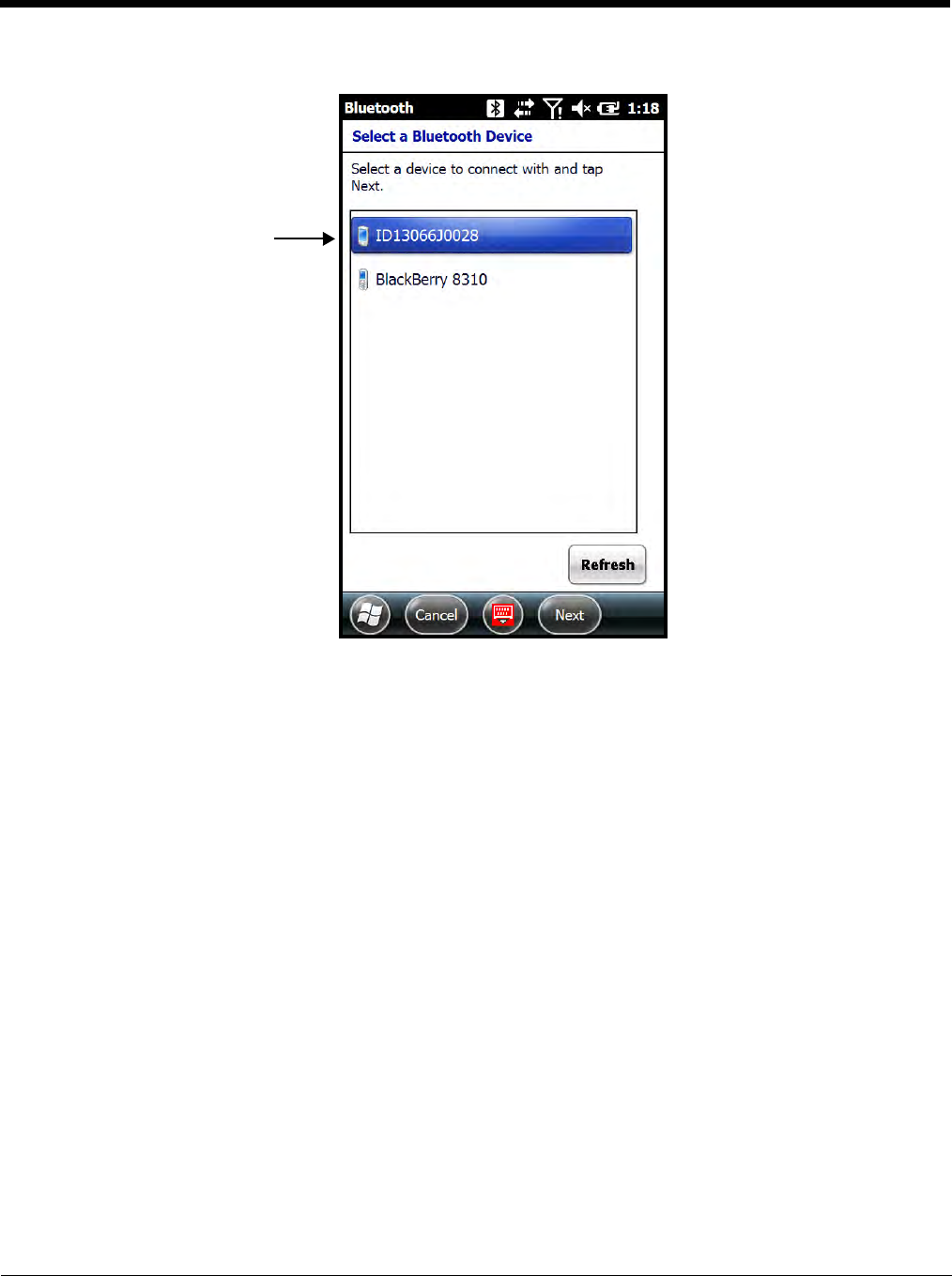
10 - 3
4. Select a device from the list and touch Next.
5. You are prompted to enter a passcode.
• If the device has a specific passcode, enter it in the Passcode field and touch Next.
When attempting to connect to a printer or headset with Bluetooth capabilities, the passcode may
default to either 1111 or 0000. If there is no default, consult the device literature for the number.
• If the device does not have a specific passcode, you can enter one in the Passcode field and
touch Next to create a passcode.
6. The Bluetooth radio tries to connect with the device.
7. If you created a passcode, you will be prompted by the other device to enter the same passcode.
Enter the created passcode to establish a paired connection.
If you entered a device specific passcode, you should not have to do anything on the other device.
The types of devices in the
vicinity of the radio appear in
the list of discovered devices.
Preliminary Draft 6/19/13, Not for Release
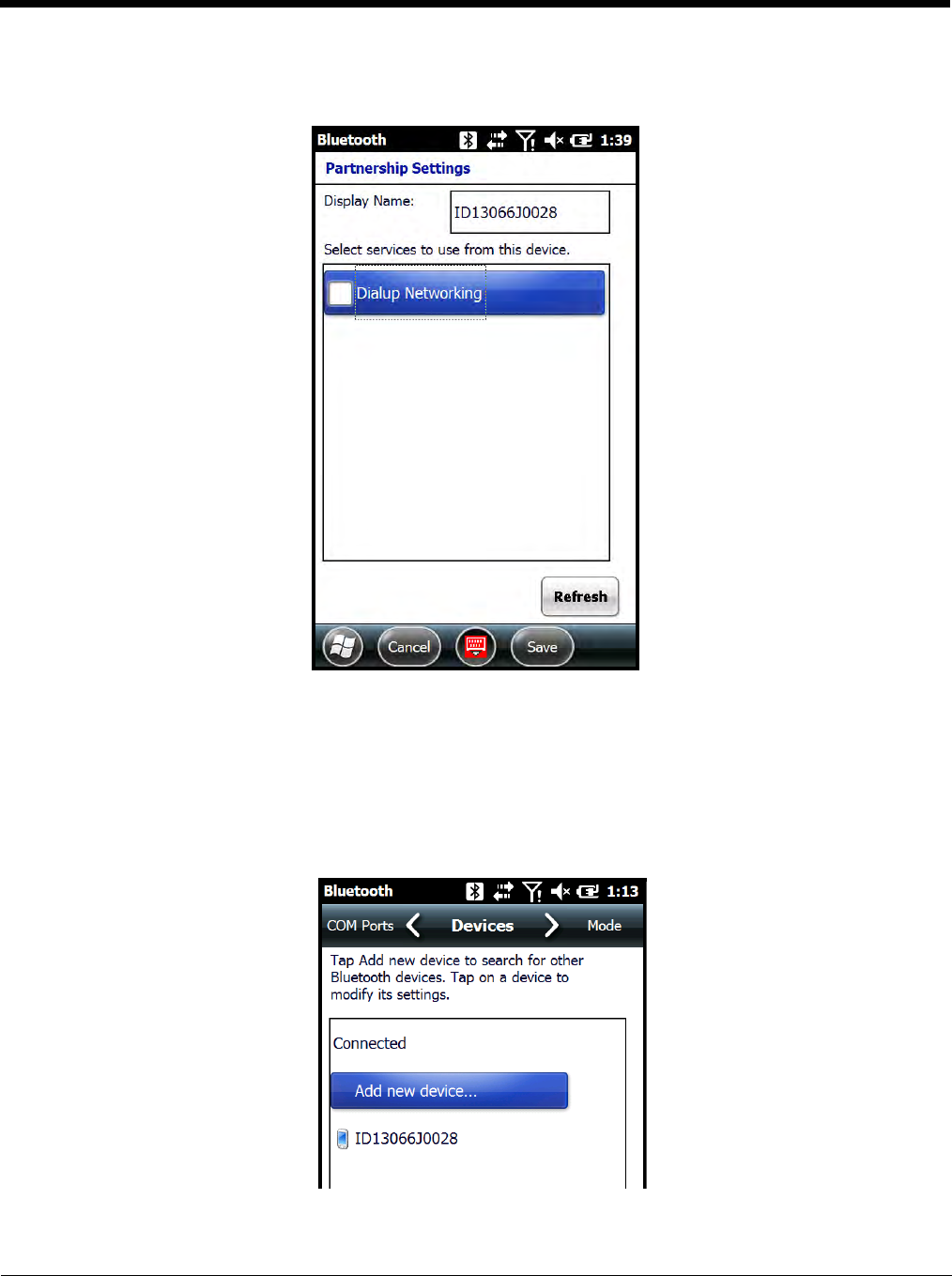
10 - 4
8. When the connection is complete, a list of matching and supported services on the device appears.
Only the services that are mutually supported on both devices appear in the Partnership Settings
window.
9. Select the services you want to use and touch Save.
The services on the new devices have to be selected or the pairing won’t include those services,
even though the devices are paired. If services are not selected, you will be continually re-prompted
for the passcode from the device.
10. The device appears in the list on the main window.
Note: If you are connecting to a printer or headset, complete any additional steps required by the device.
11. After the passcodes have been accepted on both sides, you have a trusted (paired) connection.
Preliminary Draft 6/19/13, Not for Release
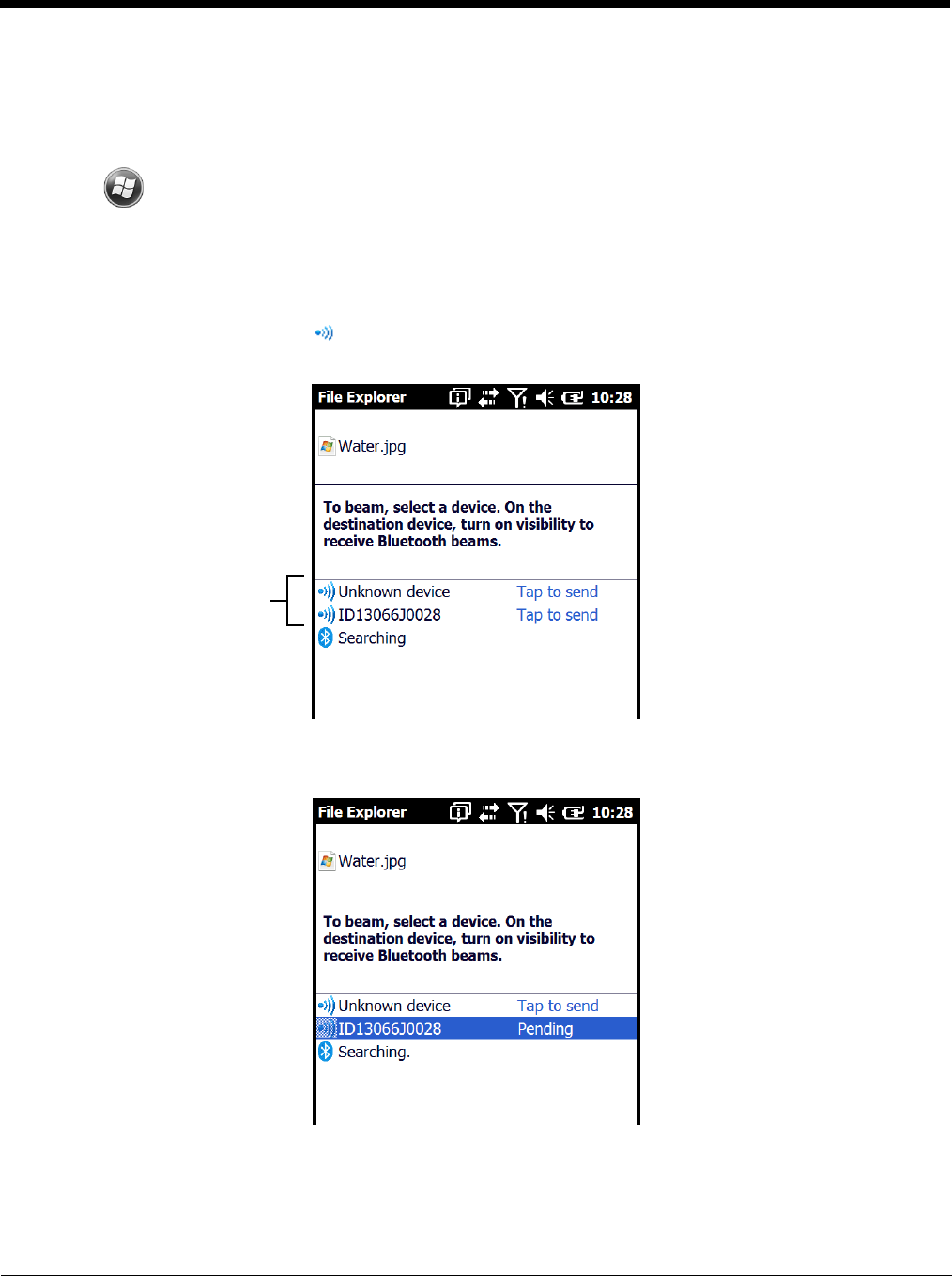
10 - 5
Transferring Files using Beam File
Before attempting to transfer files, make sure the receiving Bluetooth device is in range, set to be discov-
erable by other devices, and set to receive incoming beams.
1. Touch > File Explorer.
2. Navigate to the file you want to transfer.
3. Touch and hold on the file, then select Beam File on the popup menu.
4. The Bluetooth radio begins searching for devices. When a Bluetooth device is first found, it appears
as an “Unknown device”. The icon indicates that the device is a Bluetooth equipped device. As
data is retrieved, the device IDs appear in the list.
5. Touch a device on the list to begin sending the selected file.
6. The selected device reads “Pending” while the terminal tries to connect.
7. Once a connection is made and the file is being transferred, the selected device reads “Sending”.
8. The selected device reads “Done” when the transfer is complete.
During a search, Bluetooth
equipped devices found within
range appear on the screen.
Preliminary Draft 6/19/13, Not for Release
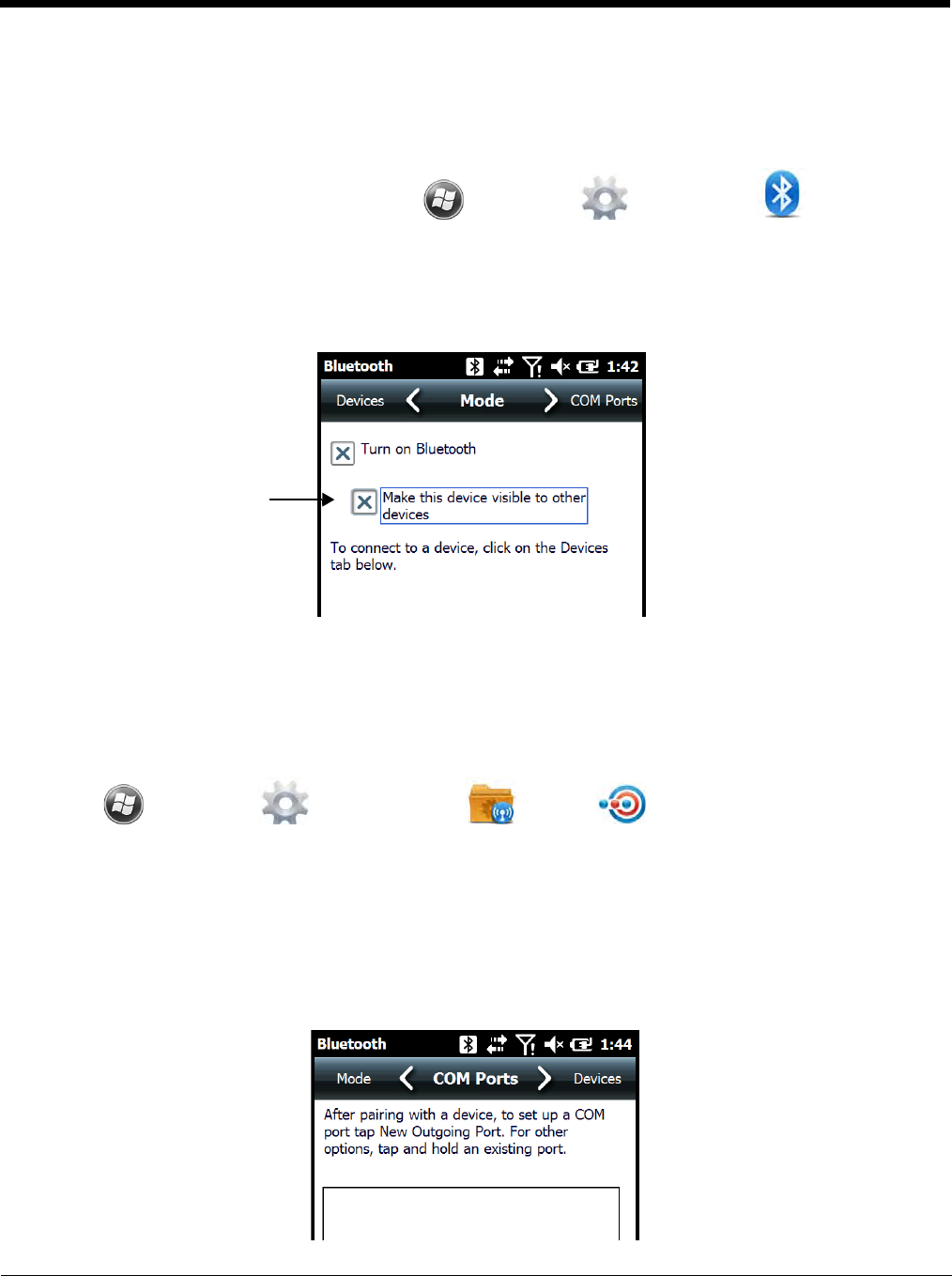
10 - 6
Making the Terminal Discoverable
By default, the Dolphin terminal is not discoverable, which means that the terminal will not be found by
other Bluetooth devices.
1. To make the terminal discoverable, touch > Settings > Bluetooth .
Note: If you are in the Dolphin Wireless Manager, touch Menu > Bluetooth Settings.
2. Touch Mode on the Horizontal scroll.
3. Select “Make this device visible to other devices” and touch OK.
Enabling the Terminal to Receive Incoming Beams
By default, the Dolphin 60s terminal is not configured to receive incoming beams from other devices
attempting file transfers via the Beam File command. Before initiating a file transfer from another device
follow the steps below to enable Beam reception on your Dolphin terminal.
1. Touch > Settings > Connections > Beam .
2. Select “Receive all incoming beams.”
3. Touch OK.
Selecting COM Ports
For more information on available COM ports, see Dolphin 60s COM Port Assignment Table on page 8-
13.
Preliminary Draft 6/19/13, Not for Release

10 - 7
Preliminary Draft 6/19/13, Not for Release

10 - 8
Preliminary Draft 6/19/13, Not for Release
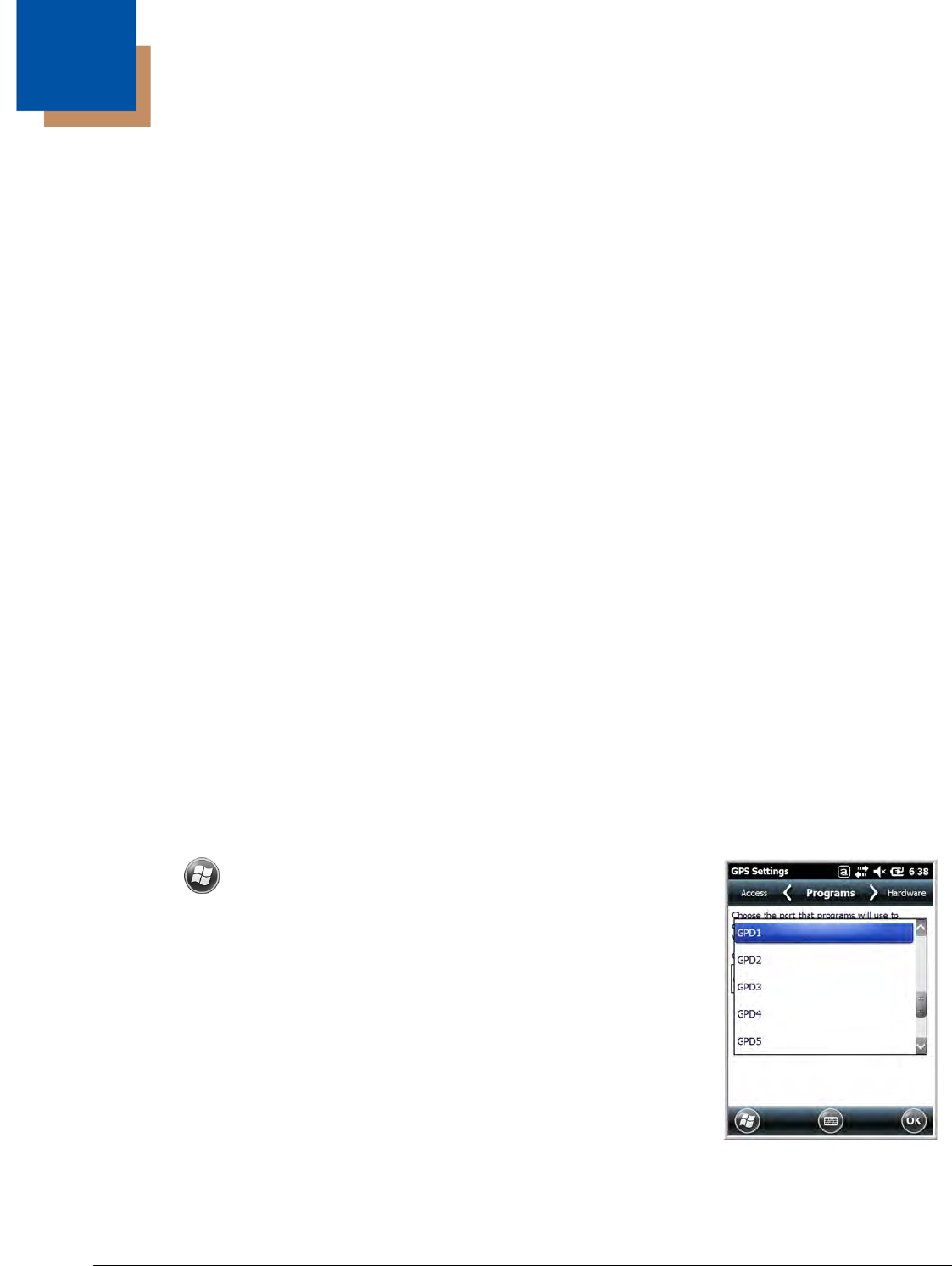
11 - 1
11
Working with GPS
Overview
The Dolphin 60s terminal contains an integrated GPS module that allows location tracking of workers
and vehicles, providing better utilization of field assets. Optional mapping and navigation software
provides turn-by-turn driving directions and location information.
Assisted GPS Support
The operating system software does not inhibit nor explicitly support assisted GPS modes, which usually
requires installing a vendor-specific client on the terminal that communicates with the GPS module. This
client would then provide the almanac and/or ephemeris data for warm or hot start modes of operation,
allowing a lower time to first fix (TTFS). The Client must be configured on the terminal, active, and
provide the data to the GPS module through the standard COM port.
Powering the GPS Module
The GPS module powers on automatically when accessed by a software application and powers off
automatically when that software application closes. You cannot manually power on and off the GPS
module.
Communication Ports
There are two ways to access the GPS module: through the actual COM port (COM7) or the GPS Inter-
mediate Driver. The method you use depends on the software application you are using. If the software
application requires the actual COM Port, set the operating system to use COM7. If the software appli-
cation requires the GPS Intermediate Driver, set the operating system to use the GPS Intermediate
Driver.
Selecting the Port
1. Touch > Settings > System > External GPS.
2. In the GPS program port: drop-down list, select COM7 or GPD1
(the GPS Intermediate Driver) as required by the application.
Note: The GPS program port and hardware port cannot be the same value.
3. Touch OK to save.
COM7
COM Port 7 can be set to the following baud rates:
•4800
• 9600 (Default baud rate. Recommended for optimal performance.)
• 19200
• 38400
Other baud rates are not possible. The baud rate selected on COM7 is the actual baud rate with which
the GPS communicates.
Preliminary Draft 6/19/13, Not for Release

11 - 2
GPS Intermediate Driver
When the first user of GPD1 opens the port, the GPS Intermediate Driver opens the COM7 port. The
GPS Intermediate Driver allows multiple applications to open GPD1, and the GPS data is broadcast to
all open ports.
When the GPSID driver is in use, the COM7 port is allocated to GPSID as READ|WRITE (COM7 is still
available for access mode of 0).
For more information about Microsoft’s GPS Intermediate Driver, follow this link:
http://msdn.microsoft.com/en-us/library/ms850332.aspx
GPS Demo
The GPS Demo demonstrates the main functionality of the integrated GPS module. The GPS Demo
uses COM7.
To see the GPS Demo, touch > Demos > GPS Demo.
Preliminary Draft 6/19/13, Not for Release

12 - 1
12
Dolphin 60s HomeBase Device (Model D60s-HB)
Overview
The Dolphin 60s HomeBase (Model D60s-HB) is a charging and communication cradle that supports
USB Hi-Speed 2.0v communication, which enables the terminal to interface with the majority of PC-
based enterprise systems. The HomeBase also contains an auxiliary battery well that charges a spare
Honeywell standard or extended battery.
The D60s-HB charger is designed for use with Dolphin 60s model terminals and battery part number
BAT-EXTENDED-01 (Li-ion 3.7 V, 12.358 watt hour), manufactured for Honeywell International Inc.
We recommend use of Honeywell peripherals, power cables, and power adapters. Use of any non-Honeywell
peripherals, cables, or power adapters may cause damage not covered by the warranty.
Unpacking the HomeBase
Open the shipping box and inspect the package to see that the following standard items are included:
• One Dolphin HomeBase, model D60s-HB
• One power supply (see Power on page 12-5)
• One power cord
These items are needed to operate the HomeBase. If any items are missing or anything appears to be
damaged, contact your Customer Account Representative. Keep the original packaging in case you
need to return the HomeBase for service or to store the HomeBase while not in use.
Optional Equipment
A standard USB (Type A to B) cable is required when using the HomeBase for communication between
the terminal and a host device.
Charging Overview
The base provides power to the intelligent battery charging system in all Dolphin terminals that senses
when a full charge has been achieved and switches to a trickle charge to maintain the full charge. The
base completes a full charge of the main battery installed in the terminal seated in the terminal well in
6 hours for the extended battery. The base completes a full charge of the battery pack in the Auxiliary
Battery Well (see page 12-3) in 6 hours for the extended battery.
Note: Before attempting to use, charge, or replace the battery in the terminal, you should read the Guidelines for
Battery Pack Use and Disposal on page 3-14.
We recommend use of Honeywell Li-ion battery packs. Use of any non-Honeywell battery may result in
damage not covered by the warranty.
Communications
Reliable data communications at speeds of up to 480 Mbps can be transmitted by the base through the
Hi-Speed USB port.
Note: These bases cannot be physically connected to each other - sometimes referred to as “daisy-chained”.
!
!
Preliminary Draft 6/19/13, Not for Release

12 - 2
Convenient Storage
The intelligent battery charging system makes this base a safe and convenient storage receptacle for
your Dolphin terminal.
Capacity
The base holds one terminal and features an auxiliary battery well behind the terminal well that can
charge a battery pack independently of the terminal well. This means that one base can charge two
battery packs: the one installed in the terminal and a spare.
We recommend use of Honeywell peripherals, power cables, and power adapters. Use of any non-Honeywell
peripherals, cables, or power adapters may cause damage not covered by the warranty.
Dimensions
Weight
HomeBase weight: XXXg [XXX lbs]
!
Need dimensions
Preliminary Draft 6/19/13, Not for Release
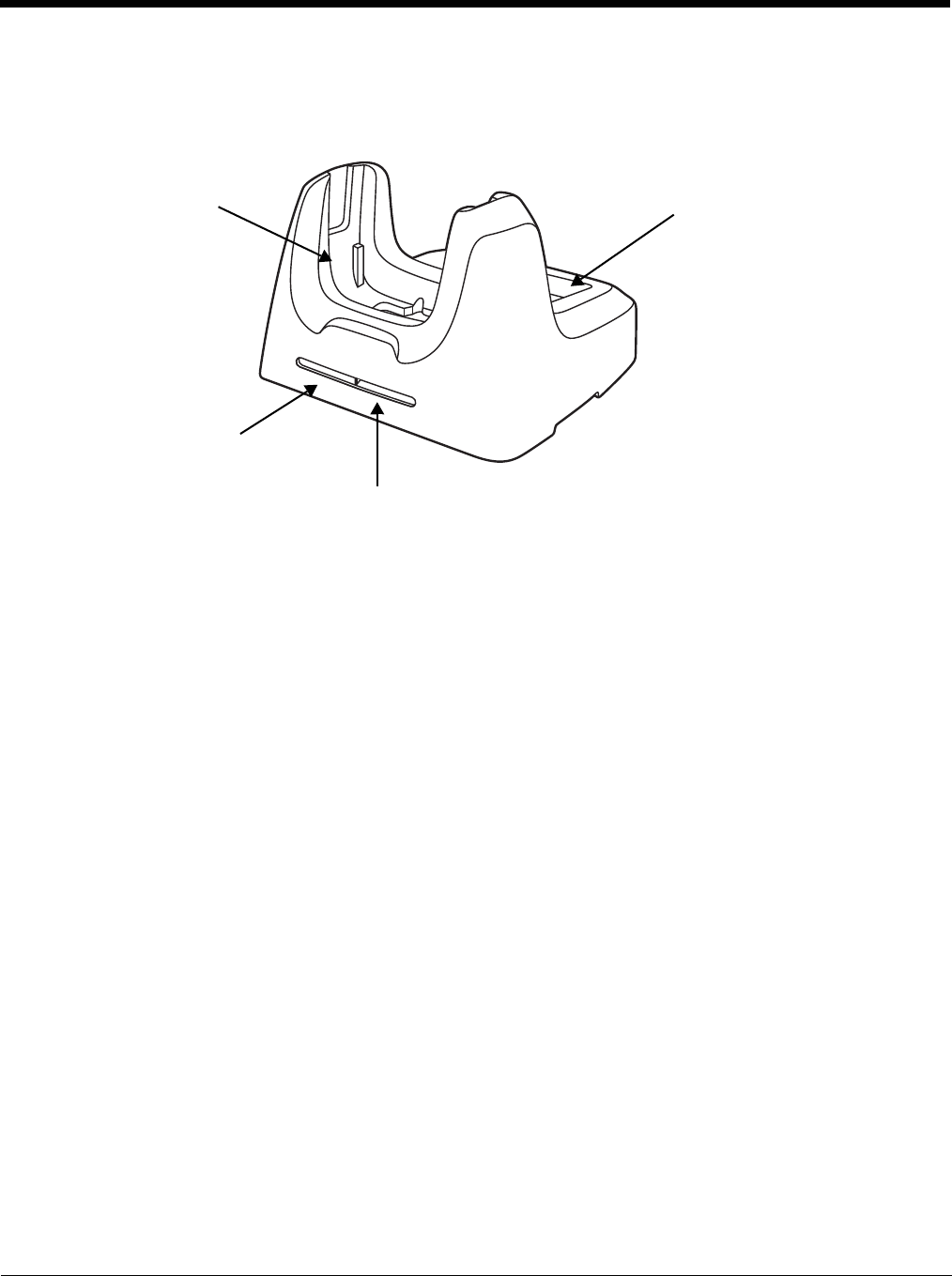
12 - 3
Parts and Functions
Front Panel
Terminal Well
Place the terminal in this well to communicate with a host device, power the terminal, and
charge the installed battery pack. The base completely charges the main battery in a Dolphin
terminal in 6 hours for the extended battery. If the host device is a workstation that uses
ActiveSync or Windows Device Mobile, and the synchronization begins immediately.
Auxiliary Battery Well
See Auxiliary Battery Well on page 12-4.
AUX Battery LED
Indicates status of the battery charging in the auxiliary battery well; see Back Panel on page
12-4.
For information about charging a battery in the auxiliary battery well, see page 12-6.
Dock LED
Indicates if a terminal is docked properly in the base.
This color means…
Orange The auxiliary battery is charging.
Green The auxiliary battery has completed charging and is ready for use.
This color means…
Green The terminal is properly seated in the base.
Dock LED
Auxiliary Battery Well
AUX Battery LED
Terminal Well
Preliminary Draft 6/19/13, Not for Release
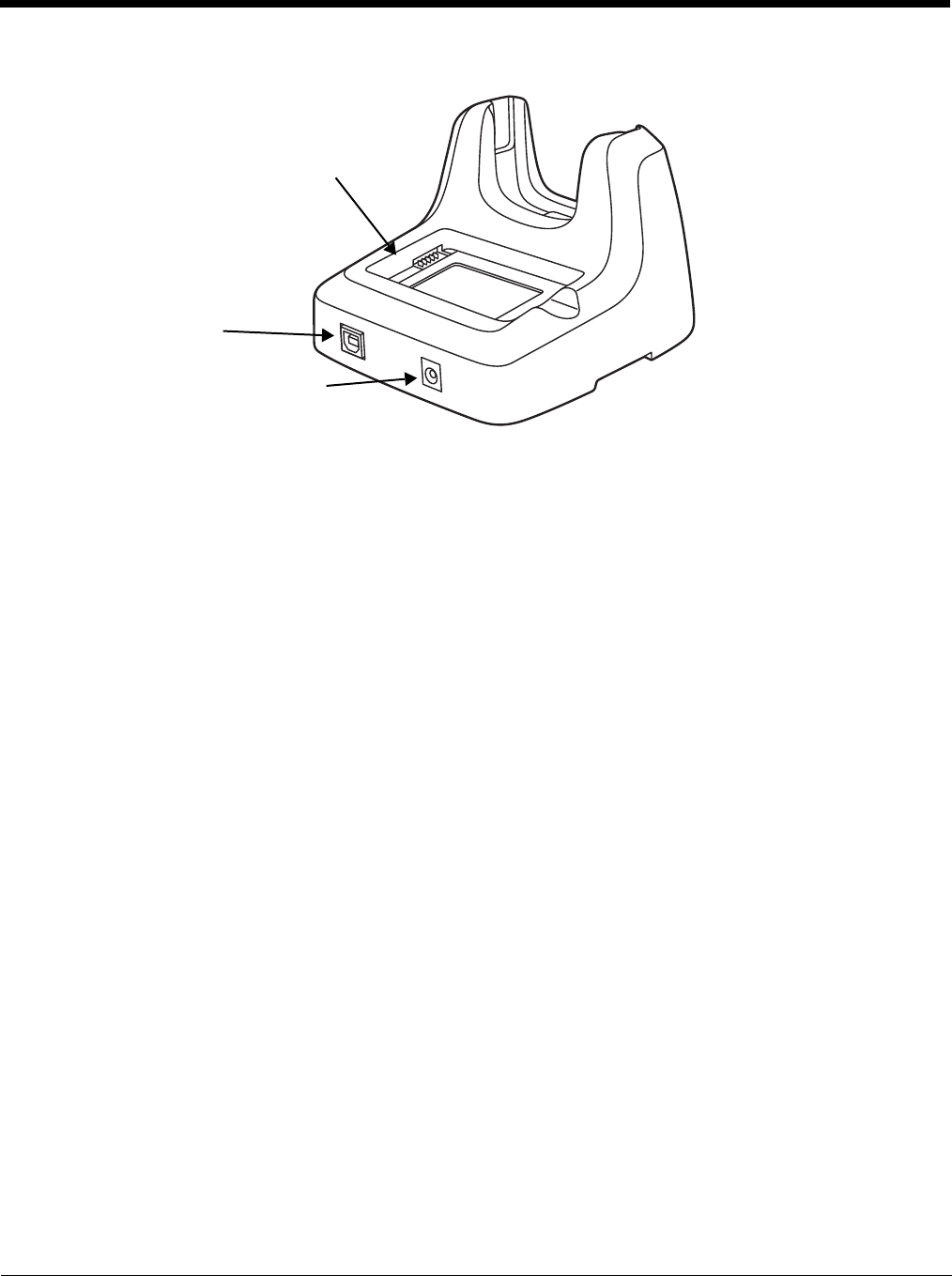
12 - 4
Back Panel
Auxiliary Battery Well
The base enables you to charge an additional battery pack independently of the terminal well
in 6 hours for the extended battery. This feature ensures that you can always have a fully-
charged battery for your terminal. See Charging a Spare Battery in the Auxiliary Battery Well
on page 12-6.
USB Port
This USB port is USB v2.0 Hi-Speed (480 Mbps) compliant. Using a USB cable, you can
connect the base to a host device, such as a workstation. USB communication occurs through
Microsoft ActiveSync (v4.5 or higher) or Microsoft Windows Mobile Device Center (WMDC)
depending on the host workstation’s operating system. When the terminal is seated in the
terminal well, it is connected to the host device via the base.
Note: ActiveSync on your Dolphin terminal works with Windows Mobile Device Center on host
workstations running Windows Vista or Windows 7 and with ActiveSync on host workstations
running Windows XP. For detailed information on ActiveSync and WMDC visit Microsoft's
Windows Mobile Web site.
DC Power Jack
See Power on page 12-5.
Auxiliary Battery Well
DC Power Jack
USB Port
Preliminary Draft 6/19/13, Not for Release
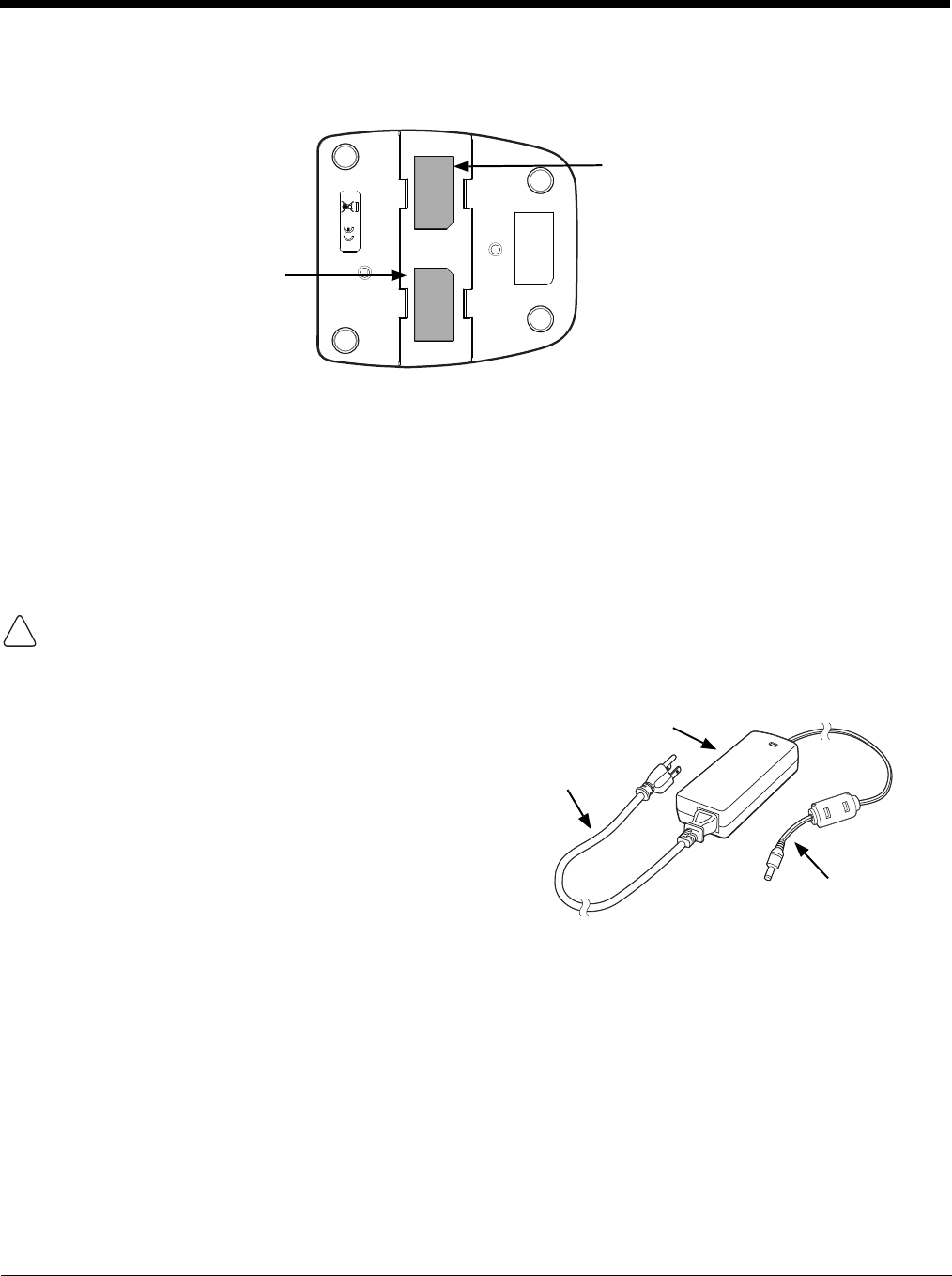
12 - 5
Bottom Panel
For details on how to mount the HomeBase, see Mounting the HomeBase on page 12-7.
Power
The base requires 12 Volts DC input for communications, battery charging, and power output to the
terminal. The power adapter included with the base, converts the voltage from the AC power source to
12 Volts DC. Use only a UL listed power supply, which has been qualified by Honeywell with
output rated at 12VDC and 3 amps with the device. The operating temperature range is -10° to 50°C
(14° to 122°F) Honeywell recommends that you leave the base connected to its power source at all
times, so that it is always ready to use.
We recommend use of Honeywell peripherals, power cables, and power adapters. Use of any non-Honeywell
peripherals, cables, or power adapters may cause damage not covered by the warranty.
Connecting Power to the HomeBase
1. Plug the A/C power cord into the power
adapter.
2. Plug the power cable into the power connector
on the back of the HomeBase.
3. Plug the A/C power cord into a grounded power
source.
4. The base is now powered.
Compliance Label
Serial Number Label
!
Power Cable
A/C Power Cord
Power Adapter
Preliminary Draft 6/19/13, Not for Release
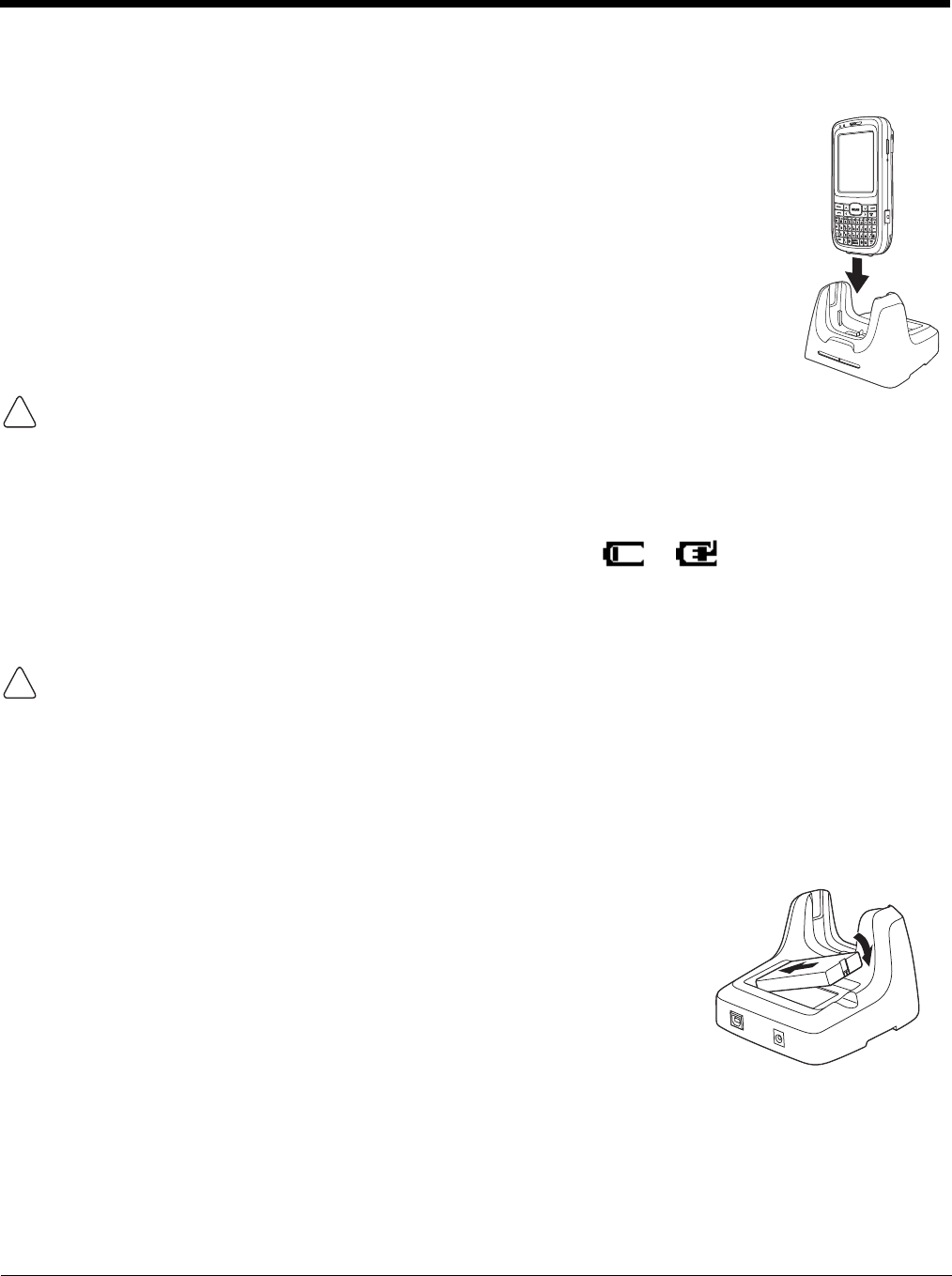
12 - 6
Charging the Main Battery
The base provides power to the Dolphin terminal and allows the charging of the
terminal’s battery. The intelligent battery charging system incorporated into all Dolphin
terminals prevents overcharging, which means that Dolphin terminals may be stored
in the base indefinitely without damage to the terminals, battery, or the base. When
the terminal is docked, the base completes a full charge in 6 hours for the extended
battery.
For more information about Honeywell battery packs and how to check battery power
levels in your terminal, refer to Power (page 7-23) and Battery (page 3-10).
To Power a Terminal and Charge its Main Battery
Ensure all components are dry prior to mating terminals/batteries with peripheral devices.
Mating wet components may cause damage not covered by the warranty.
1. Install the battery pack in the terminal; see Install the Battery on page 2-1.
2. Slide the terminal into the terminal well. The Dock LED illuminates blue. Battery charging begins
immediately if required by the Dolphin terminal.
Note: When the terminal is docked, the Battery Icon changes from to indicating the terminal is
running on external power. Battery charging occurs in the background. When the Dolphin is removed
from the base, the battery icon indicates the charge level of the battery, see Icons in the Title Bar on
page 2-4. For additional information on how to check the power levels of the battery, while the terminal
is docked, see Checking Battery Power on page 3-15.
We recommend use of Honeywell Li-Ion battery packs. Use of any non-Honeywell battery may result in
damage not covered by the warranty.
Charging a Spare Battery in the Auxiliary Battery Well
The auxiliary battery well located on the back of the base charges a spare battery independently of the
terminal well. The Aux Battery LED on the front panel indicates the status of the battery in this well.
Charge time is 4 hours for the standard battery pack or 6 hours for the extended battery pack; see
Auxiliary Battery Well on page 12-4.
1. Insert the battery at an angle.
Note: Align the battery contacts with the contacts inside the auxiliary battery
well.
2. Snap the battery into place with a hinging motion. The Aux Battery
LED lights orange during charging.
3. Use the AUX Battery LED to monitor the charging progress. The LED
changes to green when the auxiliary battery has completed charging
and is ready for use.
!
!
Preliminary Draft 6/19/13, Not for Release

12 - 7
Communication
Dolphin terminals support USB communications out of the box. The base also supports USB communi-
cations via the USB port located on the back. The base acts as a USB device by interfacing the USB
signals of the Dolphin terminal to the USB of the host workstation. Using a standard USB cable, the
base’s USB interface allows the Dolphin terminal to communicate with a workstation.
Requirements
• A base powered by a power cable and power adapter cable
• A standard USB (Type A to B) communication cable
• A work station running Windows 98 Second Edition, Windows Me, Windows 2000, Windows NT (4.0
SP6 or higher), Windows XP, Windows Vista, or Windows 7.
• ActiveSync (v4.5 or above) or Widows Mobile Device Center on the workstation
Setting Up and Connecting the Dolphin Terminal to the HomeBase
1. Connect power to the HomeBase (see Power on page 12-5).
2. Plug the USB communication cable into the USB port on the back of the base.
3. Connect the other end of the USB cable to the host workstation.
4. Insert the Dolphin terminal into the terminal well of the base. The Dock LED illuminates blue.
5. The Dolphin terminal activates and automatically opens ActiveSync to establish a connection.
6. The connection icon in the Dolphin’s navigation bar changes from to it indicate a successful
connection. The base can now transfer data between the terminal and the host device.
Mounting the HomeBase
Set the base on a dry, stable surface, such as a desktop or workbench near an electrical outlet. Be sure
to provide enough workspace with good lighting for the user to view and operate the Dolphin terminal
while it is in the base. When choosing a mounting location, bear in mind that the location must allow
users' easy access to the Auxiliary Battery Well and the back panel of the HomeBase where the USB
port and the power jack are located.
Desk Mounting
The DIN rail slot (7.5 X 35 mm) may be mounted on the bottom to allow for secure desk attachment of
the unit if desired.
Hardware Required
• 3/16 in. dia x 5/8 in. long pan head screw
• 1/2 in. OD x 7/32 in. ID x 3/64 in. thick
• 3/16 in. dia nut
Installing the DIN Rail
1. Slide the DIN rail into the slot along the bottom panel of the base.
x
Preliminary Draft 6/19/13, Not for Release
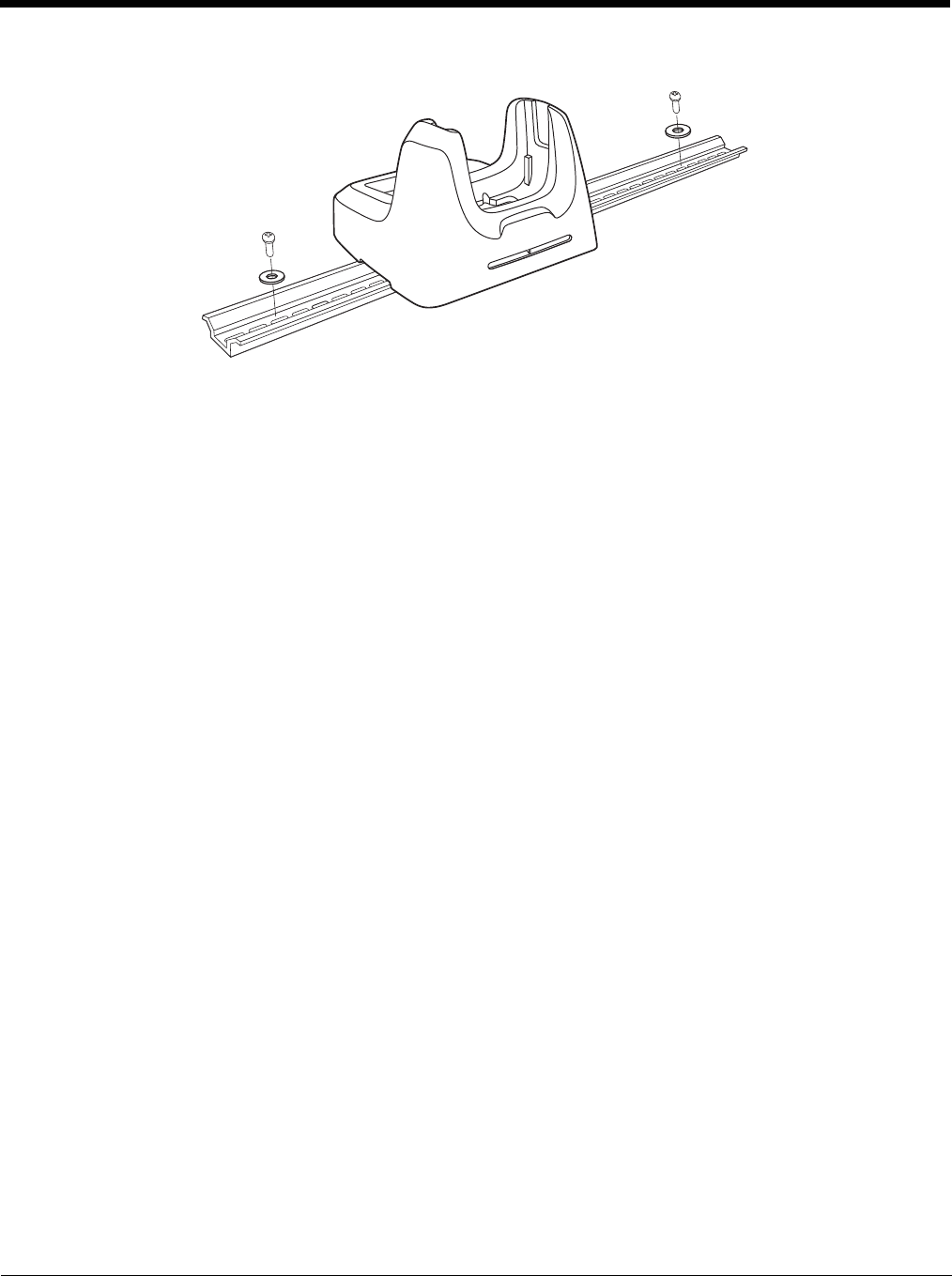
12 - 8
2. Then, using the appropriate nuts and bolts, secure the DIN rail to the desk or flat surface.
Preliminary Draft 6/19/13, Not for Release

13 - 1
13
Dolphin 60s Mobile Base Device (Model 60s-MB)
Overview
The Dolphin Mobile Base charging cradle is designed specifically for in-premise and in-transit data
collection applications. The base features a mounting bracket and a cigarette lighter adapter to adapt it
to your environment.
The 60s-MB charger is designed for use with Dolphin 60s model terminals and battery part number BAT-
EXTENDED-01 (Li-ion 3.7 V, 12.358 watt hour) manufactured for Honeywell International Inc.
We recommend use of Honeywell peripherals, power cables, and power adapters. Use of any non-Honeywell
peripherals, cables, or power adapters may cause damage not covered by the warranty.
Charging Overview
The base provides power to the intelligent battery charging system in all terminals that senses when a
full charge has been achieved and switches to a trickle charge to maintain the full charge. The base
completes a full charge of the main battery in 6 hours for the extended battery pack.
Note: Before attempting to use, charge, or replace the battery in the terminal, you should read the Guidelines for
Battery Pack Use and Disposal on page 3-14.
We recommend use of Honeywell Li-Ion battery packs. Use of any non-Honeywell battery may result in
damage not covered by the warranty.
Convenient Storage
Intelligent battery charging makes the base a safe and convenient storage receptacle for your Dolphin
terminal.
!
!
Preliminary Draft 6/19/13, Not for Release
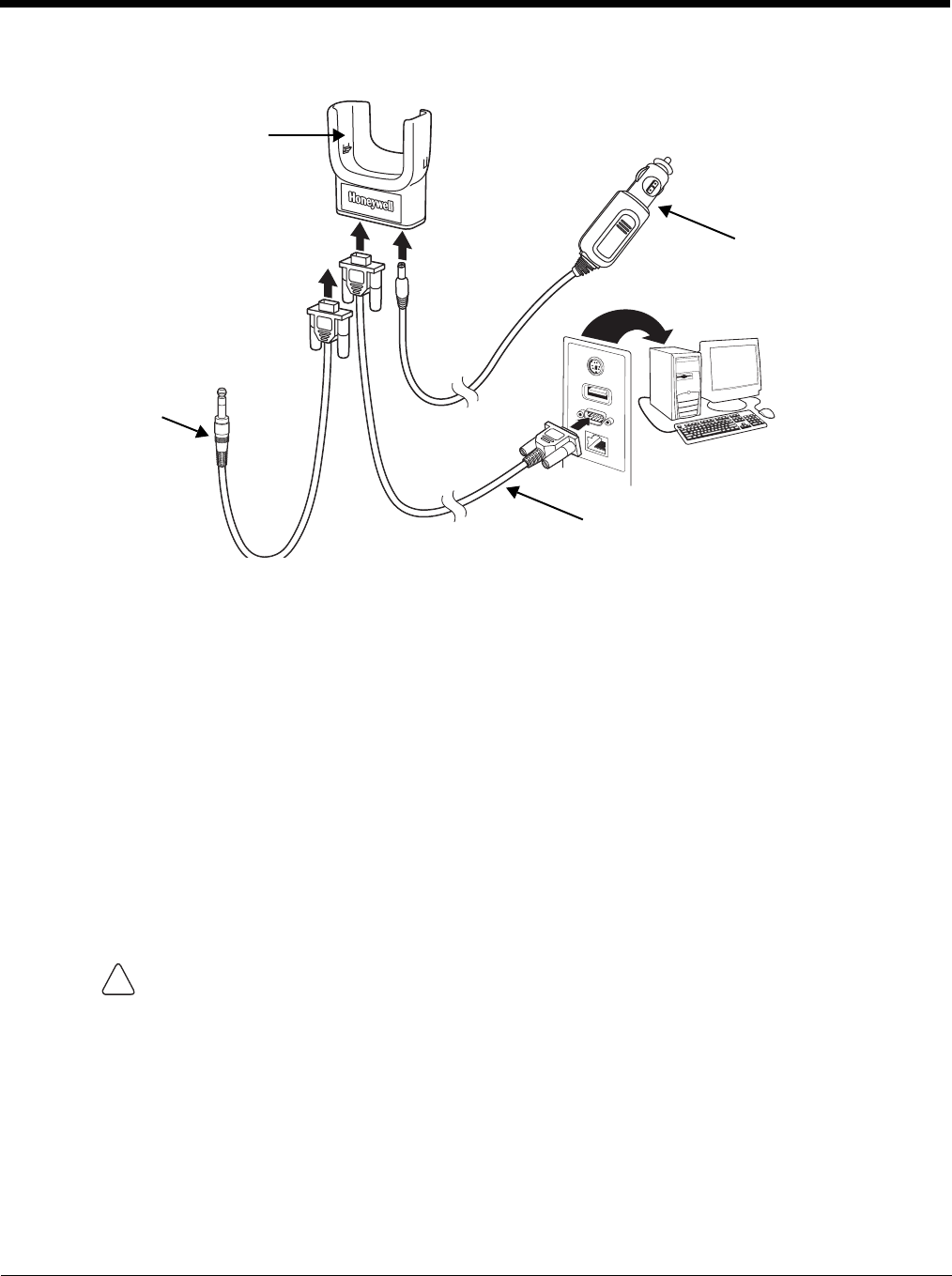
13 - 2
Mobile Base Components
DB9 Cable
The mobile base is provided with a DB9 cable that can be connected to a computer RS-232
port.
DEX Cable
The mobile base is provided with a DEX cable that can be connected to a vending machine.
Power Adapter
The mobile base is provided with a power adapter cable that can be connected to a vehicle
cigarette lighter outlet.
UL listed power supply
Input: 10V - 30VDC, 0.43A(30V) - 1.28A(10V)
Output: 4.75V - 5.25VDC, 0 - 2A
Verify that the power source is always within the specified range and observe correct
input voltage polarity. An improper input voltage range or reverse polarity could damage
the power conversion circuitry.
Terminal Charging Well
Place the terminal in this well to charge the battery.
Power Adapter
Terminal Charging
Well
DB9 Cable
DEX Cable
!
Preliminary Draft 6/19/13, Not for Release
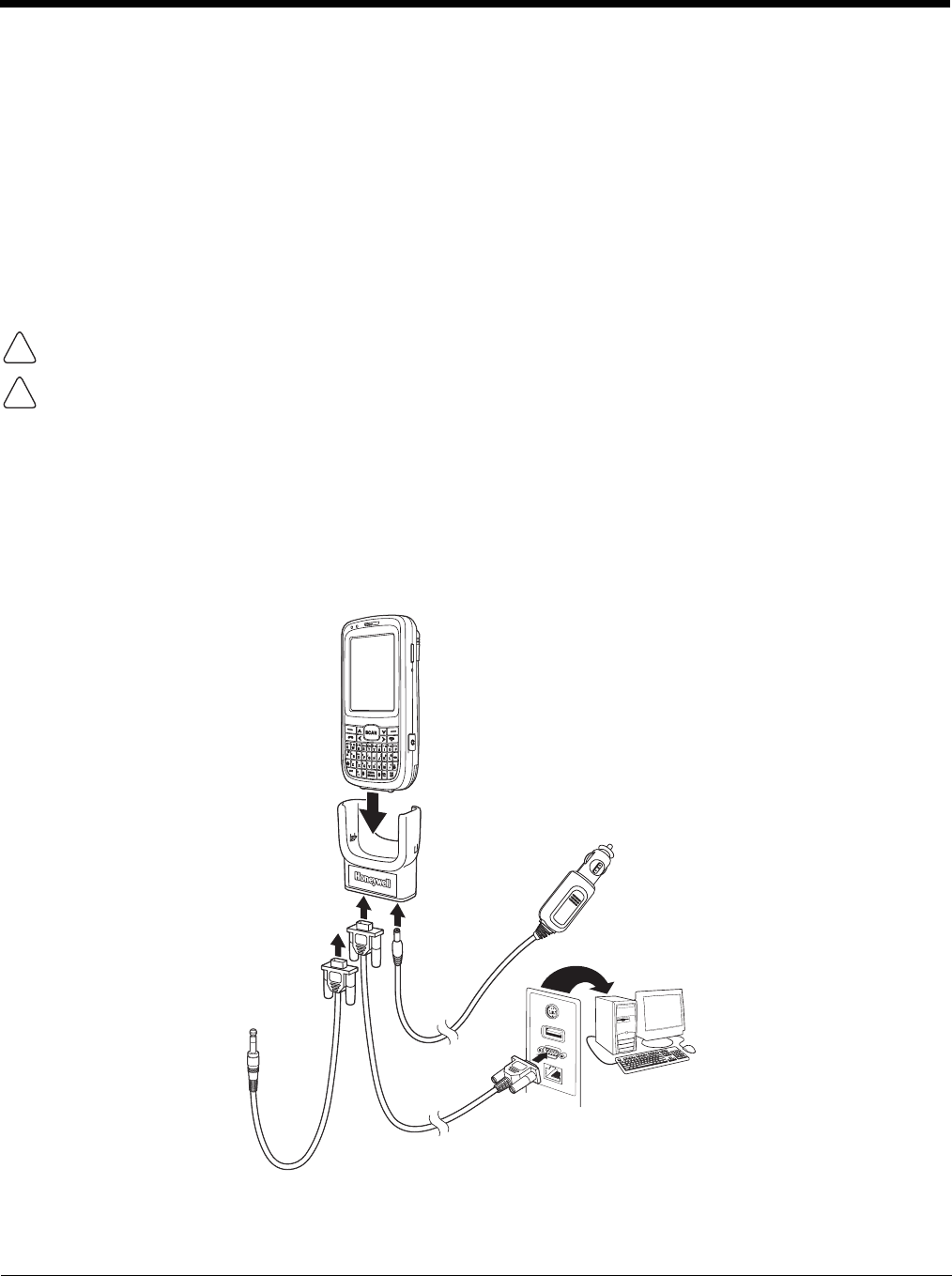
13 - 3
Charging the Main Battery
The mobile base provides power to the Dolphin and allows charging of the main batteries in the terminal.
The main battery charges in 6 hours for the extended battery. The intelligent battery charging system
incorporated into all Dolphin terminals prevents overcharging, which means that terminal may be seated
in the base indefinitely without damage to the terminal, battery pack, or the base.
For more information about Honeywell battery packs and how to check battery power levels in your
terminal, refer to Power (page 7-23) and Battery (page 3-10).
To Power a Terminal and Charge its Main Battery
Ensure all components are dry prior to mating terminals/batteries with peripheral devices. Mating wet
components may cause damage not covered by the warranty.
We recommend use of Honeywell Li-Ion battery packs. Use of any non-Honeywell battery may result in
damage not covered by the warranty.
1. Install the main battery in the terminal; see Install the Battery on page 2-1.
2. Install the Dolphin 60s into the terminal well.
3. To charge the Dolphin 60s:
• With the Power Adapter: Connect the power adapter to a vehicle cigarette lighter outlet.
• With the DB9 Cable: Connect the DB9 cable into the appropriate port on the host terminal.
• With the DEX Cable: Connect the DEX cable into a vending machine.
!
!
Preliminary Draft 6/19/13, Not for Release

13 - 4
Preliminary Draft 6/19/13, Not for Release

14 - 1
14 Dolphin 60s
Customer Support
Product Service and Repair
Honeywell International Inc. provides service for all of its products through service centers throughout
the world. To obtain warranty or non-warranty service, please visit www.honeywellaidc.com, and select
Support > Contact Service and Repair to see your region’s instructions on how to obtain a Return
Material Authorization number (RMA #). You should do this prior to returning the product.
For ongoing and future product quality improvement initiatives, the 70e comes equipped with an
embedded device lifetime counter function. Honeywell may use the lifetime counter data for future statis-
tical reliability analysis as well as ongoing quality, repair and service purposes.
Technical Assistance
If you need assistance installing or troubleshooting your device, please contact us by using one of the
methods below:
Knowledge Base: www.hsmknowledgebase.com
Our Knowledge Base provides thousands of immediate solutions. If the Knowledge Base cannot help,
our Technical Support Portal (see below) provides an easy way to report your problem or ask your
question.
Technical Support Portal: www.hsmsupportportal.com
The Technical Support Portal not only allows you to report your problem, but it also provides immediate
solutions to your technical issues by searching our Knowledge Base. With the Portal, you can submit
and track your questions online and send and receive attachments.
Web form: www.hsmcontactsupport.com
You can contact our technical support team directly by filling out our online support form. Enter your
contact details and the description of the question/problem.
Telephone: www.honeywellaidc.com/locations
For our latest contact information, please check our website at the link above.
Warranty Disclaimer: Proper Use of a Touch Screen Mobile Device
If your mobile device has a touch screen display, please note that a touch screen responds best to a light
touch from the pad of your finger or a Honeywell approved stylus. Using excessive force or a metallic
object when pressing on the touch-screen may cause damage to the tempered glass surface and may
not be covered by the product's warranty.
Limited Warranty
Honeywell International Inc. ("HII") warrants its products and optional accessories to be free from defects
in materials and workmanship and to conform to HII’s published specifications applicable to the products
purchased at the time of shipment. This warranty does not cover any HII product which is (i) improperly
Preliminary Draft 6/19/13, Not for Release

14 - 2
installed or used; (ii) damaged by accident or negligence, including failure to follow the proper mainte-
nance, service, and cleaning schedule; or (iii) damaged as a result of (A) modification or alteration by the
purchaser or other party, (B) excessive voltage or current supplied to or drawn from the interface connec-
tions, (C) static electricity or electro-static discharge, (D) operation under conditions beyond the
specified operating parameters, or (E) repair or service of the product by anyone other than HII or its
authorized representatives.
This warranty shall extend from the time of shipment for the duration published by HII for the product at
the time of purchase ("Warranty Period"). Any defective product must be returned (at purchaser’s
expense) during the Warranty Period to HII factory or authorized service center for inspection. No
product will be accepted by HII without a Return Materials Authorization, which may be obtained by
contacting HII. In the event that the product is returned to HII or its authorized service center within the
Warranty Period and HII determines to its satisfaction that the product is defective due to defects in
materials or workmanship, HII, at its sole option, will either repair or replace the product without charge,
except for return shipping to HII.
EXCEPT AS MAY BE OTHERWISE PROVIDED BY APPLICABLE LAW, THE FOREGOING
WARRANTY IS IN LIEU OF ALL OTHER COVENANTS OR WARRANTIES, EITHER EXPRESSED OR
IMPLIED, ORAL OR WRITTEN, INCLUDING, WITHOUT LIMITATION, ANY IMPLIED WARRANTIES
OF MERCHANTABILITY OR FITNESS FOR A PARTICULAR PURPOSE, OR NON-INFRINGEMENT.
HII’S RESPONSIBILITY AND PURCHASER’S EXCLUSIVE REMEDY UNDER THIS WARRANTY IS
LIMITED TO THE REPAIR OR REPLACEMENT OF THE DEFECTIVE PRODUCT WITH NEW OR
REFURBISHED PARTS. IN NO EVENT SHALL HII BE LIABLE FOR INDIRECT, INCIDENTAL, OR
CONSEQUENTIAL DAMAGES, AND, IN NO EVENT, SHALL ANY LIABILITY OF HII ARISING IN
CONNECTION WITH ANY PRODUCT SOLD HEREUNDER (WHETHER SUCH LIABILITY ARISES
FROM A CLAIM BASED ON CONTRACT, WARRANTY, TORT, OR OTHERWISE) EXCEED THE
ACTUAL AMOUNT PAID TO HII FOR THE PRODUCT. THESE LIMITATIONS ON LIABILITY SHALL
REMAIN IN FULL FORCE AND EFFECT EVEN WHEN HII MAY HAVE BEEN ADVISED OF THE
POSSIBILITY OF SUCH INJURIES, LOSSES, OR DAMAGES. SOME STATES, PROVINCES, OR
COUNTRIES DO NOT ALLOW THE EXCLUSION OR LIMITATIONS OF INCIDENTAL OR CONSE-
QUENTIAL DAMAGES, SO THE ABOVE LIMITATION OR EXCLUSION MAY NOT APPLY TO YOU.
All provisions of this Limited Warranty are separate and severable, which means that if any provision is
held invalid and unenforceable, such determination shall not affect the validity of enforceability of the
other provisions hereof. Use of any peripherals not provided by the manufacturer may result in damage
not covered by this warranty. This includes but is not limited to: cables, power supplies, cradles, and
docking stations. HII extends these warranties only to the first end-users of the products. These
warranties are non-transferable.
The limited duration of the warranty for the Dolphin 60s is as follows:
• The duration of the limited warranty for terminals with an integrated imager is one year.
• The duration of the limited warranty for touch screens is one year.
• The duration of the limited warranty for the Dolphin 60s HomeBase device and Dolphin 60s Mobile
Charger device is one year.
• The duration of the limited warranty for batteries is one year.
Use of any battery from a source other than Honeywell may result in damage not covered by the
warranty. Batteries returned to Honeywell International Inc. in a reduced state may or not be replaced
under this warranty. Battery life will be greatly increased when following the battery instructions in this
user’s guide.
Preliminary Draft 6/19/13, Not for Release

14 - 3
How to Extend Your Warranty
Honeywell International Inc. offers a variety of service plans on our hardware products. These agree-
ments offer continued coverage for your equipment after the initial warranty expires. For more infor-
mation, contact your Sales Representative, Customer Account Representative, or Product Service
Marketing Manager from Honeywell International Inc., or your Authorized Reseller.
Preliminary Draft 6/19/13, Not for Release

14 - 4
Preliminary Draft 6/19/13, Not for Release

Preliminary Draft 6/19/13, Not for Release

Honeywell Scanning & Mobility
9680 Old Bailes Road
Fort Mill, SC 29707
www.honeywellaidc.com
60S-UG Rev (a)
6/13
Preliminary Draft 6/19/13, Not for Release